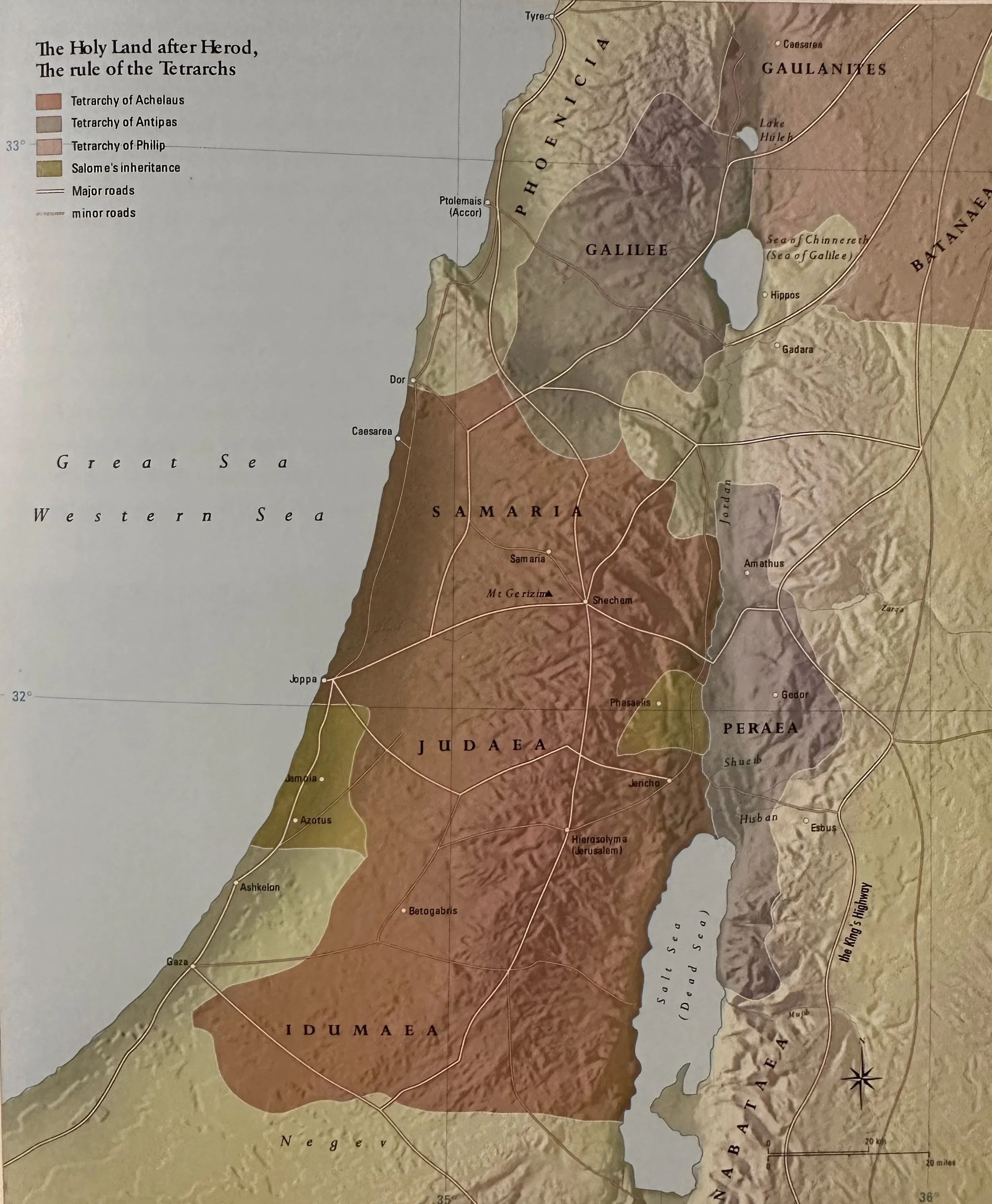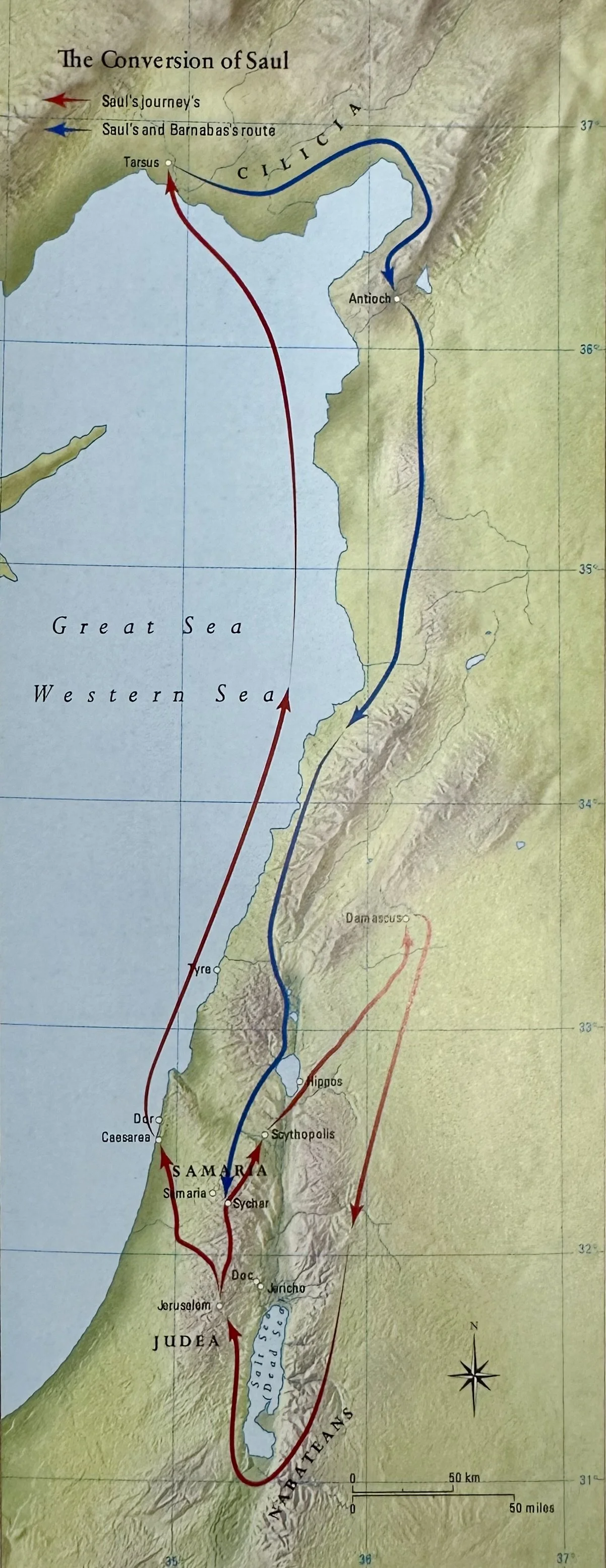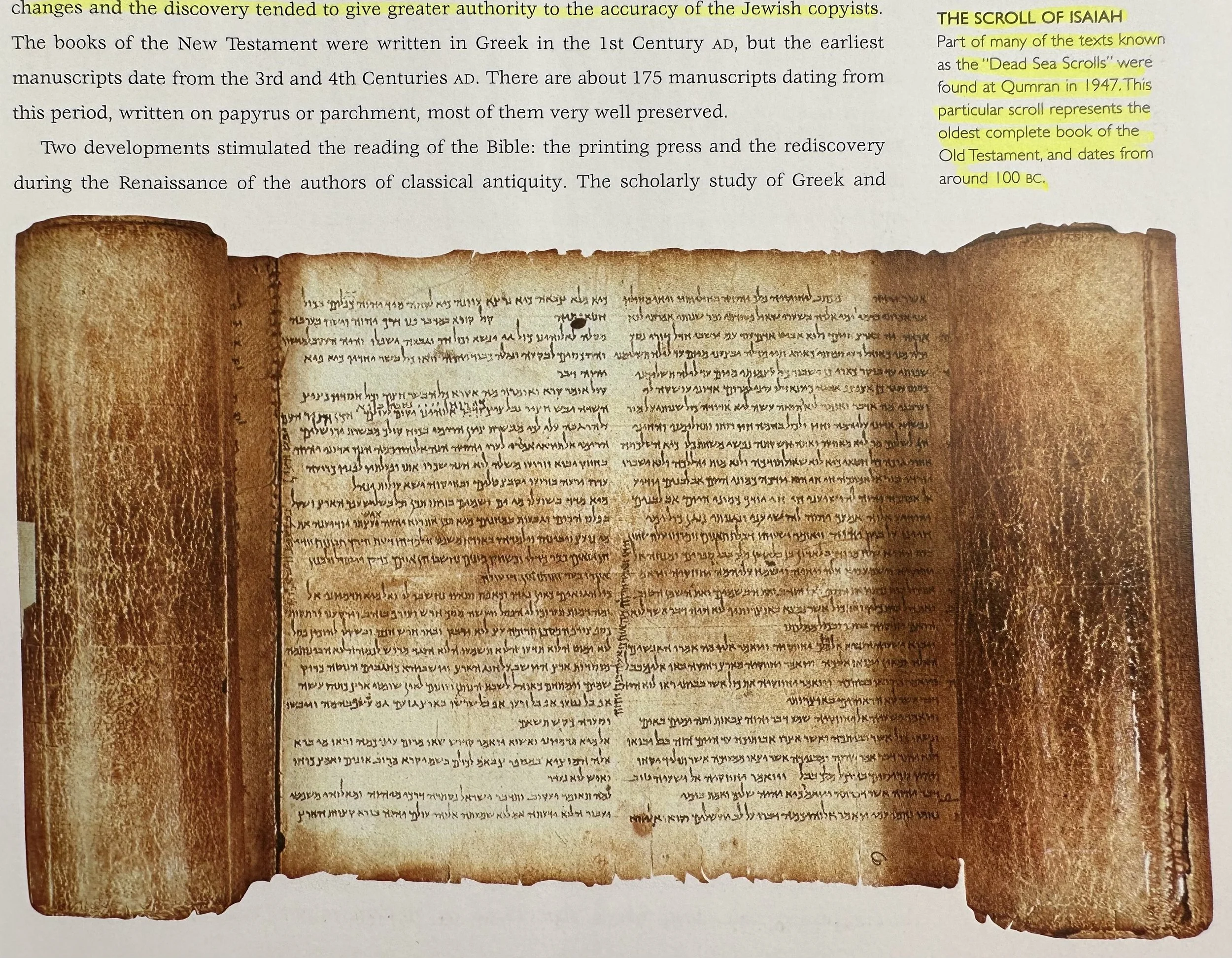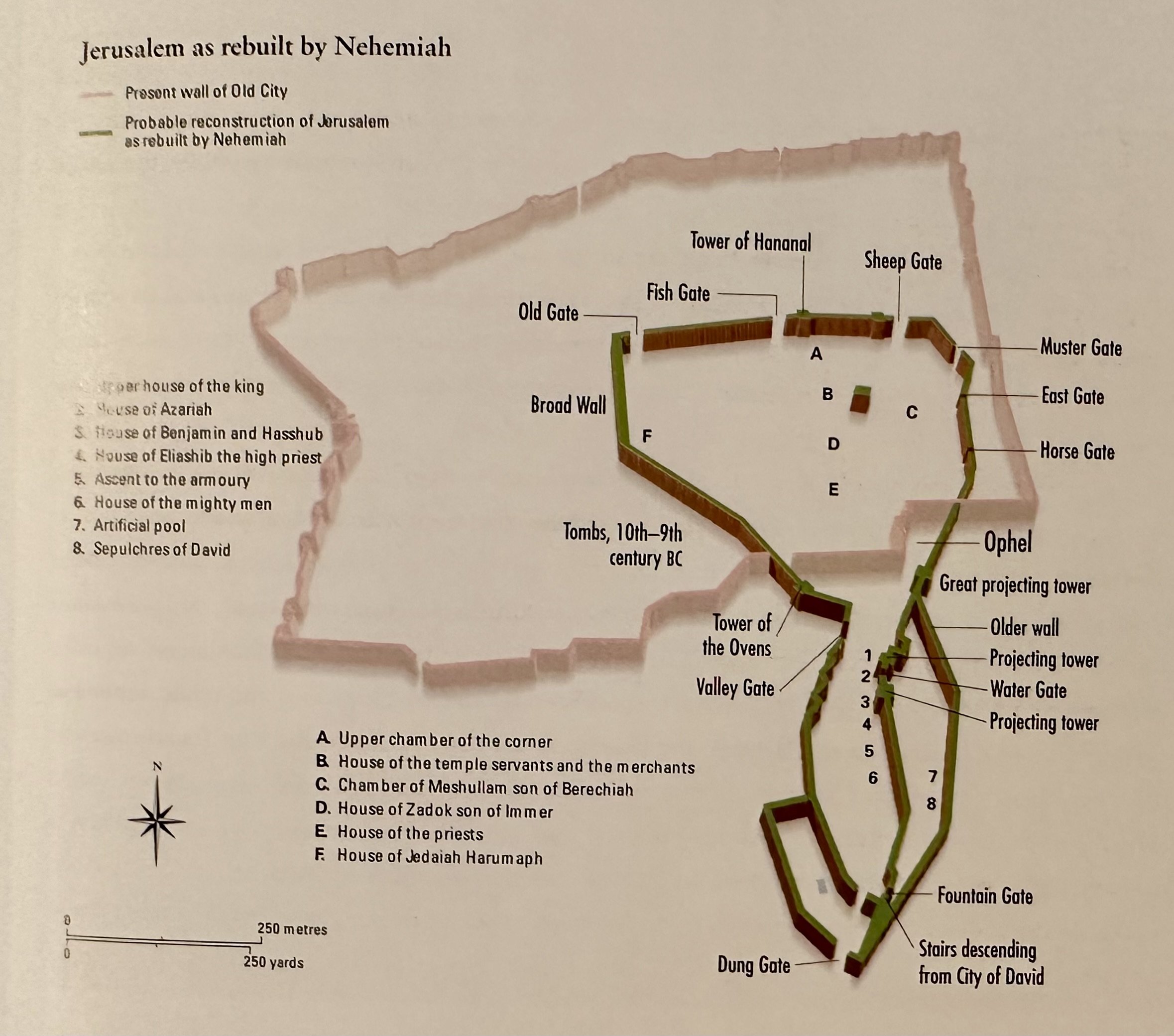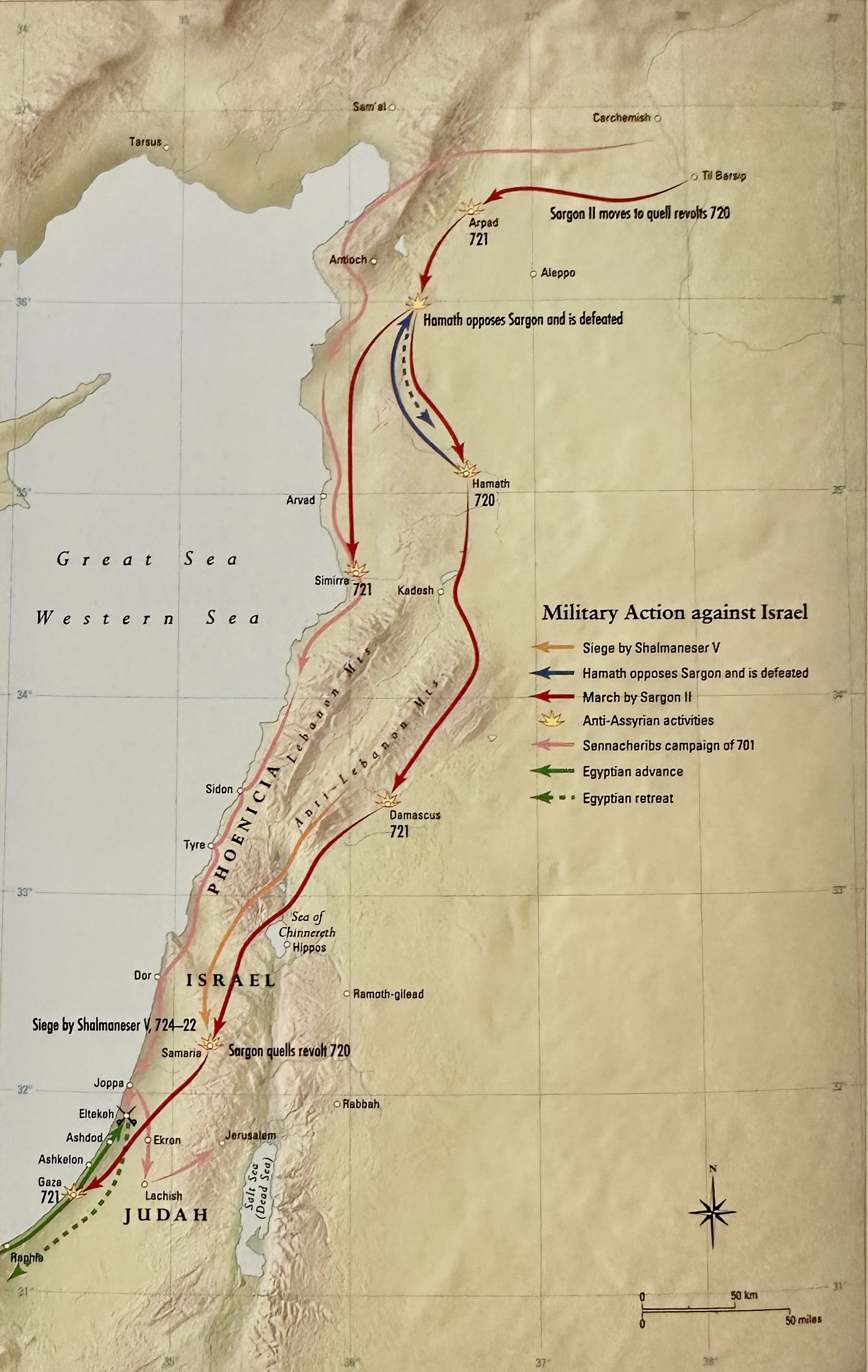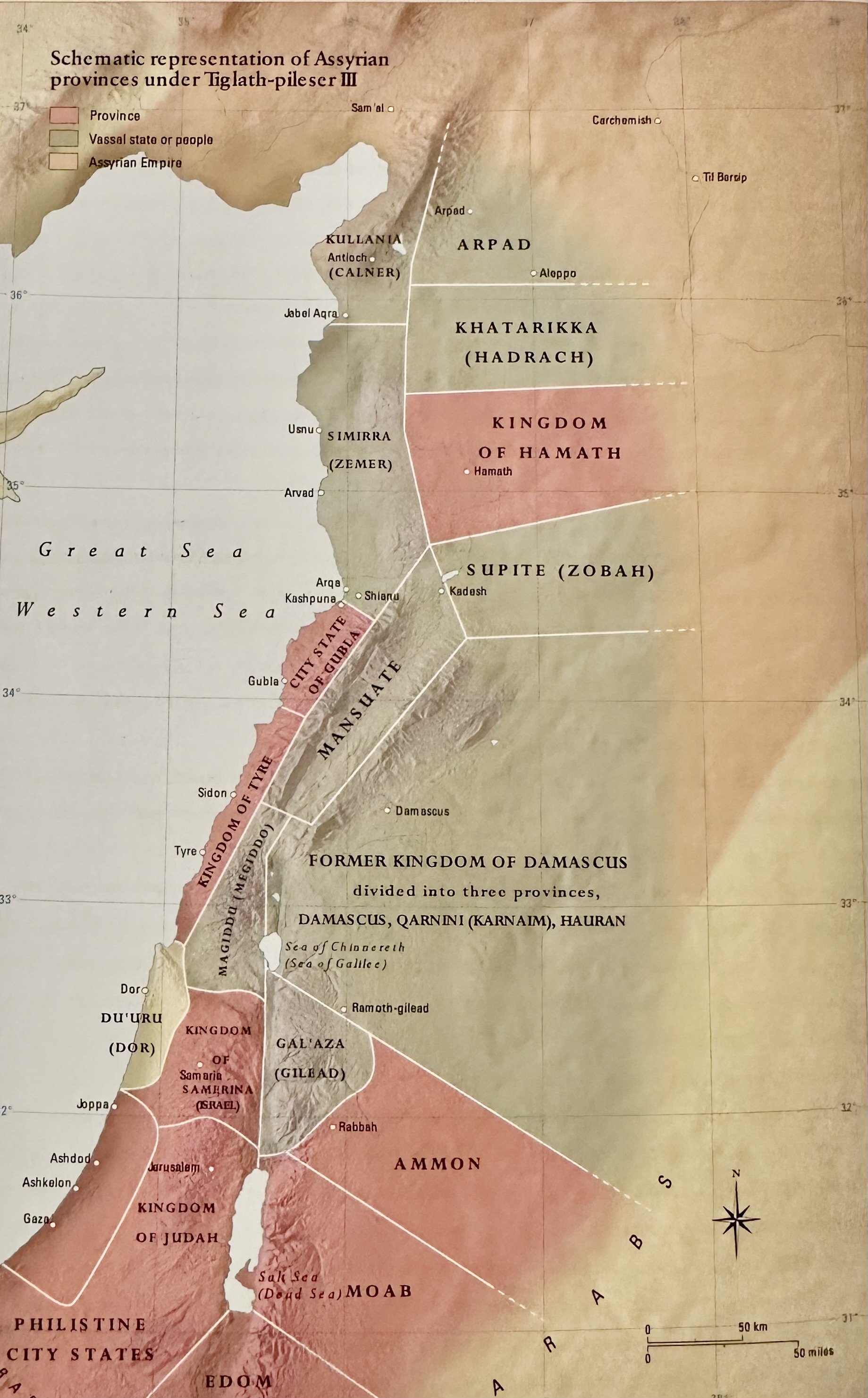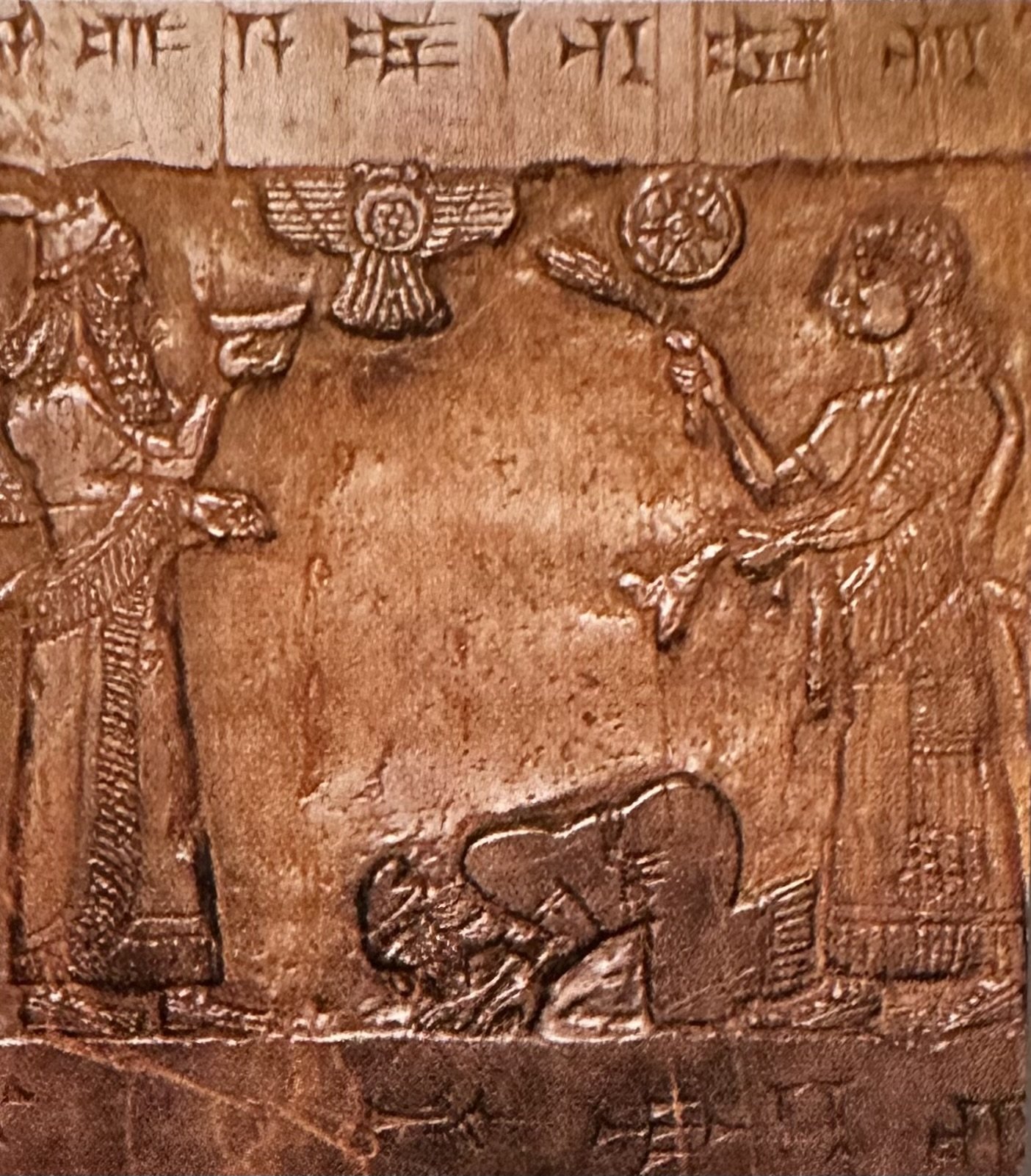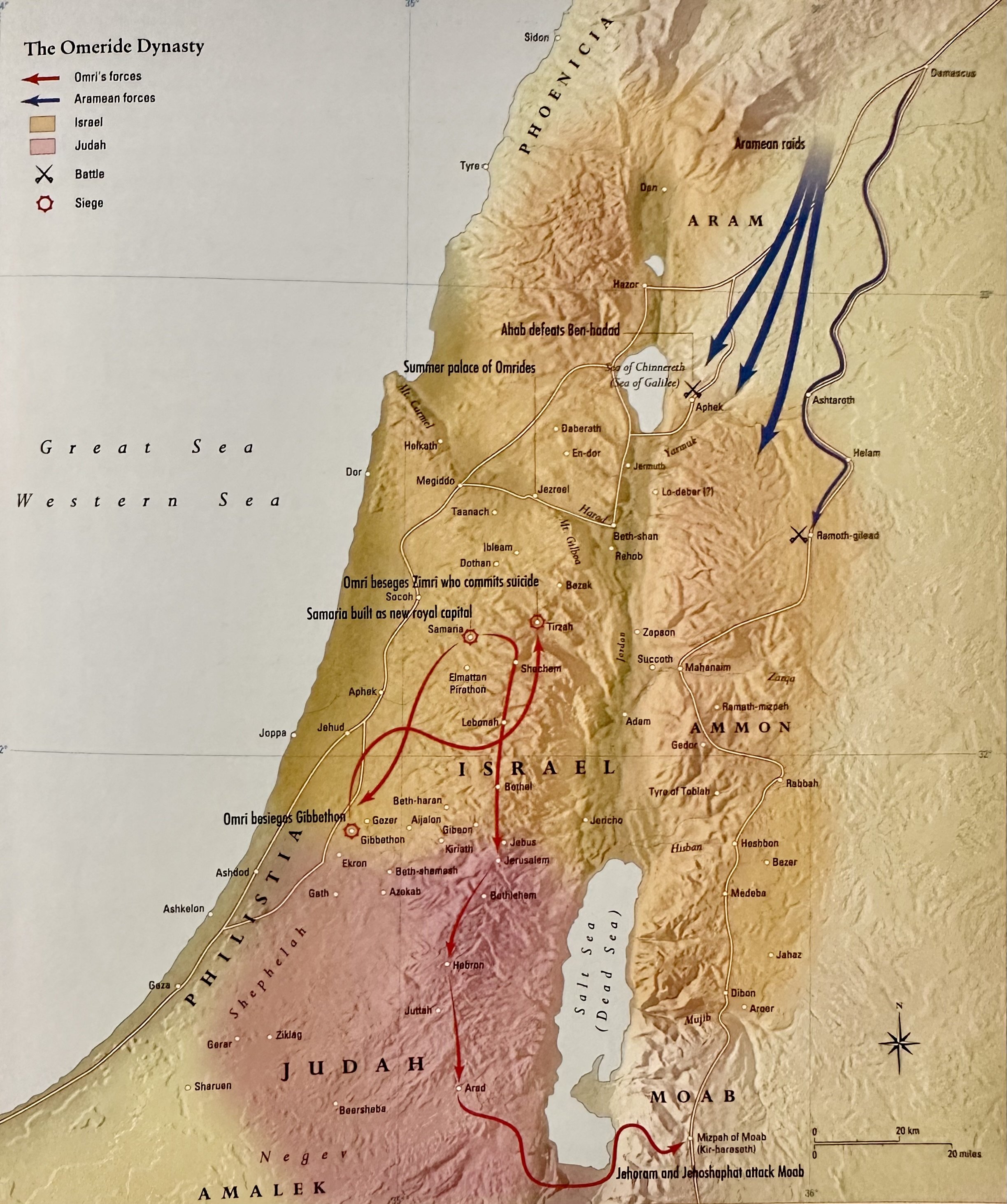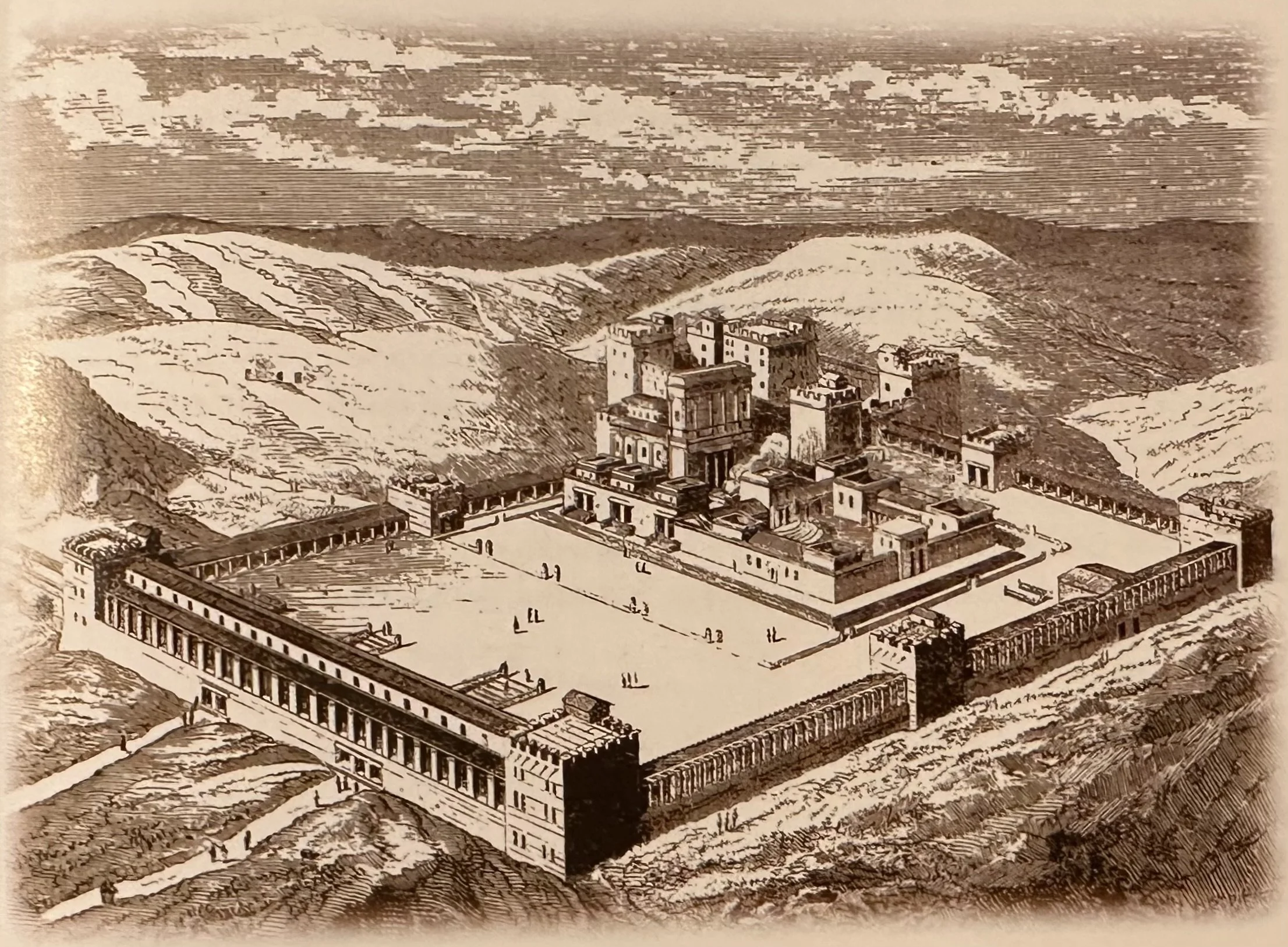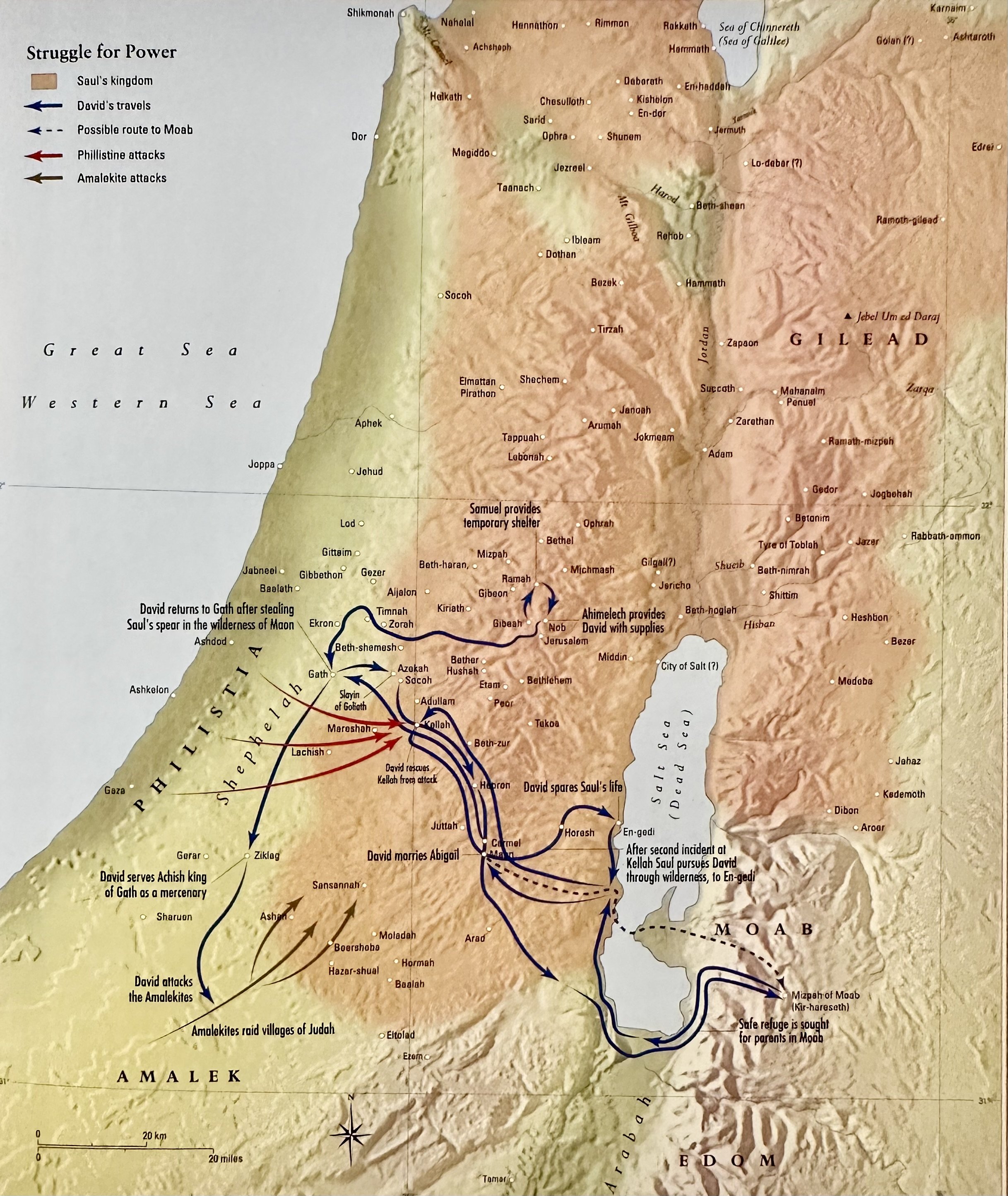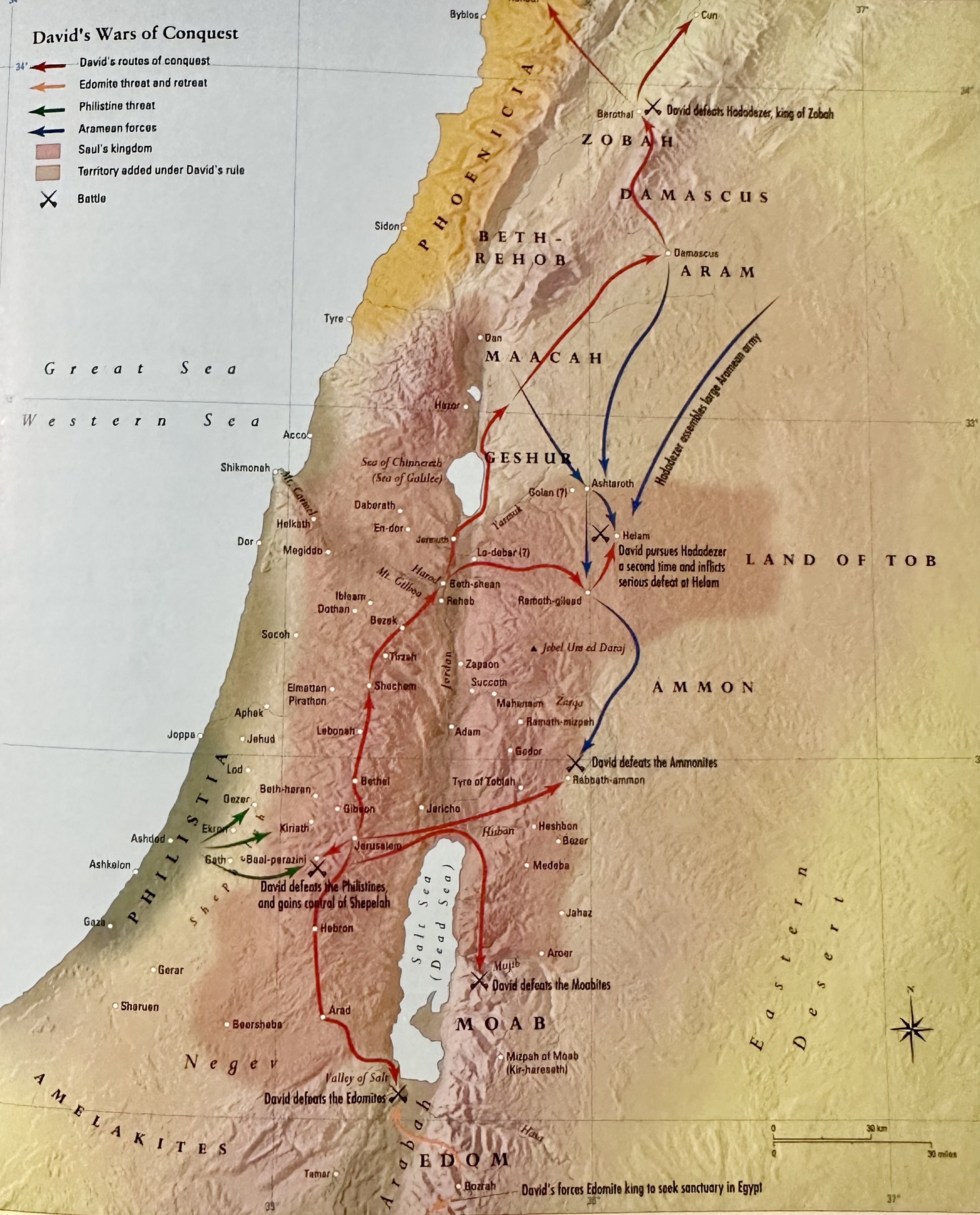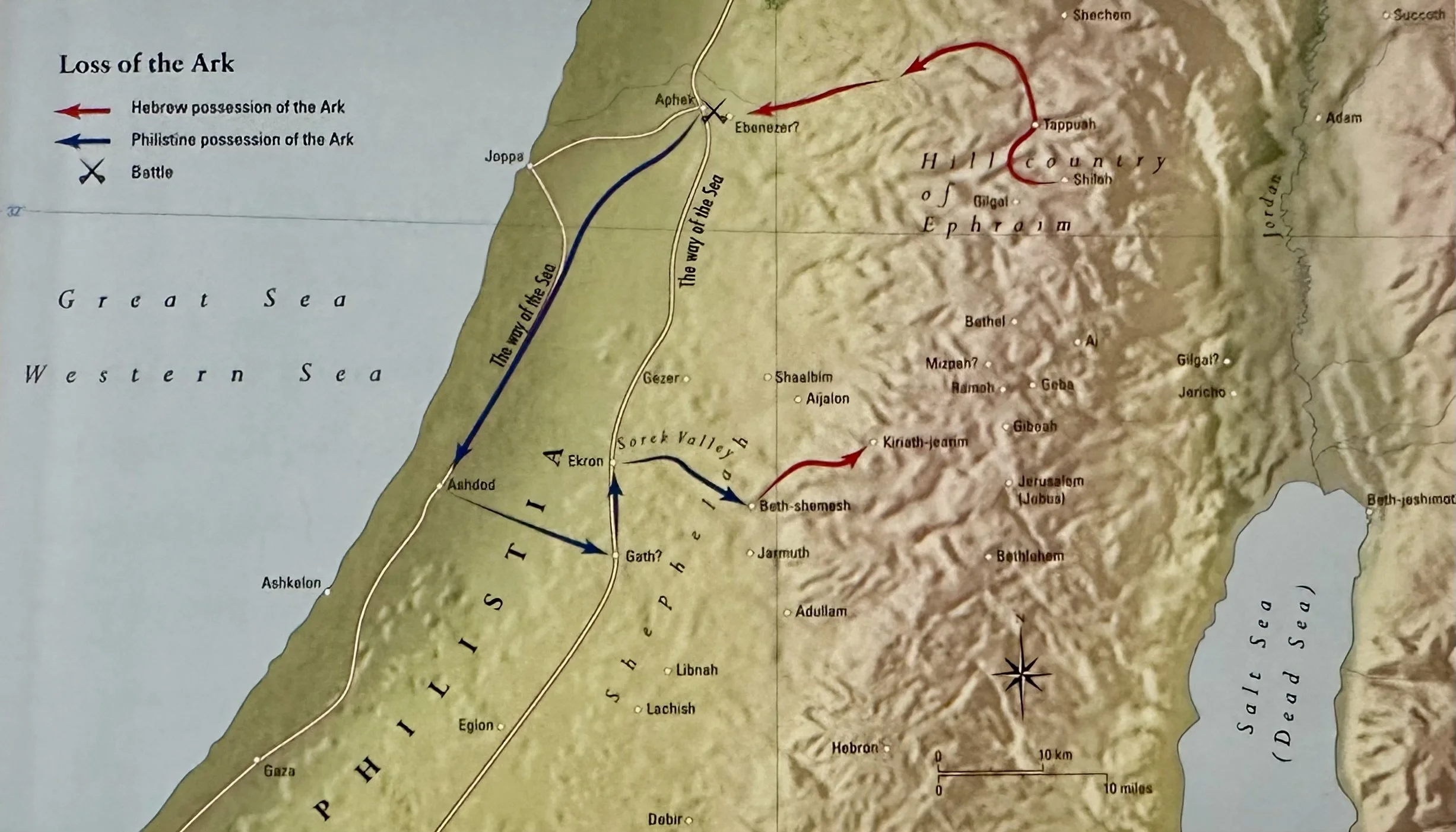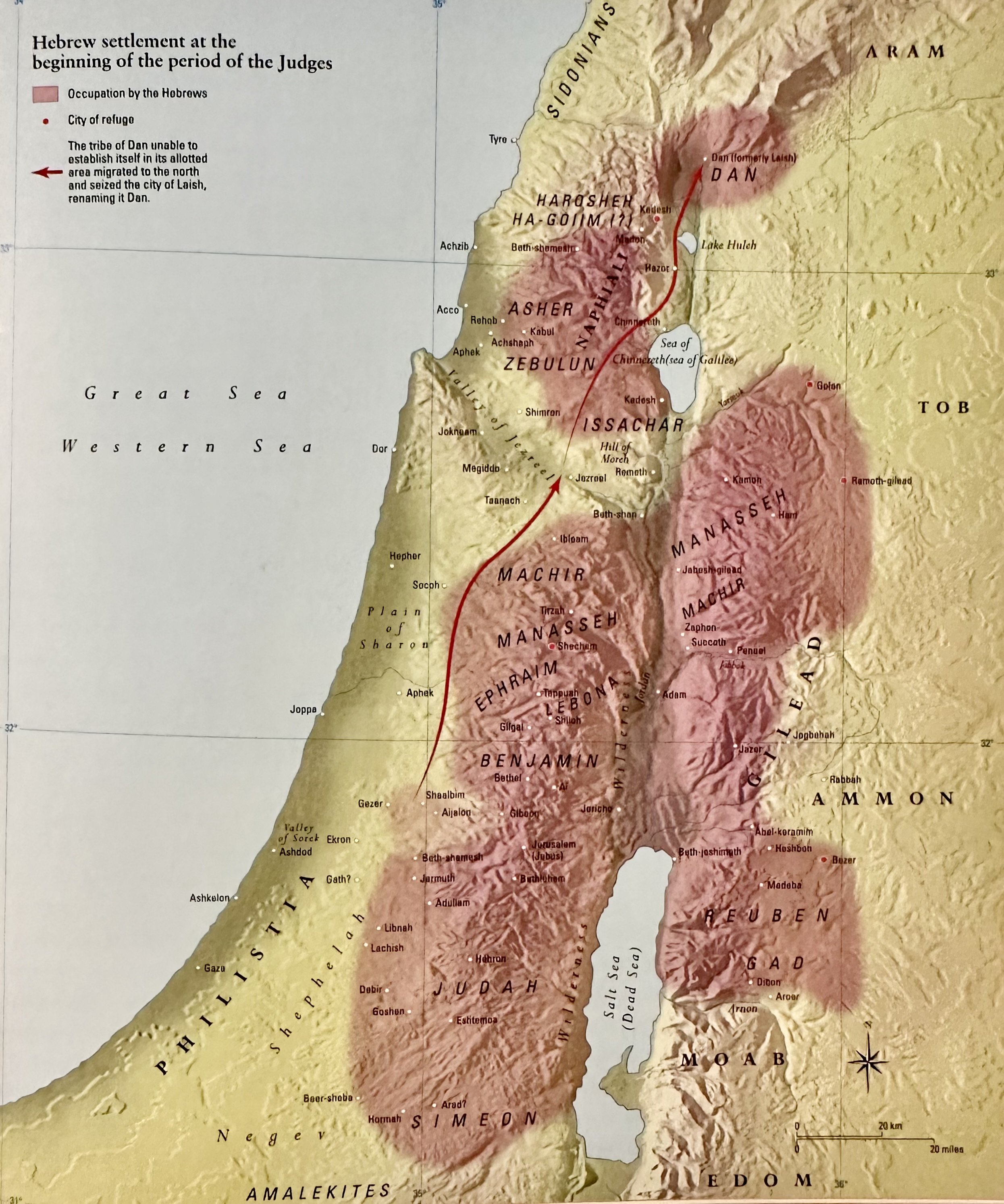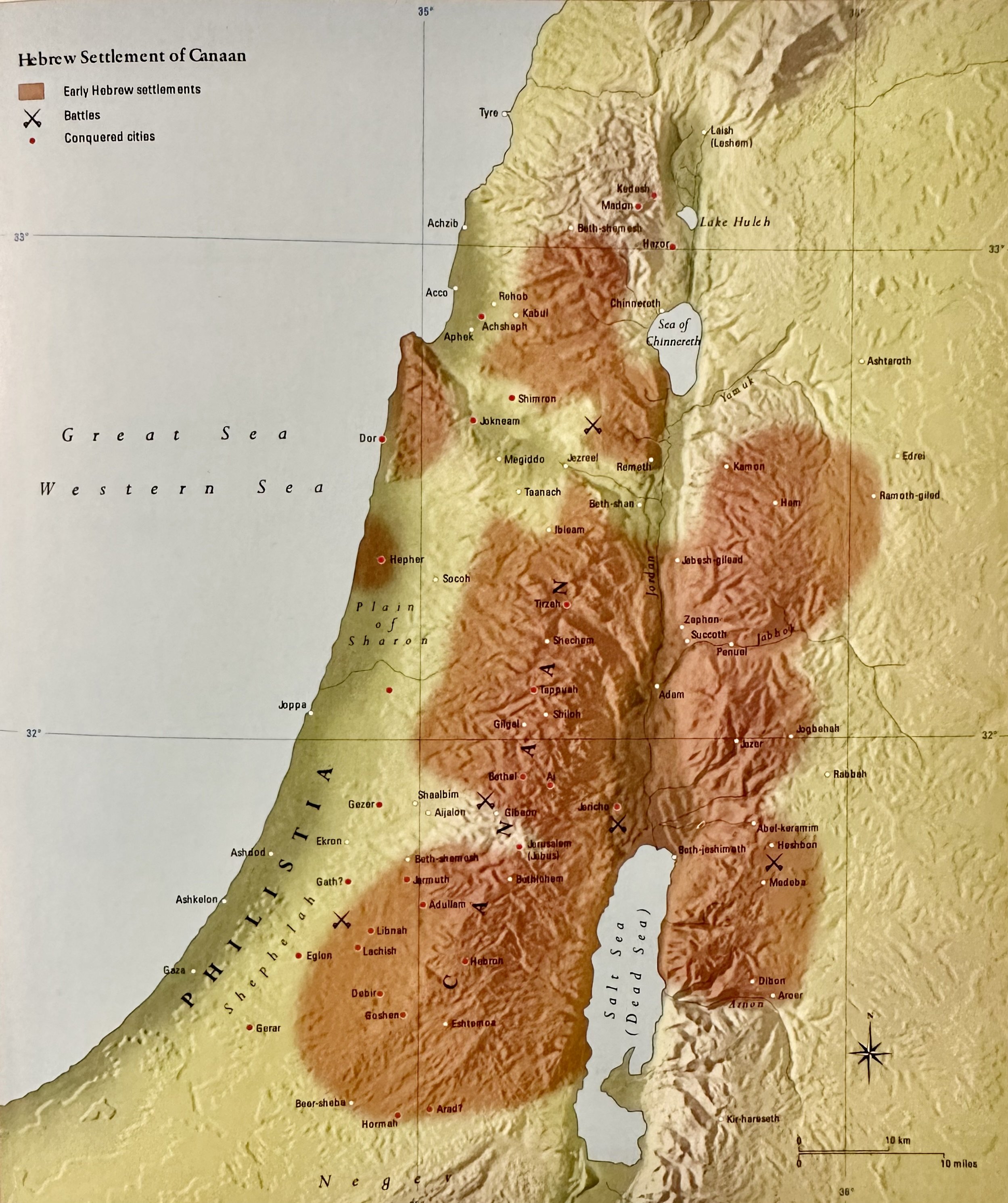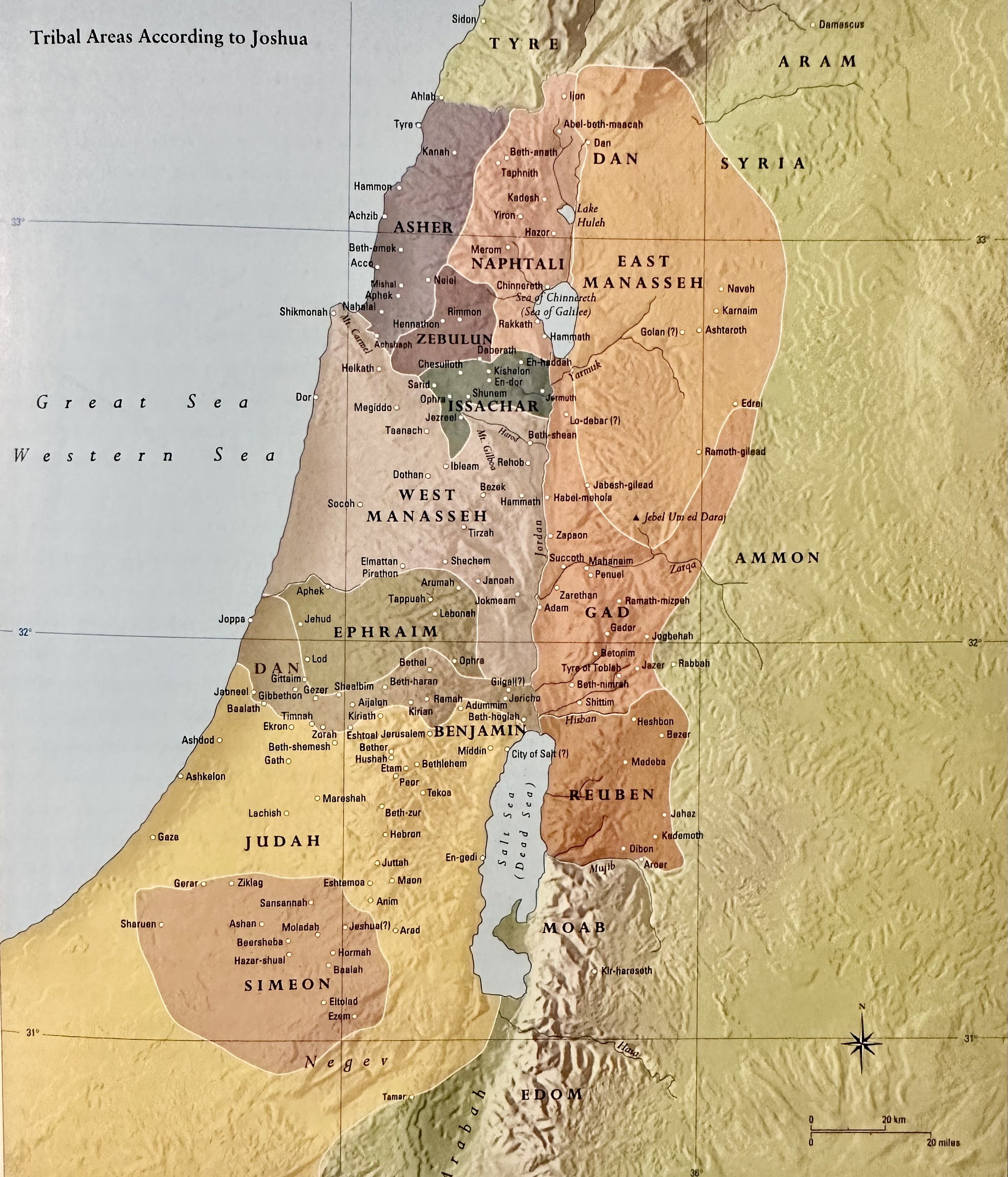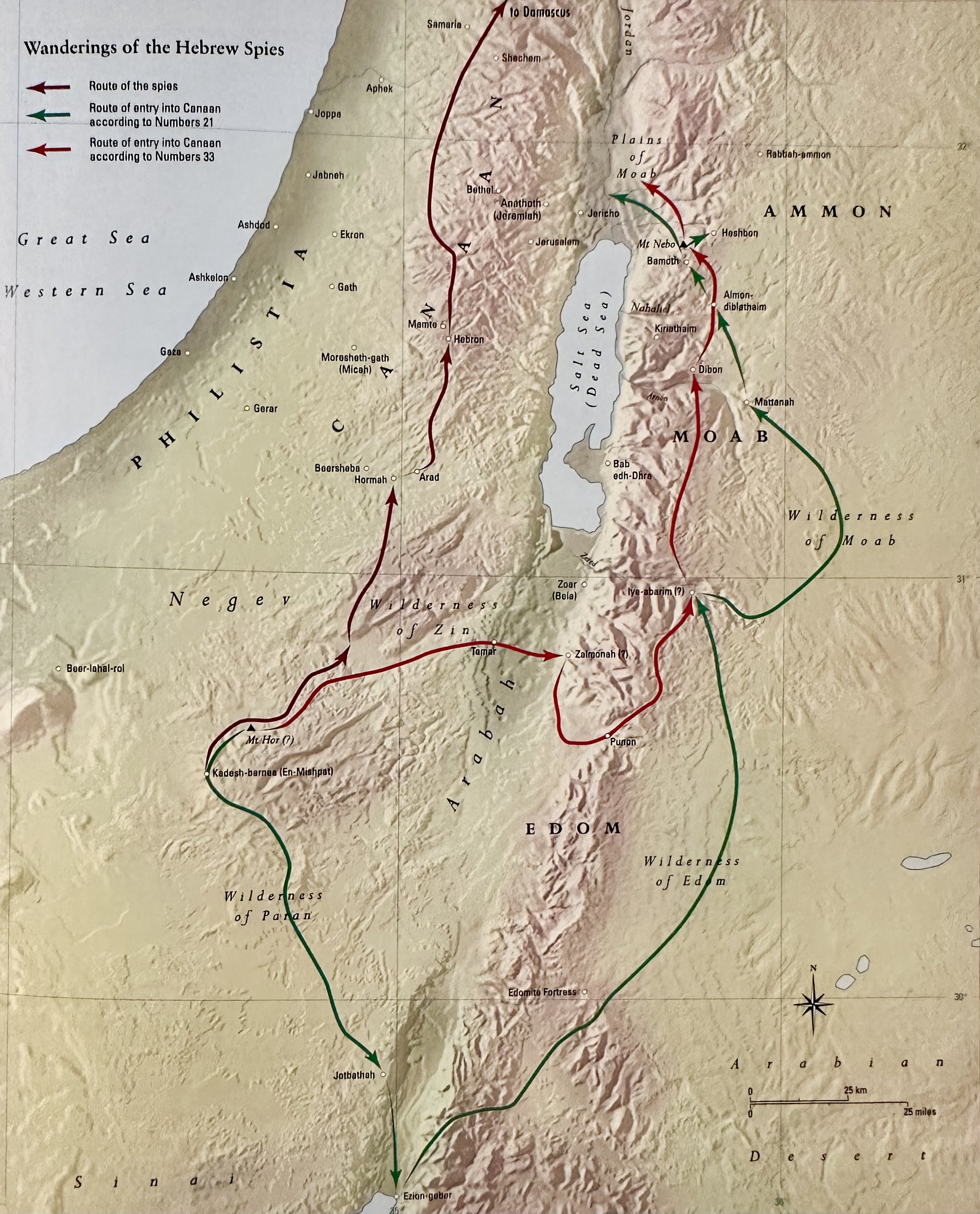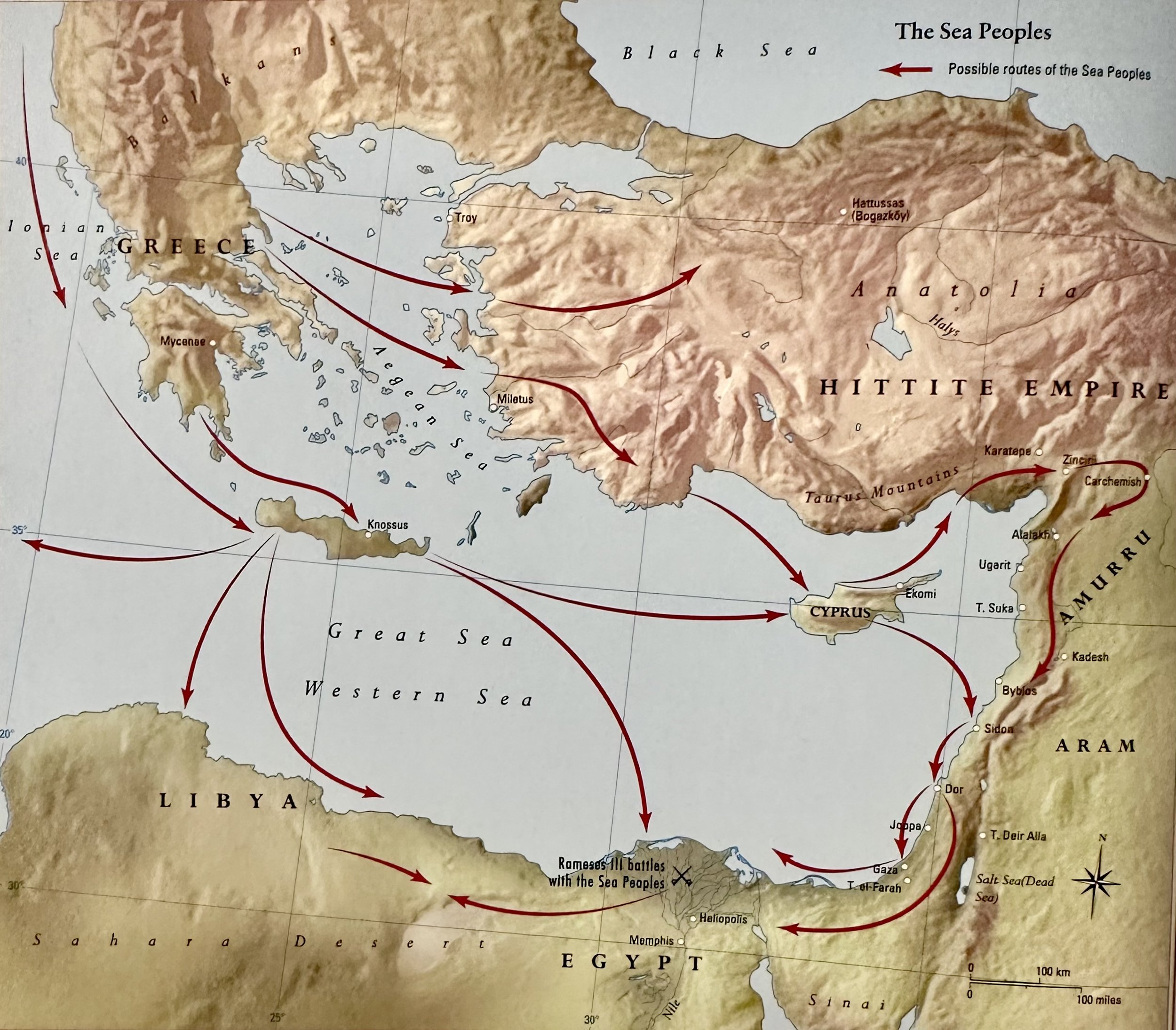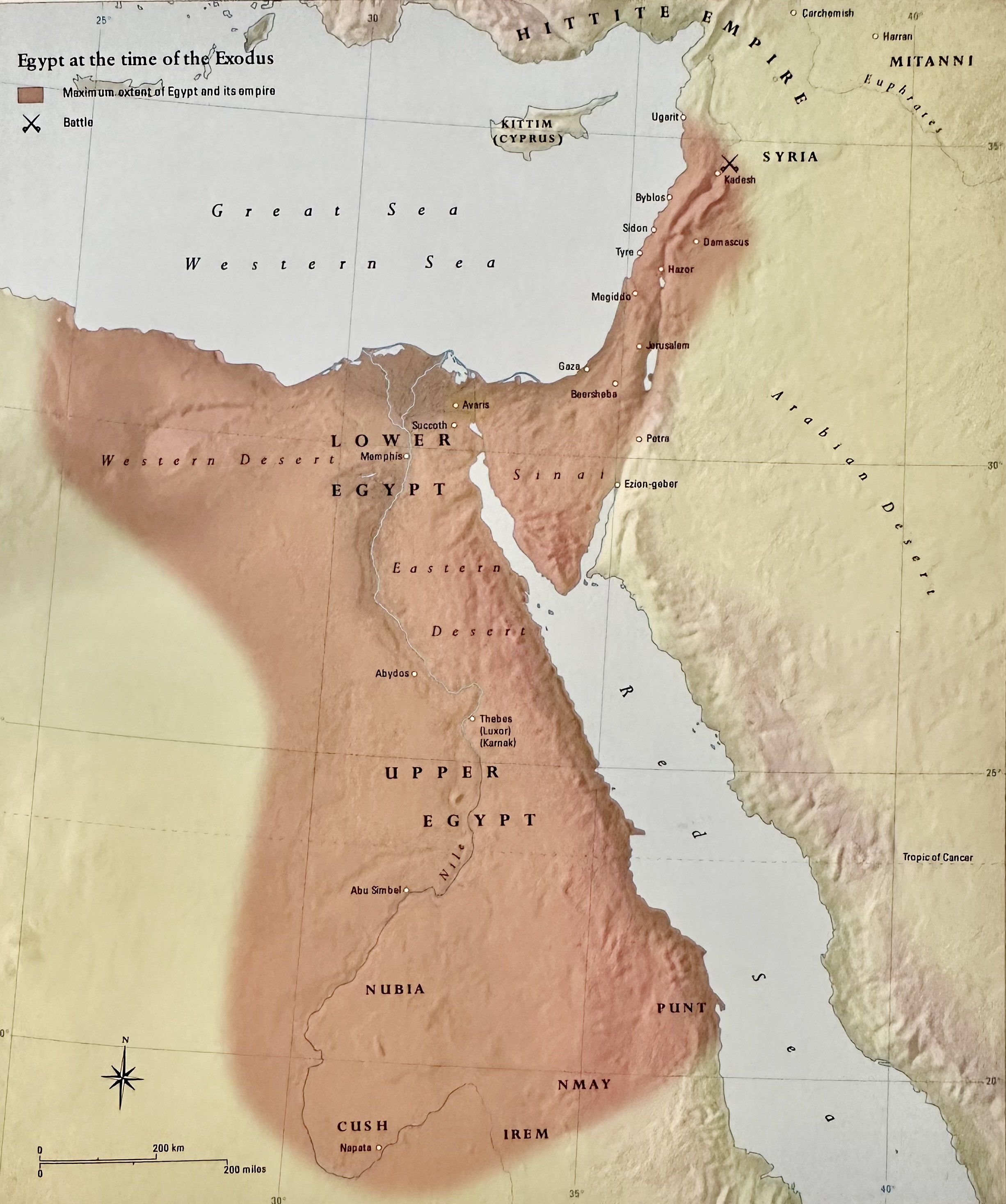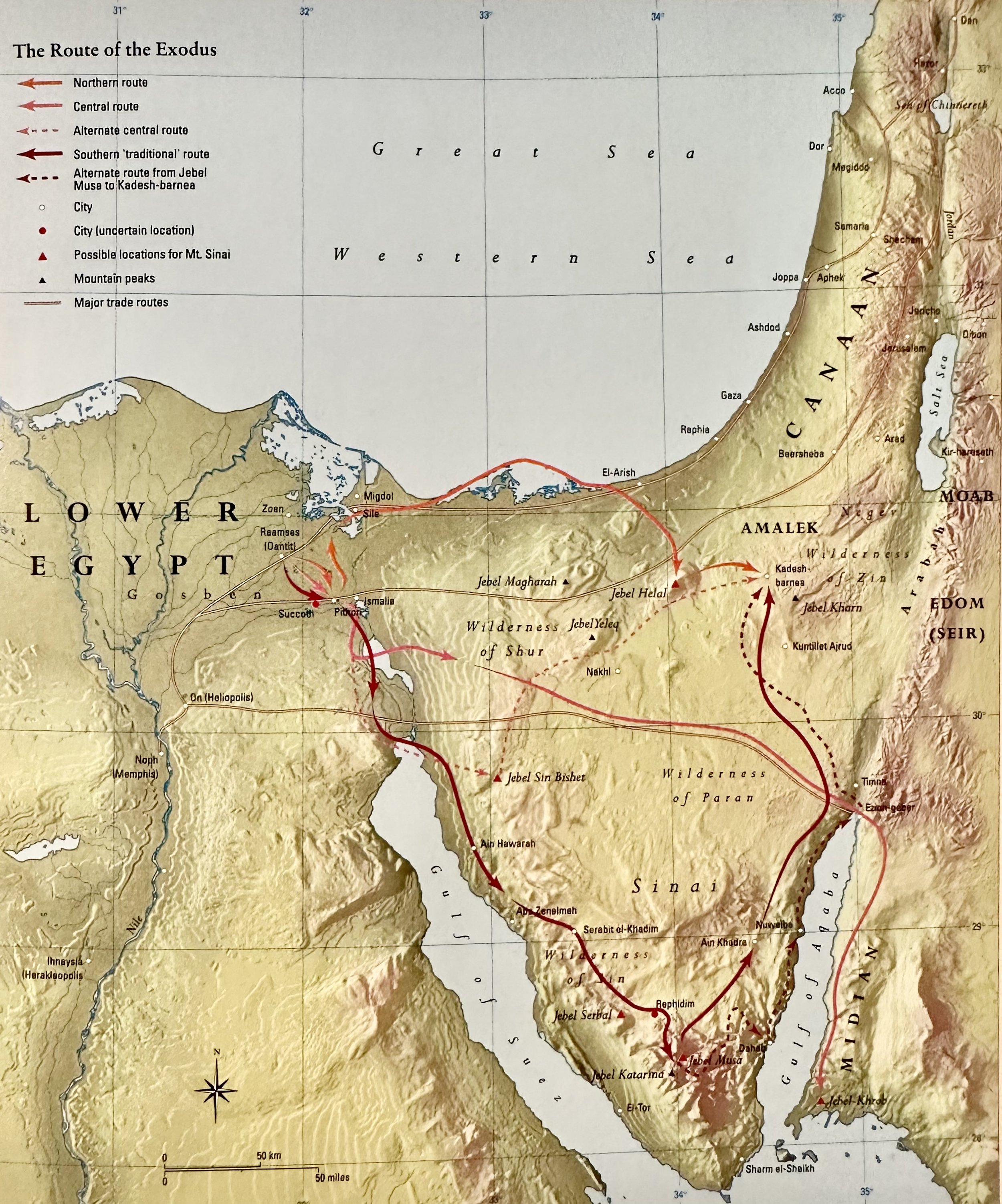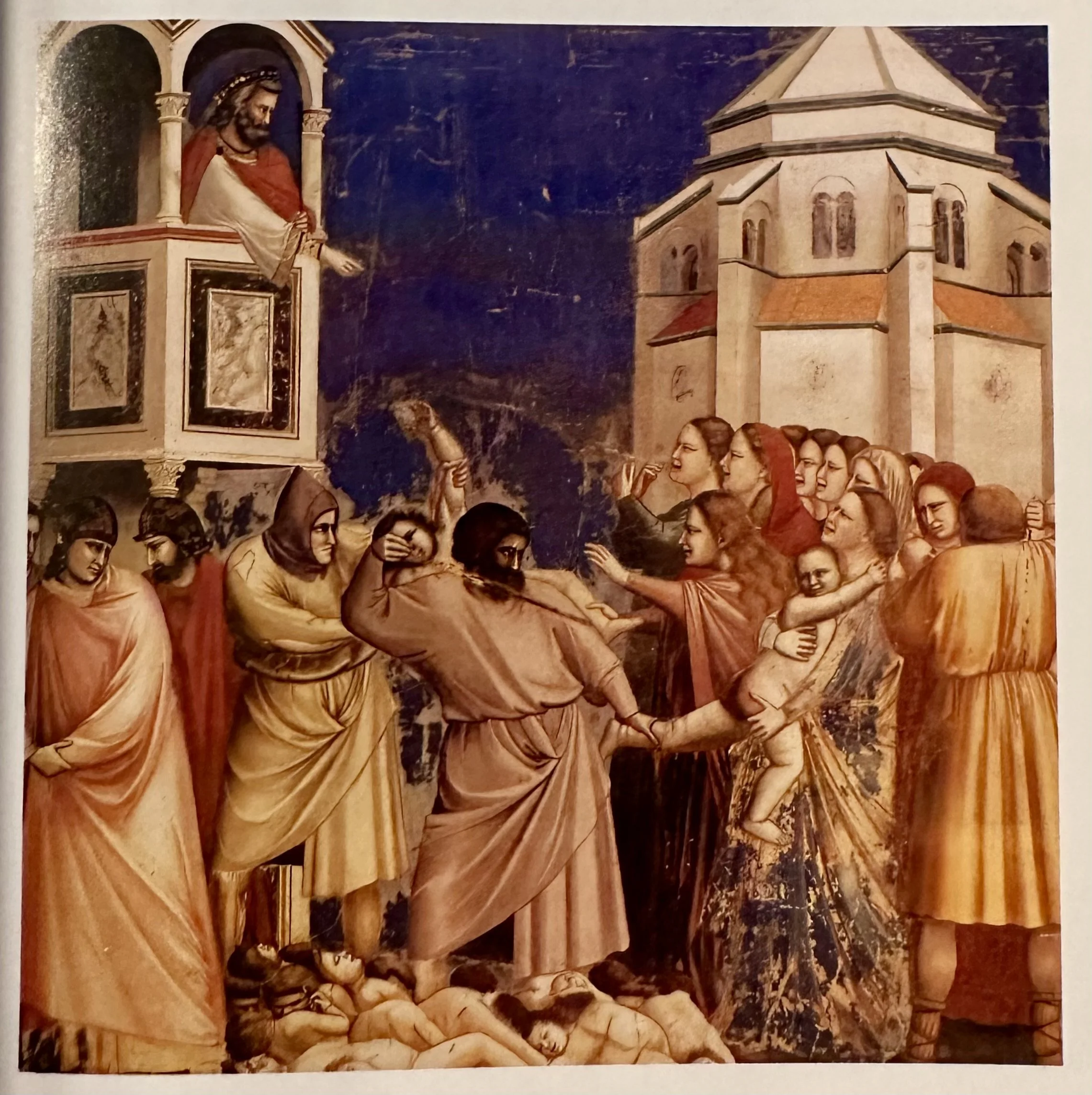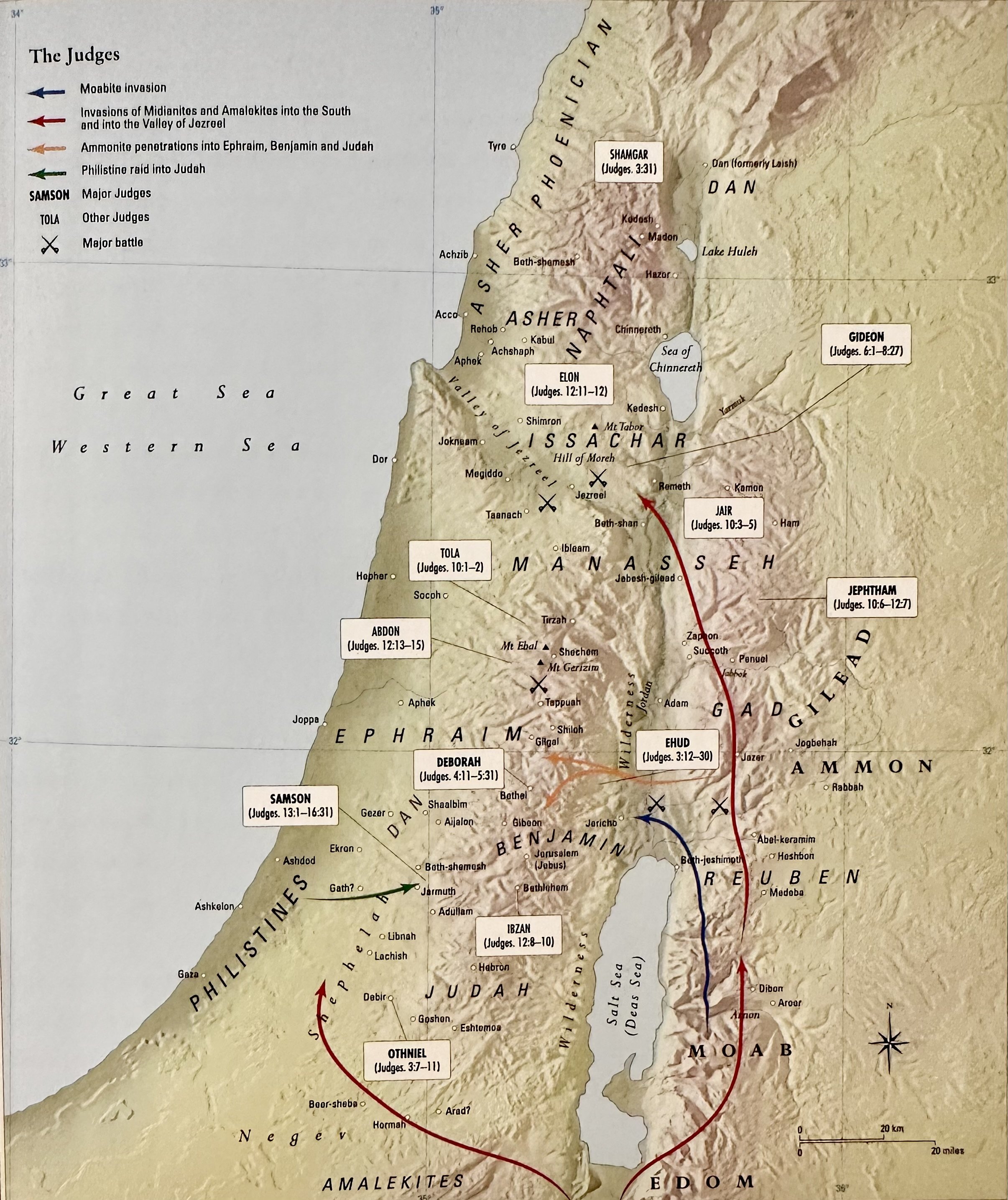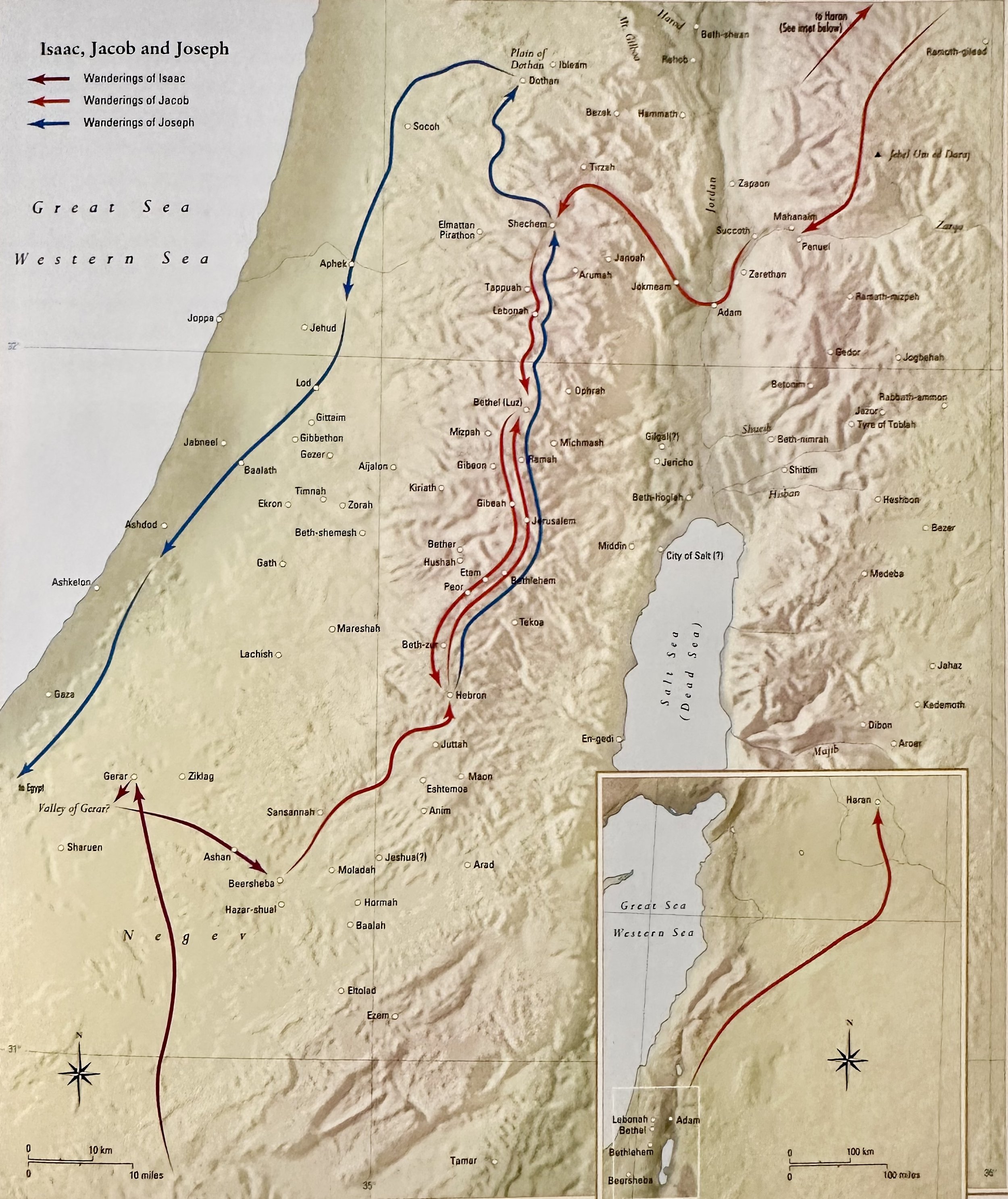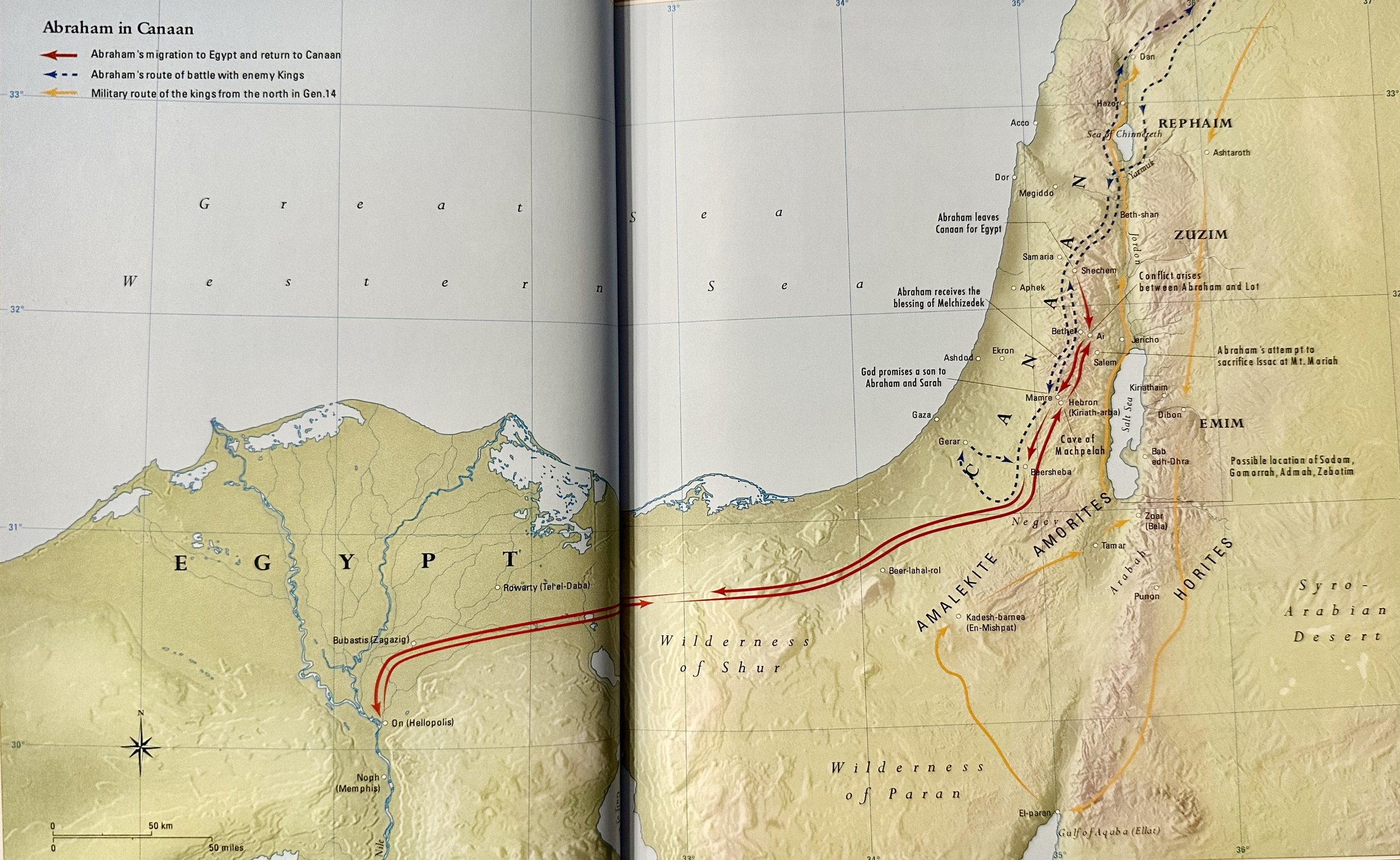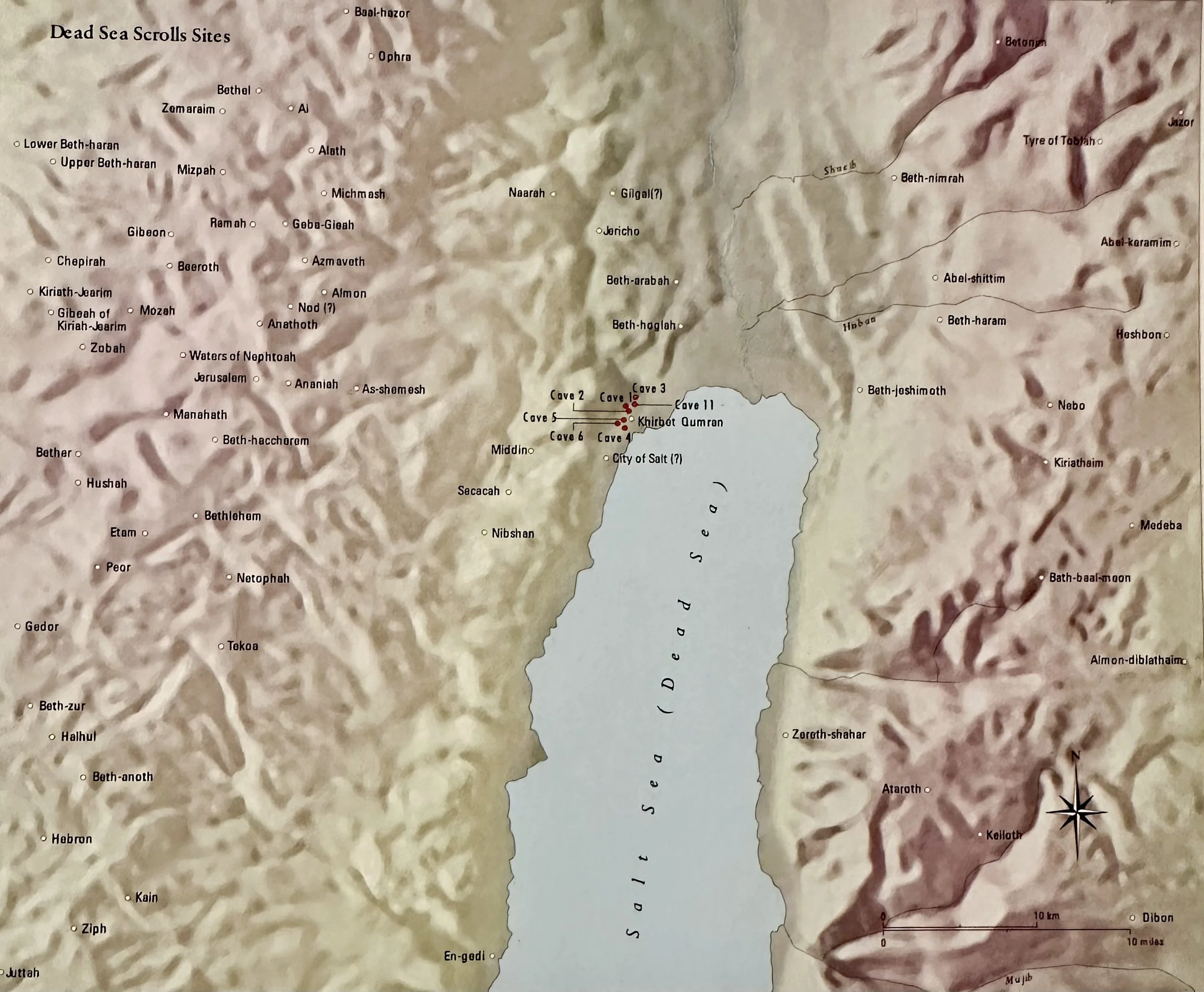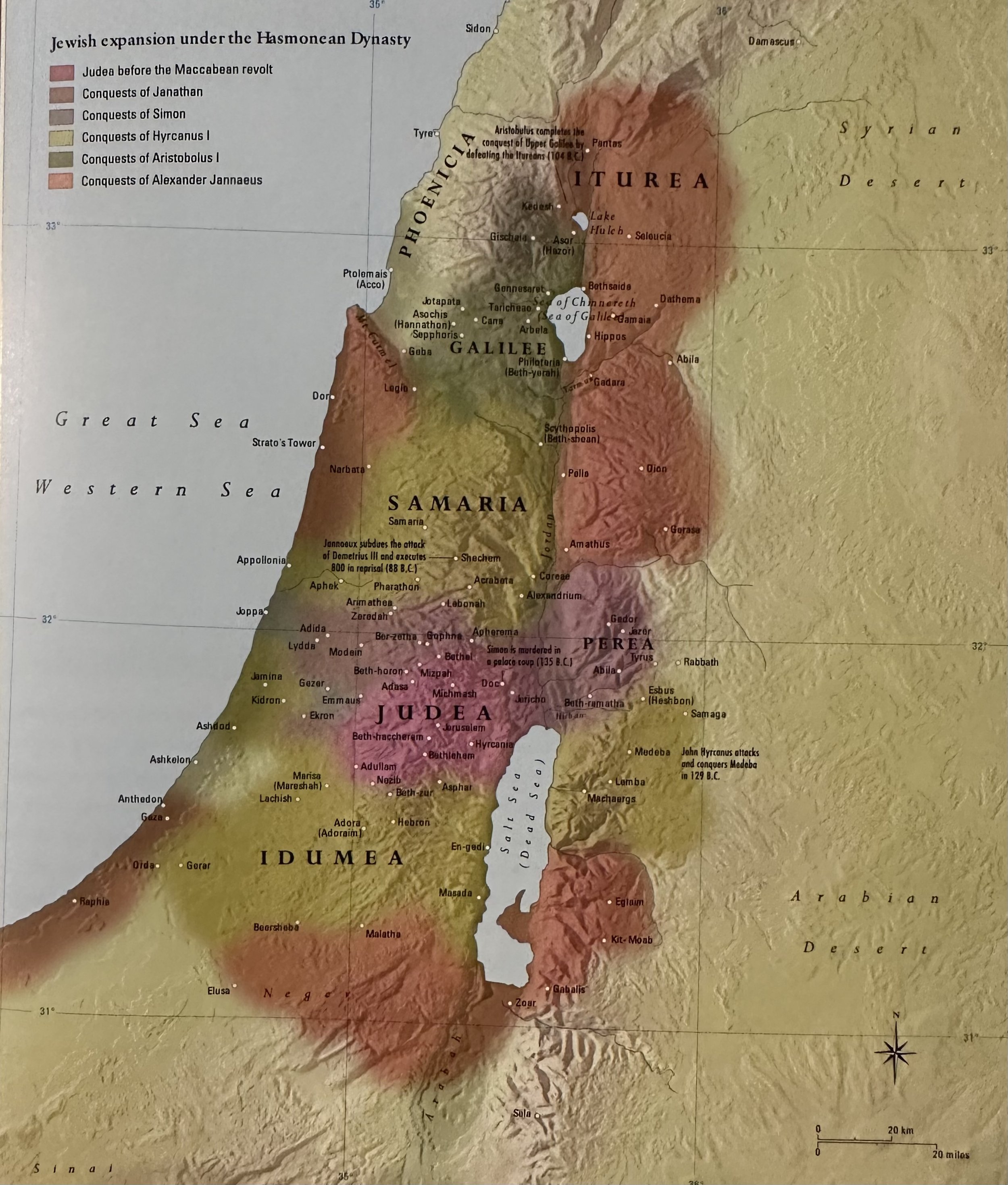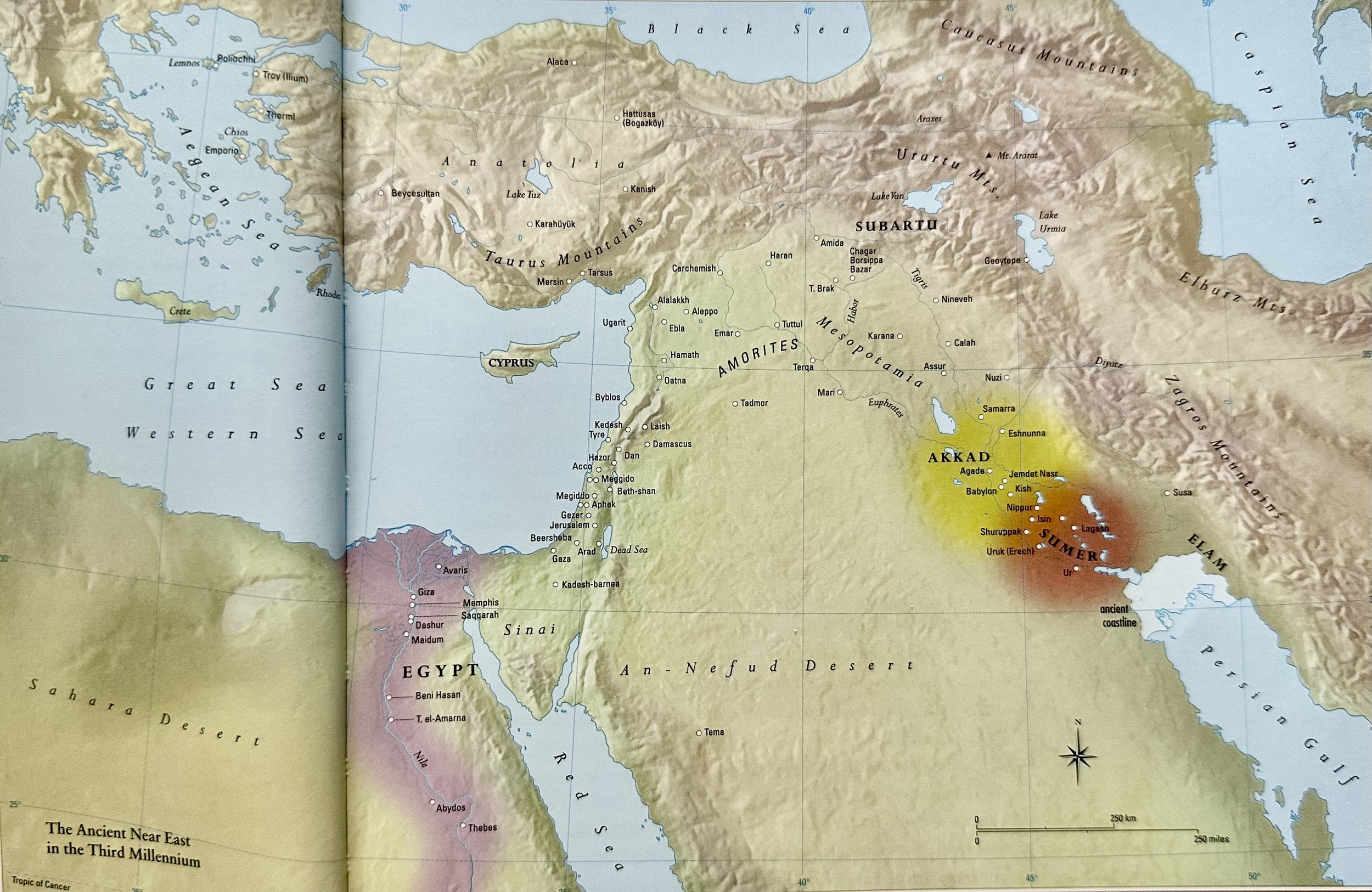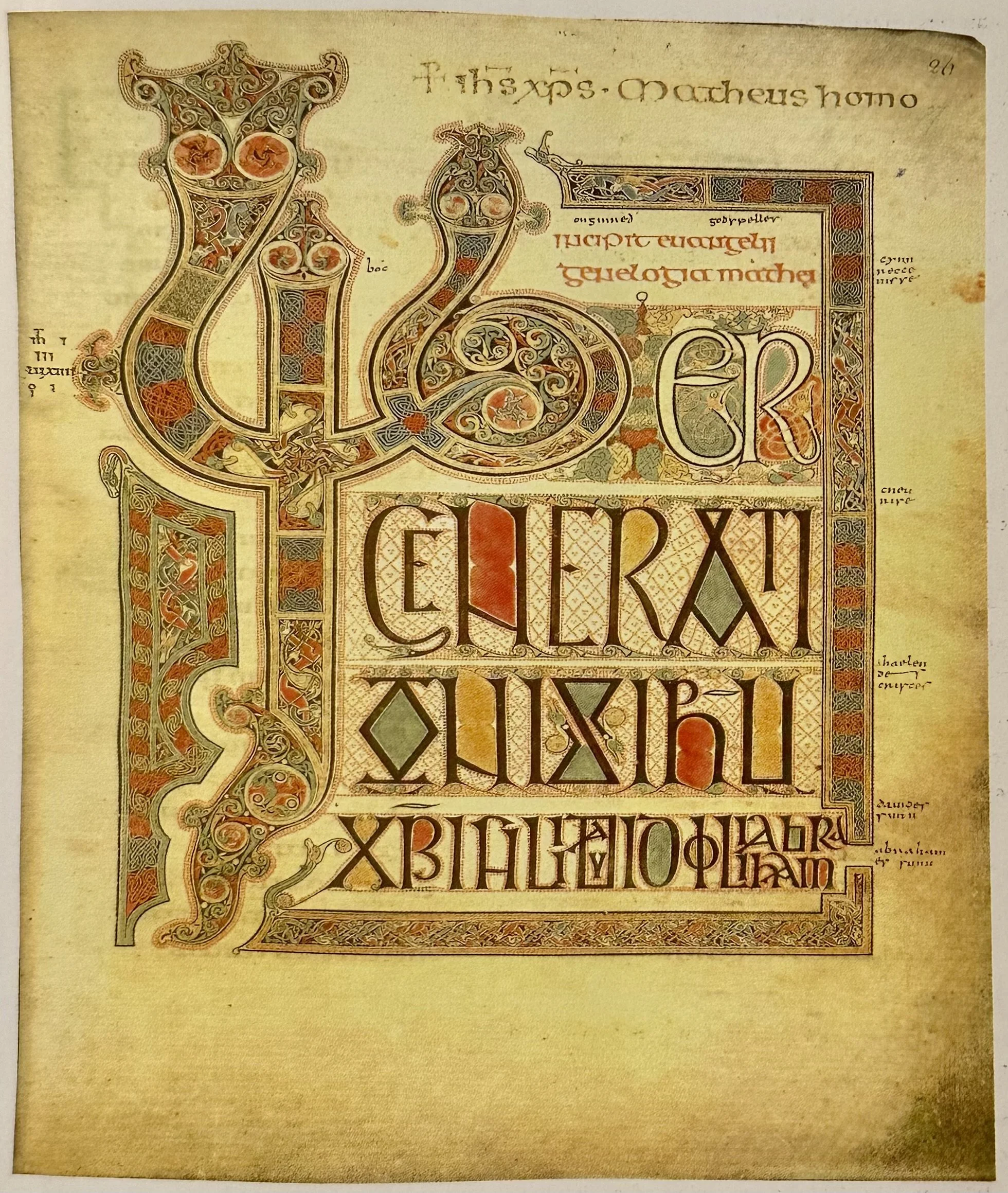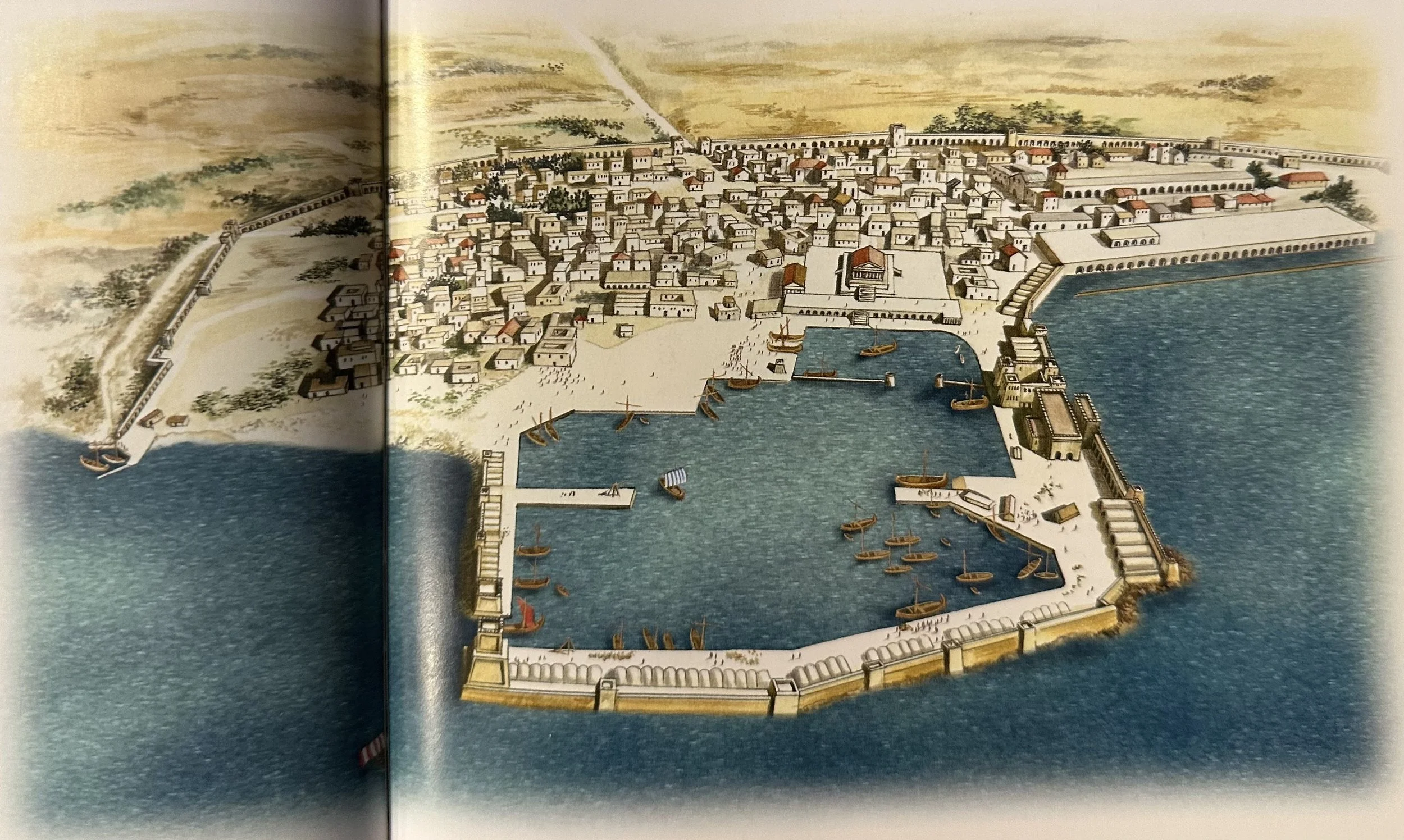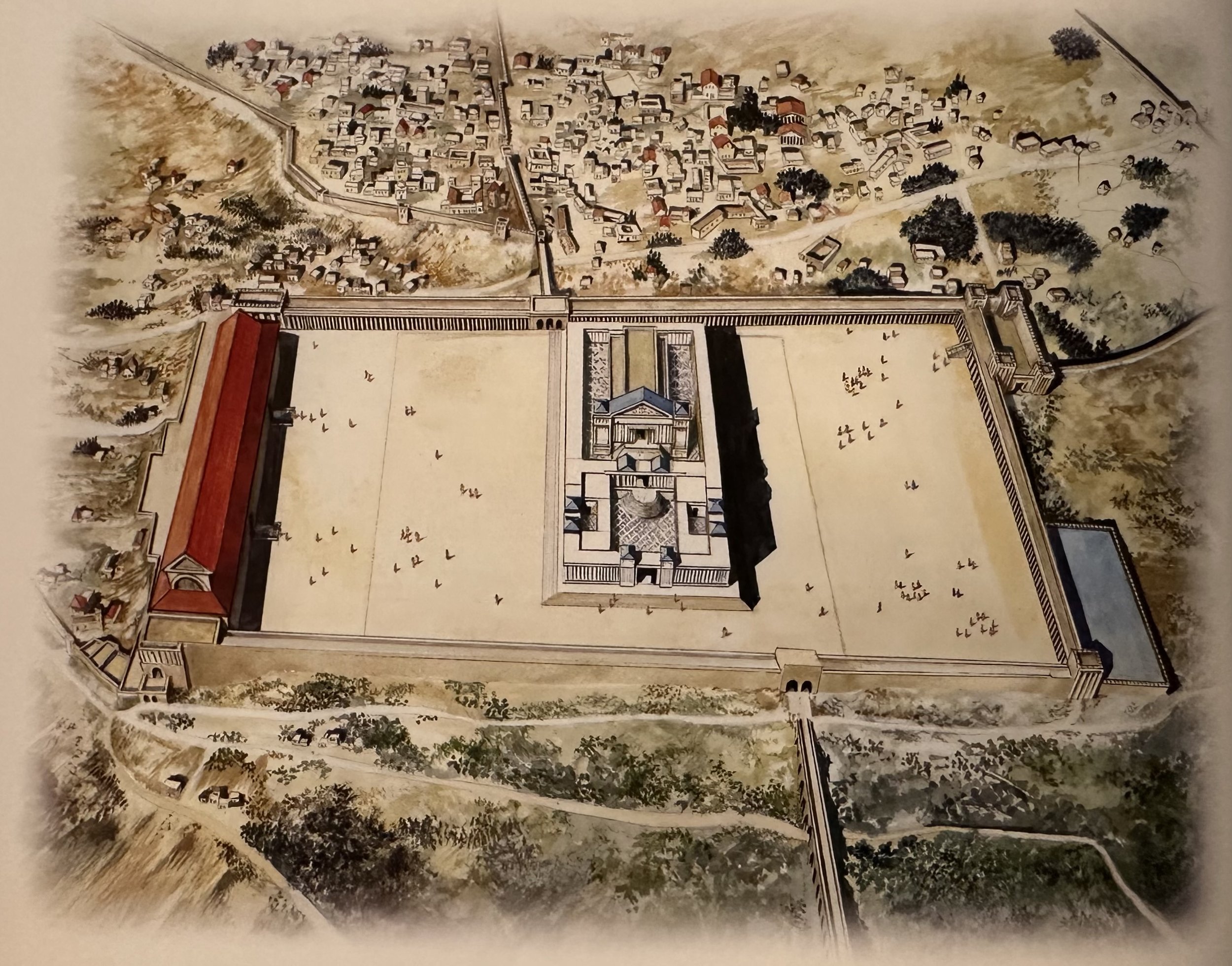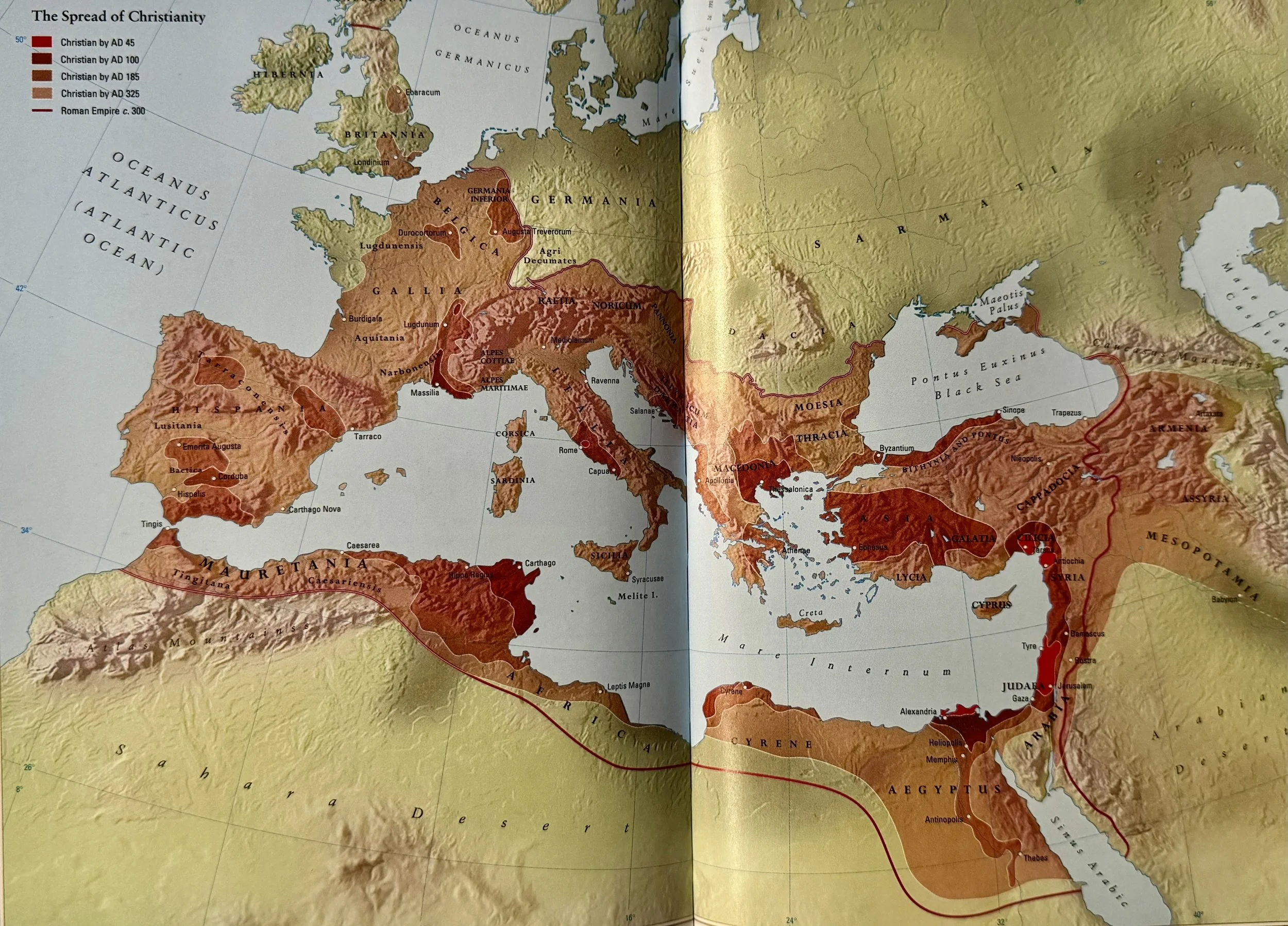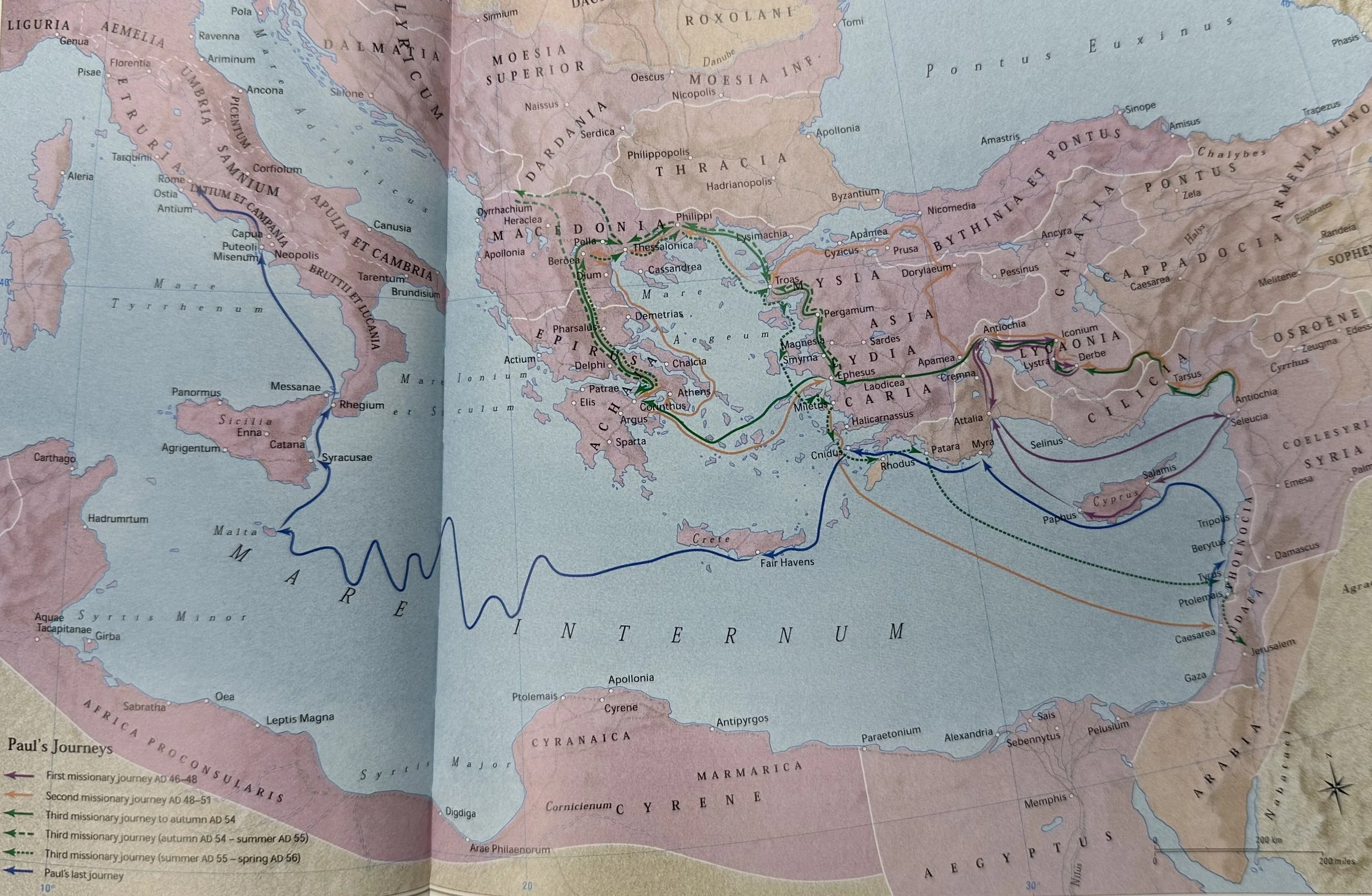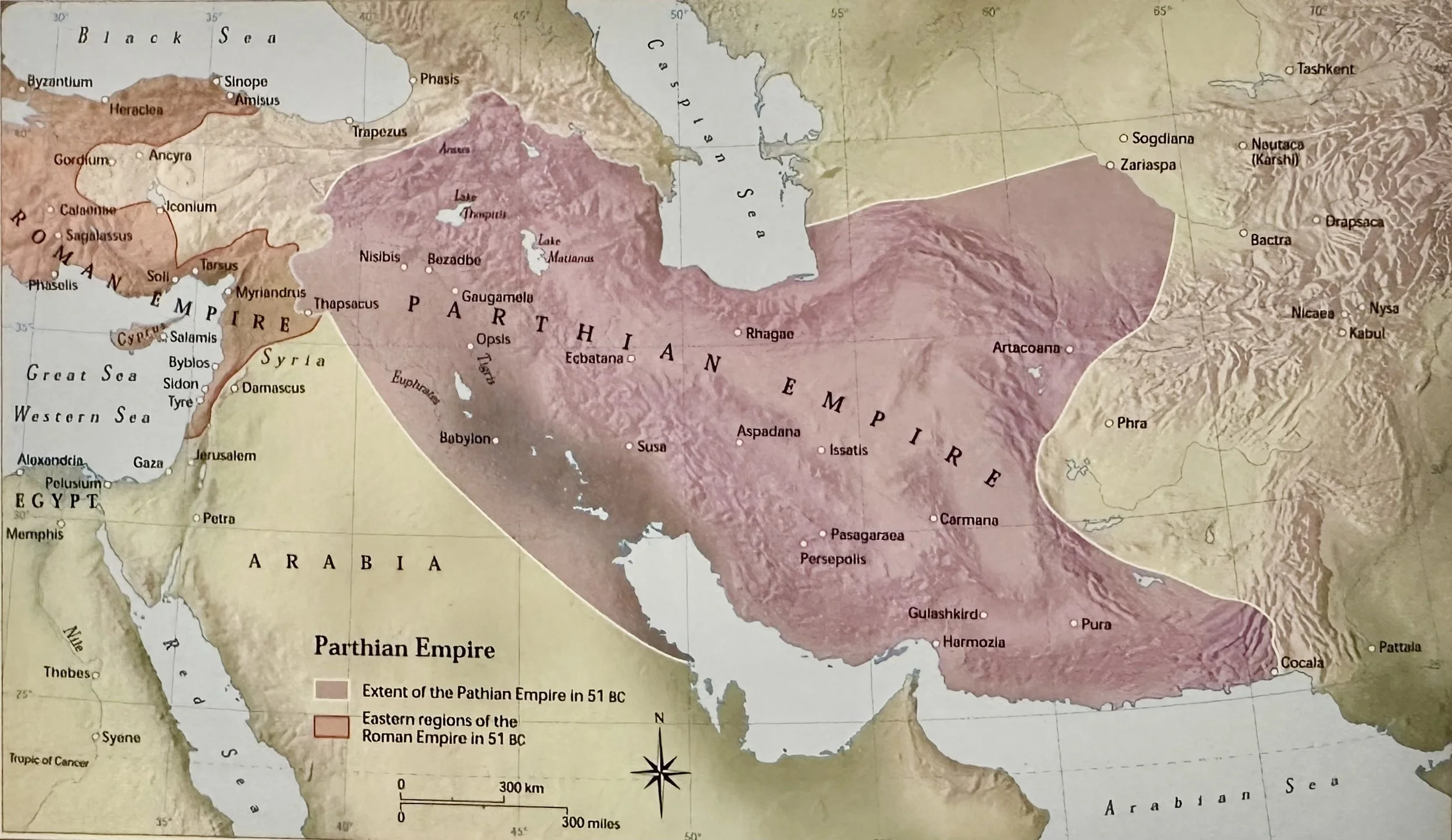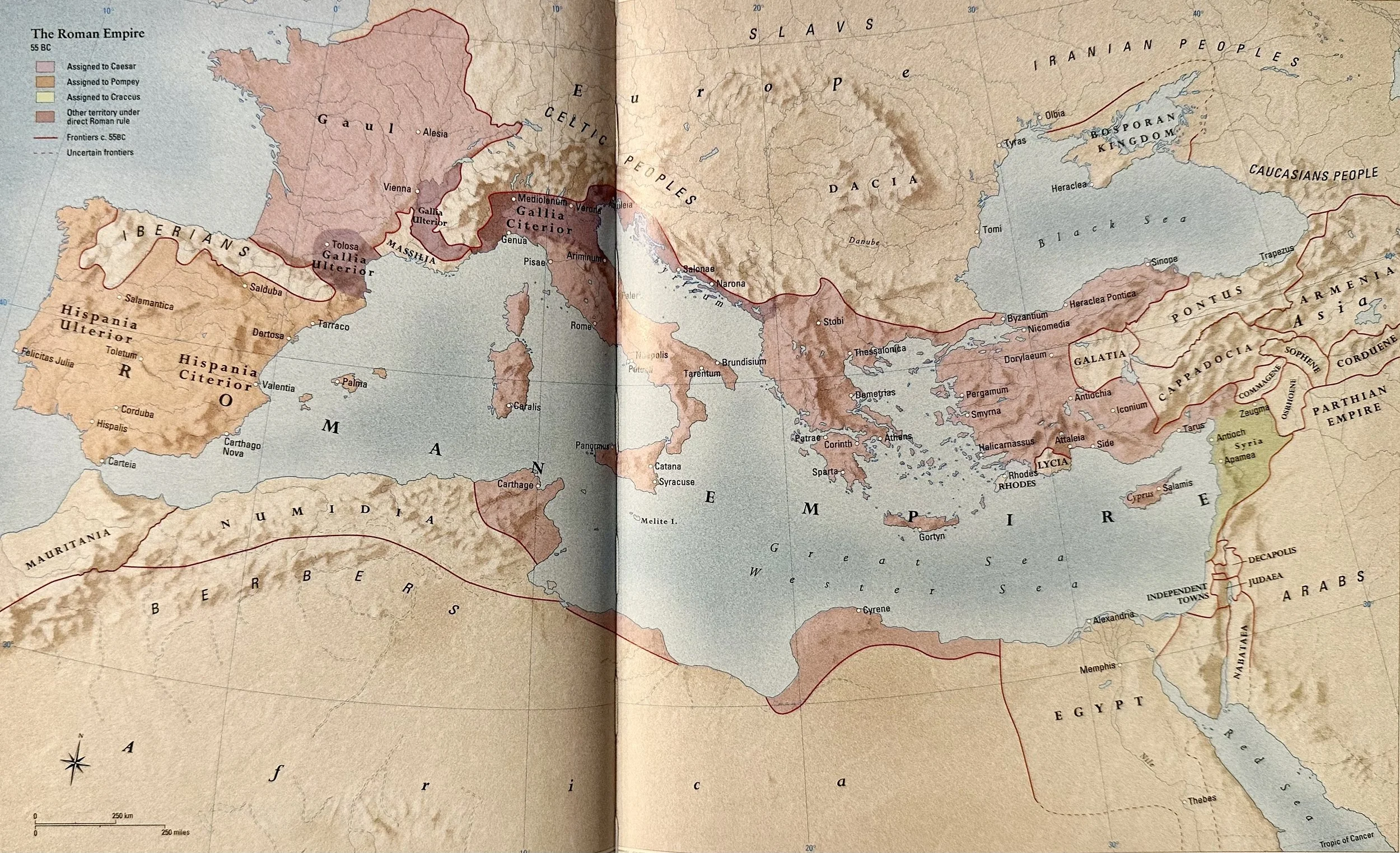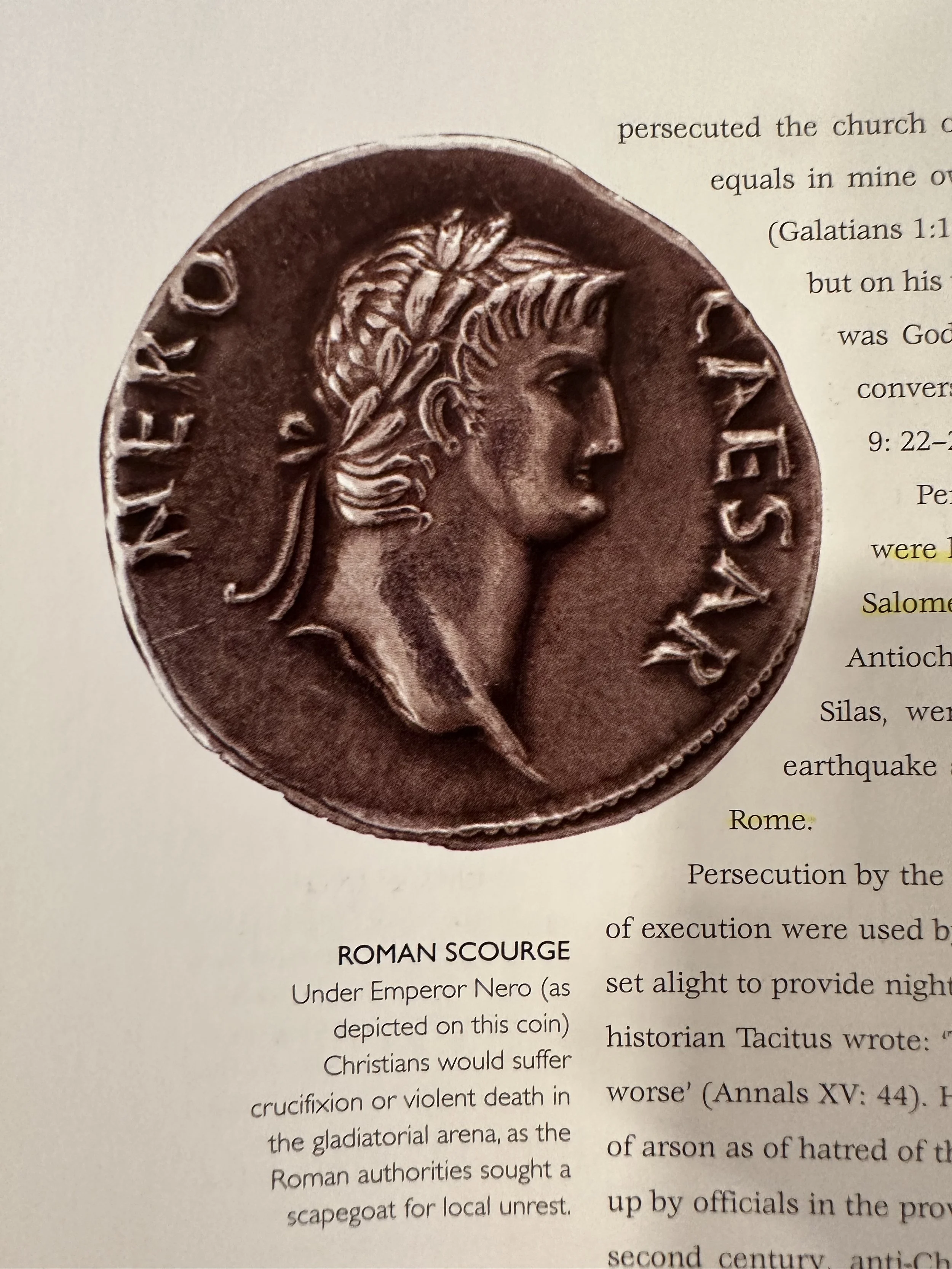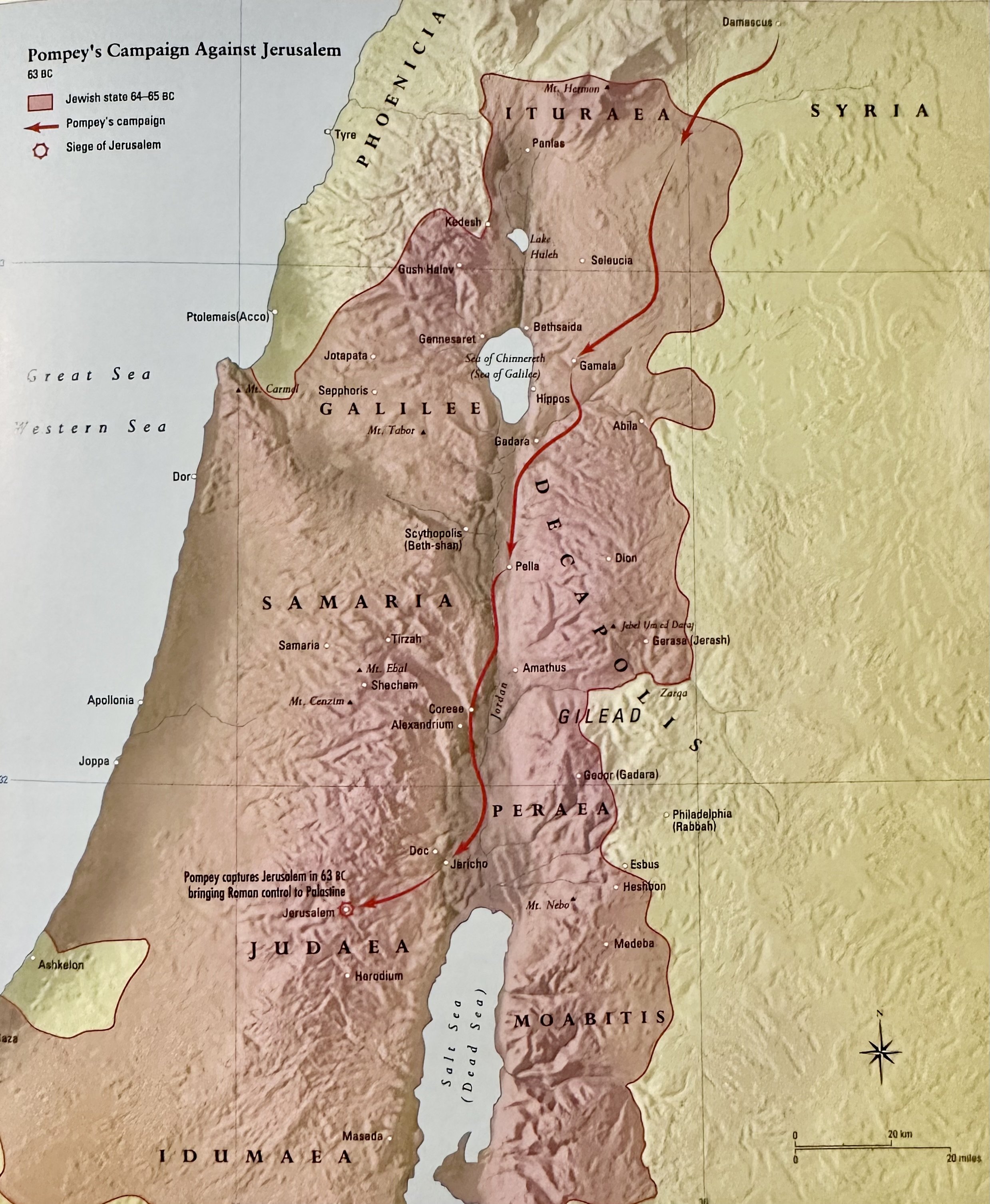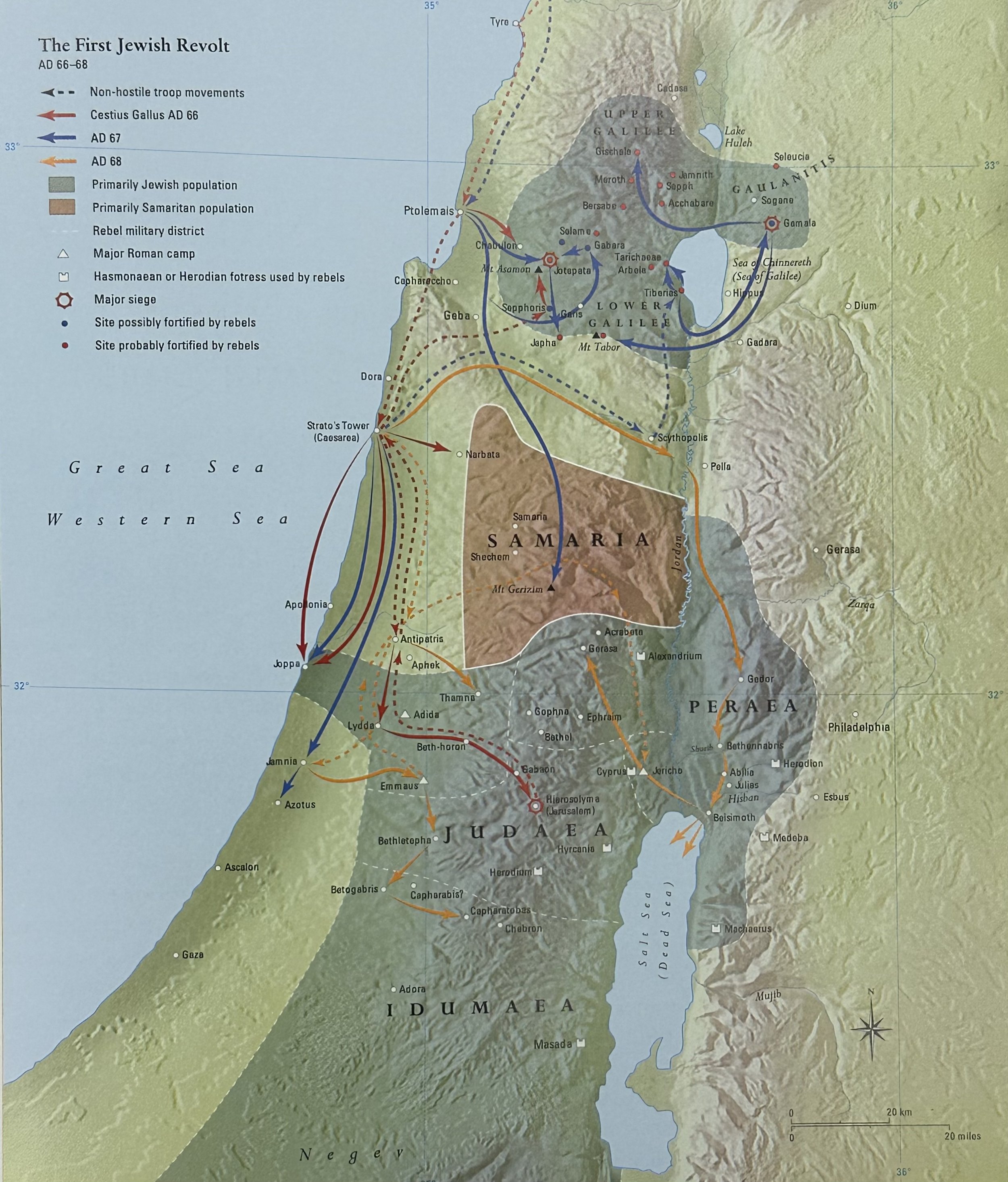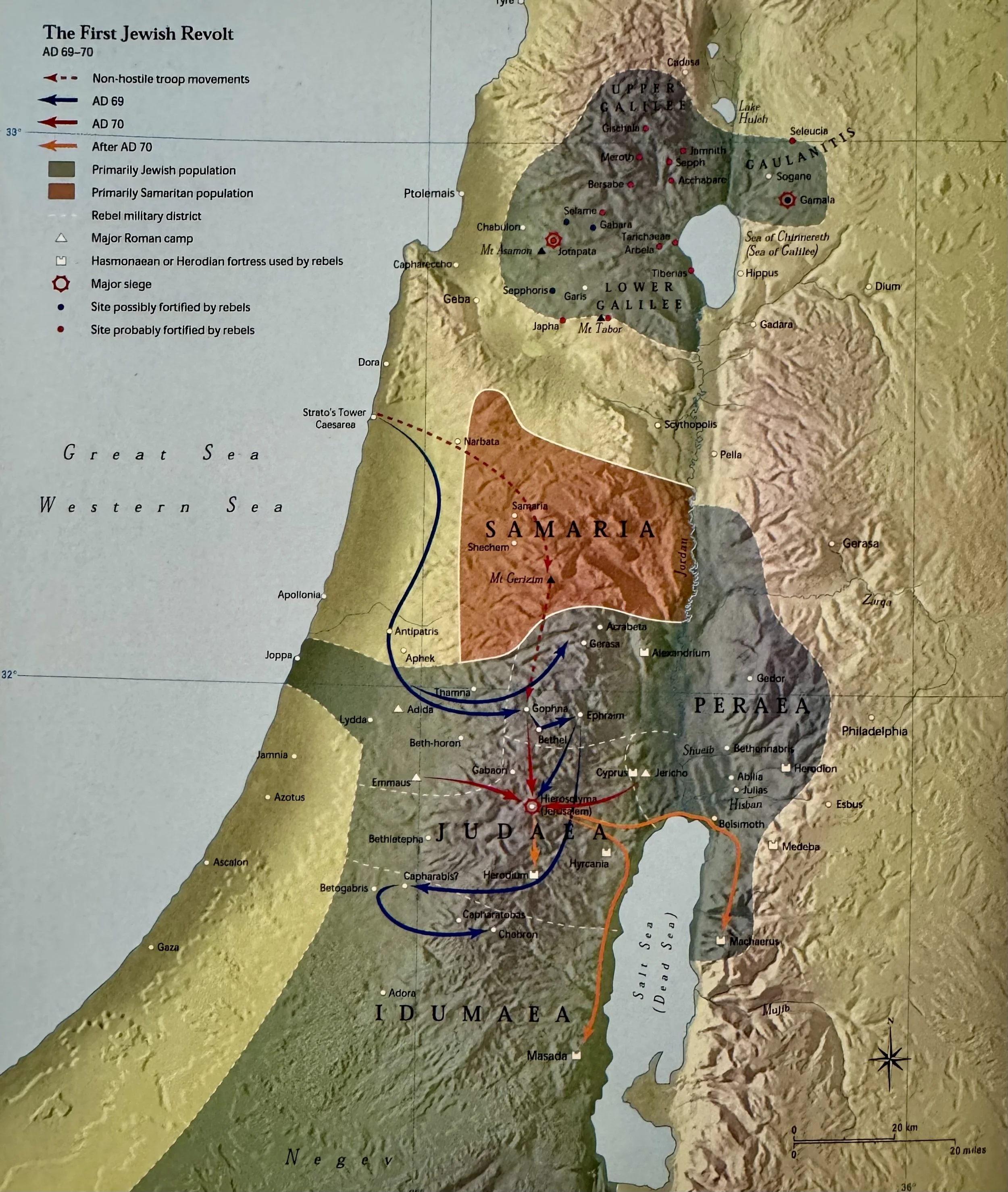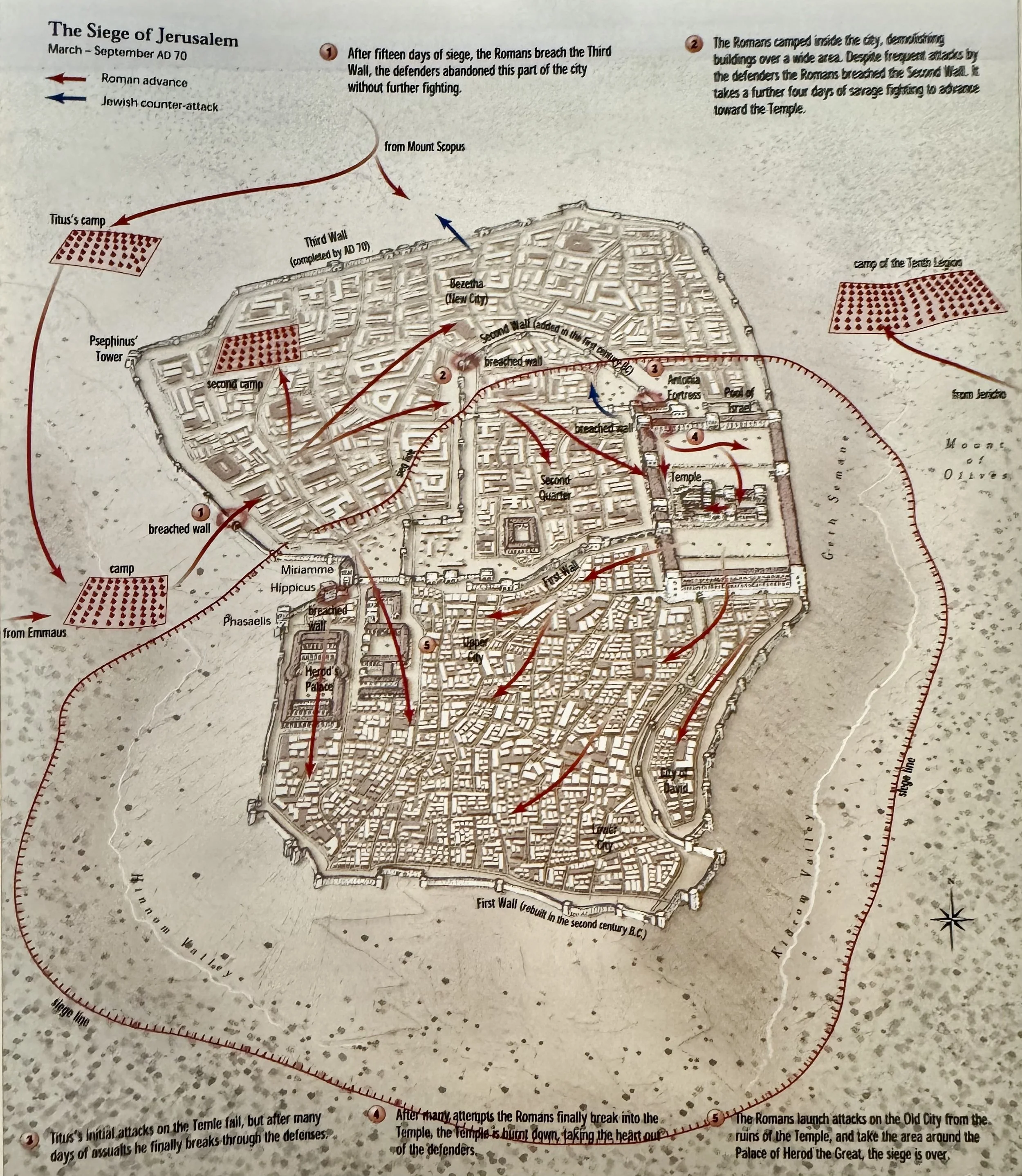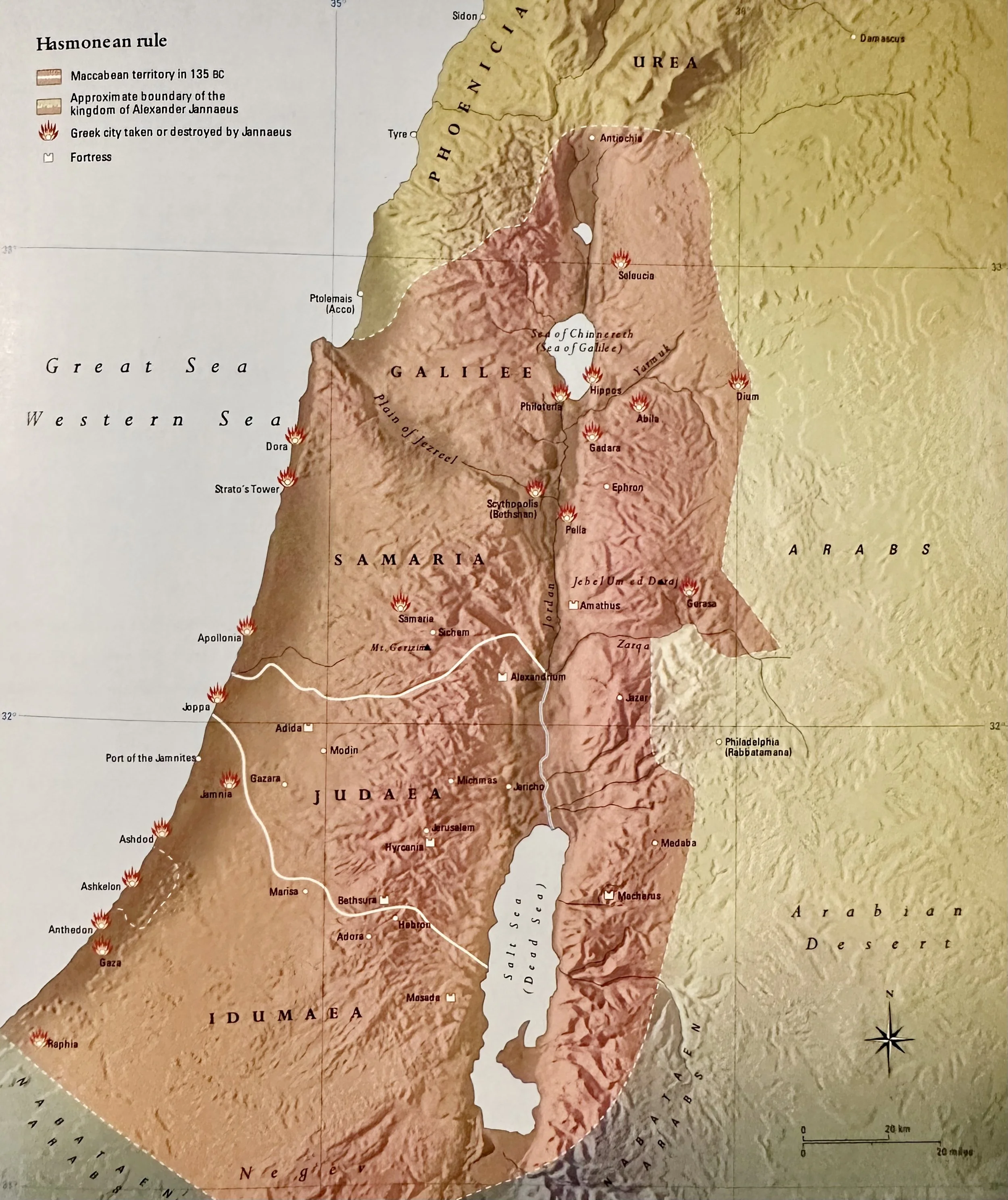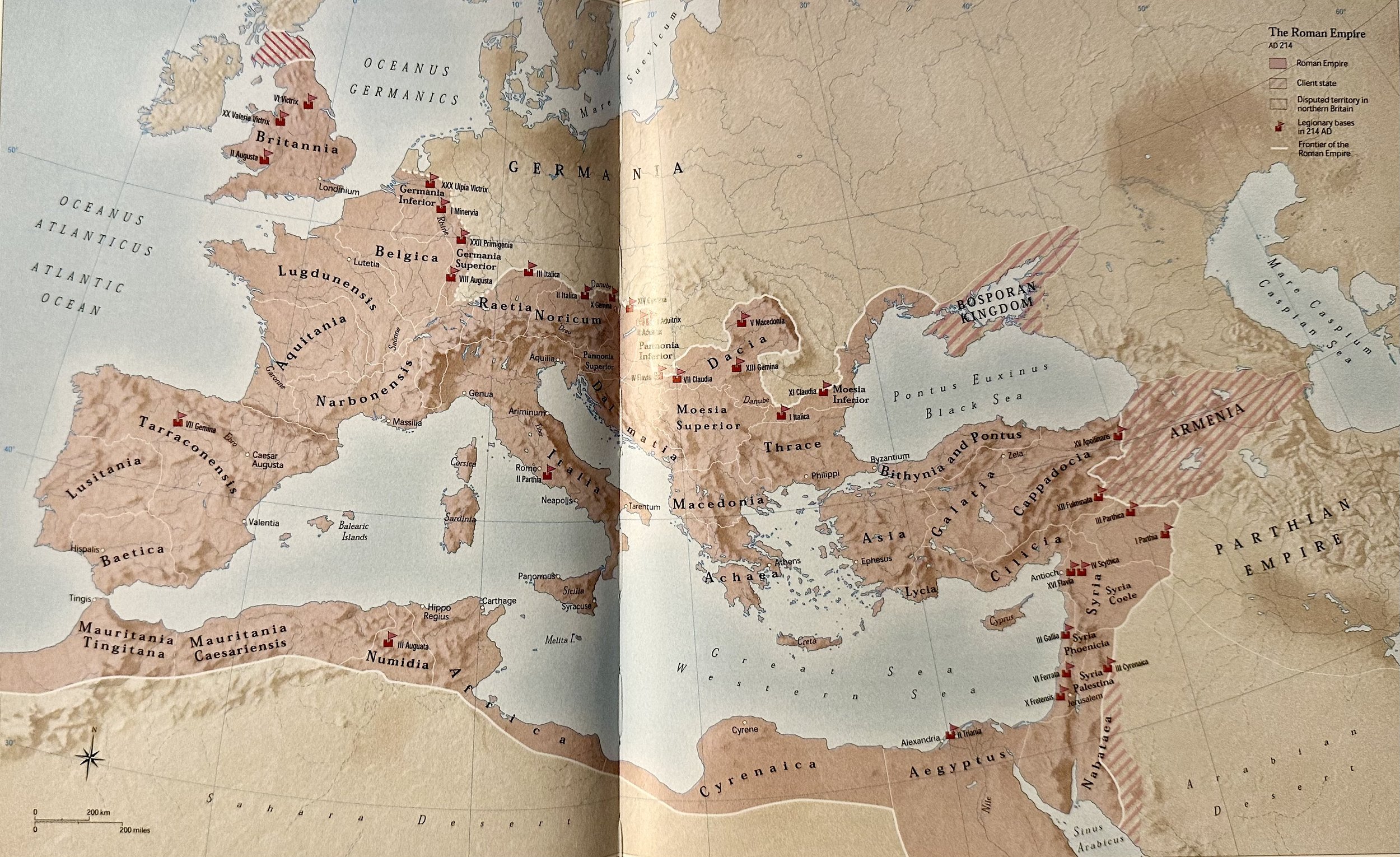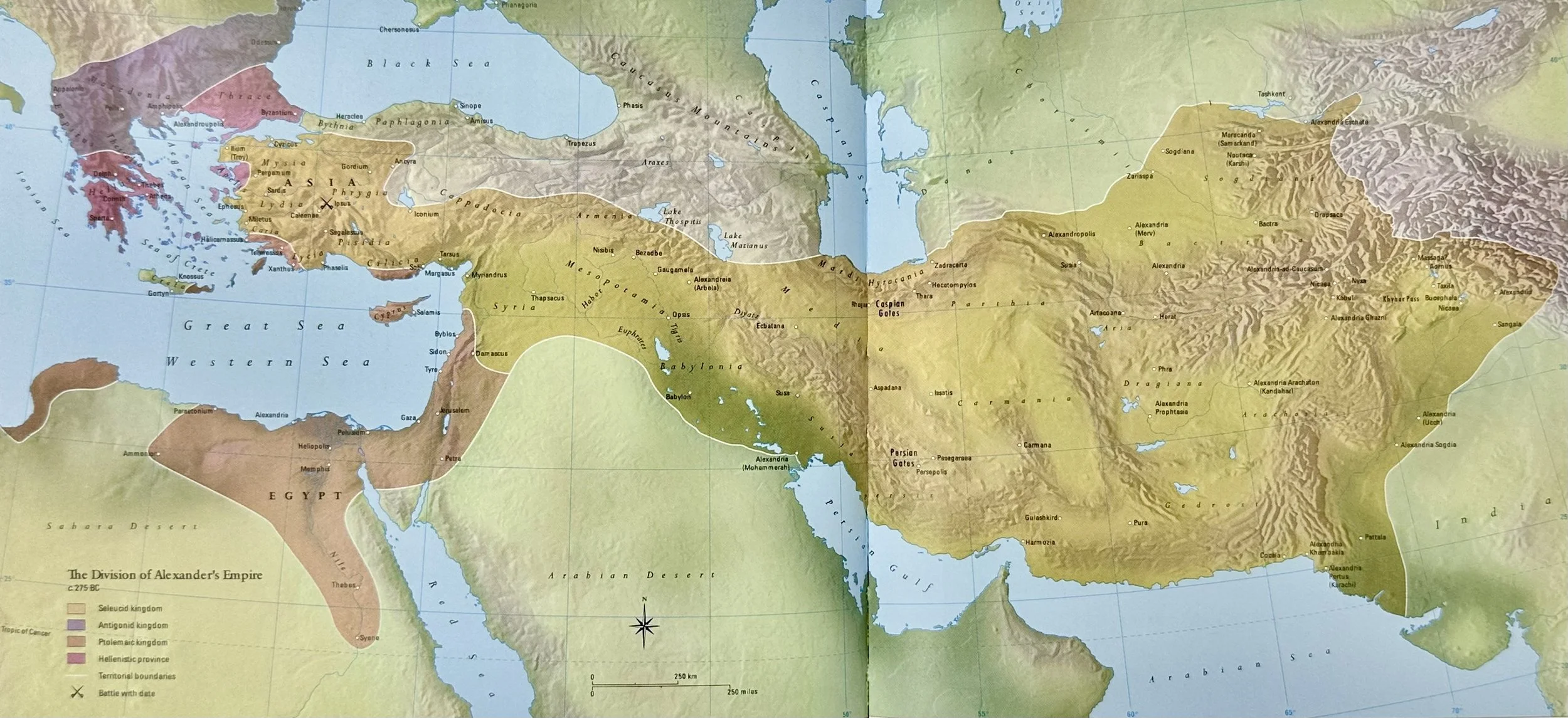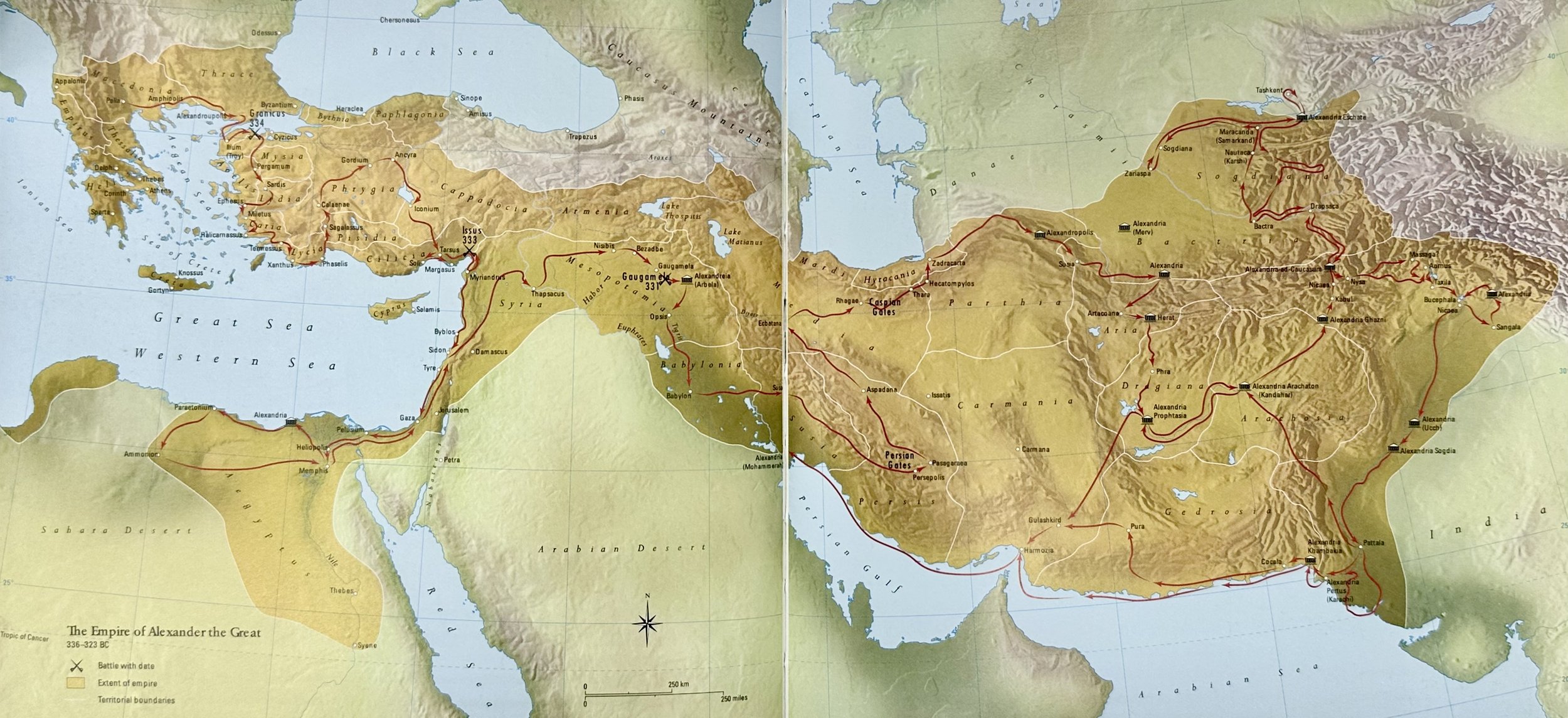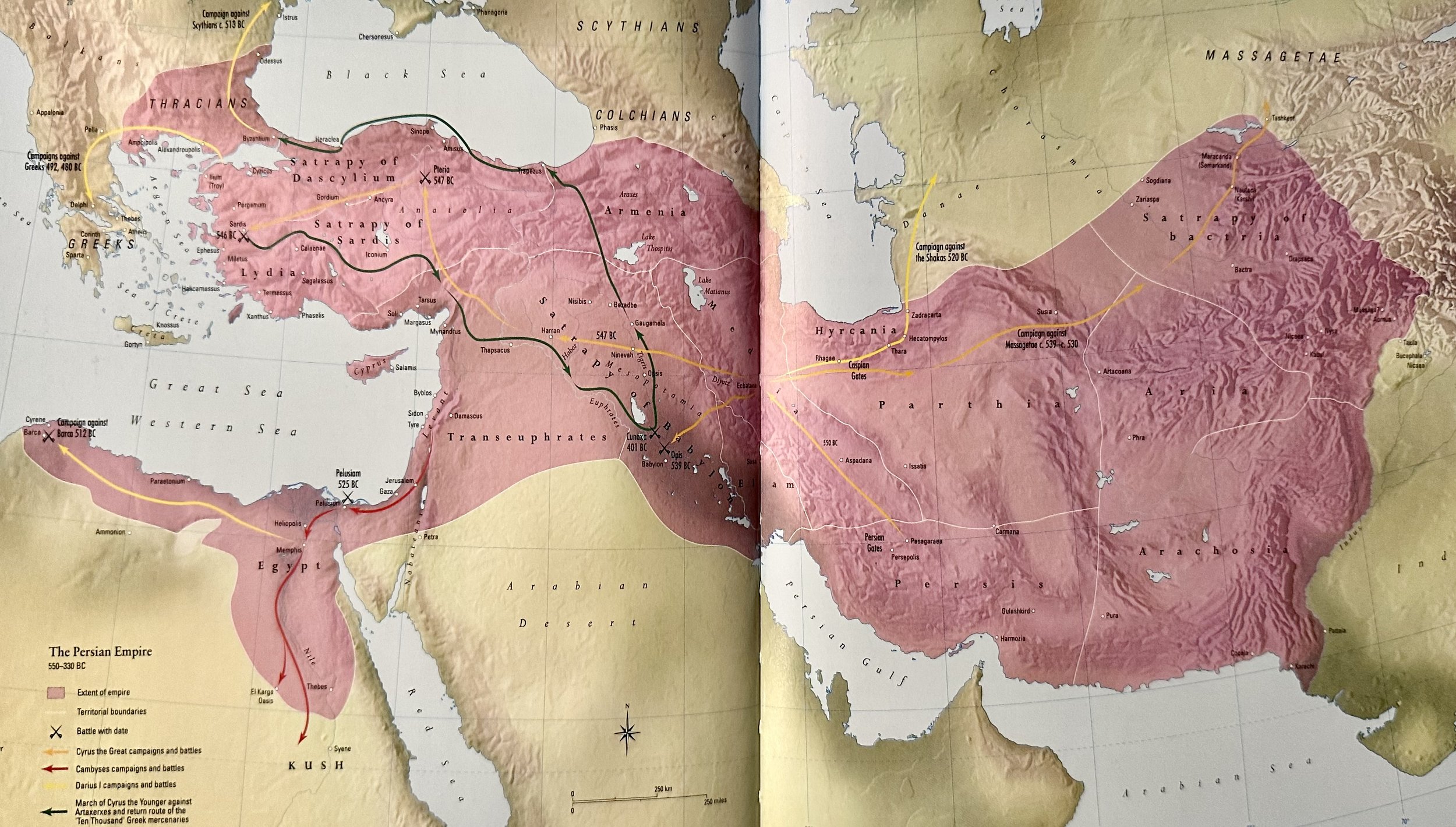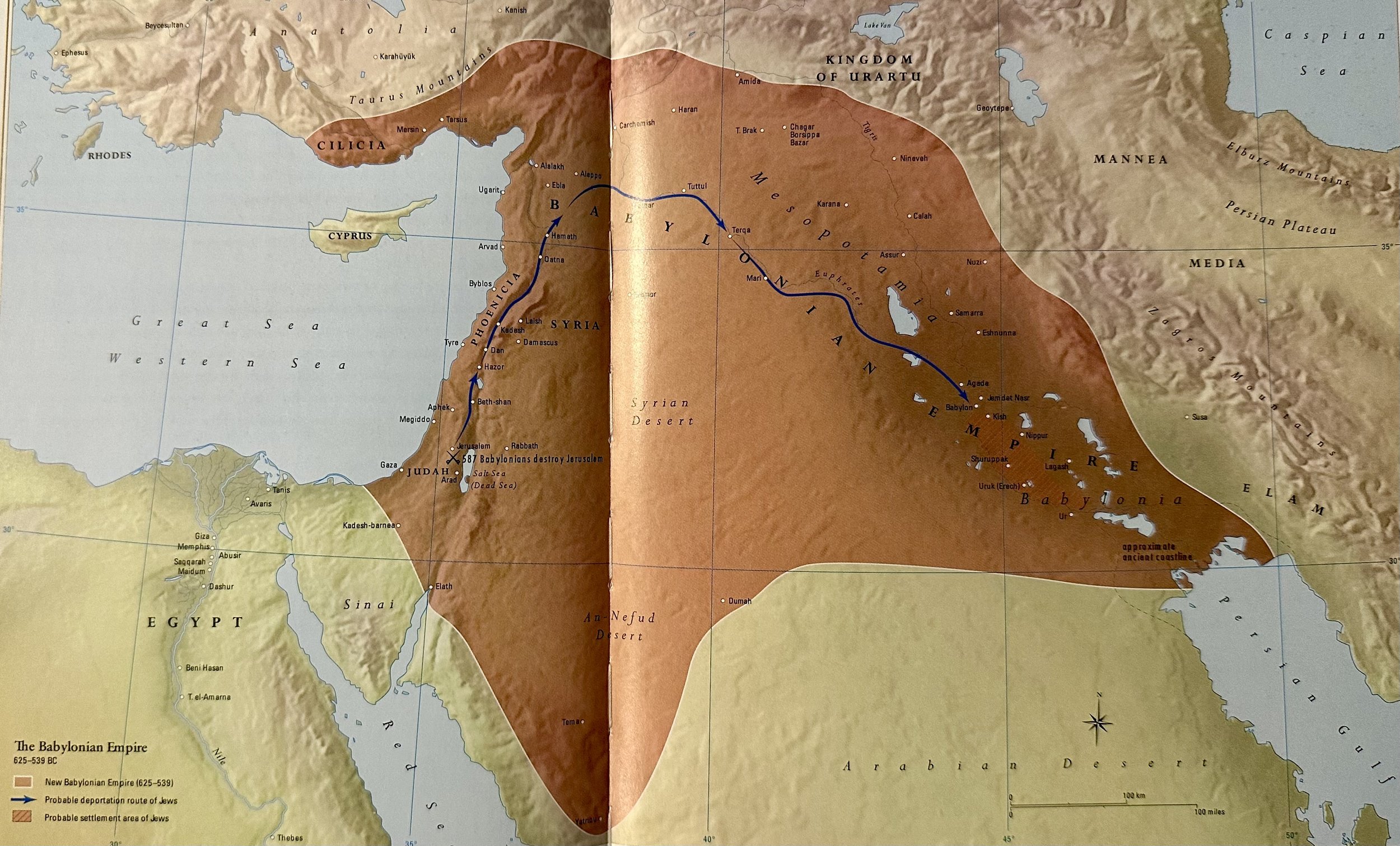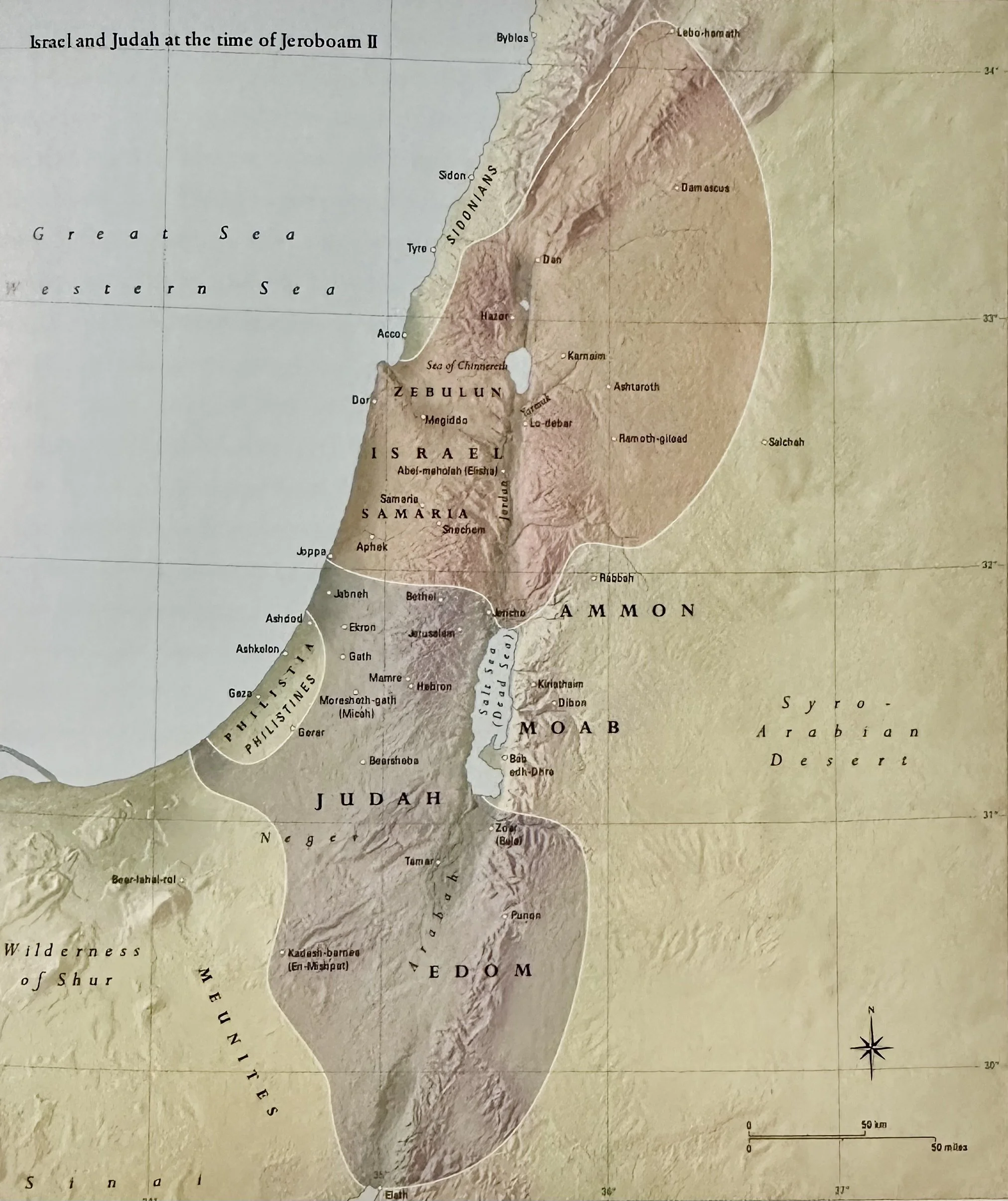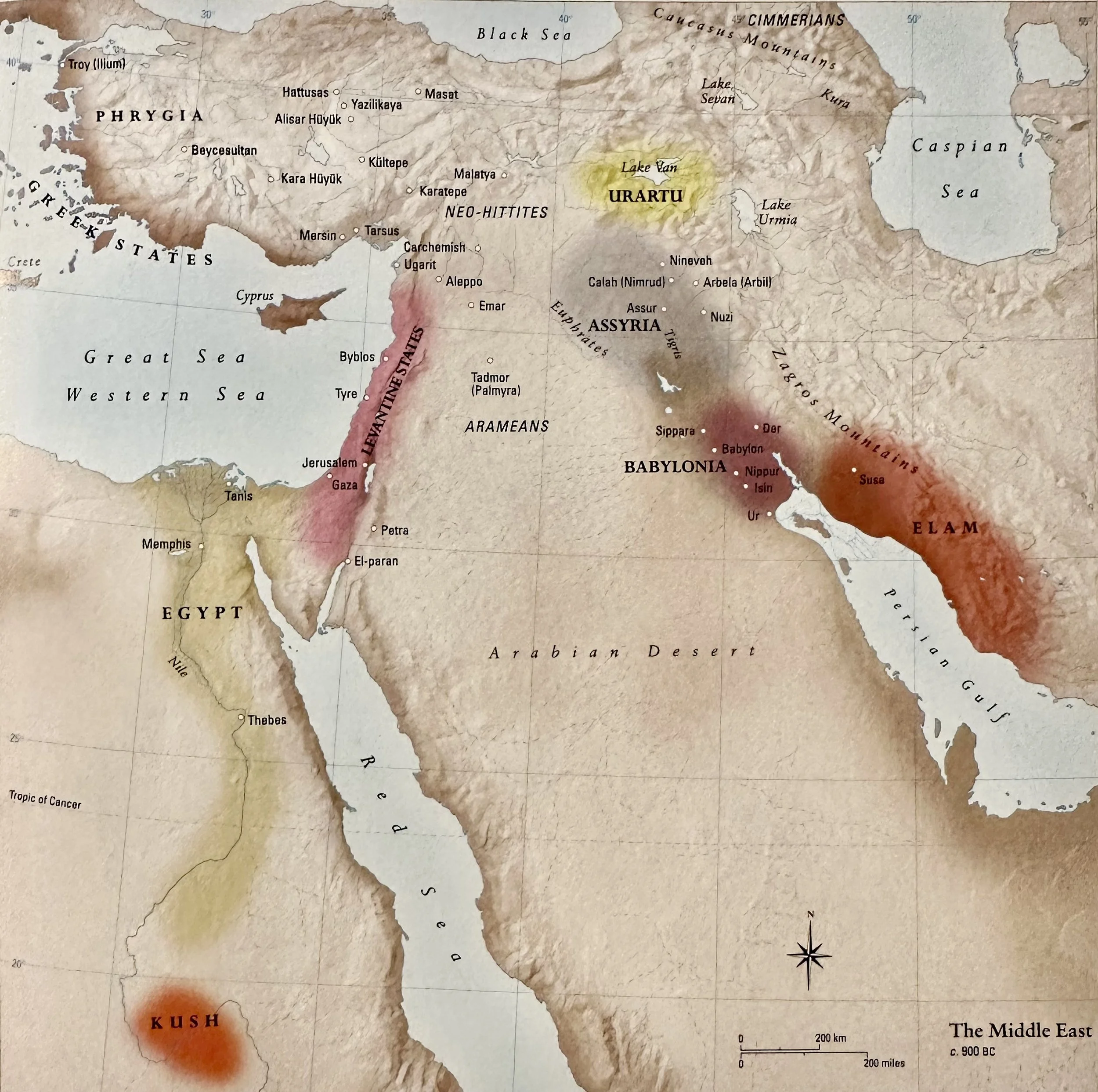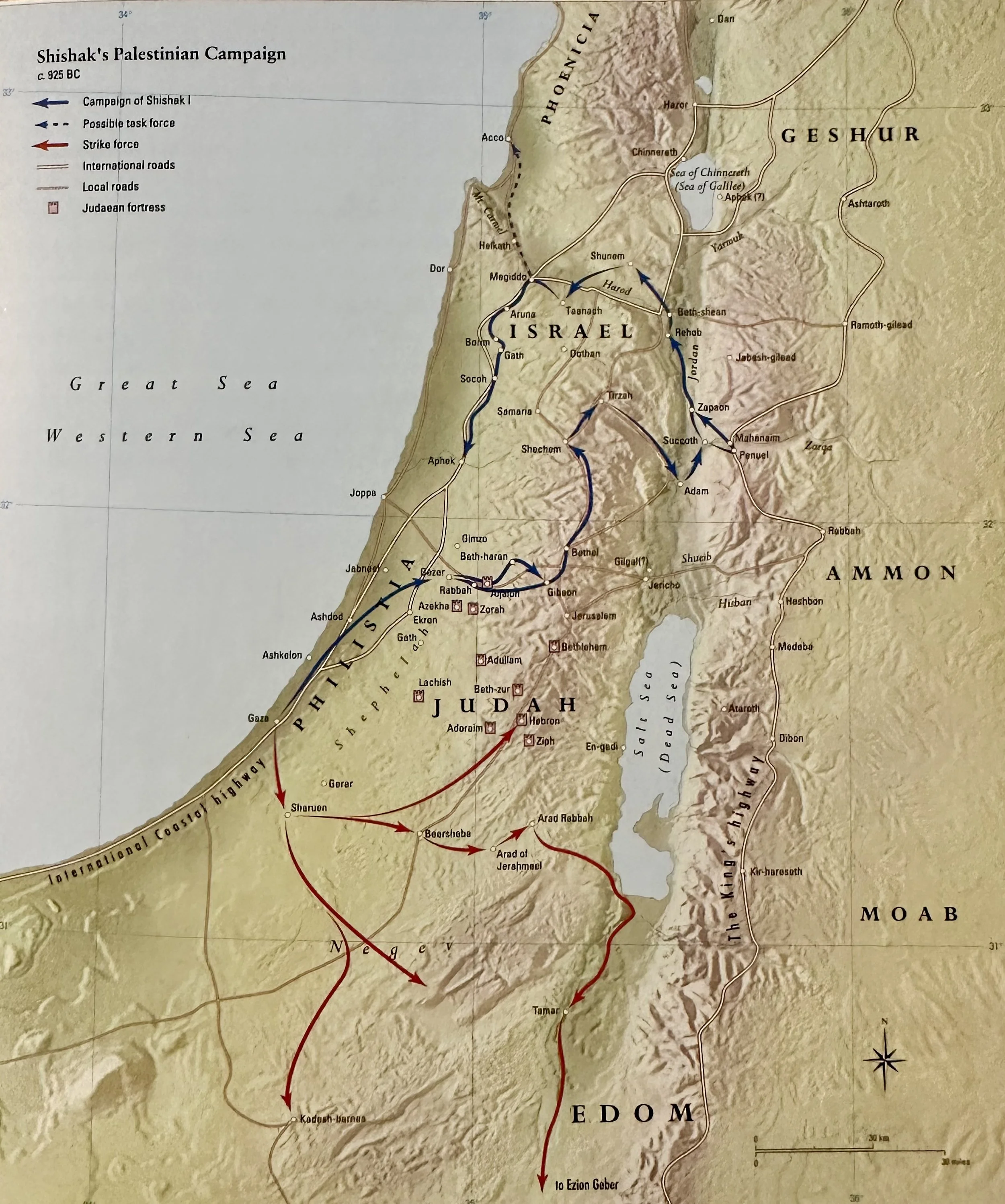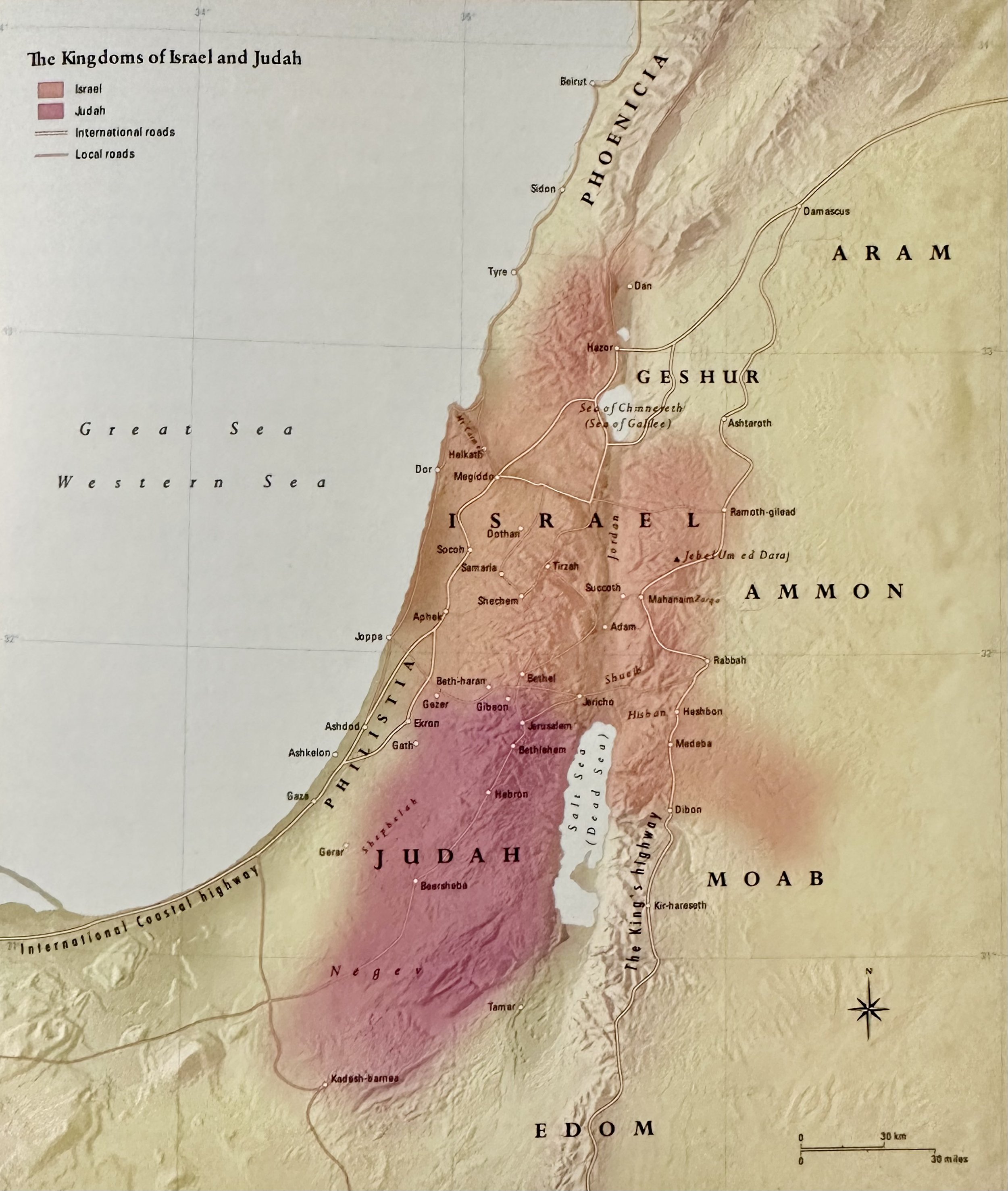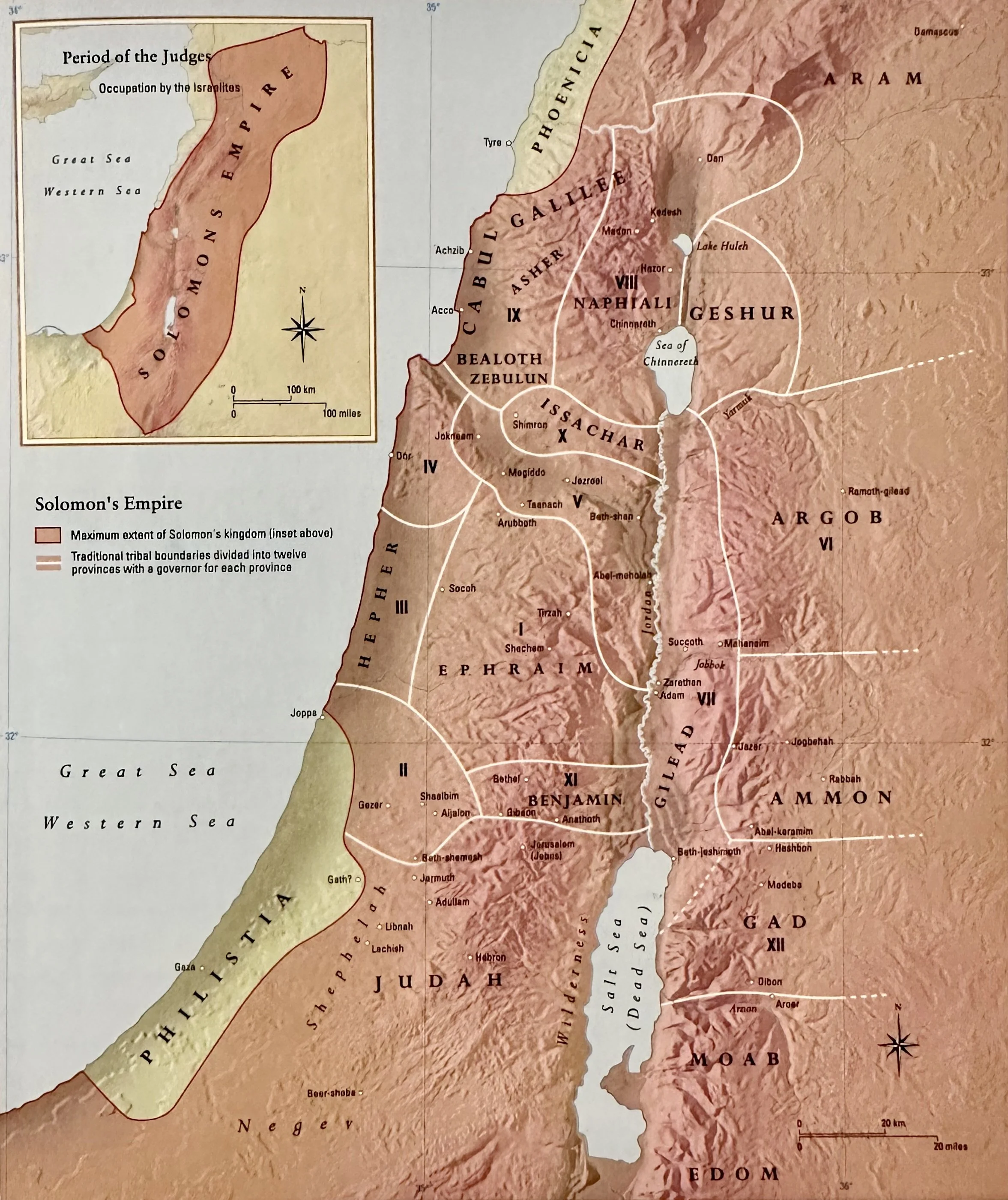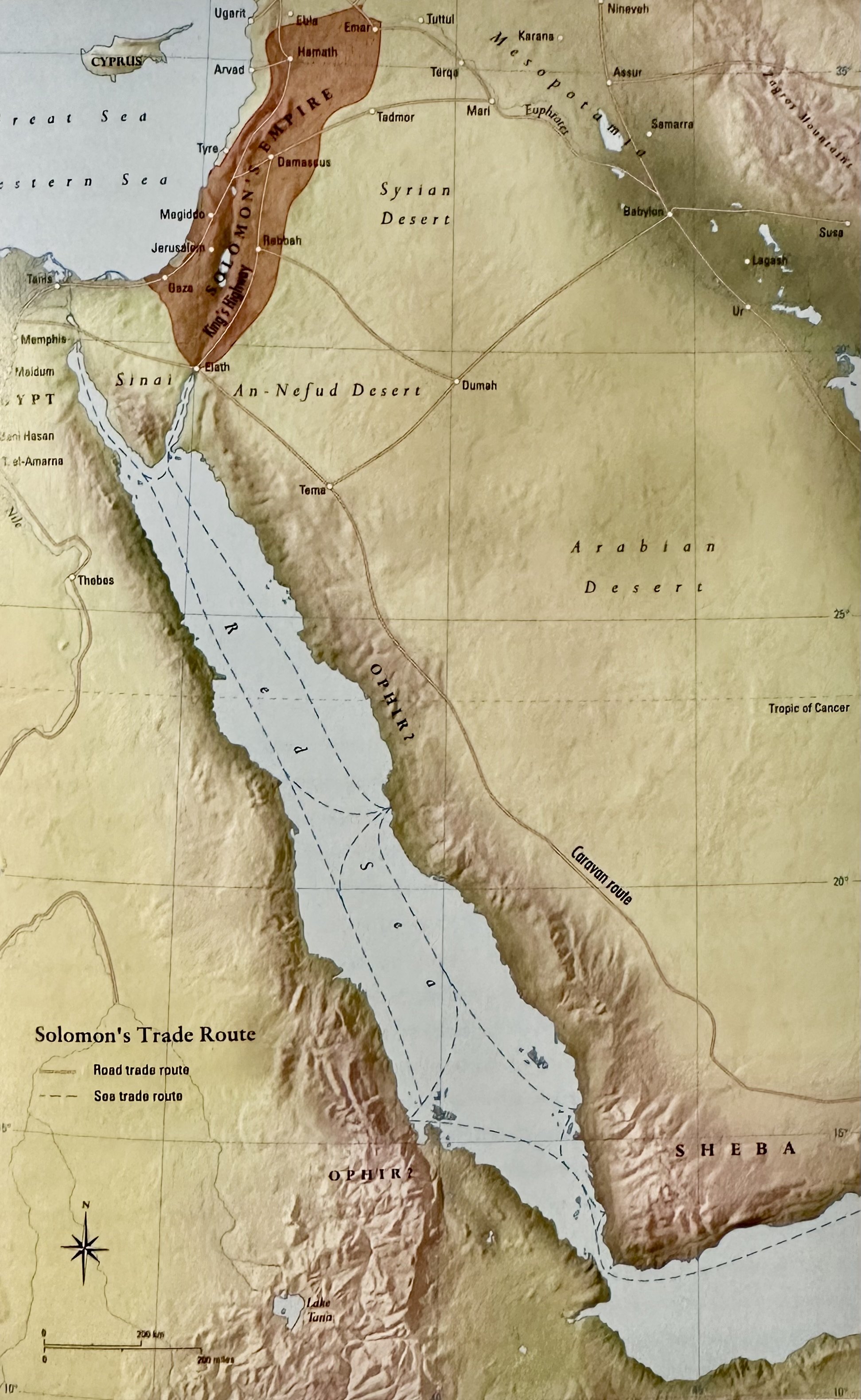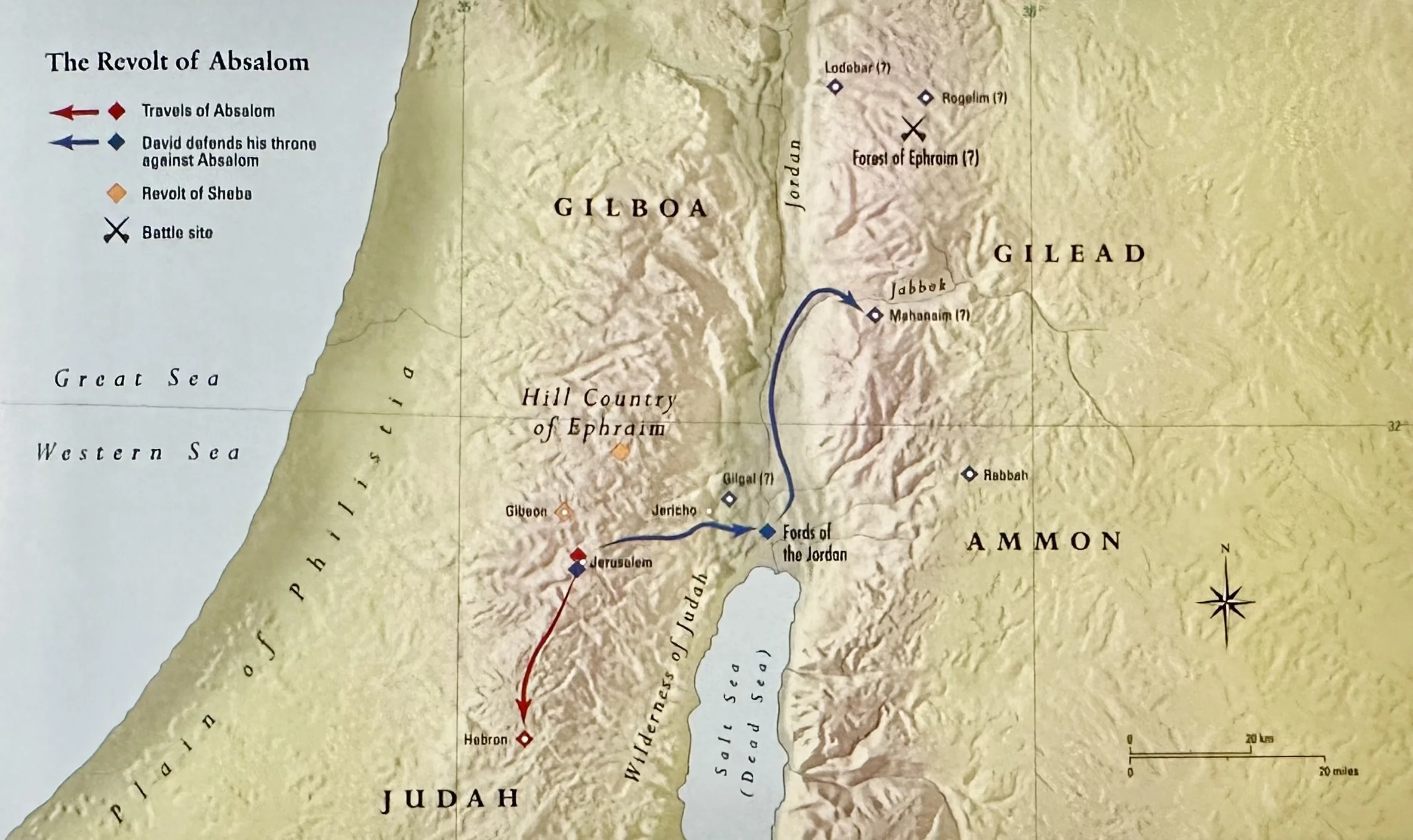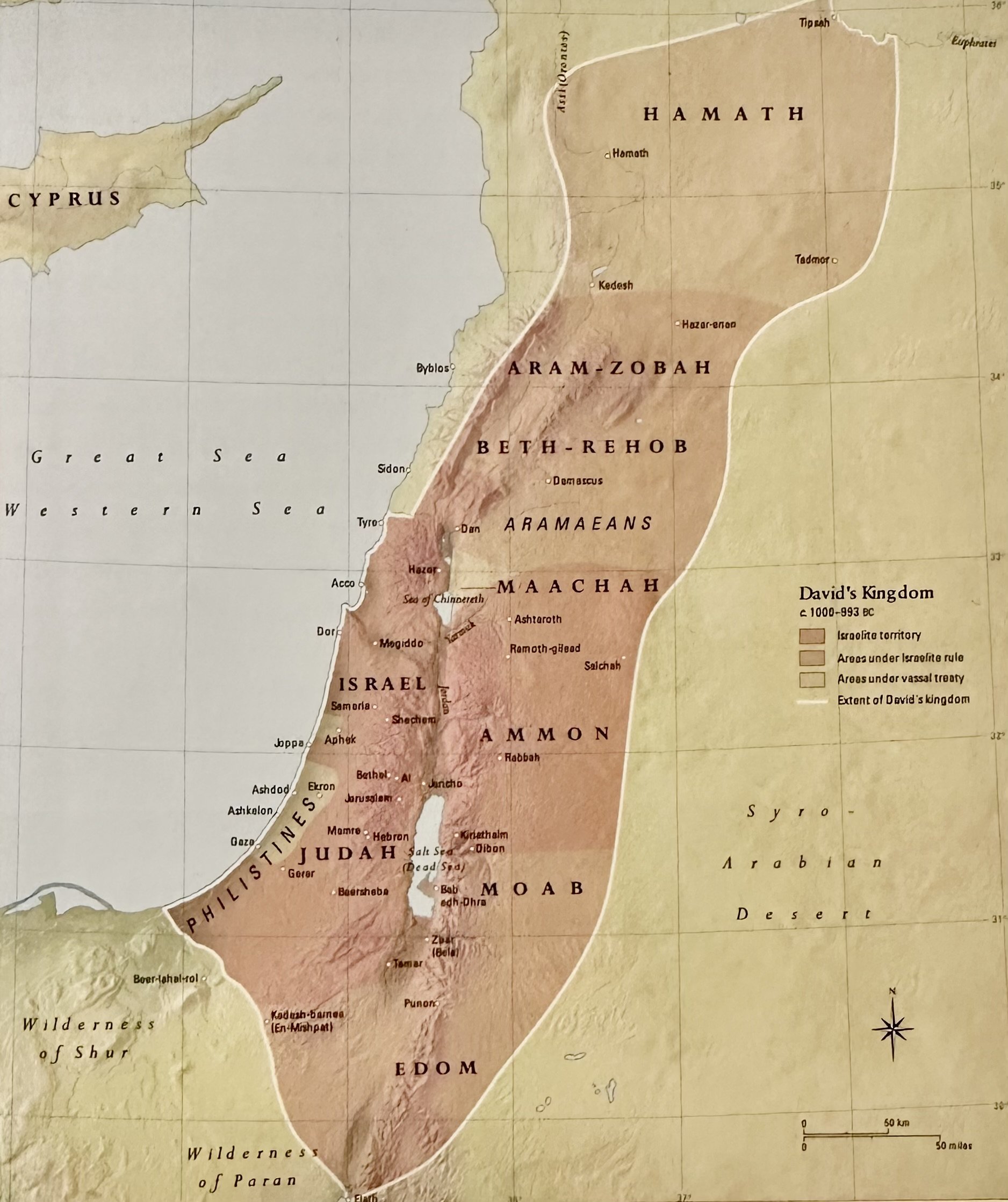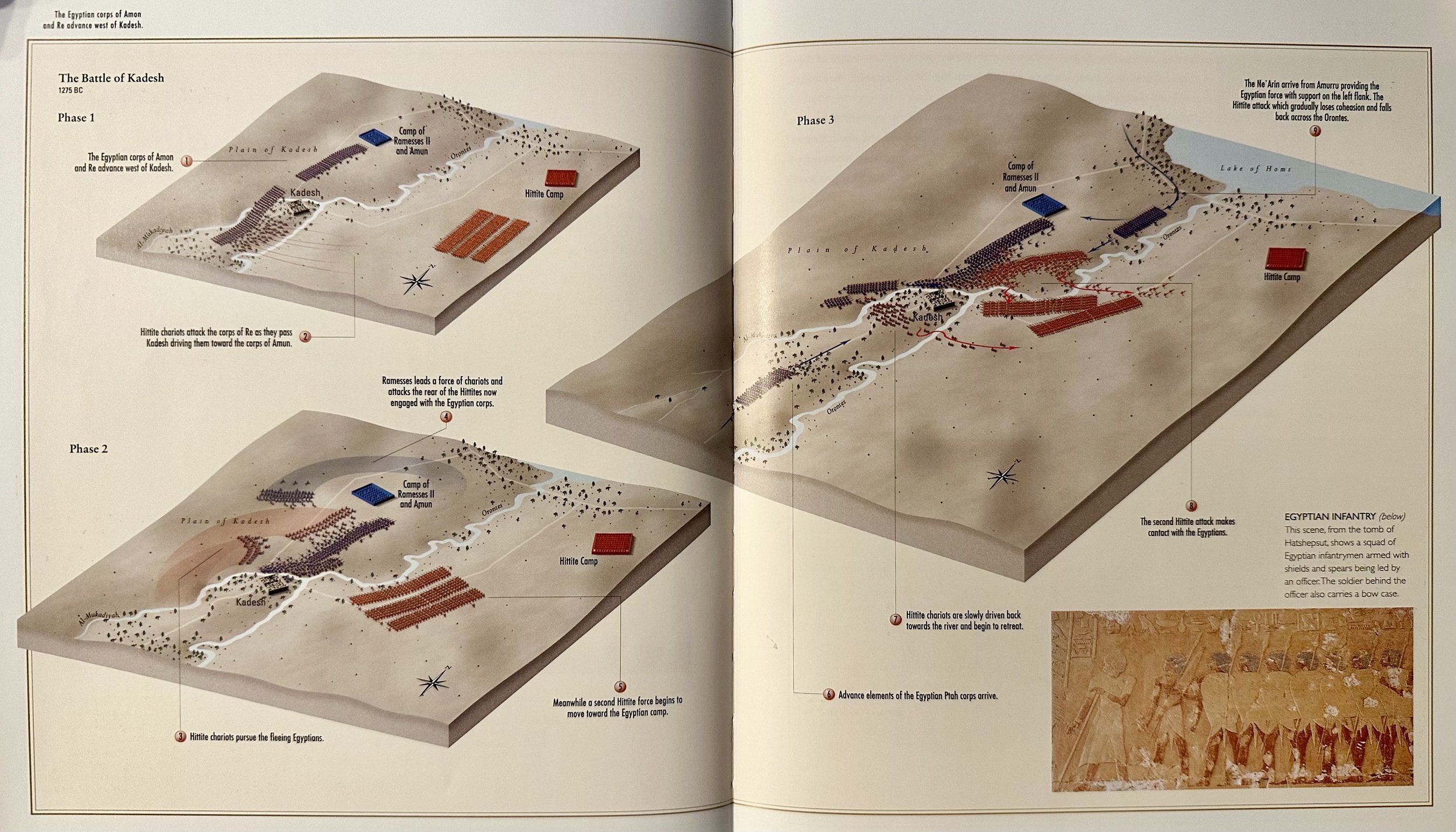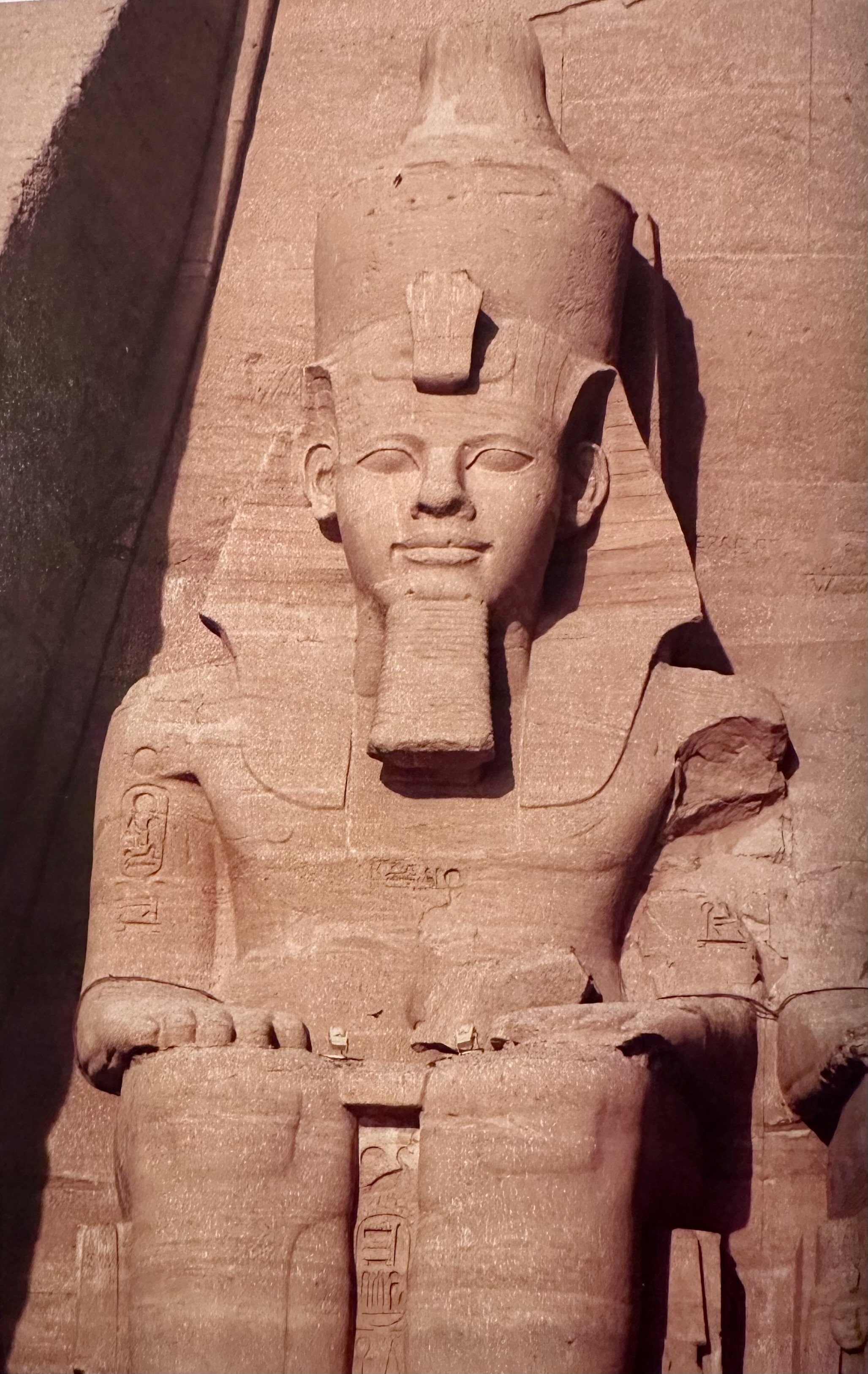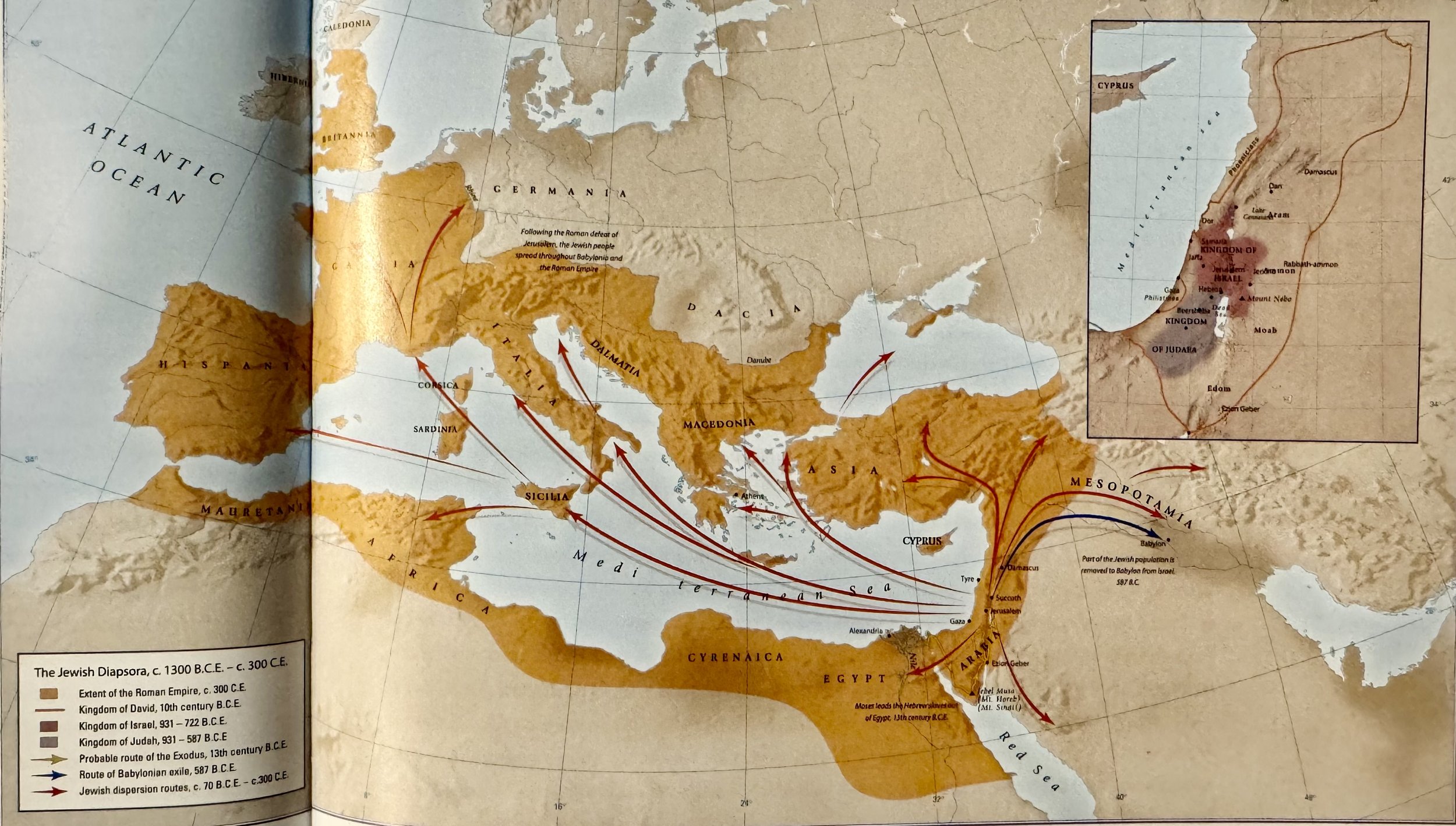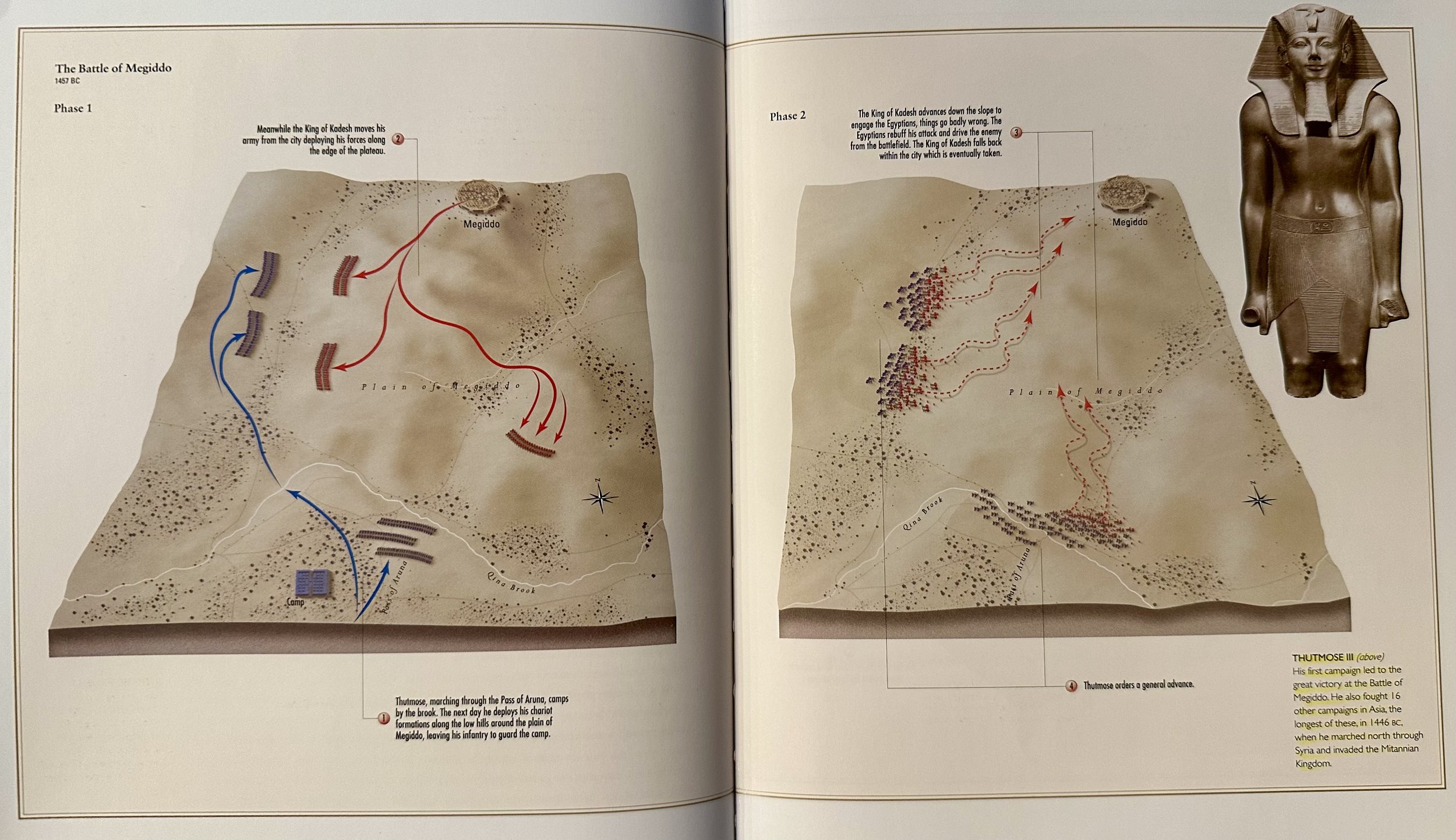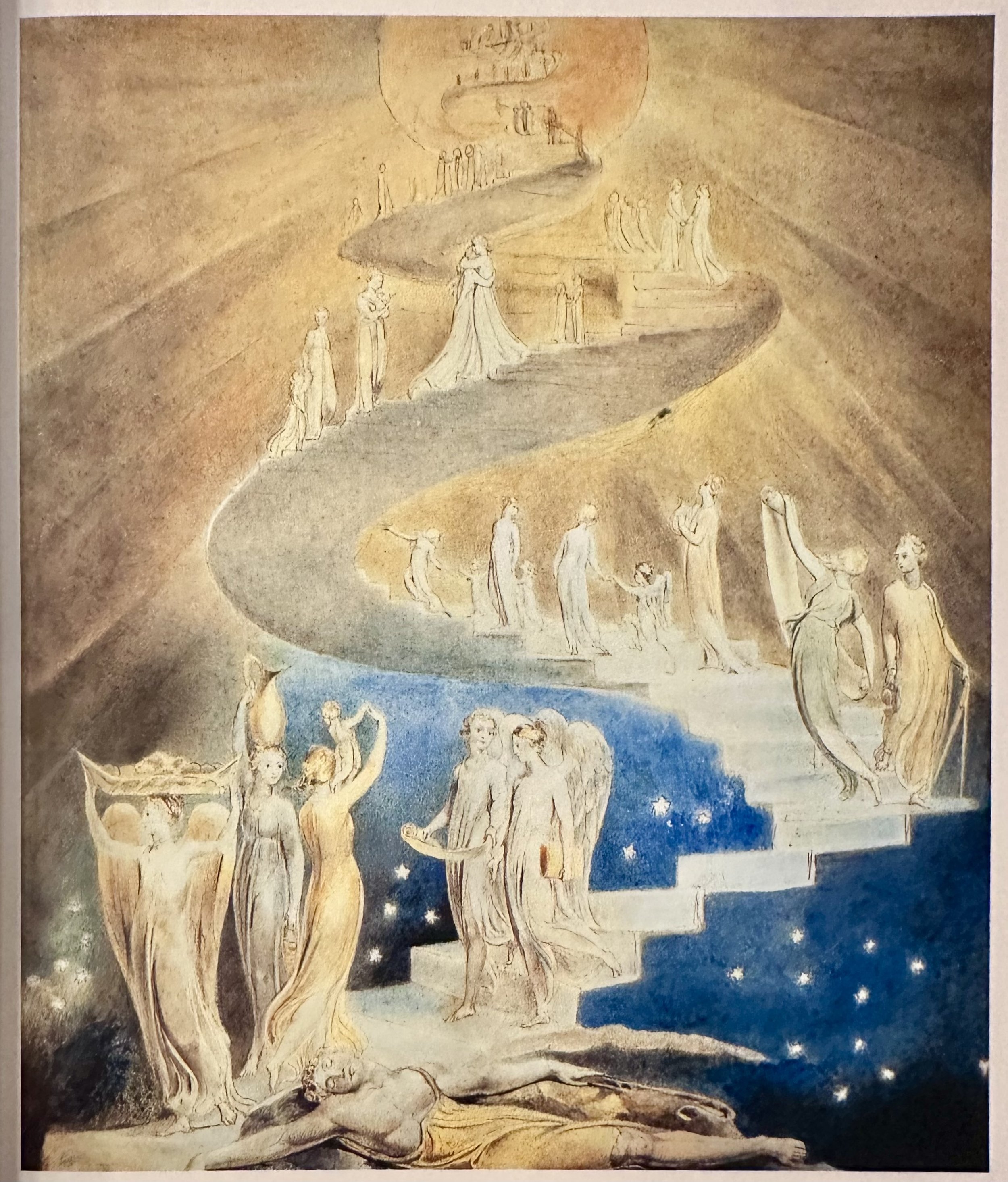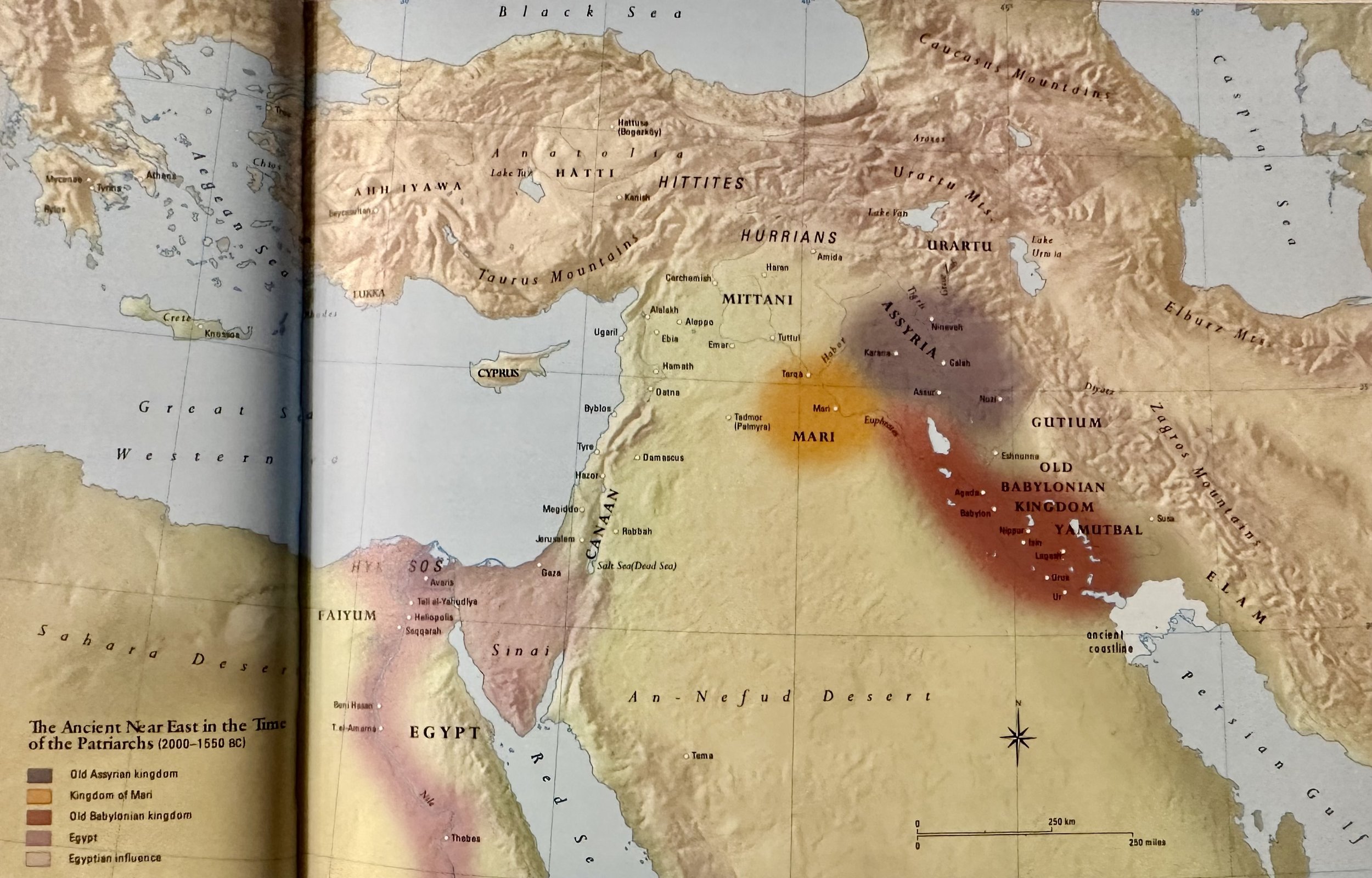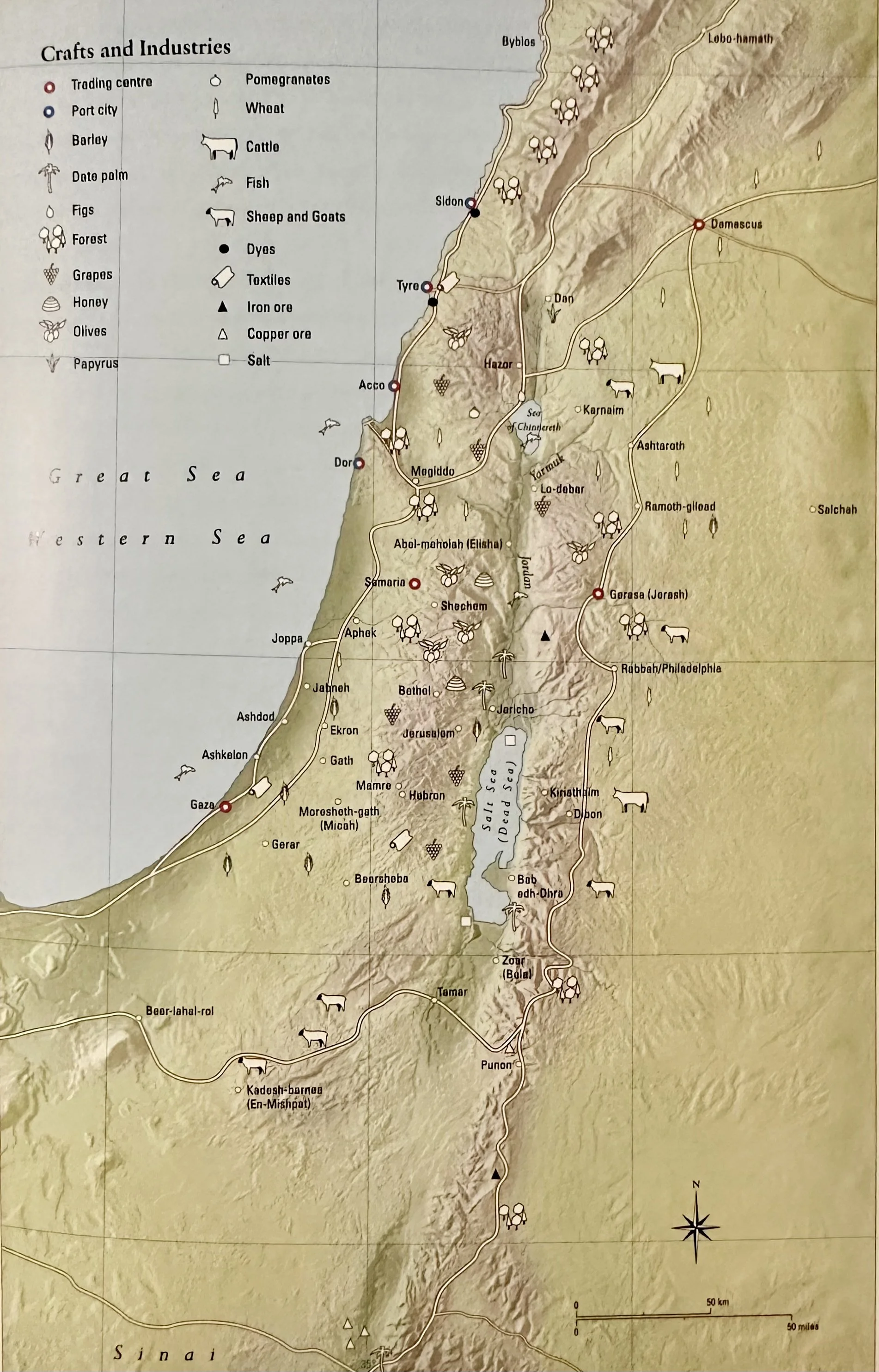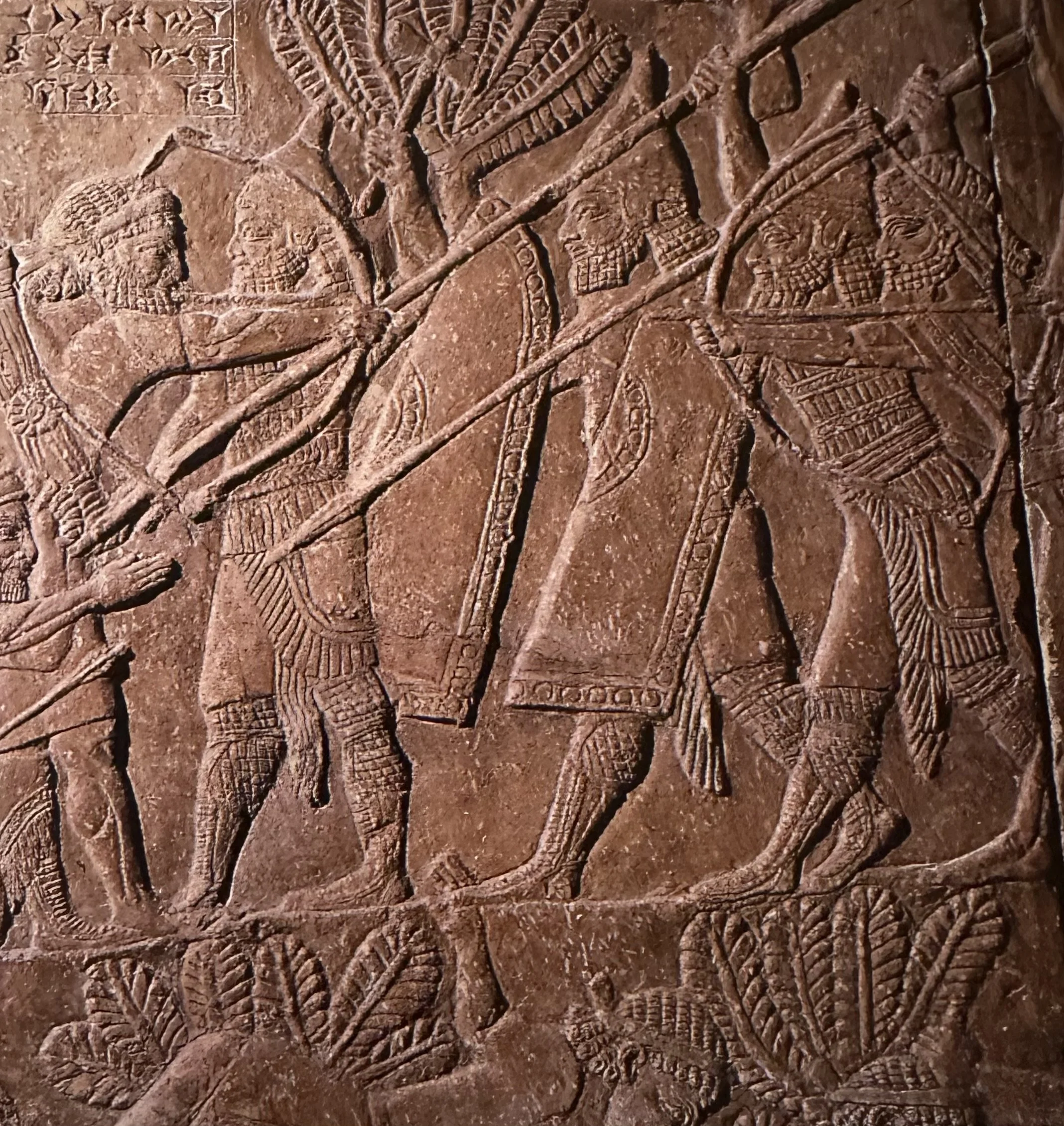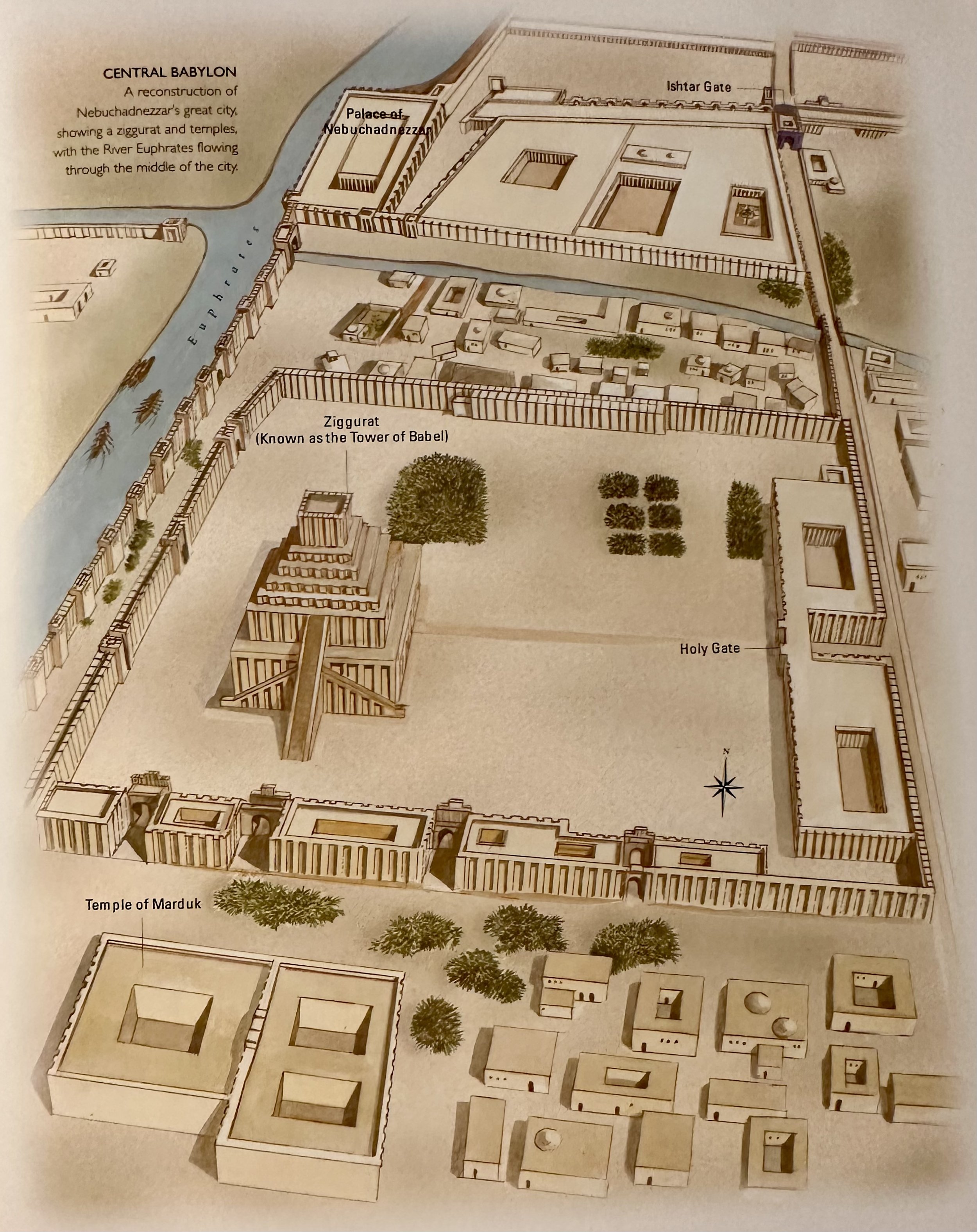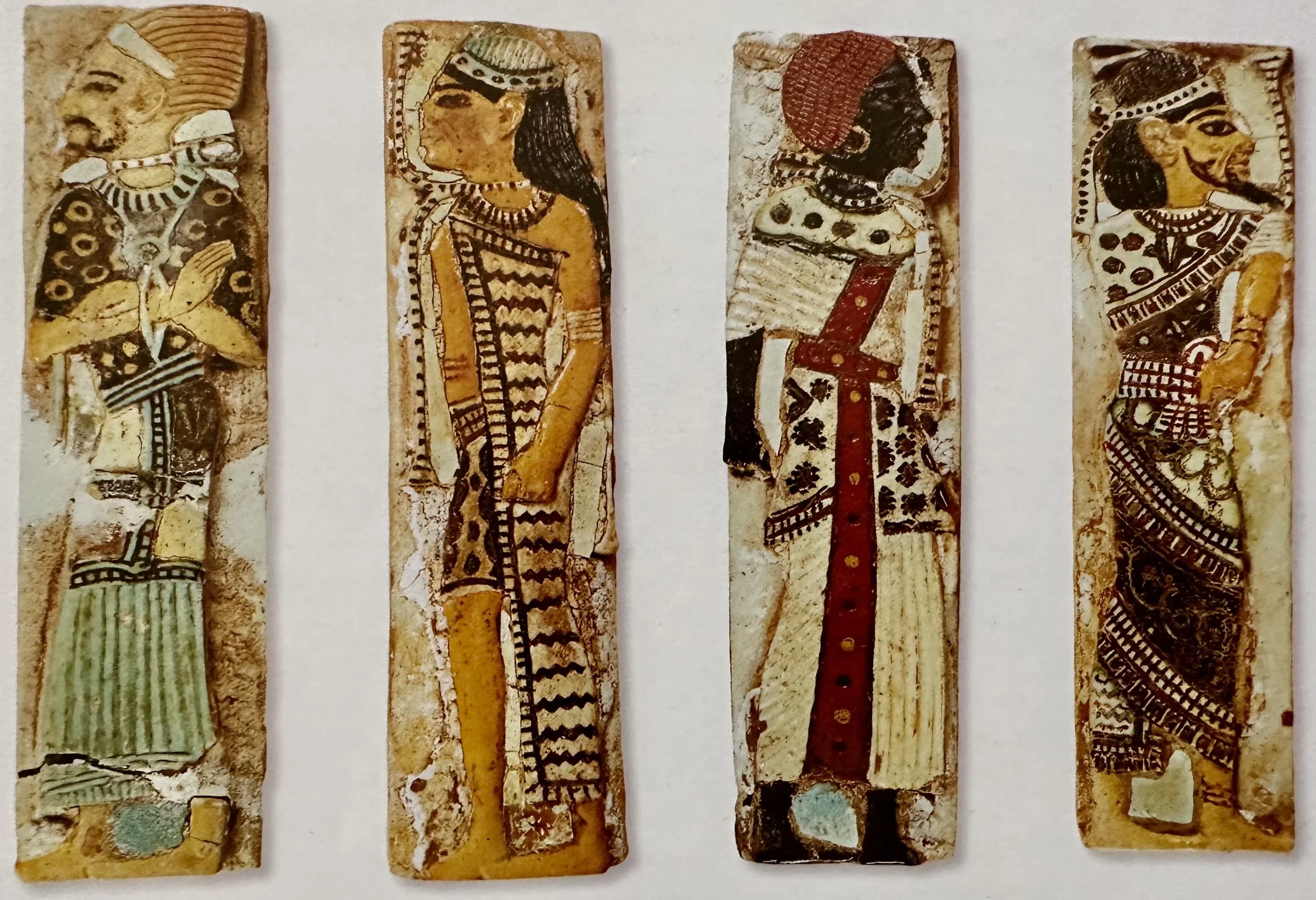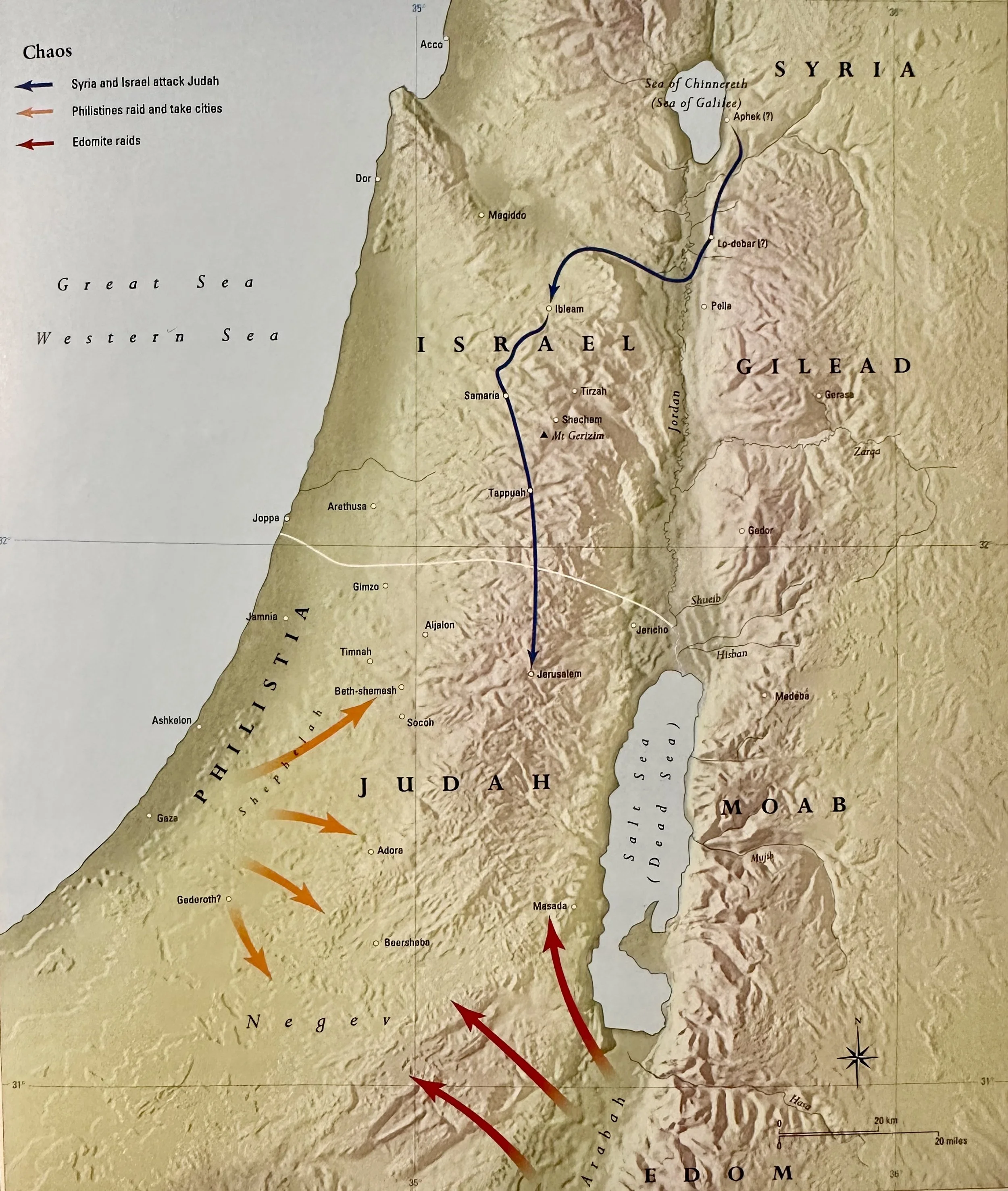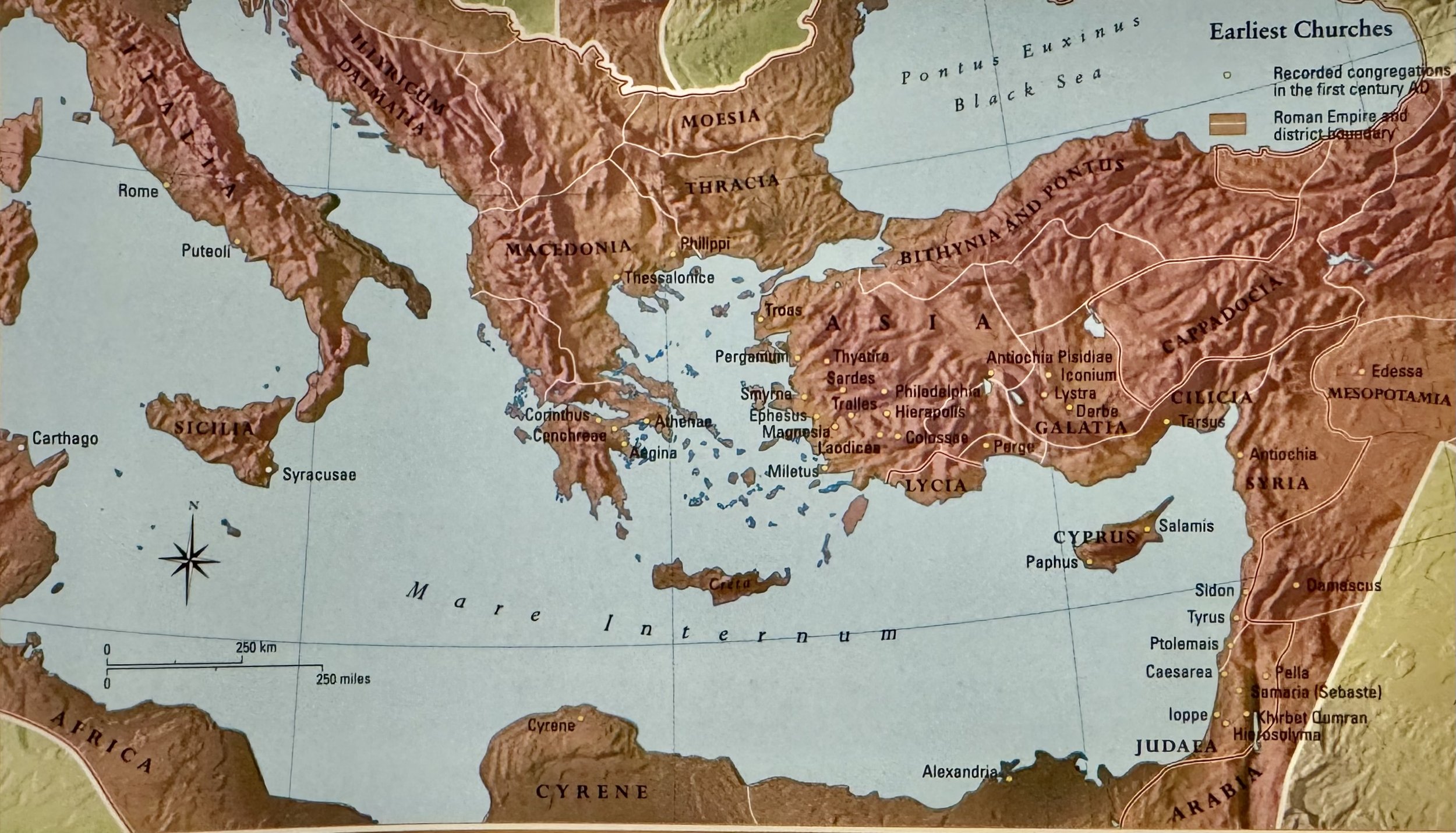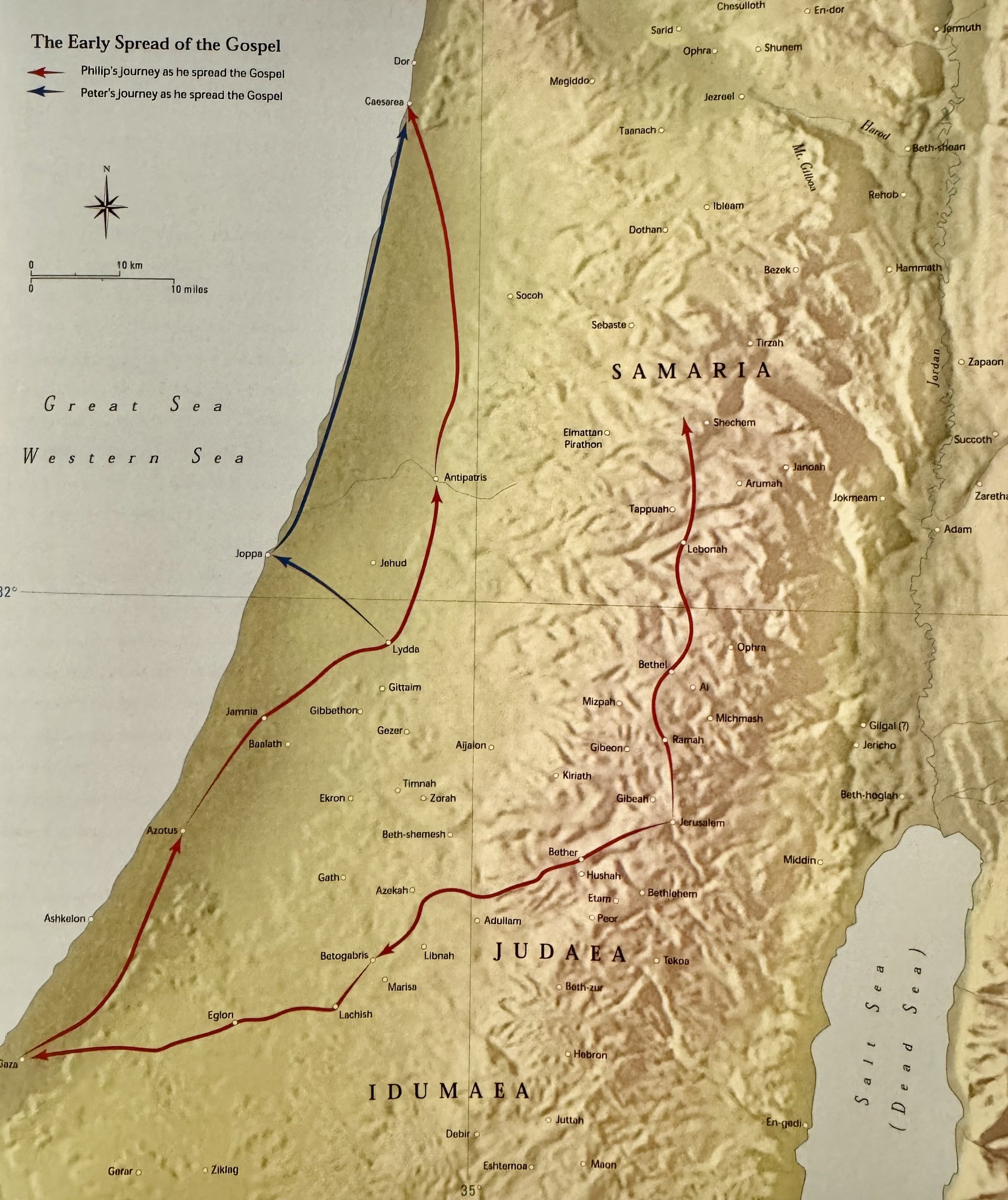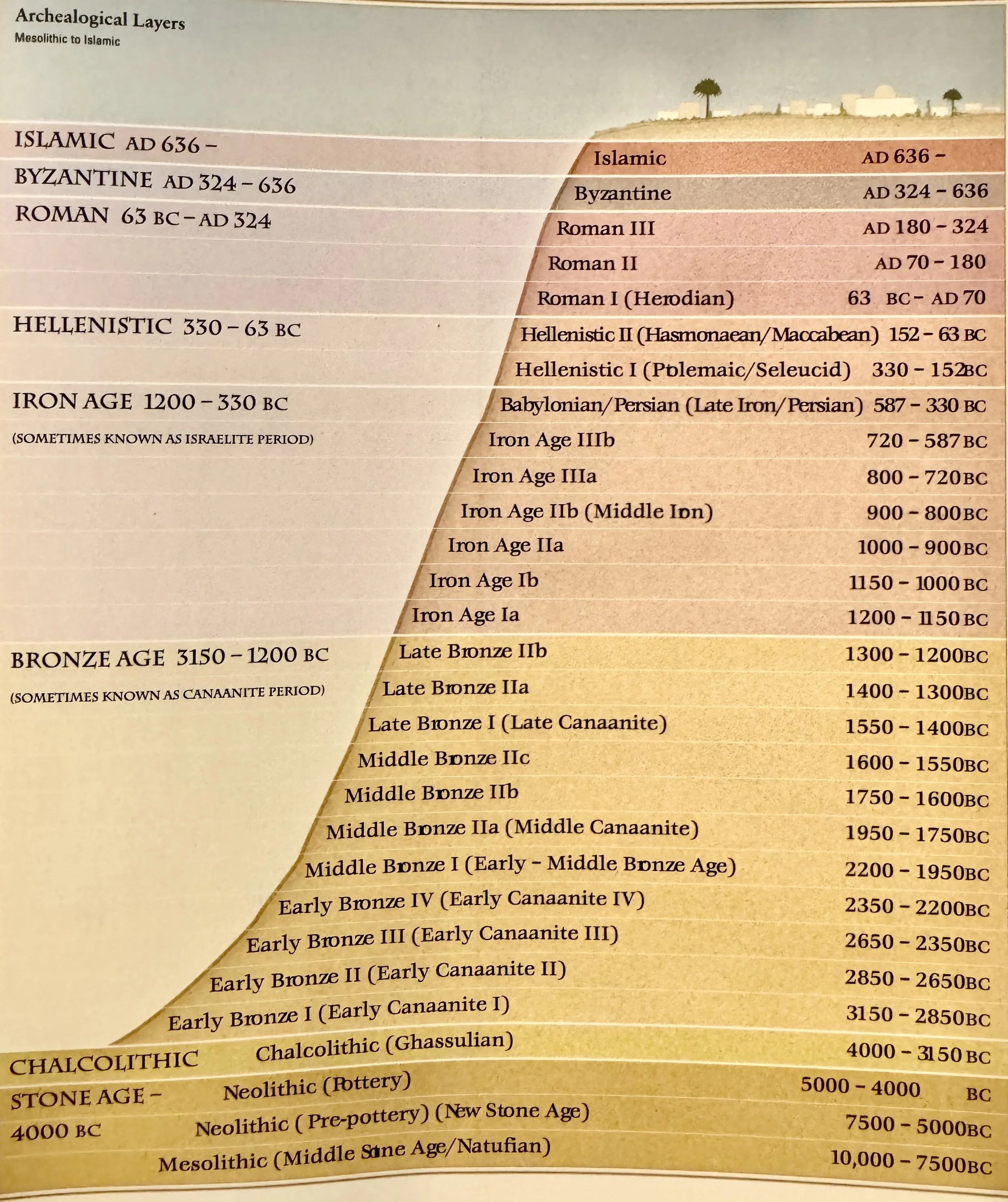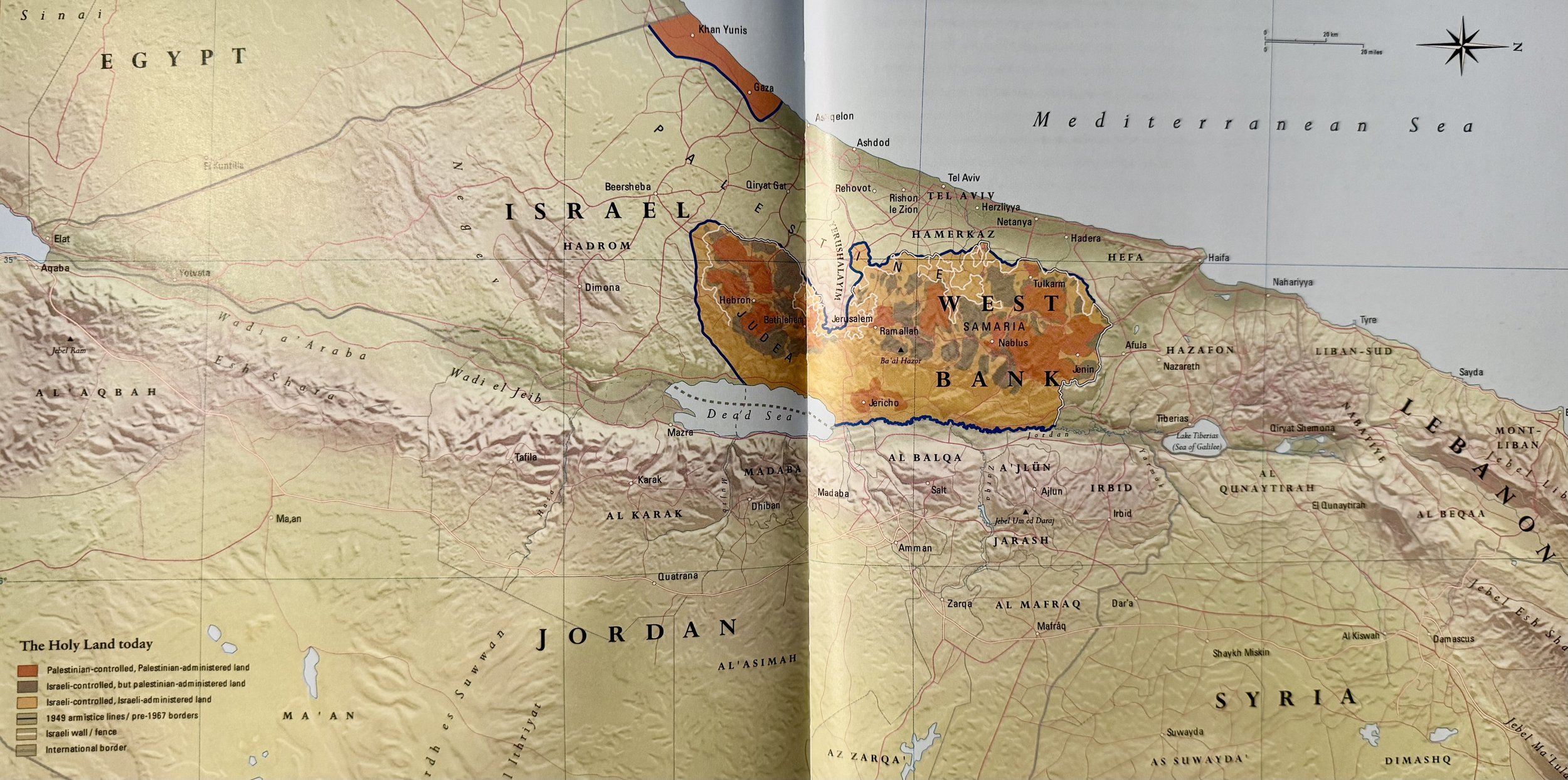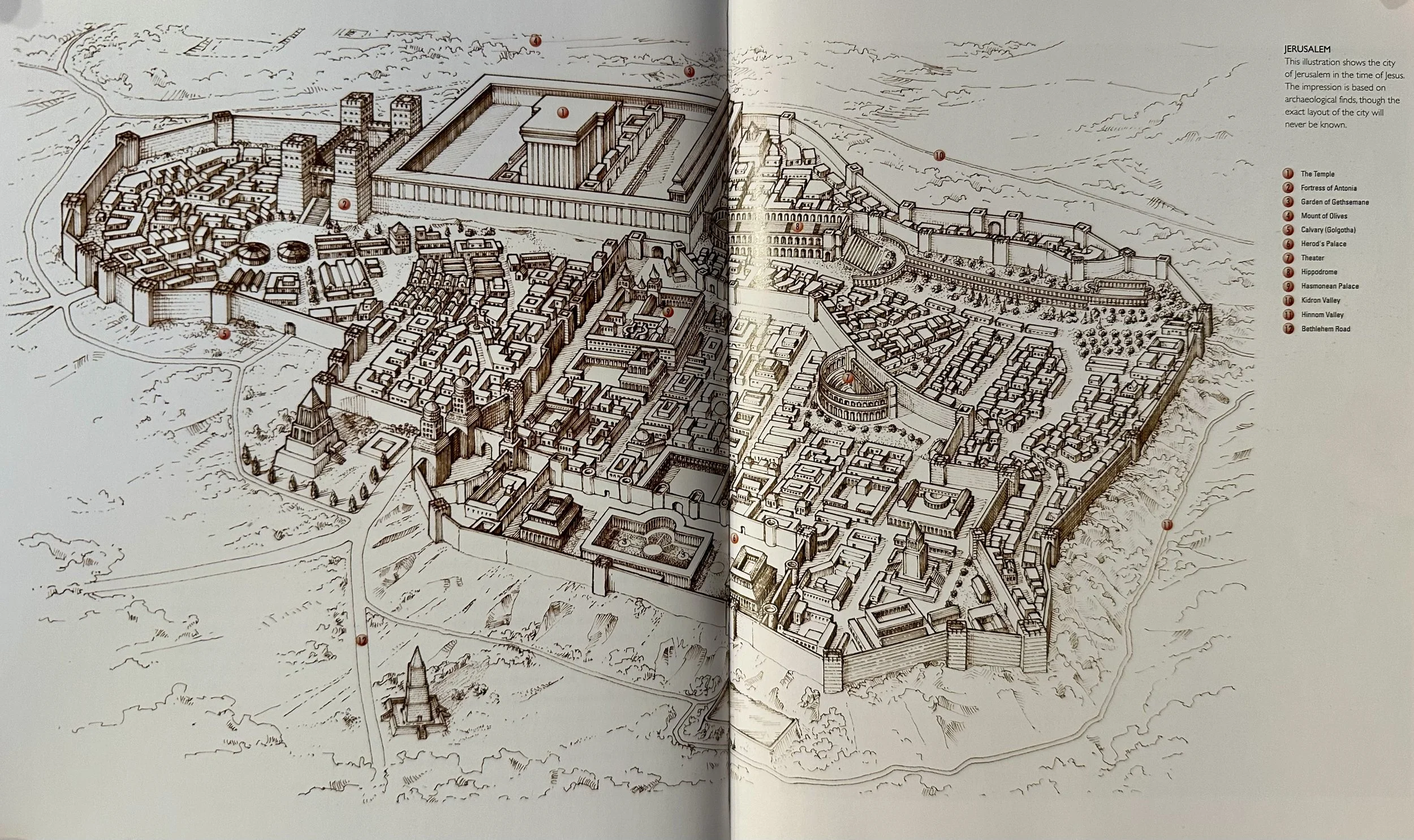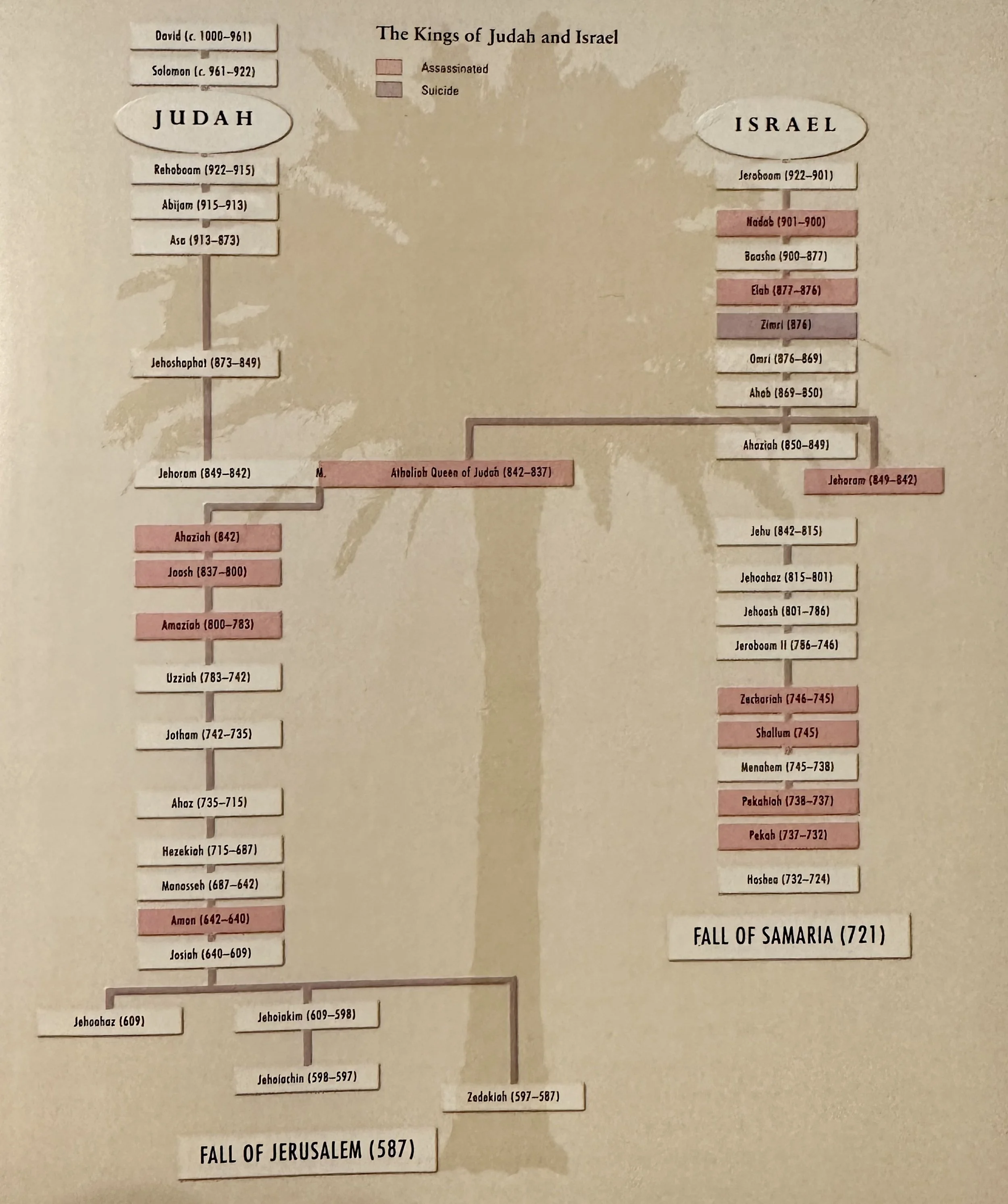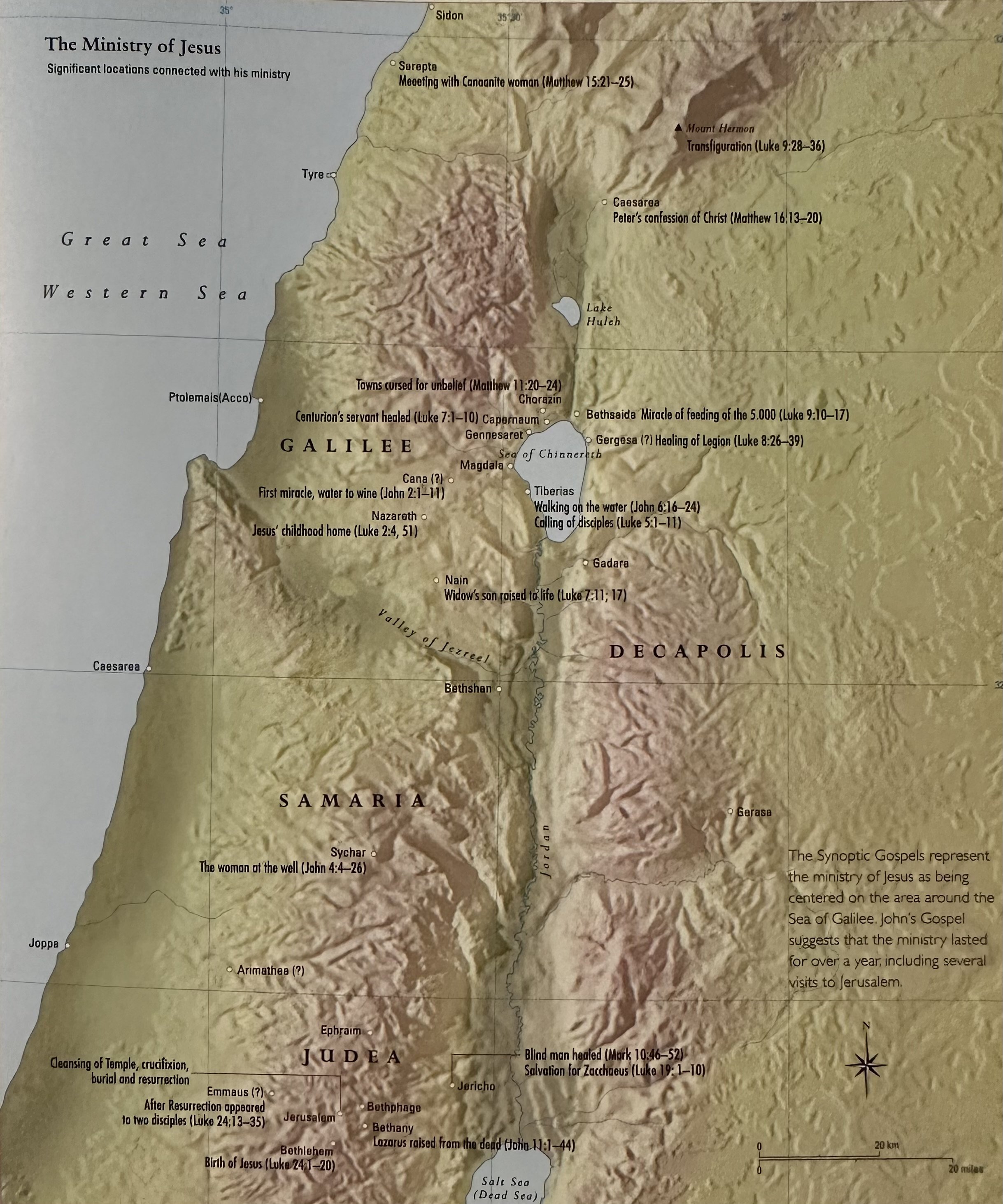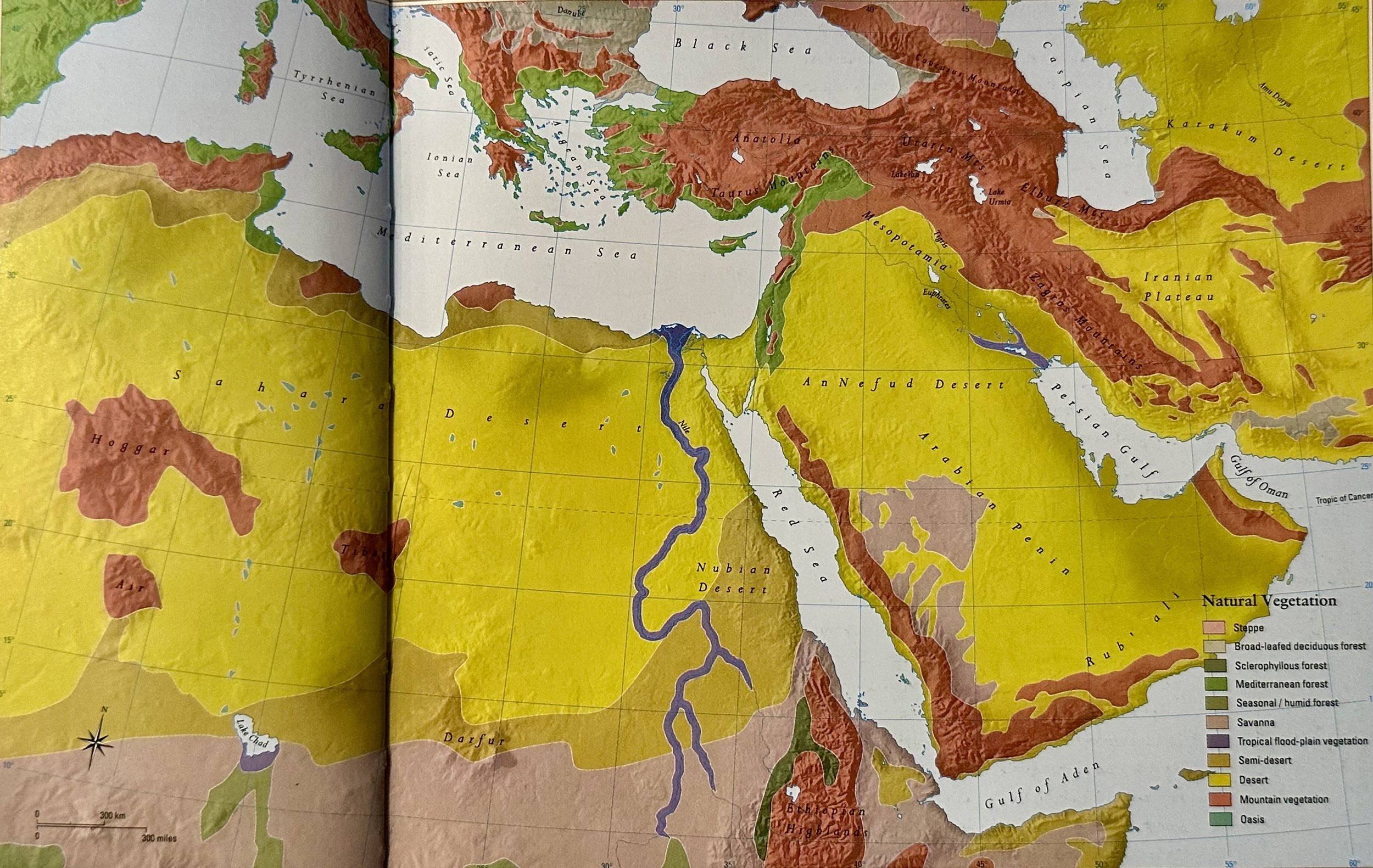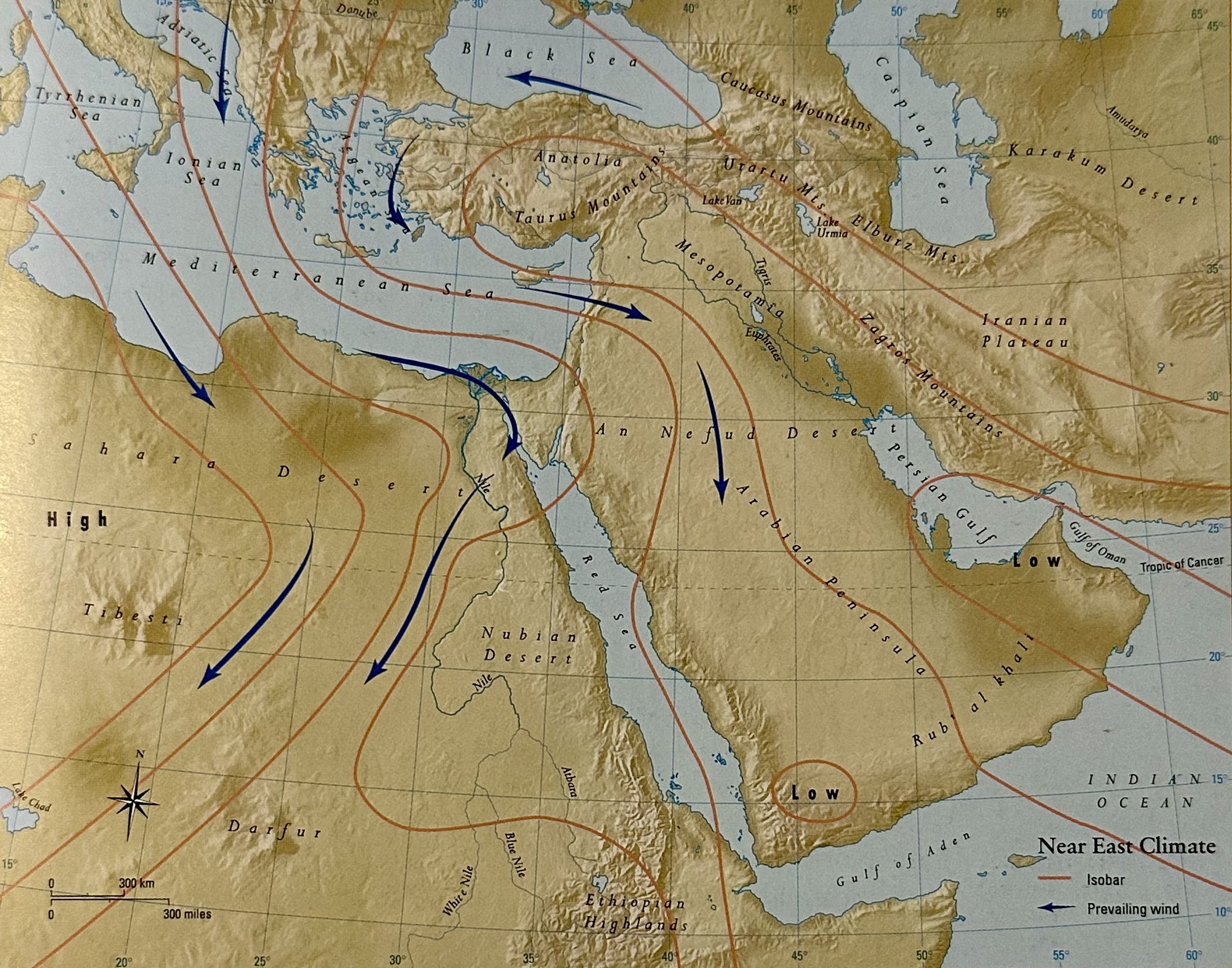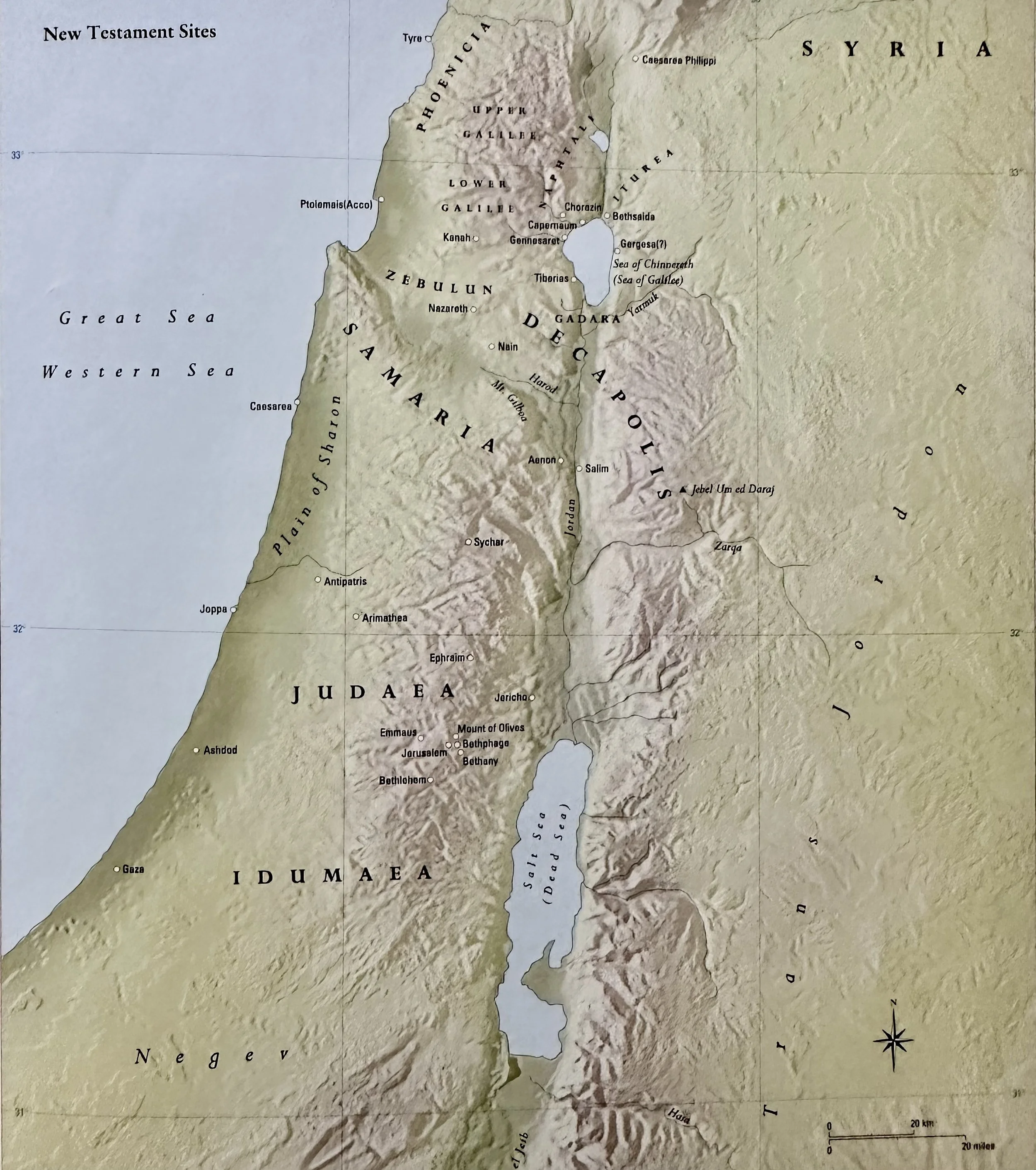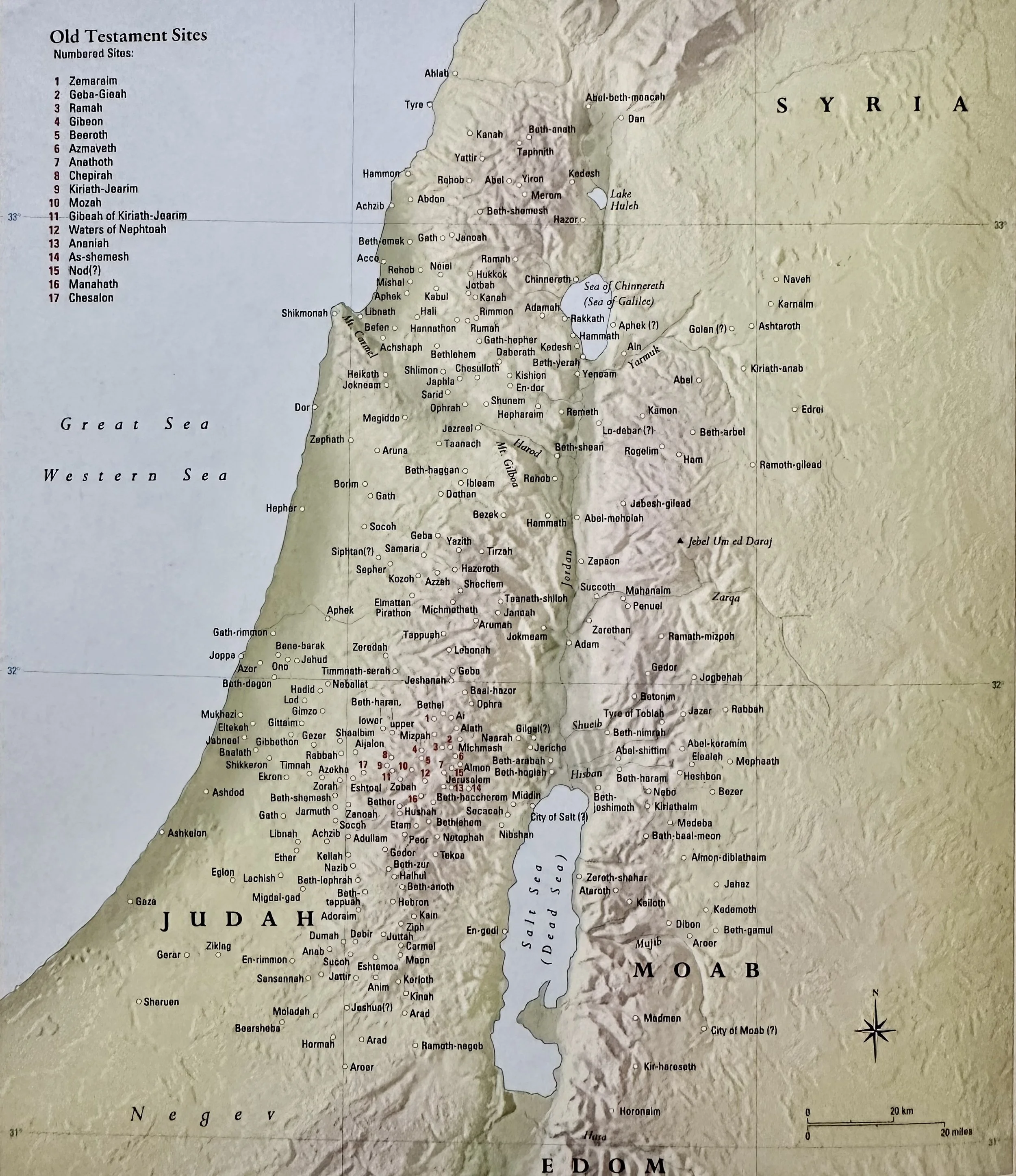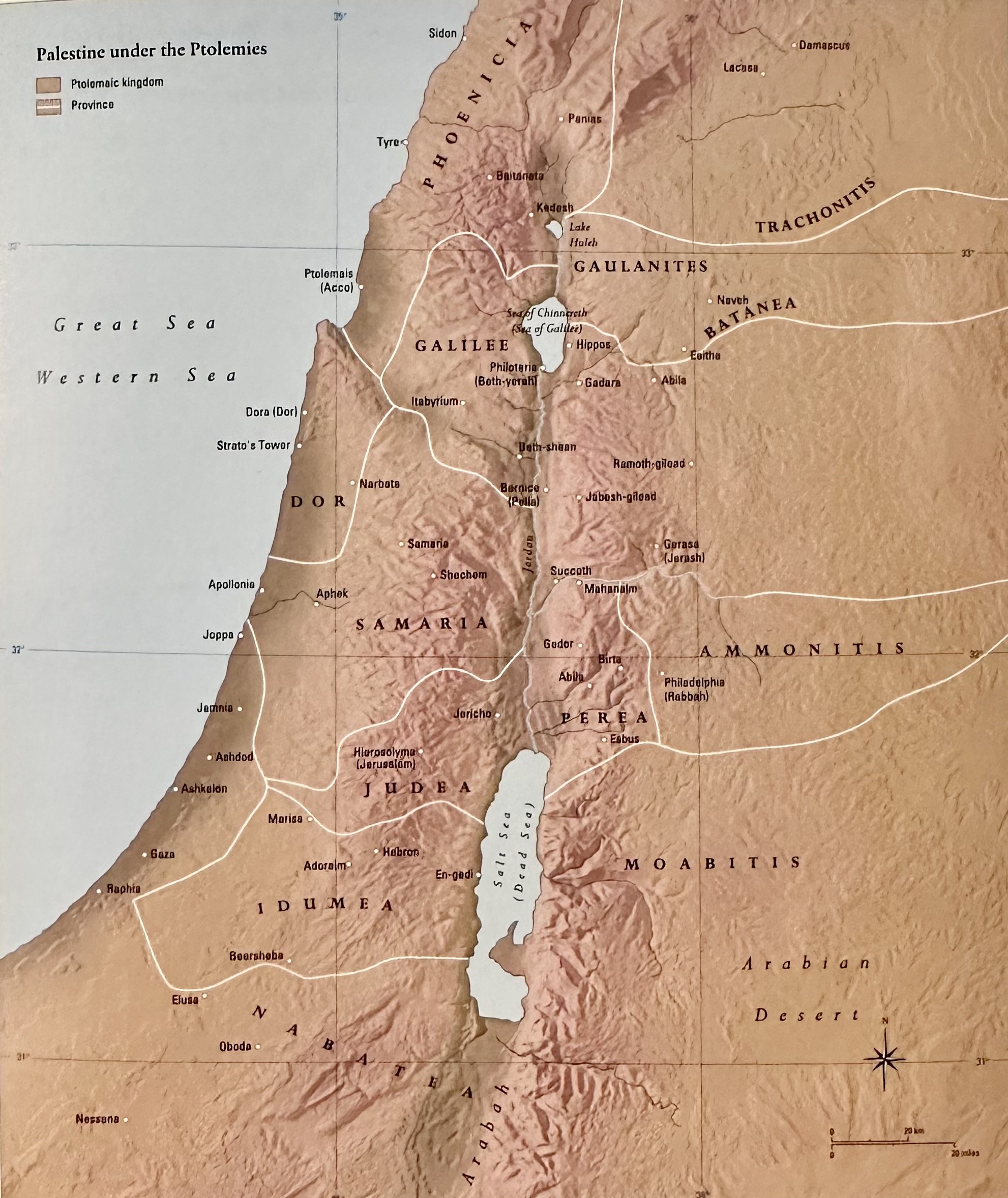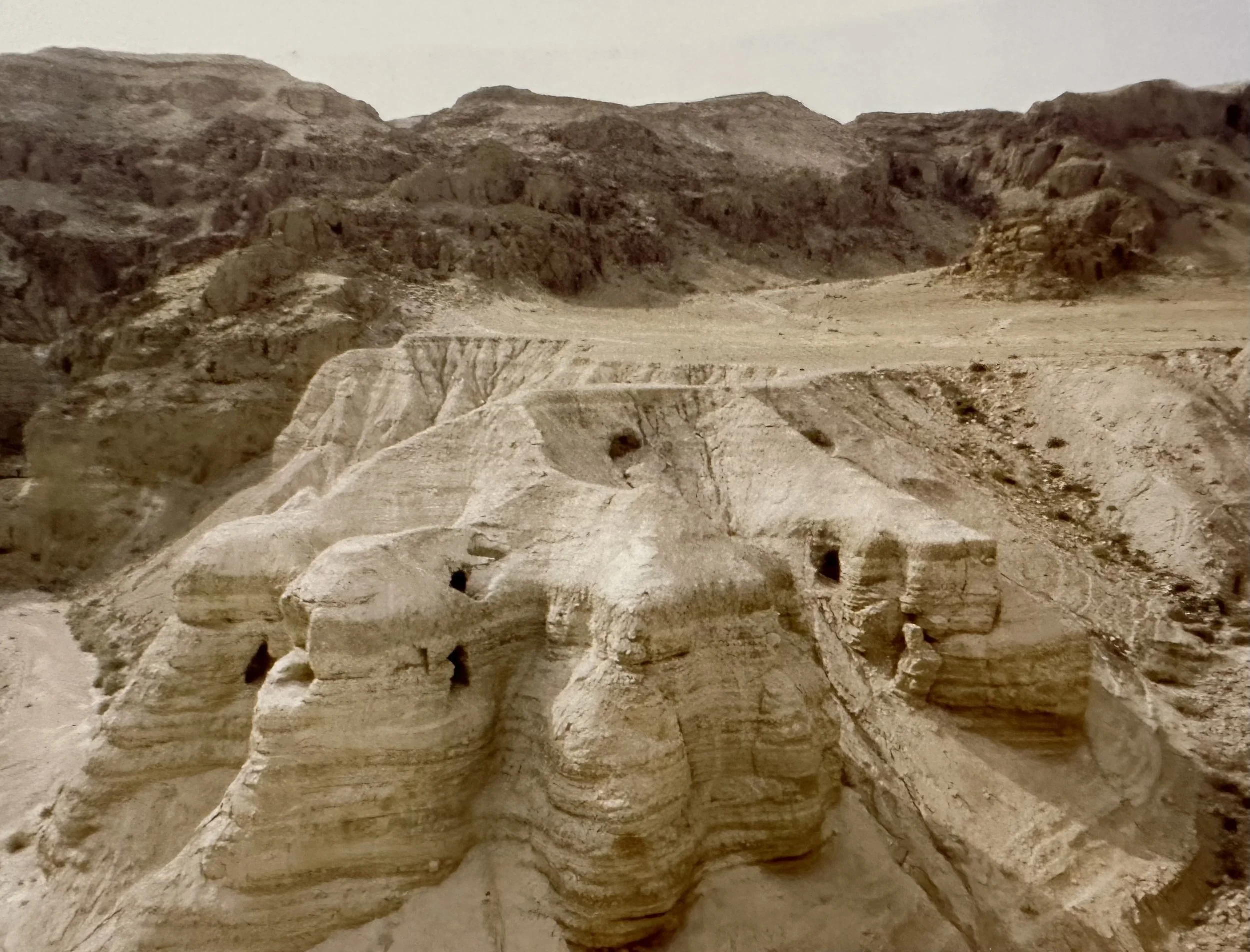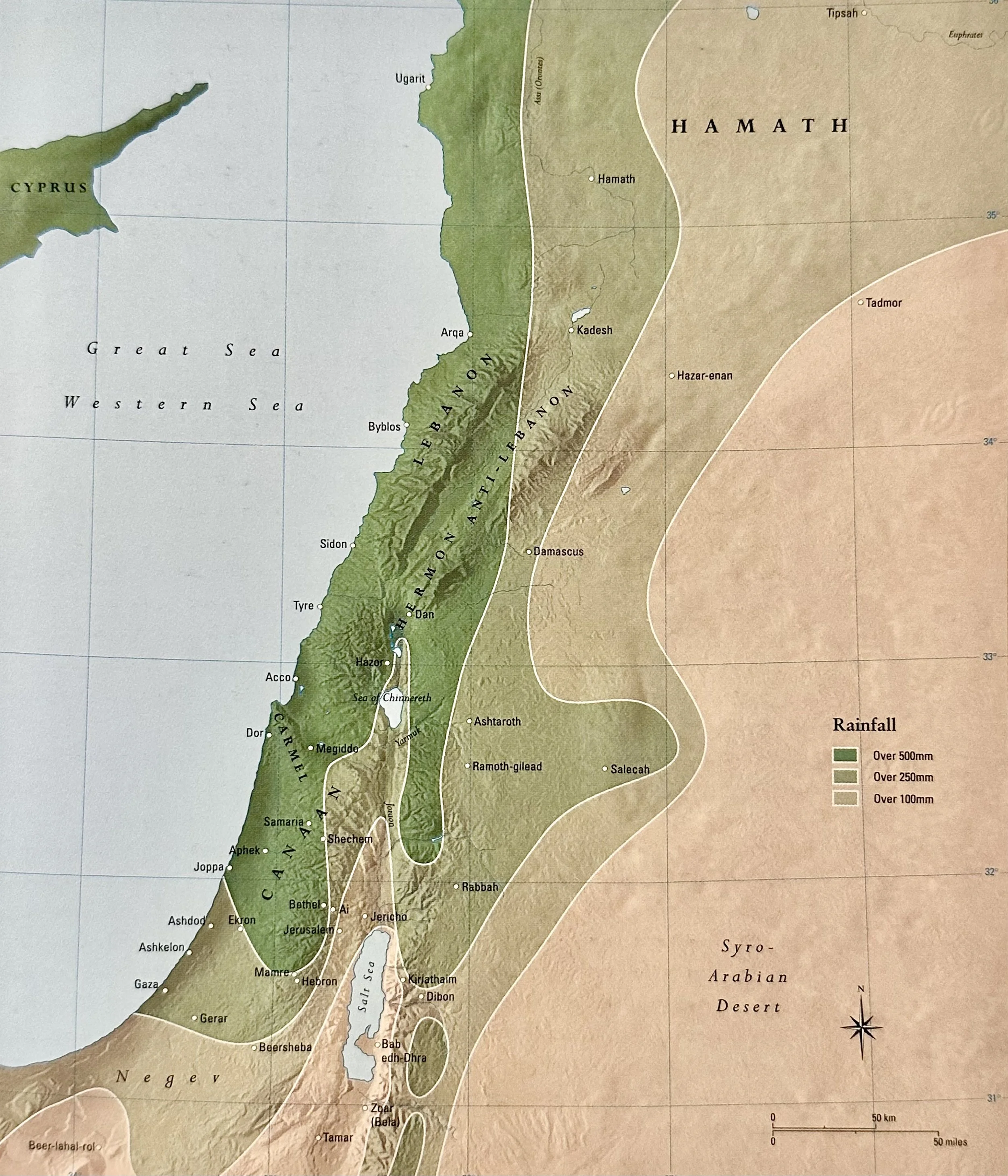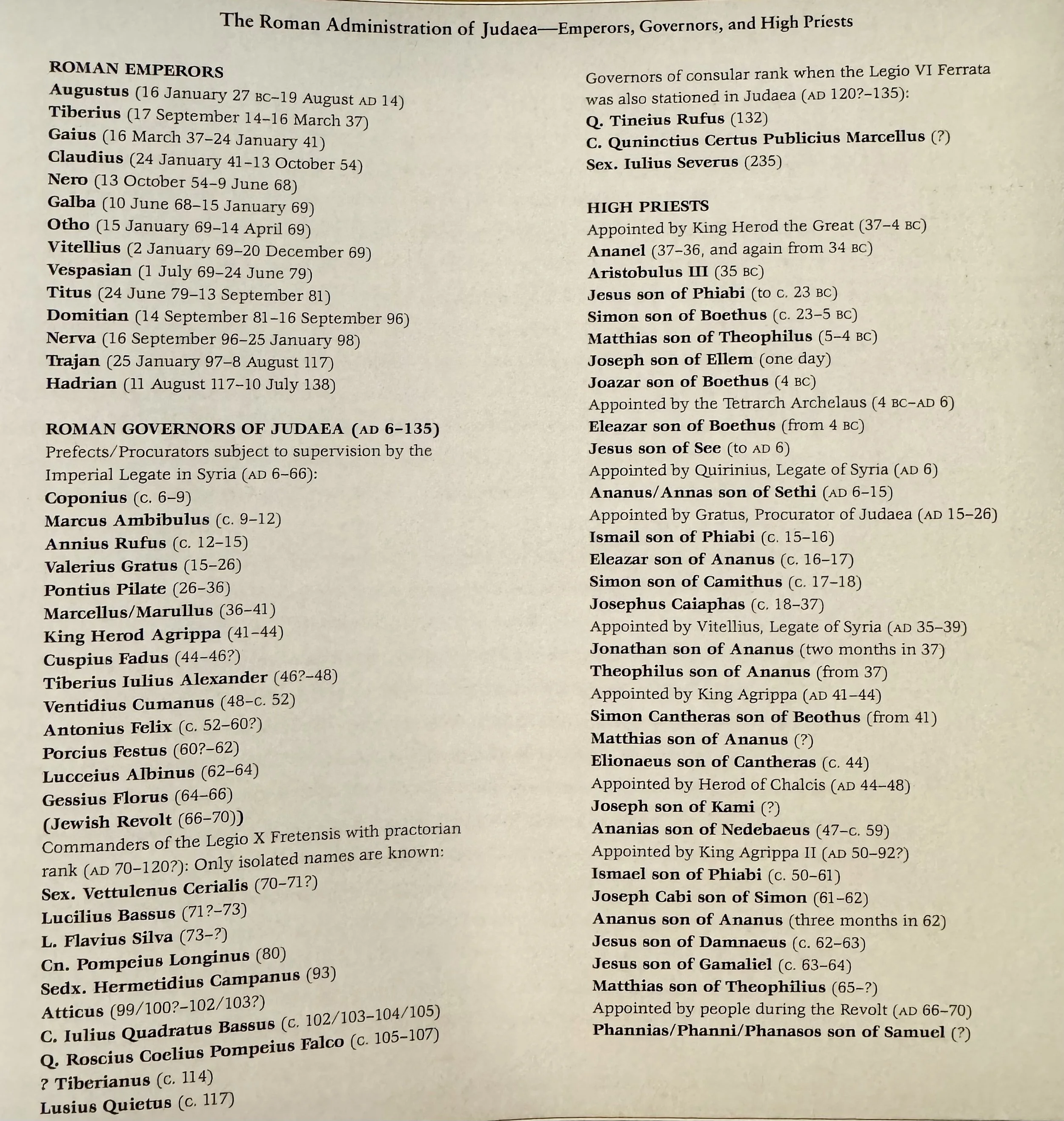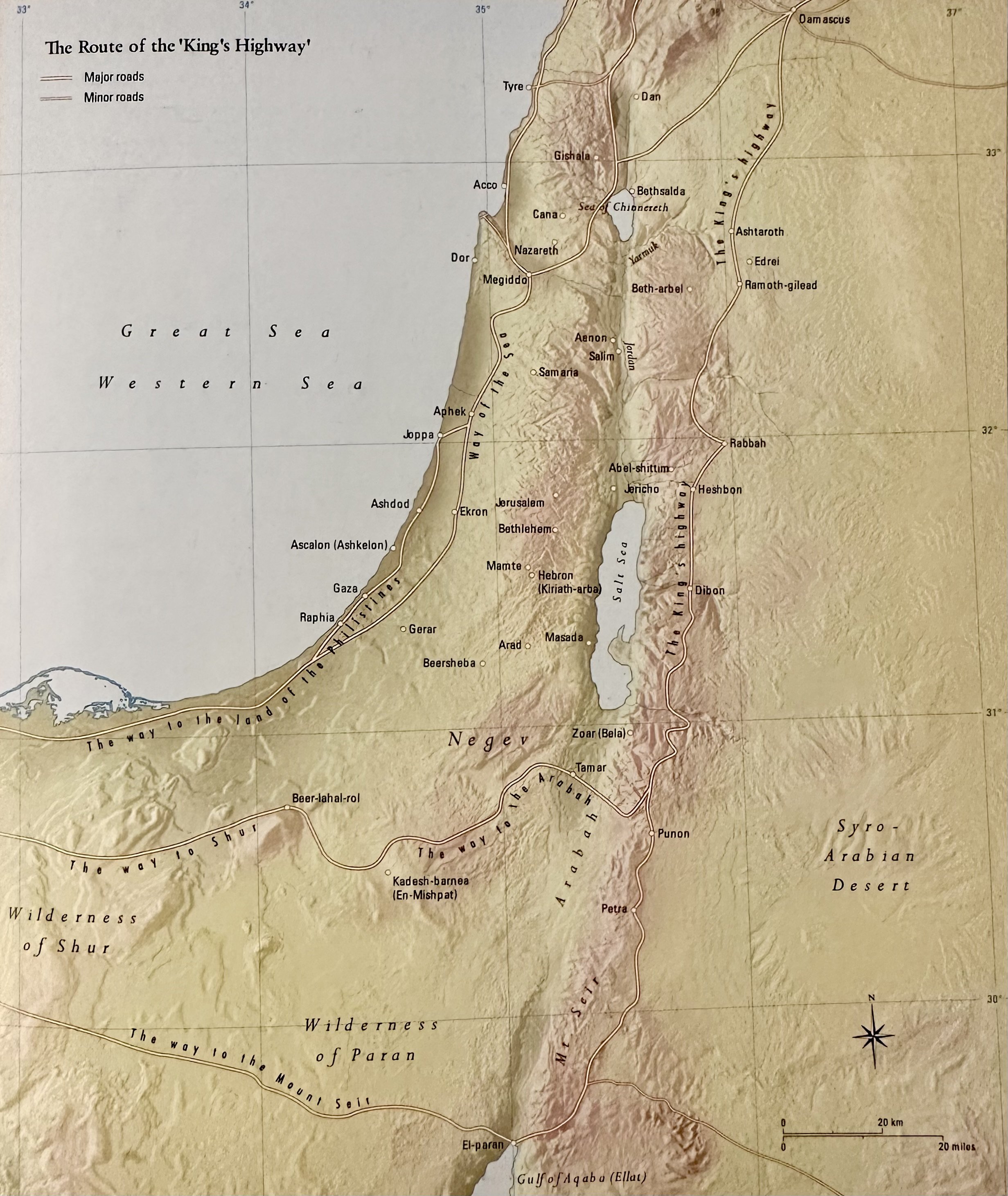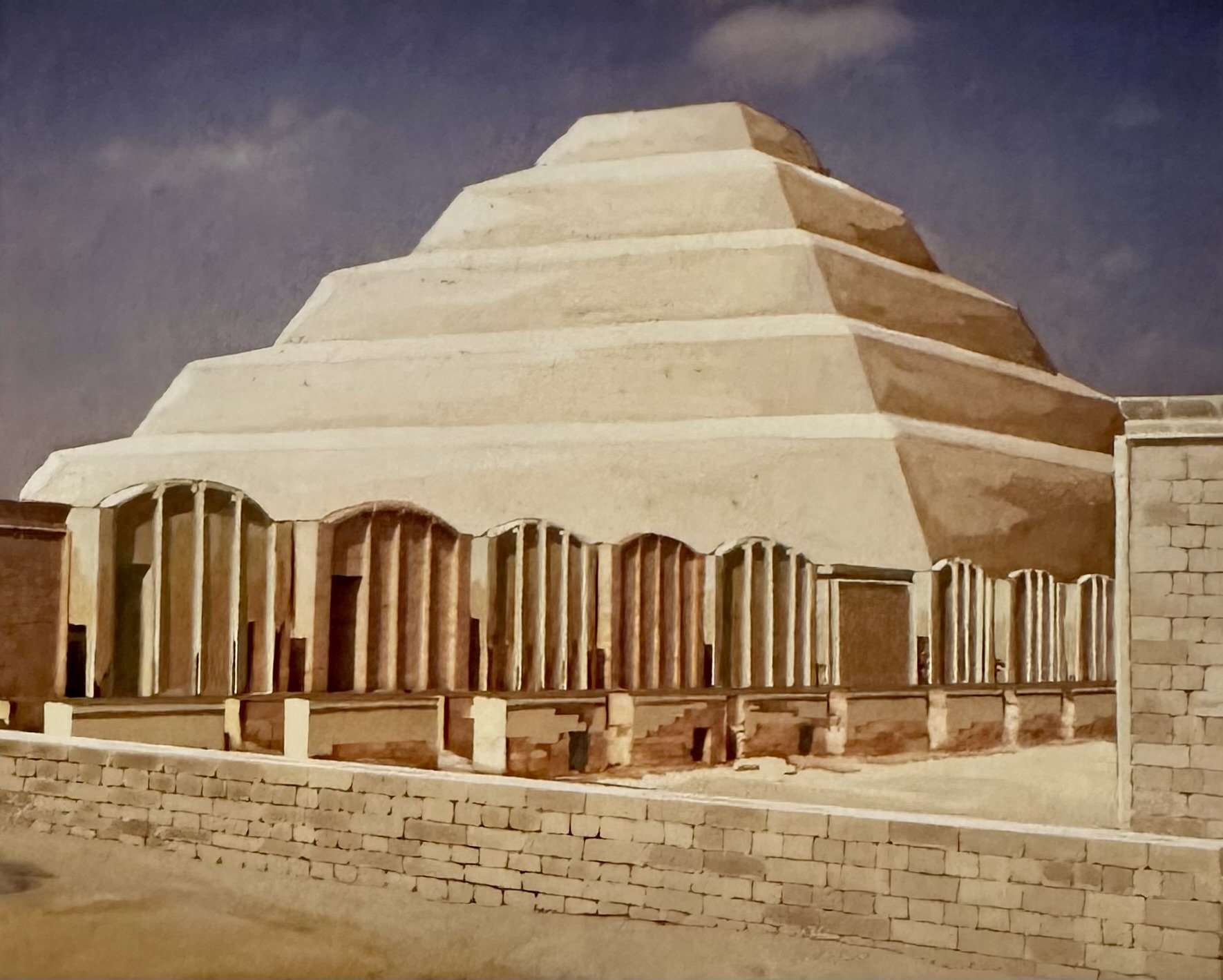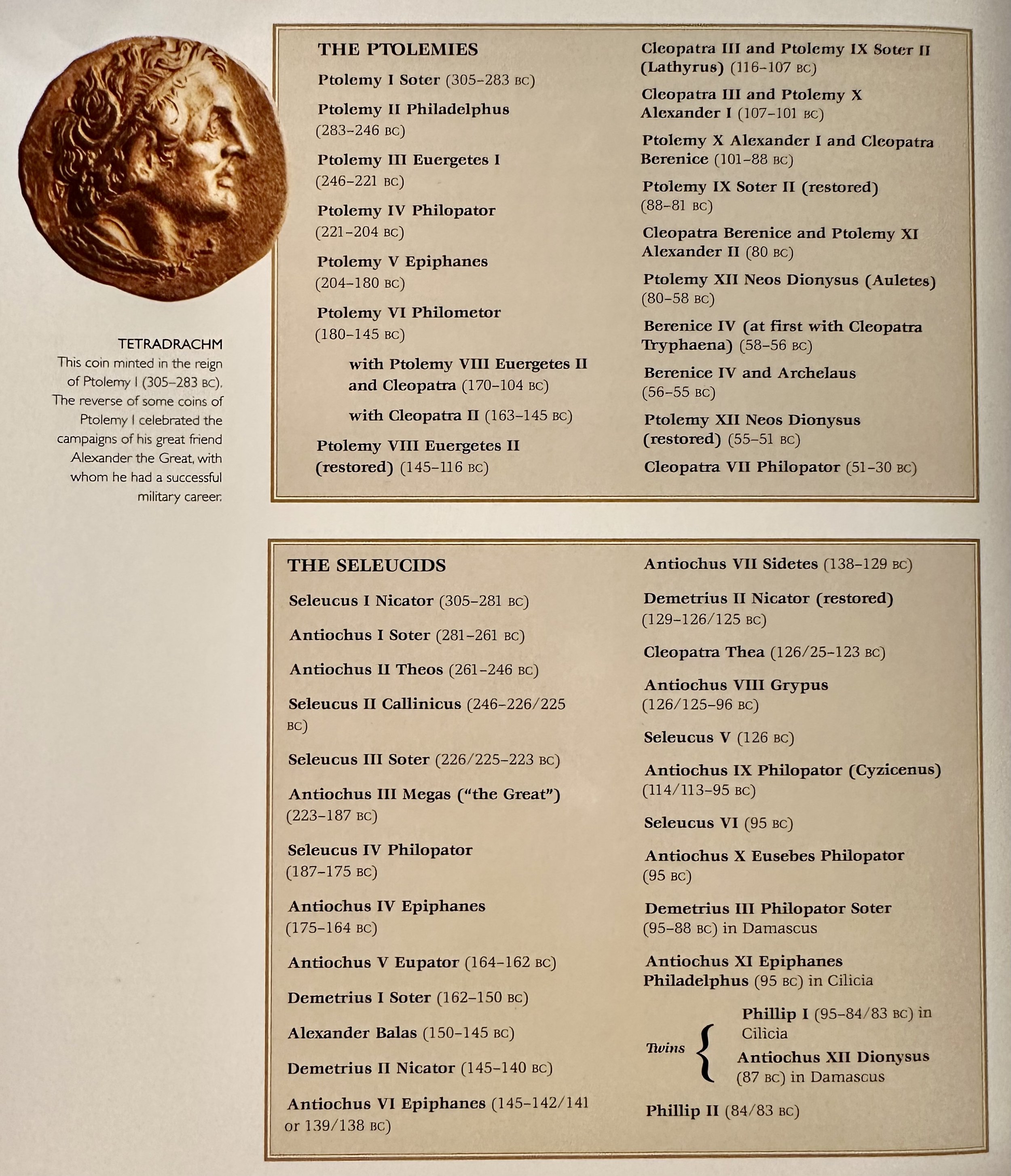The Historical Atlas of the Bible by Barnes
Ref: Ian Barnes (2010). The Historical Atlas of the Bible. Chartwell Books Inc.
___________________________________________________________________________
Summary
Bible: Comes through Latin from the Greek word- Biblia, meaning “Books,” which comes from Byblos, meaning papyrus, the material from which books were originally made.
The Bible was translated into English by John Wycliffe (c. 1382), William Tyndale (1525), and Miles Coverdale (1535).
It now seems that the patriarchal tales in the Old Testament were partially based on written documents of Canaanite provenance. Several of the Psalms were adopted from Ugaritic sources; the flood story nearly mirrors images Ugaritic literature.
Christianity commenced as a movement within Judaism. Jesus was a Jew, as were his Apostles. His adherents accepted him as the "Christ" sent to fulfil God's promise to Abraham, Isaac and Jacob.
By the 2c BCE, the Old Testament had been organized into the 24 books that make up the Hebrew Bible.
The earliest translation of the Hebrew scriptures was the Septuagint, a Greek translation of all the Old Testament canonical books and some of those that are regarded by many as apocryphal. The Jewish translators- traditionally, they are 72 scribes- started work on the Pentateuch (Genesis, Exodus, Leviticus, Numbers, and Deuteronomy) in Alexandria in the first half of the 3c BCE. The other canonical books appear to have been translated by the end of the 2c BCE. The Septuagint forms the basis for several subsequent translations. In 382, St. Jerome made a Latin translation, called the vulgate, which is still used by the Roman Catholic Church.
Everyday life for the great majority of people in the ancient world was almost totally concerned with survival. The essentials of life were food, which had to come from the crops and livestock and protection, which came from being part of a social unit that could defend its members. For the nomadic pastoral peoples, such as the Hebrews during the earlier part of their history, clan, or tribe, provided protection. For all others, security depended on being a member of a territorial group, as small as a fortified town or as large as a country. Their security was only as sure as their ability to defend that territory. To be conquered by invaders meant slavery or death. Every detail of life- housing, family structures, religion, and even the selection of children for survival- evolved as a result of these basic concerns.
___________________________________________________________________________
Major Events
~8000 BCE: Jericho is first inhabited.
~5000 BCE: The Jordan River Valley is first inhabited.
~5000 BCE: The city of Ur is first occupied.
~3500 BCE: The Sumerians establish several wealthy city states, such as Babylon, Kish, Isin, Shurrupak, and Uruk.
3000 BCE: The city of Canaan is established by Semitic settlers.
~2600-2350 BCE: The Umma-Lagash War(s) (‘Hundred Years War’) are fought over a fertile piece of land.
~2500 BCE: Jerusalem is first settled by a Semitic people.
~2300 BCE: The Akkadians are united by Sargon (c. 2330-2279 BCE).
~2230 BCE: The Gutians overthrow the Akkadian empire.
~2050 BCE: Uruk King Utu-hengal, leading the cities of Sumer defeats the Gutians.
~2000 BCE: Amorite King Sumuabum establishes the Babylonian Dynasty.
~2000 BCE: Introduction of the sword, probably under the Assyrians.
~2000 BCE: Abraham journeys from Ur into Canaan. With his wife Sarah, they give birth to Isaac.
~1900-? BCE: Life of the biblical Isaac, son of Abraham and Sarah, who God promises will lead a great nation. Isaac spends most of his life seeking water for his flocks and occasionally growing crops, as conditions permit. Isaac digs his own well, named Rehoboth, and has two sons with Rebekah, Jacob and Esau.
~1800-? BCE: Life of the biblical Jacob, son of Isaac and Rebekah, who gives birth to 12 children; with Leah- Reuben, Simeon Levi, Judah, Issachar, and Zebulon, with Rachel- Joseph and Benjamin, with Zilpah (Leah’s handmaid)- Gad and Asher, with Bilha (Rachel’s handmaid)- Dan and Naphtali.
~1720-1500 BCE: Life of the biblical Joseph, son of Jacob and Rachel, who is throne in a well by his brothers, sold into slavery, and interprets the dreams of the pharaoh.
1792-1750 BCE: Reign of Babylonian King Hammurabi, who creates a kingdom of Babylon.
1720-1500 BCE: Timeline of the biblical stories of Joseph.
~1680 BCE: The Hittites led by Labarna I conquer nearly all of Central Anatolia, establishing the Hatti Kingdom.
~1600 BCE: The Epic of Gilgamesh is written on a clay tablet as a story about a great flood.
~1595 BCE: Hittite forces defeat Aleppo and conquer Babylon.
~1550 BCE: The Hyksos rulers of Egypt are overthrown and expelled. The descendants of the Hebrew nomadic shepherds who had settled near the delta find themselves under increasing suspicion as aliens.
~1500 BCE: The Hurrians establish the Kingdom of Mitanni in N. Mesopotamia.
1531 BCE: Fall of the Old Babylonian Empire after the Hittite sack of Babylon (Wiki).
1531-1155 BCE: The Kassites control Babylonia following the fall of the Old Babylonian Empire (Wiki).
1457 BCE: The Battle of Megiddo; Egyptian forces defeat a large coalition of Canaanite vassal states
~1300 BCE: The Assyrians conquer the Hurrians Kingdom of Matanni.
1275 BCE: The Battle of Kadesh; Egyptian forces fight Hittite forces to stalemate.
~1250 BCE: The Exodos; Moses leads the jews out of Egypt “parting” the sea likely North of Lake Timsah. After this, the Hebrews turn South where they are helped by the Midianites (descendants of Abraham’s son Midian who had given Moses shelter and a wife when he had first fled Egypt). They “wander the Sinai for 40 years” and “discover the Arc of the Covenant.”
1224-1214 BCE: Sea peoples establish themselves in Gaza, Ashkelon, Ashdod, Gath, and Ekron and become known as the Philistines.
~1210 BCE: Moses and the Israelites arrive out of the Sinai into the Land of Canaan.
1200 BCE: The Hittite states collapses under attack from migrating Sea People’s, with Anatolia being overrun by Phrygians.
1183-1152 BCE: Egypt faces assaults by Sea People’s as well as Libyan tribes. Among the Sea peoples, Rameses lists the Pelasta (‘Philistines’), among others who he could not eject from his territories, being forced to allow the Philistines to settle, maybe as mercenaries to man garrisons, and give their name to Palestine.
1158 BCE: Babylon is sacked by the Elamites, but soon Elam is conquered by Nebuchadnezzar I, who established a new dynasty in Babylon.
1116-1078 BCE: Reign of Assyrian King Tiglath-pileser I, who defeats Babylon, Armenia, Anatolia, and N. Phoenicia.
1021-1000 BCE: Reign of Saul, the first King of Israel; chosen by the Judge Samuel and by public demand for a leader.
1000-961 BCE: Reign of David, 2nd Hebrew King. David unites rival Hebrew tribes, secures their loyalty by providing a neutral capital- Jerusalem- and subdues various enemies.
961-931 BCE: Reign of Solomon, 3rd King of Israel (second son of King David and Bathsheba). Solomon consolidates David’s administrative system, builds the temple in Jerusalem to house the Ark of the Covenant.
931 BCE: Death of Hebrew King Solomon and the 1st Jewish Diaspora; his empire collapses into the Northern kingdom of Israel ruled by Jeroboam and descendants of David with its capital at Samaria and the Southern Kingdom of Judea ruled by Solomon’s son Rehoboam and a series of dynasties with its capital in Jerusalem.
922 BCE: Egyptian forces attack Jerusalem.
858 BCE: Battle of Lutibul; Assyrian forces defeat a coalition of Aramaean Kings.
854 BCE: Battle of Qarqar (‘Karkar’); Neo-Assyrian forces defeat the Syrian led allied army of eleven kings.
~842 BCE: Aramaean forces led by King Hazael defeat Israeli forces led by King Jehoram and Judean forces led by King Ahaziah at Ramoth-Gilead. Israel loses all of Transjordan south to the lands of Moab on the River Arnon.
842 BCE: Fall of the House of Omri and the weakening of Israel and Judah.
800 BCE: The Greeks assimilate the Phoenician alphabet.
743-734 BCE: Assyrian forces led by Tiglath-pileser III defeat the Urartian coalition.
733-732 BCE: Assyrians forces target Israel, appropriating the entire northern part of the territory.
732 BCE: Assyrian forces capture Syria, dividing it into the Assyrian provinces of Damascus, Karnaim, and Hauran Ammon.
727-722 BCE: Collapse of the Northern Kingdom of Israel to Assyria.
701 BCE: Assyrian forces capture Judea, executing or deporting the populations of 46 cities.
626 BCE: The Chaldean dynasty is founded by Aramean-Chaldean Chief Nabopolassar in Babylon.
612 BCE: Babylonian and Median forces led by Babylonian King Nabopolassar attack and destroy the Assyrian capital Nineveh.
605 BCE: The Battle of Carchemish; Babylonian forces allied with the Medes, Persians, and Scythians attack and defeat Egyptian forces.
598 BCE: Babylonian forces led by King Nebuchadnezzar II (630-562 BCE) attack Judah and lay siege to Jerusalem, leaving the city and the Temple in ruins. He deports a portion of the Jewish population.
587 BCE: Fall of Jerusalem and the Kingdom of Judah; Babylonian forces capture Jerusalem after a long siege.
562 BCE: Persia, a vassal state of the Median Empire to the east of Babylon, rebels under the leadership of Cyrus, capturing Ecbatana the capital, and acquiring the Median Empire.
546 BCE: Persian forces led by Cyrus crosses the Halys, surprises Croesus, and storm the Lydian capital at Sardis.
539 BCE: The Battle of Opis; Persian forces decisively defeat Babylonian forces.
538 BCE: Jewish exiles in Persia received an edict allowing them to return to Judah.
490 BCE: The Battle of Marathon; Greek forces defeat Persian forces.
482 BCE: Babylon is destroyed by Persian King Xerxes I.
334 BCE: Battle of the River Granicus; Macedonian forces defeat Persian forces.
333 BCE: Battle of Issus; Macedonian forces defeat Persian forces.
332 BCE: Alexander the Great captures Egypt.
331 BCE: Babylon is conquered by Alexander the Great.
331 BCE: Battle of Gaugamela; Macedonian forces attack Babylon, defeating Persian forces.
327-325 BCE: Macedonian forces cross the Indus and fight their last great battle on the Hydaspes (~325 BCE) against the Kingdom of Porus (in the Punjab). When his troops mutiny and refuse to go any further, Alexander follows the Indus to the Arabian Sea and arrives back in Babylon in 323 BCE.
323 BCE: Death of Alexander the Great in Babylon. His empire disintegrates into a 40-year period of war and chaos with the Hellenistic world. The major parts of his empire are eventually divided among his main generals- Antigonus rules the Kingdom of Pergamon in Asia Minor, Syria, and Palestine. Seleucus rules the Seleucid Empire in Mesopotamia, Persia, and the Eastern parts to the border of India. Ptolemy rules the Ptolemaic Kingdom over Egypt and Libya.
301 BCE: The Battle of Ipsus; Seleucus gain Asia Minor and Syria.
264-241 BCE: The 2nd Punic War; Roman forces defeat an allied Carthaginian-Macedonian force.
200 BCE: The Battle of Paneoin (‘Panium’); Seleucid forces defeat Ptolemaic forces.
197 BCE: Battle of Cynoscephalae; Roman forces defeat Macedonian forces.
191 BCE: Battle of Myonnesus; Roman forces crush the Seleucid navy at Myonnesus.
190 BCE: Battle of Magnesia; Roman forces defeat the Seleucids at Magnesia.
168 BCE: Battle of Pydna; Macedonian forces led by Perseus (son of Phillip) are defeated at Pydna by Roman forces.
167 BCE: Seleucid King Antiochus IV robs the Jewish temple of its treasures, plunders and burns parts of Jerusalem and establishes a citadel, the Accra, on a hill overlooking the temple. Antiochus next sought to enforce the state of Hellenism. The Temple at Jerusalem was consecrated to Olympian Zeus.
167-164 BCE: The Jewish/Maccabeus revolt against the Seleucids and the Syrians.
166-160 BCE: Death of Mattathias (166 BCE), the Hebrew priest who had ignited the Jewish revolt.
164 BCE: Judas finds priests to rededicate the temple. The anniversary of Temple cleansing is known as the Feast of Hanukkah, when celebratory candles are lit.
2c BCE: The 24 books that make up the Hebrew Bible are first organized.
146 BCE: Greece is annexed as a Roman province after Roman forces capture Macedonia.
130 BCE: Death of the last King of Pergamon, who bequeaths his kingdom to Rome. Rome acquires its province of Asia, its first territory beyond the Aegean.
88-85 BCE: The First Mithridatic War; encouraged by Rome, Nicomedes raids Pontus. In response, Mithridates, who occupies Roman Asia, marches on Greece, defeating the Roman generals Fimbria and Sulla.
83-82 BCE: The Second Mithridatic War; Roman forces invade Pontus but are repulsed by Mithridates.
73 BCE: The Third Mithridatic War; Roman forces led by General Lucius Licinius Lucullus seize Bithynia, defeating Mithridates.
70 BCE: Gnaeus Pompeius Magnus (‘Pompey’) is appointed a Roman consul and given extraordinary powers to take over the command against Mithridates and to make peace and war and to organize the entire Roman east.
67-63 BCE: The Hasmonean Civil War is fought between two claimants to the Jewish crown, but expands to include first, the Nabatean Kingdom, and then Rome. The conflict results in the loss of Jewish independence.
64-63 BCE: Roman forces led by Pompey destroys the Kingdom of Pontus, killing Antiochus XIII Asiaticus, the last of the Seleucid Kings, and leading to the suicide of King Mithridates VI (63 BCE). Pompey annexes Syria and captures Jerusalem (63 BCE).
56 BCE: Palestine is ruled by Rome, which appoints native kings under a Roman governor.
53 BCE: The Battle of Carrhae; Parthian forces defeat Roman forces.
47 BCE: Antipater is appointed procurator of Judaea by Caesar.
43 BCE: Assassination of Antipater.
39 BCE: The Roman Senate names Herod I, son of Antipater, King of Judaea.
37 BCE: Herod the Great rebuilds the temples in Jerusalem.
30 BCE: Herod gains control of Judaea (with Idumaea), Samaria, Galilee, Peraea, and the Greek cities in Samaria (Hippus and Gadara) and all the coastal cities except Ascalon.
~6 BCE: Birth of Jesus of Nazareth (later Jesus ‘Christ’: ‘Messiah’- Greek) in Bethlehem.
4 BCE: Death of King Herod, his will divides his kingdom into three parts between his three sons- Antipas, Archelaus, and Philip.
6: Samaria, Judaea, and Idumea are united as the Roman province of Judaea and put under the direct rule of Roman procurators.
~30: Death of John the Baptist.
~33: Death of Jesus of Nazareth in Jerusalem following the passion.
~48: The Gospels of the New Testament are written.-Atlas of the Bible by Barnes.
49-58: Paul (‘Saul’) concentrates his Christian missionary efforts in Asia Minor and Greece.
58-63: The Roman-Parthian War (‘War of the Armenian Succession’) is fought to a stalemate between the Roman Empire and the Parthian Empire over control of Armenia.
~65: The first of the Gospels (probably Mark) is written in the form familiar today.
66-74: The First Jewish-Roman War (‘Great Jewish Revolt’) is fought against the Roman empire in Roman controlled Judaea, resulting in the destruction of Jewish towns, the displacement of its people and the appropriation of land for Roman military use, as well as the destruction of the Jewish temple and polity.
114: Roman forces attack the Parthians, invading Mesopotamia.
115-117: The Kitos War (‘Rebellion of the diaspora’) is fought as one of the major Jewish-Roman wars. Jewish rebellions are crushed by Roman legions led by Lusius Quietus (Kitos). Some localities were left so utterly annihilated that Romans moved in to settle the areas to prevent their complete depopulation.
131-136: The Bar Kokhba revolt is fought as a Jewish rebellion led by Simon bar Kokhba against the Roman Empire. It results in a total Jewish defeat. Judaea is heavily depopulated with many Jews being killed or expelled with a significant number of captives sold into slavery. The Jews are also subjected to a series of religious edicts by the Romans, including an edict that bars all Jews from entering Jerusalem. The rebellion was also among the events that helped differentiate early Christianity from Judaism.
Late 2c: The four gospels of Matthew, Mark, Luke and John are established as authoritative.
End 2c: The Acts of the Apostles, Paul’s letters and revelation are established as canonical.
226: Rise of the Persian Sassanids who seek to re-establish the Achaemenid imperial dynasty.
Early 3c: Gamaliel III and his successors compile parts of the Torah (the Psalms and Proverbs, the Song of Songs and the Books of Job, Ruth, Lamentations, Ecclesiastes, Esther, Daniel, Ezra, Nehemiah and the Chronicles)- collectively known as the Writings or Hagiography (Ketuvim).
241-272: Reign of Sassanid King Shapur I over the Persian Empire. Shapur I was intolerant in a religious sense, enforcing Zoroastrianism on his people while massacring Jews, Buddhists, Hindus, and Christians.
250: Roman Emperor Decius launches a systematic attack on Christianity, demanding that all citizens signify their willingness to worship Pagan gods.
268: The Battle of Edessa; Persian forces defeat Roman forces and retain control over much of Syria. They capture Roman Emperor Valerian during the battle.
272: The Battle of Immae; Roman forces defeat the armies of the Palmyrene Empire.
303: Roman Emperor Diocletian (284-305) orders all Christian churches and books to be destroyed and follows this with the execution of Christians during the next eight years.
313: The Edict of Milan; joint Roman Emperors Constantine (c. 306-337) and Licinius (308-314) grant Christianity legal recognition.
Early 4c: The Kingdom of Aksum (modern N. Ethiopia & Eritrea) converts to Christianity with the bible translated into the local language, Ge’ez.
325: The Council at Nicaea is convened by Roman Emperor Constantine to determine the exact status of Jesus Christ as God. The council adopts the Nicene Creed, which affirms that father and son are of one being, while Arianism, the view of the Libyan Arius that Christ was not the literal son of God, was condemned.
331: Roman Emperor Constantine moves the capital of the Roman Empire from Rome to Constantinople, the new city he had built to command the sea passage from the Mediterranean to the Black Sea.
382: St. Jerome makes a Latin translation of the Pentateuch (‘the Vulgate’).
432: St. Patrick begins his mission to Ireland.
610: Mohammed receives his calling as a prophet. He begins his preaching some 3y later in Mecca. Mohammed preached a monotheism that identified Allah, the chief god of Mecca, as the sole God of the universe who alone must be worshipped.
638: Jerusalem comes under Muslim rule. For some centuries the Muslim rulers are tolerant of the Jews and Christians who lived and worshipped in the city.
691: The Great Mosque (‘Dome of the Rock’) is built on the Temple Mount in Jerusalem, over the place where Muslims believe that Mohammed began his “night-journey” in which the glories of heaven were revealed to him. Traditionally, this is also the place where Abraham was prepared to sacrifice Isaac (Genesis 22), and the site of the Hebrew Temple before its destruction by the Romans in AD 70.
700: The Lindisfarne Gospels biblical manuscript is written in Latin.
~1000: The West Saxon Gospels biblical manuscript is produced.
1054: The Schism between Eastern and Western Christianity occurs when Pope Leo IX (1049-1054) and Patriarch (of Constantinople) Michael Cerularius (1043-1058) excommunicate each other.
1071: The Muslims destroy Christian shrines in Jerusalem and cut off the Pilgrim routes. The European powers with whom the Muslim rule of the Holy City had long been a sore point, decide to invade.
1099: The Christian Army of the First Crusade captures Jerusalem and establishes a state there; new churches are built and mosques converted into churches.
1187: Egyptian forces led by Saladin, the Egyptian ruler, retake Jerusalem and re-establish it as a Muslim city.
~1477: The Psalms are printed in Hebrew in Italy; the complete Old Testament follows in 1488.
1516-1517: Felix Pratensis edits the Bombergiana bible.
1517: Turkish forces take Jerusalem from the Egyptians. For 400 years, it remains a city of the Ottoman Empire. Although primarily Muslim, Jews and Christians live there and practice their religions.
1525: Tyndale prints the first Bible in the English language and the first translated from Greek, rather than Latin.
1535: Coverdale prepares a complete English Bible, taken from the Vulgate, German versions and from Tyndale.
1537: Rodgers, a follower of Tyndale, produces an English version of the bible known as “Matthew’s Bible.”
1539: The Taverner’s Bible appears as a revision of Matthews Bible.
1542: The Ottoman Turks build the present city walls of Jerusalem.
1568: The Bishop’s Bible is ordered as a revision to the Geneva Bible. A revised version appears in 1572, which is used as the basis of the King James Version of the Bible.
1604-1611: The Authorized or King James version of the bible is commissioned and printed by James I.
1891: Publication of the American standard version of the bible.
1917: Jerusalem comes under British Mandate following the defeat of the Turks in WWI.
1919: The League of Nations mandates carve up the Ottoman Empire. Britain gains control over Palestine, Iraq, and Transjordan. Britain promises Jews a national home in Palestine, embodied in the 1920 Balfour Declaration, causing great consternation among Arab nationalists.
1948: British rule in Jerusalem ends as the Zionists and Arabs are fighting each other and both fighting the British. Eventually the city is split between Israel and Jordan.
5-10 Jun, 1967: The Six Day War (‘3rd Arab-Israeli War’); Israel decisively defeats an Arab coalition, resulting in the capture and occupation of Arab territories including the Sinai Peninsula, the Golan heights, and the whole of Jerusalem.
6-26 Oct, 1973: The Yom Kippur War (‘4th Arab-Israeli war’) is initiated by Egypt and Syria on the Jewish holy day of Yom Kippur. The IDF defeats both armies.
1978: Israeli and Egypt sign a peace accords.
1994: Israel and Jordan sign a peace accord.
___________________________________________________________________________
The Ancient Near East
Fertile Crescent: Home to the two great civilizations of the Near and Middle East in ancient times that rose in vast river valleys. The Nile supported the ancient Egyptians while the Mesopotamians lived on the banks of the Tigris and Euphrates rivers. Between the two lies desert, the Dead Sea and Palestine. This tiny corridor of land provides the only fertile strip from the Persian Gulf to the Nile Valley. Its position was vital, as it linked the two valleys forming a long stretch of fertile land from one end of the region to the other. It became the major trade route between the civilizations.
Farming: The fertile crescent was characterized by two distinct types of livestock production- wandering herds led by nomadic herdsmen and shepherds, and settled livestock farming.
Throughout the Fertile Crescent, from the Persian Gulf to the borders of Egypt, independent nomadic shepherds grazed the sparse areas of pasture between the desert and the fertile land. The Hebrews were originally such a group.
Mesopotamia: One of the cradles of civilization with an agricultural economy reliant on irrigation and rich river alluvial soil, but subject to terribly destructive floods from the Tigris and Euphrates rivers.
In ancient times, the Tigris and Euphrates entered the Persian Gulf separately- some 200km NW of the present coastline.
Negev Desert: Provides a hard living, especially when springs and wells run dry. Flocks and people can die. In early Biblical times, Egypt was a fertile area that could prove a sanctuary from climatic disasters in the Negev.
Canaan: In early times, was split into Phoenicia- the long narrow strip along the Mediterranean Sea and Aram- the area of the Aramean city states, stretching from the Huran, S. of Damascus to the last Hittite states near the Euphrates; and Mount Lebanon to the W.
Shephelah & the Hill Lands (Modern West Bank): Into this area came the Israelites after their flight from Egypt under Moses, most probably in the reign of Rameses II.
Jericho: In early times, contained abundant freshwater springs, and provided a luxuriant oasis for one of the oldest of all settlements.
Israel (Ancient): Traditionally marked by the towns of Beersheba in the South and Dan in the North.
Weather: Heat transfer is by air currents, particularly the jet streams. These are winds high in the atmosphere blowing at extremely fast speeds. Major jet streams from the Mediterranean are responsible for bringing very warm air from the Sahara to the cold mountain ranges of Western Asia. This warm air, combined with the melting snow in the Taurus Mountains of Turkey and the Zagros Mountains of Persia, creates the condition for the annual flooding of the Tigris and Euphrates rivers. The agricultural cycle in Mesopotamia was dependent upon this. Similarly, the unique pattern of air currents over the NE Indian Ocean creates the conditions for the annual flooding of the River Nile. During the summer months, an E air flow at high altitude creates turbulence at lower levels and carries moist air from the Indian Ocean to the mountains of Ethiopia and Sudan in E. Africa. The heavy rainfall of the monsoon flows into the Blue Nile, eventually depositing silt in the enormously long, level stretch below the First Cataract, where the Nile flows through Upper and Lower Egypt to the Med Sea. By contrasts, westerly jet streams prevail from Nov to March, in association with an air current that peters out by the time it reaches the coasts of S. Arabia, which are amongst the most arid in the world.
Rainfall results from warm, moisture-laden air hitting cooler air streams, producing water vapor.
Most of the rains that falls on the Palestine comes from the Atlantic, carried on the predominantly westerly air flow, with support from the Mediterranean.
When the flooded rivers of Mesopotamia and Egypt return to their beds each year, they leave a rich deposit of silt that forms the basis of the agricultural economy.
A proportion of .5% salt prevents wheat growing; 1% prevents barley growing; 2% stops date palms from fruiting.
Transportation: The major route followed, in and near Palestine, was named the Way of the Sea, and was the Philistine Road from Egypt. Other routes were seaborne to the Philistine coastal cities and to the northern ports such as Joppa, Byblos, Tyre, and Ugarit.
___________________________________________________________________________
Bible History
Canon (“Rule”): The books considered to be the authoritative collection of the Bible.
The idea of a canon of New Testament scripture started through various heretical movements of the 2c. A teacher called Marcion broke away from the Church in Rome in about 150. He totally rejected the Old Testament and thus felt the need for an authoritative Christian scripture. He derived a canon that consisted of one Gospel (a form of Luke) and ten letters of Paul. By the second half of the 2c, the four gospels were established as authoritative, and by the end of the century the Acts of the Apostles, Paul’s letters and revelation were also considered canonical. In the 3c, a distinction was made by the ecclesiastical historian Eusebius, Bishop of Caesarea, between acknowledge books (the Gospels, Acts, Paul’s Letter, 1 Peter, 1 John); disputed books (James, Jude, 2 Peter, and 2 and 3 John); and spurious books (Hebrews and various apocryphal works). There is disagreement over whether Revelation was counted acknowledged or spurious. The Canon was finally settled for the E. church by the 39th Paschal Letter of Athanasius in 367, and the West followed after Pope Damascus held a synod in Rome in 382.
Apocrypha (‘Hidden’- Greek): The books of scriptures that are not included in the Protestant Bible.
1 Esdras: Gives a parallel account of history recorded in the books of Chronicles, Ezra, and Nehemiah.
2 Esdras: ‘The apocalypse of Ezra’; the book describes seven visions of Ezra.
Tobit: Dates from the Babylonian exile, it tells of Tobit, a Jew in captivity in Nineveh.
Judith: Dates from a 2c BCE Hebrew source, it tells of Judith, a beautiful Jewish window of Bethulia.
Wisdom of Solomon:
Ecclesiasticus: Consists of the wisdom sayings of Joshua ben Sira, who lived in Jerusalem in ~180 BCE.
Baruch: The work of Baruch, who was the scribe or secretary of the prophet Jeremiah.
Prayer of Manasses: The story of Manasses captured by the Assyrians. The book purports to be the prayer of Manasseh when in captivity.
1 and 2 Maccabees: Jewish history between 175- 134 BCE and the heroic family of the Maccabees. It describes their struggles against the Syrian King, Antiochus Epihanes, the Hasmonean Wars. The first book was translated from a Hebrew work, in ~100 BCE.
Lindisfarne Gospels: A beautifully ornamented manuscript, which was written in Latin in 700, but with English gloss or interlinear translation added in ~950. About 50 years after this, the West Saxon Gospels were produced.
John Wycliffe (1320-1384): A Christian reformer whose aim was to make the scriptures accessible to the people.
Geneva Bible: Under Mary Tudor, Protestants and Bibles were taken from churches. Many Protestants fled from England, and a group of them who went to Geneva began to produce a Bible there. The Geneva Bible was mainly the work of William Whittingham, who based it on the Great Bible, but with attention paid to Hebrew Scholarship. This was the first bible where the chapters were divided into verses.
Bishop’s Bible: A revision of the Geneva Bible order by the Archbishop of Canterbury, Matthew Parker, which appears in 1568. This revised version was to be the basis for the King James version, which became the standard version for Protestants.
___________________________________________________________________________
Sumerians
Anu: The Sumerian Goddess of heaven.
Cuneiform: First used by the Sumerians, then by the Akkadians, Babylonians, Assyrians, and Hittites.
Enki: The Sumerian God of Water, who fertilizes the Goddess Ninhursag, the earth-mother. In his seed are found the origins of trees and the myth demonstrates the importance the Sumerians accorded to water for irrigation and for life in this “Paradise.”
Enlil: The Sumerian God of Earth.
Epic of Gilgamesh: The Sumerian tale of a fruitless search for immortality by the Great King of Uruk; recounts belief systems of Sumerian society as well as emphasizing mankind’s dependence upon the forces of nature and the great dangers of flooding.
Flood Story: Ziusudra, like Noah, receives a heavenly message that the Gods were planning to inundate the Earth. In order to survive, he is advised to build a boat.
Ishtar: The Sumerian Goddess of Love.
Ninhursag: The Sumerian Earth-Mother goddess, fertilized by Enki.
___________________________________________________________________________
Hittites
Hittites: An Indo-European people, probably originating beyond the Black Sea, and invading Anatolia in the 2m BCE. After defeating the indigenous population, the Hittites led by Larbana, conquered nearly all of Central Anatolia, founding his kingdom ‘Hatti’ with its capital at Hattusas (modern Bogazköy).
Hittite power infiltrated the Aegean and trickled into Lebanon where conflict with Egypt broke out with a drawn battle at Kadesh. Further disputes were prevented by a treaty between Pharoah Rameses II and Mutuwallis of Hatti in 1275 BCE, detailing a mutual defense agreement and a dynastic marriage. Soon after 1200 BCE, the Hittite state collapsed under attack from migrating Sea People’s, with Anatolia being overrun by Phrygians.
___________________________________________________________________________
Patriarchs of the World
God gave a series of covenants to a nomad named Abraham, his son Isaac and grandson Jacob. These agreements established Hebrew rights to the territory they later occupied. Meanwhile, the Hebrews migrated to Egypt. They traveled under the protection of Joseph, one of Jacob’s sons who held high office there.
God- Abraham- Isaac- Jacob- Joseph.
___________________________________________________________________________
Abraham
The Ancestors of Israel’s people were a mixture of many groups, although predominantly northern Semitic, perhaps Amorite or Aramean stock, who entered Palestine in the 2m BCE. These people sometimes found their way to Egypt during a time of low rainfall whilst pursuing a semi-nomadic lifestyle; they may have lived as virtual state slaves before rebelling and fleeing under Moses.
The biblical story of Abraham encapsulates the tragedies, drama, and dreams of a wandering people seeking somewhere as a stable home, but promised Canaan by their God.
Genesis refers to a dispute between Abraham and Abimlech over a well that ended with a treaty between them. Abraham dug a new well, naming it Beersheba.
Story of Abraham
Shem: Father of Terah.
Terah: Lived in Ur of the Chaldees.
Sons of Terah: Aran (who died), Nacher, and Abram (married to his half-sister Sarai).
Sons of Aran: Lot.
Daughters of Terah (with another mother): Sarai (married to her half-brother Abram).
Terah, Lot, Abram, and Sarai go to Haran. Terah dies there.
Abram, Sarai, Lot, and others journey into Canaan, stopping at Sichem and Beth-el. Abram builds an alter here.
There is a severe famine in Canaan so Abram, Sarai, and Lot move to Egypt. Abram, worried about Sarai’s beauty, claims her as his sister. Sarai is taken into the Pharoah’s harem.
Pharoah learns Sarai is married to Abram and is released to him untouched, however Pharoah is mad at Abram for lying and banishes him.
Abram, Lot, and Sarai return to Beth-el in Canaan. The lands can’t sustain both flocks, so Lot and Abram agree to depart. Lot moves on to the plain of Jordan while Abram remains in Canaan.
God tells Abram that Canaan is his land. Abram moves to Mamre in Hebron. Life is okay for a while.
The Kings of Sodom and Gomorrah rebel against their overlord, Elamite King Chedorlaomer. Conflict ensues and the Elamites are victorious in the conflict of the 9 kings. Lot’s community and flocks are seized.
Abram leads 318 men in a surprise attack on Elam and is victorious. While journeying home with his war spoils, he is met by Melchizedek, king of Salem, who blesses him. Abram gives him tithes, keeping nothing for his self.
Meanwhile…Sarai is childless, so she tells Abram to bed her handmaid, Hagar. Abram and Hagar have a son, Ishmael. 13 years go by.
God appears to Abram and promises him a son. He tells him that his name is Abraham and Sarai is now Sarah.
God approaches Abraham and Sarah in Mamre, again promising them a son, Isaac, who will lead a great nation. Sarah laughs and God rebukes her. God says that the he will destroy Sodom and Gomorrah because they are wicked. Abraham asks for reprieve for the cities and God agrees but only if he can find 10 righteous men. He can’t, and God destroys the cities. Lot and his 2 daughters escape and hide in mountainous caves.
Lot drinks in the caves and has children with both of girls. The lineages of the kids of one daughter become the Ammonites while the other become the Moabites.
Abraham moves S. to Gerar, stating again, that his wife Sarah was his sister out of fear for King Abimlech of Gerar. Sarah is taken into the harem of Abimlech, however her status as Abraham’s wife is revealed and she is returned untouched. Abimlech chastises Abraham, however the two men are reconciled and God cures their bareness.
Abraham and Sarah give birth to Isaac. Sarah, jealous of Hagar and Ishmael, has them exiled into the wilderness, where they are saved by God after almost dying of thirst. The sons of Ishmael become the Arabs.
Abraham and Abimlech settle a dispute over a well. Abraham digs a well at Beersheba.
God commands Abraham to sacrifice his son Isaac at Jehova-jireh. As he goes to strike him, an angel stays his hand. Human sacrifice is forbidden from here on out.
Sarah, aged 127, dies at Kirjath-arba.
Abraham finds Rebekah in Nachor where his brother, Nahor, resides. Rebekah marries Isaac, marrying into the clan left behind in Haran in Mesopotamia.
Abraham marries Keturah who bears him 6 children.
Abraham dies, aged 170, leaving everyting to Isaac.
___________________________________________________________________________
Isaac, Jacob and Joseph
Story of Isaac
Isaac (Laughter- Hebrew): The favored son of Abraham who God promised would lead a great nation. Isaac spent most of his life seeking water for his flocks and occasional crop growing when suitable conditions prevailed.
Isaac re-opened Abraham’s old wells, sowed crops and reaped a hundredfold in the same year. So wealthy and powerful did Isaac become that King Abimelech, feeling threatened, ordered him away.
Isaac dug his own well, named Rehoboth.
Isaac had two sons with Rebekah- Jacob, the loved son, and Esau, the older quiet twin.
Story of Jacob (‘Israel’) & the 12 Tribes
Jacob’s brother Esau returns home one day exhausted and hungry and sells his birthright to Jacob for some bread and a pot of lentils.
Jacob’s mother Rebekah tricks her blind husband, Isaac, into accidentally bestowing god’s blessing on Jacob instead of Esau.
Esau, jealous, plans to kill Jacob so Jacob travels north to his mother’s people, the Arameans, in Paddan-aram near Haran. Jacob seeks safety and a wife.
On arrival in Haran, Jacob meets his cousin, Rachel. Rachel runs to her father, Laban, who welcomes Jacob. Laban offers Jacob work and pay, but Jacob requests Rachel in marriage and offers to serve for 7 years. Laban accepts.
At the wedding ceremony, Laban tricks Jacob into marrying Rachel’s older sister, Leah. So Jacob works another seven years for Rachel. He raises a family and becomes an extremely wealthy man.
After residing with Laban for 20y, Jacob decides to return to Isaac in Canaan. He flees with his family and livestock as Laban was away tending his flocks.
Laban pursues Jacob, overtaking his party in the hills of Gilead. They reconcile their disputes over herds and flocks.
Jacob moves to Mahanaim, overshadowed by the limestone cliffs of the Jabbok Valley, sending peace messengers to Esau in Edom. Esau approaches with 400 men, so Jacob divides his flock in two.
Jacob dreams of wresting with a man until morning. The man said “Thy name shall be called no more Jacob, but Israel.”
Jacob and Esau meet and make peace. Esau returns to Edom. Jacob reaches Succoth in the Jordan Valley and builds a house and shelter for his cattle. He buys land nearby and erects an altar called El-elohe-Israel.
Jacob’s daughter, Dinah, is raped by Shechem, the son of the Hivite Prince Hamor. Her brothers, Simeon and Levi, take revenge by killing the prince, his son, the men of Shechem, and seizing all livestock and the Shechem women and wrecking every house.
Jacob takes his people to Bethel where he builds an altar and retraces Abraham’s route through the mountains. Rachel dies gives birth to Benjamin near Bethlehem.
Jacob is reunited with his father, Isaac, at Mamre near Hebron. Isaac dies, aged 180. Esau returns to Edom where he allegedly founded the Edomites while Jacob personifies the nation of Israel and his sons become the patriarchs of the 12 tribes of Israel:
Jacob with Leah: Reuben, Simeon, Levi, Judah, Issachar, Zebulon.
Jacob with Rachel: Joseph and Benjamin.
Jacob and Zilpah (Leah’s Handmaid): Gad and Asher.
Jacob and Bilha (Rachel’s Handmaid): Dan and Naphtali.
Story of Joseph (Gen: 37-50)
The story of Joseph took place between ~1720-1500 BCE, the time when the Hyskos dynasty ruled in Egypt.
Joseph is favored by his father, Jacob. That, and Joseph’s arrogance, earn him the enmity of his ten older half-brothers, who plot to kill him.
His brothers find Joseph alone and throw him in a well. They cover up their crime by smearing goats blood on Joseph’s coat so that his father would believe he had been killed by wild animals.
Joseph is discovered by a group of merchants on their way to Egypt. They sell him as a slave to the Ish-mee-lites for 20 pieces of Silver. They sell him to Potiphar, one of the Pharoah’s officials.
Joseph was rapidly promoted. Soon he was running the entire household.
Potiphar’s wife comes onto Joseph but he rebukes her. Infuriates, she claims rape and Potiphar has him imprisoned.
Joseph meets two of Pharoah’s officials in prison, his chief butler and baker. Joseph interprets their dreams, saying that in 3 days the baker would be executed, but the butler would be pardoned.
Two years later, the Pharoah was having dreams no one could interpret. The Butler remember that Joseph could interpret dreams. Joseph interprets the Pharoah’s dreams, telling him that Egypt would have 7 years of good harvest followed by 7 years of bad harvest. Joseph advises Pharoah to store food during the years of plenty. Pharoah is so impressed that he makes him a governor over Egypt, in charge of organizing the storage of grain.
Years later during the times of drought, Jacob hears of grain in Egypt and sends his ten sons. Joseph relents and reveals to his brother who he is, loading them with gifts.
Eventually, Jacob and all his sons settle in Egypt.
___________________________________________________________________________
Exodus (Moses)
The account of Exodus and Covenant reached its present form in the Book of Exodus about 7 centuries after the events occurred.
~1550 BCE: The Asiatic Hyksos rulers of Egypt are overthrown. The descendants of the Hebrew nomadic shepherds who had settled near the delta found themselves under increasing suspicion as aliens. They would certainly have been chosen as one of many groups forced into labor gangs to build Ramses new capital and frontier fortifications.
The Hebrews were regarded as aliens by the Egyptians. At some point during the long reign of Ramses II, they escaped to Canaan under the leadership of Moses. The exodus from Egypt under pursuit by Egyptian soldiers (Exodus 14), occurred at what the Hebrews called “Yam Suph”. When this was translated into Greek ~1000 years later, a phrase meaning “Red Sea” was used, implying that the Hebrews crossed the Gulf of Suez. However, the Hebrew should more properly be translated “Sea of Reeds.” The crossing probably occurred North of Lake Timsah. After this, the Hebrews turned South where they were helped by the Midianites, descendants of Abraham’s son Midian who gave Moses shelter and a wife when he first had to flee Egypt.
There is far less uncertainty about the location of the mountain itself. It is referred to variously as Mount Sinai, Mount Horeb, and Mount Paran, and all three names point to the granite mountains in the Southern Sinai Peninsula.
The most probable date for the Hebrews escape from Egypt, the Exodus, is the latter part of the reign of King Ramses II of Egypt (1290-1224 BCE), which would mean that the Hebrews penetrated into Canaan from the East at the end of the 13th or beginning of the 12c BCE.
___________________________________________________________________________
Canaanites
The Canaanites offered animals, crops, and incense as sacrifices, in which all or some of the offering was burnt, and as communion sacrifices with an associated sacred meal. The main Canaanite festivals were celebrations of the various stages of the harvest. They appear in Hebrew religions celebrations as the three major harvest festivals, known in English translations of the Bible as the festivals of Unleavened Bread, Pentecost (or weeks) and Tabernacles. Whatever their origins, the Hebrews associated these festivals with the God of the Covenant, and so detached them from their Canaanite origins.
The Canaanites, the people facing the Hebrew assault, were predominantly farmers living in heavily fortified settlements from which they could work the fertile land within safe reach.
Canaanite scribes invented the first alphabet, from which all Western systems of writing are derived.
___________________________________________________________________________
Philistines
Philistines (‘Palestine’- Greek): Early settlers throughout coastal Canaan from some of the first waves of Sea People who arrived from the West at the end of the 2m BCE.
Before the Philistines, Canaan was occupied by the Canaanites and is referred to as Canaan by the Hebrews.
During Pharoah Rameses III’s reign, Egypt was assaulted by Libyans and the Sea Peoples. These tribes had been attacking the eastern Med coastline for many years. Probably originating in the Balkans, these peoples destroyed the Hittite state in Anatolia and the Bronze Age states of Greece. Rameses lists some tribes: Shakarusha, Tjikar, Danuna, and the Pelesata (the Philistines). The Philistines and Tsikal were allowed to settle in Palestine, named after the Philistines, either as vassals or as mercenaries to man Egyptian garrison posts. Thus, the Philistines appeared in the region only a few years after the Israelite tribes. The Philistines migrants established themselves in the coastal area between the Shepelah and the sea, part of which is now the Gaza strip. The Philistines captured five Canaanite cities: Gaza, Ashkelon, Ashdod, Gath, and Ekron. The last two could control the main route of the coastal road from Egypt to the North and to Mesopotamia. The other three were on the route to Joppa, the only sheltered harbor south of Acco. Under the Philistines, each city had its own King, but it was a closely-knit federation that appointed a single leader for warfare. They were technologically more advanced than the Canaanites or the Hebrews. With iron weapons, chariots, and good discipline, the Philistines soon extended their control into the Negev, the central mountains and the Valley of Jezreel. Neither the Canaanites nor the Hebrews were able to withstand them and they effectively ended Egyptian control of the area. Never particularly numerous, the Philistines were essentially a military aristocracy ruling a mainly Canaanite population. The Philistines also possessed the ability to act in concert, something at which Canaanite cities failed, as did the Israeli tribes.
Philistine superiority over the early Israelites lay in the latter’s use of bronze rather than iron weapons.
___________________________________________________________________________
Hebrew
Covenant: Based on the escape from Egypt, the supreme manifestation of God’s power and of his choice of the Hebrew people. Hebrew law then became the expression of the people’s gratitude, and their obligations to God and to each other as God’s chosen ones. All Hebrew law, whether it already existed or developed subsequently, was an expression of the Covenant and so was incorporated into the narrative.
Hasmoneans: Rulers of the Maccabee line, because the historian Flavius Josephus (c. 37-101) claimed that Simon Maccabee’s grandfather was called Hasmon.
Olive Oil: Used as a valued source of oil from pressed fruits, for use in lamps, cooking, cosmetics, and in medicine. Viewed as such a universal symbol of health, prosperity, and security, that the Hebrews eventually used it to show that authority had been conferred on a person by anointing them with olive oil. From this practice comes the word “messiah”- literally “anointed one.”
Passover Regulations: Originally a protection rite for nomadic shepherds as they moved along the routes in search of pasture. The blood of a sacrificed lamb, symbolizing and containing the life-giving power of God, gave them protection against any evil forces and the meal then sealed the links between God and his people.
Pharisees: Believed in meticulous obedience to Hebrew law, which brought every detail of daily life within the province of religion, but they took account of changing circumstances and oral traditions of interpreting the law, which made them more flexible than the other main group, the Sadducees.
Sadducees: A Jewish sect violently opposed to the Pharisees and rejected any attempt to adapt the written law to new situations.
Scribes: A teaching class that interpreted the law for daily life. Addressed as rabbi, they were carefully trained, engaging in philosophical and religious debates.
Seven Lamps: Derives from a command that Moses was to create for the original Hebrew shrine. The lamps joined to a single stem may have symbolized the seven days of creation.
Star of David: A symbol of the new Jewish nation after the exile in Babylon. By that time, the Hebrew Kings had been replaced by the rule of the priests of the temple in Jerusalem. The interlocking star became an expression of hope in God, who would restore the glories of King David’s time and give the Jews a great leader.
Tabernacles (‘Booth’s): Once a great Hebrew feast of thanksgiving, marking the end of one year and the beginning of a new one. In modern times, it falls in autumn (~Sep, Oct).
Torah (‘Law of Moses’): Delivered as the “requisite religious policies” by the Priest Ezra (‘the Royal Secretary for the Law of God in Heaven’) at the feast of the tabernacles.
Western Wall (‘Wailing Wall’): All that remains of Herod’s temple (~37 BCE); the focus of Jewish Pilgrimage, where Jews pray and lament the destruction of Solomon’s temple.
___________________________________________________________________________
Judges
The Book of Judges is organized around the deeds of the 12 judges who, at various times, rallied groups of Hebrews to resist attack from Canaanites or from peoples beyond the borders of Canaan. All judges had one thing in common: they were capable of firing up the tribes to fight. Judges demonstrated that the tribal league survived as a loose governmental form for a long time throughout a series of defensive wars. The tribe of Reuben was virtually erased. All tribes were tormented by the Canaanite enclaves remaining in their midst.
Canaan, weakened without the defence of an imperial power, faced the Israelites who occupied the highlands of Palestine, the Sea Peoples nibbling away at the Coastal Plains, and the Arameans pressure dominating the Syrian hinterland. The Hebrews territories were not a well-knit whole. The mountain areas were mainly in their hands, but Israelites could not move onto the plain lest they faced the chariots of the city states on the littoral.
Othniel: The first judge mentioned (Judges 3:7-11), repulsed the invasion of Cushan-rishathaim of Aramnaharaim. Interpretations have variously portrayed incursions of originating from Edom or the district of Qusanaruma in N. Syria (Aram).
Shamgar: A Hebrew Judge (Judges 3:31). He was not even an Israelite, but existed before Deborah when the Sea Peoples were encroaching upon Hebrew territory. Reputedly, he was a city king of Beth-anath in Galilee who threw back the Philistines, killing 600, saving both himself and Israel.
Deborah & Barak of Naphtali: Hebrew Judges mentioned (Judges 4-5) are best placed historically about 1125 BCE or a little before. Israel was almost cut in half by the Valley of Jezreel and Canaanite leagues dominating neighboring Israelite clans. Deborah and Barak rallied six tribes from Benjamin to Galilee that were aided by a rainstorm churning up the land, bogging down the Canaanite chariots and allowing Israelite infantry to slaughter their crews.
Gideon: A Hebrew judge whose career developed when Jezreel and the nearby highlands were attacked by camel riding nomads from the desert- the Midianites, Amalekites, and Benê Qedem. This is the first recorded instance of domesticated camels. Gideon, a Manassite, rallied his tribe and his neighbors and drove the raiders from the land, his victories giving him immense authority.
Samson: A Hebrew judge and warrior, mentioned (Judges 13-16).
___________________________________________________________________________
Samuel
Samuel: Son of Hannah, placed in the care of Eli, the Shiloh priest.
United under the King of Gath, the Philistines crushed the Jews at Ebenezer, capturing the Ark of the covenant. Eli’s sons were killed in the battle and the Shiloh shrine was destroyed. When Eli died, Samuel inherited the spiritual leadership of the Hebrews.
As Samuel aged, his sons were considered unworthy to succeed him. The future looked uncertain with no respected spiritual leader available. The Hebrew elders thought that only a centralized government, with power held in the hands of a strong leader, could respond quickly and decisively against the Philistines. Ultimately, the Bible states that the lord commanded Samuel to heed the Hebrews wishes and find a king. Samuel’s choice fell upon Saul of Gibeah, a known warrior fully capable of leading men. He possessed few supporters and, therefore, no power base for abuse, and would therefore be constrained in his actions. Saul of the tribe of Benjamin was anointed and installed as king. Samuel retired from his leadership, but surfaced again when he rejected Saul for religious failures and later still when he anointed David as King in secrecy.
___________________________________________________________________________
King Saul (1st)
1021-1000 BCE: Reign of Saul, the first King of Israel; chosen by the Judge Samuel and by public demand for a leader. His major function was to defend Israel against its many enemies, the Philistines in particular. Saul’s reign is an essential interlude of monarchial experiment between the ineffectiveness of the judges and the successful monarchy founded by King David.
The Ammonite leader Nahash besieged the Israelite town of Jabesh-gilead, across the Jordan in the North. Nahash demanded the right eye of every townsman as a condition for making peace. The Jabeshites sent out messengers seeking help. At Gibeah, Saul responded by summoning the men of Israel to Bezek, on the ways from Shechem to Beth-shan. He led his forces at night across the Jordan through the Wadi Yabis to a valley below Jabesh-gilead. A three-pronged attack caught the Ammonites unawares and they were hunted down and killed- it was a total victory. Saul’s reputation as a military leader was made and he was re-acclaimed as King at Gilgal.
To the West, barely 25km away at Geba, Philistine forces sat astride the strategically important pass that led into the Israelite hill territory. With the tribes united, probably for the first time, Saul caught the Philistines with their guard down. He took Gibeah, which controlled the Southern end of a strategic crossing of a steep valley that separated the settlement from Michmash. Saul collected 3K men, taking 2K with him, leaving the remainder under his son Jonathan at Gibeah. The headstrong Jonathan launched a surprise attack on Geba, defeating its garrison. Saul broadcast news of the victory in order to rally more Hebrews to his command. However, the Philistines collected together their garrisons and outposts into a large concentration of Infantry. Saul’s terrified army disintegrated, forcing him to retreat to Gilgal. Saul took his remaining 600 men, moving to Gibeah and avoiding three large companies of raiders leaving Michmash. Jonathan and his armor-bearer, carried out their own raid, destroying a Philistine outpost of 20 men on a rocky cag. The Philistines panicked, and Saul threw his entire force at the enemy camp, causing confusion and slaughter. As the Philistines fled, Israelite deserters emerged from hiding and joined the hunt of the routed Philistines westwards to Beth-horon and past Aijalen to Philistia stopping at the border. This victory ensured the security of the highlands, the core of Saul’s kingdom.
Saul then waged war against all surrounding enemies: Moab, Ammon, Edom, Zobah, and the Philistines. Samuel returned to Saul, and said God demanded the destruction of the Amalekites who had been harsh toward the Hebrews when they first entered the Promised Land. Saul captured the Amalekite King, Agag, and then killed his followers.
Border warfare was renewed, the Philistines again attempting to acquire the Shephelah. They were concentrating their forces between Socoh and Azekah, intending to attack the Judaean highlands. Saul placed the Israelite army in a blocking position in the Valley of Elah. Both contenders’ positions were strong and military stalemate was reached. An old tradition maintained that single combat between champions could resolve the situation. Goliath represented the Philistines, but was knocked down by a sling stone cast by David who then seized Goliath’s sword and beheaded him. The Philistines then fled to the cities of Gath and Ekron. David became a renowned military leader killing 200 Philistines winning Michal, Saul’s daughter, in marriage.
Saul grew to hate David and even threw his spear at him while he was playing his harp. Michael warned her husband that Saul was plotting his murder, and he ran from Gibeah, leaving a mannequin in his bed. David traveled to Rameh to win the support of Samuel, the judge who had anointed him as Israel’s future king.
David feigned madness and was dismissed, walking 16km through the Shephelah to Adullam in no-man’s land between Philistia and Saul. There, he encamped in inhospitable terrain, but with a water supply and a cave system for hiding places. At first, he was joined by his brothers and clan members, then by the discontented, the disaffected, and the indebted until he formed a renegade band of 400 men. Learning that Philistines were attacking Keilah, an independent town, David assaulted and dispersed the besiegers. Pursued by 3000 men, David moved south to the wilderness of Maon. Had the Philistines not raided the North- forcing Saul to give up his campaign against David- then the latter would probably have been captured. As it happened, David reached the Dead Sea at En-gedi.
David still felt insecure and marched with his company of 600 proven soldiers to seek sanctuary at Gath. Saul now left the chase, knowing he could not enter Philistia. Achish gave David the Philistine town of Ziklag, in the Negev, to rule as his vassal. He wanted David to assault the Israelites in the Judaean foothills, but, instead, David raised into the Negev against the Amalekites, the Geshurites and the Gezrites.
The Philistines moved from Aphek into the Jezreel valley, making their camp at Shunem under Mount Moreh. Saul’s forces were at Mount Gilboa in the south, maybe near the mountain’s springs. Saul was terrified of the sheer size of the Philistine army. The Philistines stormed the Hebrew ranks and neither Saul nor Jonathan’s bravery could deny the overwhelming enemy victory. Saul’s forces were utterly overrun, fleeing up the sides of Mount Gilboa where they were hunted down in savage pursuit. Here, three of Saul’s son’s fell: Jonathan, Abinadab, and Malchishua. Saul was wounded by an arrow, and committed suicide by falling on his sword, lest the Philistines capture him. The captured Israelite royals were beheaded.
___________________________________________________________________________
King David (2nd)
David: Born in Bethlehem, the most northerly town in Judah. David united rival Hebrew tribes, secured their loyalty by providing a neutral capital- Jerusalem- and subdued their various enemies.
David & Goliath: There must be doubts about David’s killing of Goliath at an engagement with Philistine forces on the edge of the Shephelah between Socoh and Azekah, for, in a brief summary of David’s clashes with Philistines, the killing of Goliath is attributed to one of his soldiers.
King Saul attempted to kill David because he was a threat to his authority. This is still a period when the leader’s authority rested on his pre-eminence in battle, as it had for the judges, and Saul could not afford to have his own reputation surpassed by one of his court.
1010: Israelite King Saul commits suicide after suffering a major defeat to the Philistines at the Battle of Gilboa. The Southern Hebrews anointed David King at the ancient southern sanctuary of Hebron, and at first there was open war between the southern and northern Hebrew tribes. Saul had been succeeded by his son Ishbaal (Ishbosheth), but he offended his senior army commander, Abner, who then negotiated with David to transfer his loyalties and those of the Northern tribes. Fortunately for David, Abner was murdered by David’s own senior army officer, Joab. King Ishbaal was now the only remaining obstacle, and he was assassinated by two of his own officers who were then foolish enough to take Ishbaal’s head to David. David secured his hold over the united Hebrew people by providing them with a capital that had no political or religious associations for any of the Hebrew tribes- Jerusalem.
Once he had secured the loyalty of all the Hebrew tribes, David turned to their various enemies- the remaining Canaanite cities, the Philistines, the small kingdoms east of the Jordan Valley and the nomadic groups who attempted to settle in what was now Hebrew territory. Although the Philistines retained their foothold in the Southern Coastal area with its five cities, David took control of the cities of the Shephelah and of the coastal plain North of the Philistines. The Philistines were only able to survive as subservient to the Hebrews.
King David’s political success was confirmed and secured by a major act of religious symbolism. David planned to build a temple to house the Ark of the Covenant and his successor did so.
This idea of kingly responsibility was very important. For instance, when David had one of his officers murdered, so that he could take the officer’s wife without scandal, Nathan rebuked him. This would have been normal behavior, perhaps for a Canaanite King who owned his subjects in the name of the God Baal, but a Hebrew King must administer Hebrew Covenant Law and be bound by it himself. The king was to be the guardian of the Covenant. David’s reign included a major rebellion (c 980 BCE), led by one of his son’s Absalom. However, David regained control and was able to nominate his son Solomon as his successor just before his death.
___________________________________________________________________________
King Solomon (3rd)
Solomon: The second son of King David and Bathsheba. Solomon consolidated David’s administrative system and extended his influence through trade links, reaching from Egypt in the West to Mesopotamia in the East, and to Ophir and Sheba in the South. Solomon built the temple in Jerusalem to house the Ark of the Covenant. The new temple was more than a permanent home for the Ark. It asserted that the Hebrew people had taken over the Canaanite way of life, with its fortified settlements, its agricultural economy, and its monarchical form of government.
___________________________________________________________________________
The Nation Divided
931 BCE: Death of Hebrew King Solomon; his empire collapses into the Northern kingdom of Israel ruled by Jeroboam and descendants of David with its capital at Samaria and the Southern Kingdom of Judea ruled by Solomon’s son Rehoboam and a series of dynasties with its capital in Jerusalem.
The Southern one, Judah, with Jerusalem as its capital, was ruled by descendants of David until it was destroyed by the Babylonians in 587 BCE. The Northern group formed the kingdom of Israel, ruled by a series of dynasties with, eventually, Samaria as its capital. It survived until 721 BCE when it was destroyed by the Assyrians.
The leader of the spit between the two Hebrew groups, Jeroboam, was an important official in King Solomon’s administration. He had rebelled during Solomon’s lifetime and fled to Egypt. When Solomon’s successor, Rehoboam, refused concessions to a delegation of northern Hebrews and threatened to increase their burden, they made Jeroboam King of the Northern tribes and fortified Shechem and Penuel. King Rehoboam of Judah assembled an army to put down the rebellion, but prophetic advice dissuaded him from attacking the Northerners.
In the many years of brutal civil warfare between the two Hebrew Kingdoms, the Northern Kingdom became dominant.
___________________________________________________________________________
Ahab & the Prophet Elijah
Elijah (‘Elias’): The most popular Hebrew Prophet.
Baal: The Phoenician fertility God.
869 BCE: Ahab succeeds his father Omri as King of Israel. He continues the sound policies of friendship and trade with neighbors, especially Phoenicia whose builders were traditionally welcomed in Israel.
Following the death of Ahab, the Israeli prophet Elijah goes on a last journey with his younger follower, Elisha, recruited at Abel-meholah. They walk to Gilgal, Bethel, and Jericho, and cross the Jordan. There, a flaming chariot drawn by horses of fire took, or translated, Elijah in a whirlwind to heaven. Afterward, Elisha took up Elijah’s work in confronting and condemning Baal.
___________________________________________________________________________
Crafts and Industries
In biblical times, pottery was made from clay containing a large amount of Fe, which when fired in well-enclosed kin produced a reddish color to the finished product. Clay was dug from the ground, then puddled in water to eliminate all air, as documented in Isaiah 41:25, ‘as the potter tradeth clay’. The clay was tempered by the addition of finely chopped straw or crushed stone or pottery to add plasticity and to prevent cracking during the drying process.
___________________________________________________________________________
Persia
The army was the key to Cyrus’s rise to greatness. The tactics which brought this success depended on fighting at a distance and overwhelming the enemy with a hail of arrows while cavalry harassed the ranks.
Satraps: Provinces of the Persian empire who were relatively independent of the central government.
Aramaic: The Persian language adopted from semitic that became the common tongue of the people.
Zoroastrianism: The main religion of Persia; a monotheism introduced by the prophet Zoroaster. Its god was Ahura Mazda, creator and lawgiver. In this religion, the world was viewed as a battleground between equal forces of good and evil.
Cyrus Cylinder: A decree of Persian King Cyrus showing that he gave exiled peoples the chance of returning to countries of their birth.
The exiled Hebrews in Babylonia were only one of many exiled national groups that received compassionate treatment at the hands of Cyrus. Such peoples were offered the opportunity of returning to their native lands together with treasures looted from them by the Babylonians, and were provided with support from the Persian treasury to rebuild their cities and temples.
___________________________________________________________________________
Alexander of Macedon
Alexander inherited two things from his father, Phillip II, of Macedon: a large and capable army, and a plan to conquer Persia.
Immediately after Alexander’s rule, the major parts of the Empire were divided among Alexander’s main generals- Antigonus ruled Asia Minor, Syria, and Palestine; Seleucus ruled Mesopotamia, Persia, and the Eastern parts to the border of India; and Ptolemy ruled Egypt and Libya. That division only lasted to the Battle of Ipsus in 301 BCE, when Seleucus added Asia Minor and Syria to his possessions. The Seleucids only managed to hold such a vast expanse of territory for some 50 years before the Parthians took control of Eastern Mesopotamia. Egypt remained under the control of the Ptolemies until the Romans conquered Egypt in 30 BCE.
Greek became the international language after Alex the Great established his empire, with Hellenization taking place in the successor states.
___________________________________________________________________________
Germania
The Alemanni faced the angle formed by the upper reaches of the Rhine and Danube. Behind the middle and lower Rhine awaited the Franks, while the Goths were moving toward the South and SE.
___________________________________________________________________________
Roman Legions
Four Roman legions defended the borders against the German tribes, while 13 secured the provinces existing between Switzerland and the Black Sea. In the NE, the Sarmatian tribes were under from the Huns and Goths. Danger existed in the East. Persia, formerly Parthia, was a large, organized state capable of checking Rome in a balance of power, but ten legions stood facing them.
___________________________________________________________________________
Jesus
The precise date of the birth of Jesus is unknown. Matthew locates it toward the end of Herod the Great’s reign (c 4 BCE), while Luke links it to an unrecorded census ordered by Emperor Augustus, associating this with the tax registration ordered by Quirinius in ~6 BCE. There is also evidence of a census implemented around 8 BCE.
Jesus was born in Bethlehem ~8km south of Jerusalem shortly before Herod the Great died in 4 BCE. Strictly speaking, “Christ” is a title, the Greek translation of the Hebrew “messiah”, but came into use as a surname for Jesus soon after his death and replaced the older “Jesus of Nazareth.” Jesus lived in Nazareth, in Galilee, during his childhood.
Mary: An unmarried woman residing in Nazareth in Galilee where she was betrothed to Joseph.
Joseph: A carpenter, presumably an accomplished artisan.
Massacre of the Innocents: There is no evidence of the “massacre of the innocents,” but if so, the number would have been so small that it probably received scant attention.
Jesus began to collect a following and called 12 men to be his particular disciples and accompany him everywhere. The first of these were two pairs of brothers, Peter and Andrew and James and John. These four were all fishermen and Jesus called them from their boats and nets to follow him. Another of the disciples, Matthew, was a tax collector. This was a despised profession.
Jesus was happier in the company of repentant tax collectors and prostitutes than with the religious leaders and teachers of his day, particularly the strict legalistic sect of Pharisees. There were several women who were close to Jesus, particularly Mary Magdalene, whom he had healed of demonic possession, and the two sisters from Bethany, Martha and Mary, whose brother, Lazarus, was raised from the dead by Jesus.
Jesus' conveyed his message by means of parables: short allegorical stories of everyday life that illustrated the spiritual points that he wished to make.
Jesus’ Preaching
Main themes were the fatherhood and authority of God and the need for personal righteousness and selfless love.
Beatitudes (‘Supreme Blessings’): Happiness lies, not in wealth, health or success, but in humility, mercy, peacemaking, and spiritual hunger.
Anger is as great a sin as murder, and lustful thoughts as bad as adultery. Jesus urged love for one's enemies, disregard for money and possessions and attention to our own sins, rather than condemnation of the sins of others. He warned his hearers to avoid hypocritical, ostentatious worship and prayer, and taught them the prayer that has come to be known as the Lord's Prayer.
We should love our neighbors, and that our neighbor is anyone in need.
The Passion: The term applied to the sufferings of Jesus from his prayers in the garden of Gethsemane, to his arrest, trial, journey to Calvary, and his crucifixion. It is sometimes extended to include the last supper. While eating “the last supper”, Jesus broke the bread, gave thanks, handing it to his disciples, saying, "Take, eat; this is my body." Then he gave them wine to drink, saying, "This is my blood ... shed for many for the remission of sins" (Matthew 26:28). The testament can be regarded as a new covenant with God and this ritual, the Eucharist, has been repeated by Christians in services ever since, becoming the central sacrament in the Christian churches. Afterwards, Jesus went with Peter, James and John to Gethsemane, where Judas Iscariot approached, with an armed crowd. Jesus was seized and taken to the high priest's house; his disciples ran away- Jesus was accused of blasphemy and physically abused and mocked. The high priest was Caiaphas who retained his position from 18-36. The Sanhedrin, sitting in judgement over Jesus, comprised, apart from the high priest, 70 members drawn from three different groups in society. Here, Caiaphas asked Jesus to say whether he was "the Christ (Messiah), the Son of God (Matthew 26:63). His "affirmation" (Mark 14:62) caused the Sanhedrin to condemn Jesus to death for blasphemy. Jesus then faced Pontius Pilate, the Roman governor, who understood nothing of Jewish culture or religion. Pilate asked him if he was King of the Jews. Jesus replied, "You have said so” (Mark 15:2). Pilate tried several times to save Jesus, but finally left the decision to the priests and rabble, When the people demanded his death, Pilate ordered him to be executed (Matthew 27:24). Jesus was whipped and mocked by Roman soldiers who made him a crown of thorns. He was taken to the place of crucifixion-Calvary, or Golgotha-where he was nailed to the cross and left to die, along with two criminals who were being similarly punished. The traditional route to Golgotha is the Via Dolorosa and the place of execution was where the Church of the Holy Sepulcher now stands. On his cross rested the sign; "This is Jesus the King of the Jews." Jesus was quickly put in a nearby tomb by Joseph of Arimathea, and, according to John, by Nicodemus. Early, the following Sunday, Mary Magdalene and Mary, the mother of James, went to the tomb to anoint Jesus' body for a proper burial, but found the tomb empty. Mark claims that a young man clothed in white was in the tomb, announcing that Jesus had risen. By rising from the dead, Jesus gave hope of a life after death in the Kingdom of Heaven. All the Gospels state that after the Resurrection, Jesus continued to teach his disciples about the Kingdom of God. He also said, "Go ye therefore, and teach all nations, baptizing them in the name of the Father, and of the Son, and of the Holy Ghost: Teaching them to observe whatsoever I have commanded you: and, lo, I am with you always, even unto the end of the world. Amen" Matthew 28:19-20). Eventually, according to Luke, at Bethany, Jesus was seen by his disciples to ascend into the heavens. The Acts of the Apostles claim that the ascension took place 40 days after the Resurrection.
___________________________________________________________________________
Saul (Paul) the Christian Missionary
Saul of Tarsus (‘Paul’): An enthusiastic youthful Pharisee and one of the original Christian missionaries. While in Jerusalem, Saul was able to secure the necessary authority from the High Priest to travel to Damascus to search out and punish any followers of Jesus found in the synagogue there. As Saul approached Damascus, he experienced a blinding vision, "Saul, Saul, why do you persecute me? The disciple Ananias was instructed, in a vision, to lay his hands on Saul in order to restore his sight. "Something like scales fell from his eves." Saul arose and was immediately baptized. Some three years later Saul, whom we can now call Paul, reappeared in Jerusalem. He was soon preaching fearlessly and, in so doing, earned the anger of Jerusalem's conservative Hellenists. He fled the dangers of Jerusalem to Caesarea, then by ship to his home in Tarsus. He remained there until he went with Barnabas to Antioch where they worked tirelessly for a year to build the new Church. By now the disciples were, for the first time, called Christians.
49-58: The Christian missionary Paul concentrates his efforts in Asia Minor and Greece.
Almost all the available information in the New Testament now concentrates on the journeys of Paul into Asia Minor and Europe, until he reached Rome in AD 61. Rumor had it that he had taken a non-Jew into the Temple with him. such desecration of the Temple carried the death penalty in Hebrew law, recognized by the Romans, and a crowd quickly gathered to lynch him. The Roman guard stopped the riot by arresting Paul, and he would have been interrogated under the lash if he had not told them that he held the privileges of Roman citizenship. The senior Roman officer in Jerusalem decided to move Paul to the safety of Caesarea, the main Roman administrative center, which was well away from Jerusalem. Felix kept him waiting two years, and then he was replaced by a new procurator, Festus. Paul exercised his rights as a Roman citizen to have his case transferred to Rome. Paul found there were Christians at Putcoli, and stayed a week there, then traveled with his escort along the Appian Way to Nero's Rome. It was AD 61, three years before the great fire of Rome and the beginning of Nero's persecution of Roman Christians. He spent "the whole of the two years in his own rented lodgings" (Acts 28:30), where he would be under custody while waiting for his case to be heard, but neither Romans nor Acts says what happened to him.
___________________________________________________________________________
Persecution of Christians
Christians denied the basis for Roman rule by stating that their God was the only real God. This denied the existence of the Roman pagan gods, including the divinity of the emperor.
Christians were accused of corrupting public morals by participating in mass, mistaken as cannibalism.
Originally, Christians were brought up under Judaism, being merely a sect of Judaism. A sectarian conflict began within Judaism, as Jews persecuted other Jews who were Christians. Eventually, all the apostles were imprisoned by the high priest and Sadducees. The first Christian martyr was Stephen, who was stoned to death by members of the Sanhedrin. Eleven of the Apostles were killed, murdered, executed or martyred, except for John, son of Zebedee and Salome, and writer of the Book of Revelations. Christian tradition has it that Paul was beheaded in Rome.
Roman Emperor Decius launched a systematic attack on Christianity, demanding that all citizens signify their willingness to worship Pagan gods. Victims of this persecution include Pope Fabian (236-250) and Cyprian, the bishop of Carthage (200-258), who was exiled and later martyred and beheaded under Emperor Valerian (253-260). Church father and renowned biblical scholar Origen (~185-254) was imprisoned and tortured. The next wave of persecution occurred under Emperor Diocletian (AD 284-305), who ordered all churches and Christian books to be destroyed, and followed this with the execution of Christians for the subsequent eight years.
___________________________________________________________________________
Rise & Spread of Christianity
The expansion of the early Christian Church in Palestine can be laid at the feet of Philip, Peter and John.
The initial, speedy expansion of Christianity during New Testament times was northward into the Greek cultural zone of Syria, Asia Minor, and Greece, and into the Greek speaking areas of North Africa, particularly Alexandria and Cyrene.
Christianity was revealed in Aramaic and the early Christians spoke, wrote, and thought in this language.
Philip (‘the Evangelist’): Preached along the road from Jerusalem to Ascalon where he baptized an Ethiopian court official. His ministry took him to Ashdod, Lydda, Joppa, Antipatris, and Caesarea Maritima, which became his home and base. Philip was one of the seven deacons of the early church and traveled from Jerusalem into Samaria where he enjoyed success when preaching the gospel.
Peter: Proclaimed the Gospels to the Gentiles as well as to the Jews at Lydda. Peter received a message from a Roman officer called Cornelius, requesting that he come to Caesarea. That Peter went marks a crucial turning point in the ideas of the early Christian Church. Cornelius was God-fearing but uncircumcised. Peter baptized Cornelius and his entire household. Disciples in Jerusalem were shocked, but Peter defended his actions in baptizing a Gentile. His views were accepted and recognized that observance of the Jewish Law were not necessary for baptism, nor was circumcision, thereby implying that belief in Jesus' message was no longer a continuation and extension of Judaism.
Mark: Helped found the Christian church in Alexandria.
Thaddeus: Helped found the Christian church in Edessa in Syria.
Edessa was the gateway for Christianity to reach beyond the borders of the Roman Empire into Mesopotamia, where Syriac became the language of Christian worship and devotion, and from there Christianity spread slowly into Persia and India.
Thomas: Traditionally believed to have taken Christianity to India.
John: Wrote about the seven Churches of pro-consular Asia - Ephesus, Smyrna, Pergamum, Thyatira, Sardis, Philadelphia, and Laodicea- at the beginning of the Book of Revelation, allegedly written by John on the island of Patmos in the Aegean Sea. The Revelation is addressed to the seven Churches that were at the borders of evangelism as prophets and evangelists pushed westwards and northwards.
A serious split amongst Christians developed from Alexandria, where a controversy raged about the exact status of Jesus Christ as God, and spread throughout the eastern churches. The Emperor Constantine convened a council at Nicaea in 325, which set out the basic beliefs of Christianity in a creed for universal acceptance: Nicaea was followed by six more ecumenical councils during the following four and a half centuries to try to settle further controversies and establish a form of Christianity agreed by all Christians. They met at Constantinople (381), Ephesus (431), Chalcedon (451), Constantinople again (553 and 680), and Nicea (787).
Coptic’s: Christian hermits who had withdrawn to the desert in Egypt. They became so numerous that they organized themselves into communities with a common rule, which recognized the individualism of the hermits' ideals but provided for shared worship. The movement, monasticism, spread in modified forms to Arabia, Asia Minor, north Africa, Spain, and Britain, where Patrick made it the means of consolidating Christianity in Ireland.
Benedict's twin principles of "stability" -commitment to the community and to the Rule-quickly gained followers. The Benedictine form of monasticism spread rapidly within Italy, and was introduced into Britain by Augustine of Canterbury in 597.
The Franks converted to Nicene Christianity immediately and their leader, Pepin, supported the Pope in his search for secular lands to protect Rome and in turn was anointed King of the Franks, thereby usurping the traditional Merovingian rulers. Elsewhere, a division within Nicene Christianity occurred that mirrored the divisions of the old Roman Empire into East and West. Western Christians looked to the Pope in Rome for authority as he claimed authority over all Christians, using the term catholic (universal) to categorize his faith. Eastern Christians rejected this claim, and regarded the Byzantine Emperor and the patriarch of Constantinople as their leaders. This division between Catholic and Eastern Orthodox Christians developed over several centuries with various issues being disputed, but the year 1054 is usually accepted as the date of the schism between East and West because Pope Leo IX (1049-1054) and Patriarch Michael Cerularius (1043-58) excommunicated each other.
___________________________________________________________________________
Geography of the Holy Land
Babylon (‘Babel’- Greek): The city of Babylon stood on the Euphrates River a little north of the modern town of Hillah. Although there is no archaeological evidence dating the city from before about 1800 BCE, Babel is said to have been founded by Nimrod, Noah's descendant (Genesis 10:9-10), and is thought to have been on the same site as the later Babylon. For many years, Babylon struggled for independence under foreign domination, notably Assyria, until a new Chaldean dynasty was founded in 626 BCE and the city was restored. The city flourished until 539 BCE, when the Persians invaded and the King, Belshazzar, was killed, eventually it fell into ruins.
Derived from the Sumerian ‘City of God’; situated on the Euphrates ~80 km S. of modern Baghdad, just N. of the modern Iraqi city of al-Hillah. Genesis 10:10 describes the founding of the city of Babel by Nimrod, a descendant of Ham, son of Noah.
Berenice: A old merchant port used to transfer goods (generally by camels or donkey) between the orient and Alexandria (Roman texts have suggested that the relative cost of shipping was 20x cheaper than overland).
Corinth: In the war with the Romans of 146 BCE the city was despoiled, but it was rebuilt by Julius Caesar in 46 BCE and regained its former prosperity. Corinth was the center of worship of Aphrodite, goddess of love, and was notorious for the immorality of its inhabitants. An earthquake destroyed the old town in 1858.
Damascus: Damascus is said to be the oldest continuously inhabited city in the world. It was already a well-established city in 2000 BCE. It became a buffer between Assyria and the emergent kingdom of Israel, and figured for centuries in the wars between these states. The city was captured in 734 BCE and lost its capital status, which was not restored until 111 BCE. From 64 BCE to AD 33, Damascus was under the Romans and subsidiary in importance to Antioch, but after the Arab conquest of AD 634 it regained its supremacy.
Egypt: 99% of the inhabitants live in the fertile area near the Nile and its delta, which makes up just 4% of the land. There have been settlers in the Nile Valley from prehistoric times but the first Pharaoh emerged in about 3000 BCE and Egyptian culture began to flourish from that time, reaching a peak in the period from about 2680 to 2180 BCE. Egypt was conquered, first by Alexander the Great in 332 BCE and then by the Romans.
Galatia: A kingdom created by migrating Gallic tribes who plundered their way through Greece and on into Asia Minor, which would later become the nucleus of the Roman province of Galatia.
Jebel Musa (‘Mountains of Moses’): The Sinai Mountain where Moses received the 10 Commandments. It stands ~ 7400’.
Jerusalem: City set in the hills of Judah west of the Dead Sea. Its history goes back to the Stone Age. It was settled by a Semitic people in about 2500 BCE. In 587 BCE, it was destroyed by the Babylonians and it remained in ruins until about 445 BCE when Nehemiah began the rebuilding of the walls. The city was taken by Alexander the Great in 332 BCE. The Jews, under Judas Maccabaeus, recaptured Jerusalem in 165 BCE. It fell to Rome about a hundred years later. Herod the Great rebuilt the Temple in 37 BCE, but it was destroyed again under Titus in AD 70. The city was under the domination of various foreign powers until 1967. The present city walls were built by the Turks in 1542.
Judaea: The split from Israel occurred in 931 BCE, when the first separate monarchy of Judah under Rehoboam was established. The kingdom continued until 587 BCE, when Judah fell to the Babylonians.
Megiddo: A Canaanite city atop a fortified hill commanding the coastal road where it emerged into the Valley of Jezreel from a pass in the ridge of Mount Carmel, and branched into its northern and Mesopotamian routes.
Nineveh: Ancient city of the Assyrian Empire, situated on the river Tigris, opposite what is now the town of Mosul in north Iraq. The site was occupied from prehistoric times, but the city is said to have been built by Nimrod, or Asshur (Genesis 10:11). There was a temple dedicated to the goddess Ishtar there in 2300 BCE, which was restored in 1800 BCE. The city flourished from about 1260 BCE until its destruction in 612 BCE, when it was attacked by Babylonians and Medes and left in ruins, never to be rebuilt.
Philippi: The first European city to be evangelized by Paul.
Siloam: A cistern or reservoir fed by the spring of Gihon, on the outskirts of Jerusalem. The tunnel connecting the pool to the spring was built by Hezekiah when threatened with Assyrian invasion in around 700 BCE.
___________________________________________________________________________
Terminology
Arianism: Based on the views of Arius, a Libyan who studied at the school of Lucien of Antioch. Despite his views being outlawed under Emperor Theodosius I (378-395), they survived amongst the Germanic tribes into the late 6c. Arius contended that God was unbegotten and without beginning, whereas Christ was begotten, and could not be God in the sense of God the Father. Christ the Son was not created from the divine substance of the Father; he did not exist from all eternity, but was formed out of nothing like all other creatures, and existed by the will of the Father. In other words, the relationship of the Son to the Father was not natural, but adoptive.
Arian Kingdoms: Included the Ostrogoths, the Visigoths, Vandals, Burgundians, and Lombards.
Nicene Creed: Formulated at the council of Nice, it affirms that God the Father and Christ the Son are of one being.
Parchment: Animal skin (from sheep, goats, calves, or antelopes) with hair and grease removed and then smoothed and bleached.
Patriarchs: The most important bishops of early Christian development presiding over the greatest and most influential cities, such as Rome, Antioch, Alexandria, Jerusalem, and Constantinople.
Scythian Migration (‘the Armies of Gog and Magog).
Synoptic Gospels: Matthew, Mark, and Luke.
Zealots (‘Sicarii’): Stabbers.
___________________________________________________________________________
Misc Quotes
“It has been suggested that the evolution to higher political authority required two things: irrigation and warfare, and internal management and external defense.”
“Hosea described the Covenant bond as wedlock. Yahweh, as Israel’s husband expected Israel to be a faithful wife. However, in worshipping other Gods, Israel had committed adultery and therefore faced divorce, a form of national ruin. Hosea attacked the Baal cult.”
___________________________________________________________________________
Chronology
2005: Israel evacuates settlements in the Gaza Strip.-Atlas of the Bible by Barnes.
1994: Israel and Jordan sign a peace accord.-Atlas of the Bible by Barnes.
1978: The New International Bible is first published.-Atlas of the Bible by Barnes.
1978: Israeli and Egypt sign a peace accords.-Atlas of the Bible by Barnes.
1976: The Good News Bible is first published.-Atlas of the Bible by Barnes.
6-26 Oct, 1973: The Yom Kippur War (‘4th Arab-Israeli war’) is initiated by Egypt and Syria on the Jewish holy day of Yom Kippur. The IDF succeeds against both adversaries; in the south the IDF cross the Suez Canal and surrounding the Egyptian Third Army. On the Golan front, the IDF, at heavy cost, repulse the Syrians and advance to the edge of the Golan plateau, before a cease-fire is made (Britannica).
5-10 Jun, 1967: The Six Day War (‘3rd Arab-Israeli War’); Israel decisively defeats an Arab coalition, resulting in the capture and occupation of Arab territories including the Sinai Peninsula, the Golan heights, and the whole of Jerusalem (Britannica).
1966: The Roman Catholic Jerusalem Bible is first published.-Atlas of the Bible by Barnes.
1952: The Revised standard version of the Bible is first published.-Atlas of the Bible by Barnes.
1948: British rule in Jerusalem ends as the Zionists and Arabs are fighting each other and both fighting the British. Eventually the city is split between Israel and Jordan.-Atlas of the Bible by Barnes.
1947: Discovery of the Dead Sea Scrolls (Hebrew texts) at Qumran in a cave near the Dead Sea. One of them was a copy of the Book of Isaiah. When compared with the Masoretic texts, various differences were found, but on the whole, there were no major changes.-Atlas of the Bible by Barnes.
1919: The League of Nations mandates carve up the Ottoman Empire.-Atlas of the Bible by Barnes.
1920: France gains control over Syria and Lebanon, the two becoming notionally independent in 1943 and 1944 respectively.-Atlas of the Bible by Barnes.
1920: Britain gains control over Palestine, Iraq, and Transjordan, the last two winning qualified independence in 1932 and 1946 respectively while Iraq, despite independence in 1932 came under the British military governance during WWII. Meanwhile, Britain promises Jews a national home in Palestine, embodied in the 1920 Balfour Declaration, causing great consternation among Arab nationalists.-Atlas of the Bible by Barnes.
1917: Jerusalem comes under British Mandate following the defeat of the Turks in WWI.-Atlas of the Bible by Barnes.
1891: Publication of the American standard version of the bible.-Atlas of the Bible by Barnes.
1870: The Church of England organizes a revised version of the King James Bible.-Atlas of the Bible by Barnes.
1858: An earthquake strikes Corinth, destroying the cities old town.-Atlas of the Bible by Barnes.
1610: Catholics fleeing Elizabeth’s reign publish an Old Testament of the Bible in Douay. The Douay version is mainly a translation from the Vulgate.-Atlas of the Bible by Barnes.
1604-1611: The Authorized or King James version of the bible is commissioned and printed by James I. The basis for translation was the Bishop’s Bible, but the translators consulted the Greek and Hebrew texts, and followed Tyndale, Matthew’s, Coverdale or the Geneva versions when it seemed to them that these translations were more accurate.-Atlas of the Bible by Barnes.
1582: Catholics fleeing Elizabeth’s reign publish a New Testament of the Bible in Rheims, France.-Atlas of the Bible by Barnes.
1568: The Bishop’s Bible is ordered as a revision to the Geneva Bible by the Archbishop of Canterbury, Matthew Parker. A revised version appears in 1572, which is used as the basis of the King James Version of the Bible.-Atlas of the Bible by Barnes.
1558: Elizabeth I assumes the English throne. England becomes safe for Protestants again while Catholics flee.-Atlas of the Bible by Barnes.
1542: The Ottoman Turks build the present city walls of Jerusalem.-Atlas of the Bible by Barnes.
1539: The Taverner’s Bible appears as a revision of Matthews Bible.-Atlas of the Bible by Barnes.
1537: John Rodgers, a follower of Tyndale, produces an English version of the bible known as “Matthew’s Bible.”-Historical Atlas by Barnes.
1535: Execution of William Tyndale, the printer of the first Bible in English, for heresy.-Atlas of the Bible by Barnes.
1535: Miles Coverdale prepares a complete English Bible, taken in parts from the Vulgate, from German versions and from Tyndale.-Atlas of the Bible by Barnes.
1525: William Tyndale prints the first Bible in the English language and the first translated from Greek, rather than Latin. The first section of his Bible, the New Testament, was printed in Germany, partly in Cologne and partly in Worms. By 1534, Tyndale produces a complete Pentateuch.-Atlas of the Bible by Barnes.
1517: Turkish forces take Jerusalem from the Egyptians. For 400 years, it remains a city of the Ottoman Empire. Although primarily Muslim, Jews and Christians live there and practice their religions.-Atlas of the Bible by Barnes.
1516-1517: Felix Pratensis edits the Bombergiana bible, an early scholarly edition named after its Antwerp printer. The book was later known as the Rabbinical bible, because each page has a Hebrew text of the Old Testament with its Aramaic translation. The text of its second edition of 1524-1525 has remained the basis of all printings of the Hebrew Bible.-Atlas of the Bible by Barnes.
~1477: The Psalms are printed in Hebrew in Italy; the complete Old Testament follows in 1488.-Atlas of the Bible by Barnes.
1187: Egyptian forces led by Saladin, the Egyptian ruler, retake Jerusalem and re-establish it as a Muslim city.-Atlas of the Bible by Barnes.
1099: The Christian Army of the First Crusade captures Jerusalem and establishes a state there; new churches are built and mosques converted into churches.-Atlas of the Bible by Barnes.
1071: The Muslims destroy Christian shrines in Jerusalem and cut off the Pilgrim routes. The European powers with whom the Muslim rule of the Holy City had long been a sore point, decide to invade.-Atlas of the Bible by Barnes.
1054: The Schism between Eastern and Western Christianity occurs when Pope Leo IX (1049-1054) and Patriarch (of Constantinople) Michael Cerularius (1043-1058) excommunicate each other.-Atlas of the Bible by Barnes.
~1000: The West Saxon Gospels biblical manuscript is produced.-Atlas of the Bible by Barnes.
~950: English gloss or interlinear translations are added to the Latin Lindisfarne Gospels (700) biblical manuscript.-Atlas of the Bible by Barnes.
700: The Lindisfarne Gospels biblical manuscript is written in Latin.-Atlas of the Bible by Barnes.
691: The Great Mosque (‘Dome of the Rock’) is built on the Temple Mount in Jerusalem, over the place where Muslims believe that Mohammed began his “night-journey” in which the glories of heaven were revealed to him. Traditionally, this is also the place where Abraham was prepared to sacrifice Isaac (Genesis 22), and the site of the Hebrew Temple before its destruction by the Romans in AD 70.-Atlas of the Bible by Barnes.
638: Jerusalem comes under Muslim rule. For some centuries the Muslim rulers are tolerant of the Jews and Christians who lived and worshipped in the city.-Atlas of the Bible by Barnes.
632: Death of Islamic Prophet Mohammed.-Atlas of the Bible by Barnes.
610: Mohammed receives his calling as a prophet. He begins his preaching some 3y later in Mecca. Mohammed preached a monotheism that identified Allah, the chief god of Mecca, as the sole God of the universe who alone must be worshipped. The main practical consequence for believers was acceptance of the equality of all people before God, and the duty of all to care for the less fortunate, Mohammed claimed that he was only the last of a line of prophets sent by God, which included Abraham, Moses, and Jesus, but to Mohammed God dictated a sacred book through an angel that contains all that is needed for belief, the regulation of personal life and the organization of society. This book, the Koran (or Qu'ran), is in Arabic and is divided into 114 chapters or suras.-Atlas of the Bible by Barnes.
597: Augustine of Canterbury introduces Monasticism to Britain.-Atlas of the Bible by Barnes.
570: Birth of future Islamic Prophet Mohammed into a prominent family in Mecca.-Atlas of the Bible by Barnes.
432: St. Patrick begins his mission to Ireland.-Atlas of the Bible by Barnes.
382: St. Jerome makes a Latin translation of the Pentateuch (‘the Vulgate’), which is still used by the Roman Catholic Church.-Atlas of the Bible by Barnes.
382: The Western church led by Pope Damascus holds a synod in Rome to establish biblical canon.-Atlas of the Bible by Barnes.
May, 381: Roman Emperor Theodosius holds an ecumenical council at Constantinople, intended to confirm the Nicene creed end all confrontation among sects of Christianity.-Atlas of the Bible by Barnes.
367: The Eastern churches 39th Paschal Letter of Athanasius settles the biblical canon.-Atlas of the Bible by Barnes.
331: Roman Emperor Constantine moves the capital of the Roman Empire from Rome to Constantinople, the new city he had built to command the sea passage from the Mediterranean to the Black Sea.-Atlas of the Bible by Barnes.
325: The Council at Nicaea is convened by Roman Emperor Constantine to determine the exact status of Jesus Christ as God. The Council sets out the basic beliefs of Christianity in a creed for universal acceptance. The council adopted the Nicene Creed, which affirms that father and son are of one being, while Arianism, the view of the Libyan Arius that Christ was not the literal son of God, was condemned. Nicaea was followed by six more ecumenical councils during the following four and a half centuries to try to settle further controversies and establish a form of Christianity agreed by all Christians. They met at Constantinople (381), Ephesus (431), Chalcedon (451), Constantinople again (553 and 680), and Nicea (787).-Atlas of the Bible by Barnes.
320-480: The Gupta Empire rules much of India.-Atlas of the Bible by Barnes.
Early 4c: The Kingdom of Aksum (modern N. Ethiopia & Eritrea) converts to Christianity with the bible translated into the local language, Ge’ez.-Atlas of the Bible by Barnes.
313: The Edict of Milan; joint Roman Emperors Constantine (c. 306-337) and Licinius (308-314) grant Christianity legal recognition.-Atlas of the Bible by Barnes.
303: Roman Emperor Diocletian (284-305) orders all Christian churches and books to be destroyed and follows this with the execution of Christians during the next eight years.-Atlas of the Bible by Barnes.
284-305: Reign of Roman Emperor Diocletian.-Atlas of the Bible by Barnes.
3c: Ecclesiastical Historian Eusebius, Bishop of Caesarea, acknowledges the Gospels, Acts, Paul’s Letter, 1 Peter, and 1 John as canonical, disputes the books of James, Jude, 2 Peter, and 2/3 John, and labels as spurious Hebrews and various apocryphal works.-Atlas of the Bible by Barnes.
272: The Battle of Immae; Roman forces led by Emperor Aurelian defeat the armies of the Palmyrene Empire, whose leader, Queen Zenobia, had usurped Roman control over the Eastern provinces after her husband was made King for defending Palmira from the Persian Sassanids (Wiki).
268: The Battle of Edessa; Persian forces defeat Roman forces and retain control over much of Syria. They capture Roman Emperor Valerian during the battle.-Atlas of the Bible by Barnes.
250: Roman Emperor Decius launches a systematic attack on Christianity, demanding that all citizens signify their willingness to worship Pagan gods. Victims of this persecution include Pope Fabian (236-250) and Cyprian, the bishop of Carthage (200-258), who is exiled and beheaded under Emperor Valerian (253-260). Church father and renowned biblical scholar Origen (~185-254) is imprisoned and tortured.-Atlas of the Bible by Barnes.
249-251: Reign of Roman Emperor Decius.-Atlas of the Bible by Barnes.
241-272: Reign of Sassanid King Shapur I over the Persian Empire. Shapur I was intolerant in a religious sense, enforcing Zoroastrianism on his people while massacring Jews, Buddhists, Hindus, and Christians.
Early 3c: Gamaliel III becomes head of the Jewish community and leader of the Sanhedrin. He establishes an academy at Usha in Lower Galilee before dying in 235. He and his successors compile parts of the Torah (the Psalms and Proverbs, the Song of Songs and the Books of Job, Ruth, Lamentations, Ecclesiastes, Esther, Daniel, Ezra, Nehemiah and the Chronicles)- collectively known as the Writings or Hagiography (Ketuvim).-Atlas of the Bible by Barnes.
226: Rise of the Persian Sassanids who seek to re-establish the Achaemenid imperial dynasty and regain the territories once ruled by Darius and Xerxes.-Atlas of the Bible by Barnes.
226: Parthia is annexed to the Sassanid Persian empire.-Atlas of the Bible by Barnes.
~200: The more expensive, but more durable, parchment gradually supplants papyrus.-Atlas of the Bible by Barnes.
End 2c: The Acts of the Apostles, Paul’s letters and revelation are established as canonical.-Atlas of the Bible by Barnes.
Late 2c: The four gospels of Matthew, Mark, Luke and John are established as authoritative.-Atlas of the Bible by Barnes.
177: The Martyrdoms at Lyons; some 48 Christians including Saint Blandina are killed during an outbreak of persecution against Christians in Lyon.-Atlas of the Bible by Barnes.
161-180: Reign of Roman Emperor Marcus Aurelius.-Atlas of the Bible by Barnes.
150: Christian teacher Marcion breaks away from the Christian Church in Rome. Totally rejecting the bible and looking for an authoritative Christian scripture, he derives a canon that consists of one gospel (a form of Luke) and ten letters by Paul.-Atlas of the Bible by Barnes.
138: Death of Roman Emperor Hadrian. The Romans scale back on their crackdowns across Judaea, but the ban on Jewish entry into Jerusalem remains (Wiki).
132-136: The Bar Kokhba revolt is fought as a Jewish rebellion led by Simon bar Kokhba against the Roman Empire. It was the third and final escalation of the Jewish-Roman wars. Like the first and second Jewish-Roman wars, it results in a total Jewish defeat. Following the war, Judaea is heavily depopulated with many Jews being killed or expelled with a significant number of captives sold into slavery. Following the failed rebellion, the center of Jewish society shifts from Judea to Galilee. The Jews are also subjected to a series of religious edicts by the Romans, including an edict that bars all Jews from entering Jerusalem. The Bar Kokhba revolt also had philosophical and religious ramifications; Jewish belief in the Messiah is abstracted and spiritualized, and rabbinical political thought became deeply cautious and conservative. The Talmud refers to Bar Kokhba as "Ben Koziva" ('Son of Deception')- false messiah. The rebellion was also among the events that helped differentiate early Christianity from Judaism (Wiki).
The leader of the revolt was known as Simeon bar Kokhba to his friends, and Simeon bar Kosiba (son of the lie-false Messiah) to his enemies. When the revolt began, Jerusalem was not a fortified city and was faced by the camp of the Tenth Legion. Jerusalem was easily captured from Tinneius Rufus, the Roman governor, and the rebels held out against the Romans for two years. Guerrilla warfare ensued, with the Romans hunting down the insurgents in small groups, ferreting them out of caves, or holding areas to intercept supplies, thereby starving them to death. Two main causes have been offered by historians for this revolt. Firstly, Hadrian had attempted to ban circumcision in the Empire in all subject nations, irrespective of their faith. Secondly, and perhaps more importantly, was the plan to build a new city on Jerusalem's ruins; this Aelia Capitolina was to be pagan.-Atlas of the Bible by Barnes.
"Fifty of their most important outposts and 985 of their most famous villages were razed to the ground. 580K men were slain in the various raids and battles, and the number of those who perished by famine, disease and fire was past finding out. After the revolt was crushed, Jerusalem was rebuilt into a Roman provincial city named Colonia Aelia Capitolina, a pagan city inhabited only by Gentiles, Romans, Greeks, and other peoples from the Empire, Jews being forbidden to live there on pain of death. On the Temple hill, a sanctuary rose to Jupiter Capitolinus and the province of Judaea was renamed Syria Palaestina. In Judaea, the Jews were apparently exterminated, but they survived in Galilee, which, like Samaria, seemed not to have been involved in the revolt. Tiberias in Galilee became the residence of Jewish patriarchs who there completed the Mishnah, the Talmud, and other early rabbinic texts.”-Historian Cassio Dio.
132-135: A 2nd Jewish revolt against Roman rule is led by Simon bar Kokhba, but is defeated by the Romans. His forces are hunted down in the caves of the dead sea region. As a result, some half a million Jews are massacred and thousands sold into slavery, and Judea becomes known as Syria-Palaestina with Jerusalem dedicated to the Roman god Jupiter.-Atlas of the Bible by Barnes.
135: The Battle of Betar (‘Bether’), a mountain fortress south of Jerusalem is fought after a year long siege as the final battle of the Bar Kokhba revolt; Roman forces defeat Judean forces killing Bar Kokhba and killing or enslaving all remaining Jewish rebels (Wiki).
132-134: Initial rebel victories established an independent Jewish enclave covering much of the province for several years. Bar Kokhba was appointed nasi (‘prince’) of the rebel’s provisional state, and much of Judea's populace regarded him as the Messiah of Judaism who would restore Jewish national independence. Initial setbacks led Hadrian to assemble a large army- six full regions with auxiliaries and other elements from up to six additional legions, all led by Sextus Julius Severus, who launches an extensive military campaign across Judea in 134 (Wiki).
131: Jewish revolutionaries establish their own government in Jerusalem declaring ‘year one of the redemption of Israel’. Inevitably, Roman forces defeat the revolt and a terrible price is paid by the Jews- those who did not, or could not, flee the land, were killed or enslaved, the Jewish religion was proscribed and Jerusalem Romanized, resettled by non-Jews and a temple to Jupiter was built on the site of the Holy of Holies. The name Judah was changed to the Province of Syria-Palestine.-Atlas of the Bible by Barnes.
130: Roman Emperor Hadrian builds a new city, Aelia Capitolina, in Jerusalem.-Atlas of the Bible by Barnes.
~120: A band of musicians and jesters come to China from Rome arriving from the Ta Ch’in (as detailed in the Hou Han Shou, the histories of the Han Dynasty).-Atlas of the Bible by Barnes.
115-117: The Kitos War (‘Rebellion of the diaspora’) is fought as one of the major Jewish-Roman wars, erupting in 115 when most of the Roman armies were fighting Trajan’s Parthian War. Major uprisings by Jews in Cyrenaica, Cyprus, and Egypt spiral out of control, resulting in a widespread slaughter of the remaining Roman garrisons and Roman citizens by Jewish rebels. Jewish rebellions were finally crushed by Roman legions led by Lusius Quietus (Kitos). Some localities were left so utterly annihilated that Romans moved in to settle the areas to prevent their complete depopulation. Lydda was next taken, and many of the rebellious Jews were executed. The rebel leaders Pappus and Julian were among those who were executed by the Romans that year (Wiki).
114: Roman forces led by Trajan attack the Parthians, invading Mesopotamia. Roman legions smash the Parthians, but face fierce resistance from large Jewish settlements. Risings commence in Cyrene (modern Libya), spreading to Alexandria and Cyprus. Judea saw unrest but no actual rebellion. The Romans crush the revolts with great difficulty, exterminating the Cypriot Jewish community and burning the main synagogue in Alexandria. Trajan's successor, Hadrian, withdrew from Parthia in 117 allowing peace for the Mesopotamian Jews.-Atlas of the Bible by Barnes.
81-96: Reign of Roman Emperor Domitian.-Atlas of the Bible by Barnes.
69-79: Reign of Roman Emperor Vespasian.-Atlas of the Bible by Barnes.
68: Roman Emperor Nero commits suicide. Nero’s death marked the end of a dynasty and resulted in a year of civil war in Rome. Whatever the Roman constitution said, real power lay with the military -the praetorian guard in Rome and the great armies guarding the frontiers of the Empire. During the bloody struggle for political power, Rome itself is stormed by Roman troops, the Capital burned, three emperors are proclaimed and overthrown and, finally, Vespasian emerges as victor.-Atlas of the Bible by Barnes.
66-74: The First Jewish-Roman War (‘Great Jewish Revolt’) is fought as the first of three major rebellions by the Jews against the Roman empire in Roman controlled Judaea, resulting in the destruction of Jewish towns, the displacement of its people and the appropriation of land for Roman military use, as well as the destruction of the Jewish temple and polity (Wiki).
73: The siege and fall of Masada; the Romans build a siege ramp and mound on the west side where a battering ram could be brought into play, the wall soon collapsed, the Romans entering to silence. The insurgents had decided to die rather than surrender. The men killed their wives and children first, then the men drew lots to kill each other. In all, some 960 died; only two women and five children escaped this terrible fate.-Atlas of the Bible by Barnes.
70-73: Further Jewish strongholds fall one by one, including the Herodium, south of Jerusalem; Machaerus, east of the Dead Sea; and, finally, the massive fortress of Masada, where Jewish slaves built a ramp to its summit, more than 1,000 feet (300 m) above the shore of the Dead Sea.-Atlas of the Bible by Barnes.
Spring, 70: Titus marches on Jerusalem, building a siege wall around the city, and then attacking its north wall. Titus broke into the city and drove out final, fanatical resistance by fire, the Temple being torched. Within a month the Romans occupied the city, capturing Simon bar Giora and John of Gischala. These two men formed part of Titus' triumphal procession in Rome in 71, the event being commemorated on the triumphal Arch of Titus which still stands in Rome. Lucilius Bassus, Palestinian governor, began the final clearing-up operation against the remaining Zealot strongholds. Herodium, near Bethlehem, surrendered. Macherus on the Dead Sea followed after some resistance. Masada, Herod's awesome palace on its high rock plateau, remained under the leadership of Eleazar, son of. Jair, a descendant of the Zealot founder, Judas the Galilean. The new governor of Judaea, Flavius Silva (AD 73-81) started the siege.-Atlas of the Bible by Barnes.
There is never to be another temple built in Jerusalem. Titus, the Roman victor, exterminated a quarter of the Jewish population and enslaved a further 10%, thereby reducing the Jewish population to such an extent that they were almost a minority in their own land. A major Jewish exodus then commenced with Jewish elites fleeing to Mesopotamia, then part of the Parthian Empire, and Han China.-Atlas of the Bible by Barnes.
Summer, 69: The armies in the eastern part of the Roman Empire proclaim Vespasian as emperor. Faced by the rise of a new rebel leader, Simon bar Giora, Vespasian completed the subjugation of Judaea, controlling Acrabeta, Bethel and Ephraim, together with Hebron in the south. Only Jerusalem, Macherus, Herodium and Masada still held out against Rome. He then journeyed to Rome via Alexandria leaving Titus to end the rebellion.-Atlas of the Bible by Barnes.
Winter, 67: Vespasian sends his legions to winter at Caesaria and Scythopolis, thus keeping Galilee cut off from the area still resisting Rome.-Atlas of the Bible by Barnes.
Spring, 67: Vespasian marches on Galilee from Antioch via Ptolemais, where Titus, with his Egyptian force, join him. In total, the two generals commanded 60,000 legionaries and auxiliary troops. Galilean resistance cracked, Sephoris joined the Romans immediately, but Jotapata was besieged for two months, its garrison being slaughtered. Josephus' army at Garis fled and all of Lower Galilee fell immediately, Josephus retreating to Tiberias and then Jotapata. The latter was captured, Josephus surrendering. Of the fortresses, only Gamala continued to resist before being captured. By the end of 67 the Roman conquest of northern Palestine was nearly complete.-Atlas of the Bible by Barnes.
Dec, 66: Roman Emperor Nero sends Vespasian to restore order and the authority of Rome. Vespasian acted cautiously and assembled troops in Syria while his son, Titus, was sent to Egypt to seek reinforcements.
66: Jewish revolt against Rome; Gessius Florus seizes a large amount of money from the Jewish Temple and then brings in Roman soldiers who are ordered to kill anyone who jeers at them. The Jews, under Eleazar, son of the High Priest, refuse to continue offering the usual daily sacrifice for the emperor, which is considered treason by the Roman authorities.-Atlas of the Bible by Barnes.
~65: The first of the Gospels (probably Mark) is written in the form familiar today.-Atlas of the Bible by Barnes.
65: A plague strikes Rome, adding to the misery of the previous year’s fire. Needing scapegoats, Roman Emperor Nero has many Christians put to death with sadistic cruelty, creating a precedent for widespread persecution.-Atlas of the Bible by Barnes.
Summer, 64: Fire breaks out in Rome near the Circus Maximus. The congested city was familiar with fires, but this one spread rapidly for six days until all the southern part of the city had been destroyed as far as the Tiber and the Servian wall, then it broke out again and spread through the northern districts. By the time it finally died down, it had burned through ten of the city's 14 wards.-Atlas of the Bible by Barnes.
63: An earthquake destroys most of Pompeii.-Atlas of the Bible by Barnes.
58-63: The Roman-Parthian War (‘War of the Armenian Succession’) is fought between the Roman Empire and the Parthian Empire over control of Armenia, a vital buffer state between the two realms. Armenia had been a Roman client state since the days of Emperor Augustus, but in 52/53, the Parthians succeeded in installing their own candidate, Tiridates, on the Armenian throne. These events coincided with the accession of Nero to the imperial throne in Rome, and the young emperor decided to react vigorously. Roman forces led by General Gnaeus Domitius Corbulo were initially successful against Parthian forces led by Tiridates. Rome installed their own candidate, Tigranes VI, on the Armenian throne, and left the country. The Romans were aided by the fact that the Parthian King Vologases was embroiled in the suppression of a series of revolts in his own country. As soon as these had been dealt with, however, the Parthians turned their attention to Armenia, and after a couple of years of inconclusive campaigning, inflicted a heavy defeat on the Romans in the Battle of Rhandeia. The conflict ended soon after, in an effective stalemate and a formal compromise: a Parthian prince of the Arsacid line would henceforth sit on the Armenian throne, but his nomination had to be approved by the Roman emperor (Wiki).
Tigranes surrenders to Rome, was shorn of all conquests and fined 6000 talents. Pompey established four provinces: Asia remained intact; Bithynia-Pontus (eastern Pontus was excluded); Cilicia, including Pamphylia and Isauria; and Syria, the area around Antioch. The client kingdoms were eastern Pontus, Cappadocia, Galatia (under King Deitarus), Lycia, and Judaea.-Atlas of the Bible by Barnes.
49-58: Paul (‘Saul’) concentrates his Christian missionary efforts in Asia Minor and Greece.-Atlas of the Bible by Barnes.
~48: The Gospels of the New Testament are written.-Atlas of the Bible by Barnes.
36: The Roman governor of Palestine, Pontius Pilot, is removed from office by the Roman Emperor after Pilate uses too much brutality and violence to quell disturbances in Samaria.-Atlas of the Bible by Barnes.
~33: Death of Jesus of Nazareth in Jerusalem following the passion- the last supper, prayers in the garden of Gethsemane, his arrest, trial, journey to cavalry, and crucifixion.-Atlas of the Bible by Barnes.
While eating “the last supper”, Jesus broke the bread, gave thanks, handing it to his disciples, saying, "Take, eat; this is my body." Then he gave them wine to drink, saying, "This is my blood ... shed for many for the remission of sins" (Matthew 26:28). The testament can be regarded as a new covenant with God and this ritual, the Eucharist, has been repeated by Christians in services ever since, becoming the central sacrament in the Christian churches. Afterwards, Jesus went with Peter, James and John to Gethsemane, where Judas Iscariot approached, with an armed crowd. Jesus was seized and taken to the high priest's house; his disciples ran away- Jesus was accused of blasphemy and physically abused and mocked. The high priest was Caiaphas who retained his position from 18-36. The Sanhedrin, sitting in judgement over Jesus, comprised, apart from the high priest, 70 members drawn from three different groups in society. Here, Caiaphas asked Jesus to say whether he was "the Christ (Messiah), the Son of God (Matthew 26:63). His "affirmation" (Mark 14:62) caused the Sanhedrin to condemn Jesus to death for blasphemy. Jesus then faced Pontius Pilate, the Roman governor, who understood nothing of Jewish culture or religion. Pilate asked him if he was King of the Jews. Jesus replied, "You have said so” (Mark 15:2). Pilate tried several times to save Jesus, but finally left the decision to the priests and rabble, When the people demanded his death, Pilate ordered him to be executed (Matthew 27:24). Jesus was whipped and mocked by Roman soldiers who made him a crown of thorns. He was taken to the place of crucifixion-Calvary, or Golgotha-where he was nailed to the cross and left to die, along with two criminals who were being similarly punished. The traditional route to Golgotha is the Via Dolorosa and the place of execution was where the Church of the Holy Sepulcher now stands. On his cross rested the sign; "This is Jesus the King of the Jews." Jesus was quickly put in a nearby tomb by Joseph of Arimathea, and, according to John, by Nicodemus. Early, the following Sunday, Mary Magdalene and Mary, the mother of James, went to the tomb to anoint Jesus' body for a proper burial, but found the tomb empty. Mark claims that a young man clothed in white was in the tomb, announcing that Jesus had risen. By rising from the dead, Jesus gave hope of a life after death in the Kingdom of Heaven. All the Gospels state that after the Resurrection, Jesus continued to teach his disciples about the Kingdom of God. He also said, "Go ye therefore, and teach all nations, baptizing them in the name of the Father, and of the Son, and of the Holy Ghost: Teaching them to observe whatsoever I have commanded you: and, lo, I am with you always, even unto the end of the world. Amen" Matthew 28:19-20). Eventually, according to Luke, at Bethany, Jesus was seen by his disciples to ascend into the heavens. The Acts of the Apostles claim that the ascension took place 40 days after the Resurrection.-Atlas of the Bible by Barnes.
1c: The Books of the New Testament are written in Greek.-Atlas of the Bible by Barnes.
~30: Death of John the Baptist; John's uncompromising preaching made him enemies and when he criticized Herod (son of Herod the Great) for marrying his brother's wife Herodias, he was imprisoned. On Herod's birthday, Herodias's daughter, Salome, came in and danced for him and she pleased her stepfather so much that he promised to give her anything she asked for. After consulting her mother, Salome asked for the head of John the Baptist on a dish. Herod kept his promise and John was beheaded.-Atlas of the Bible by Barnes.
15: Valerius Gratus, the first governor of Emperor Tiberias, arrives in Judaea. He deposes the High Priest, Annas, and gives the post to his son-in-law Joseph Caiaphas.-Atlas of the Bible by Barnes.
6: Samaria, Judaea, and Idumea are united as the Roman province of Judaea and put under the direct rule of Roman procurators.-Atlas of the Bible by Barnes.
4 BCE- 39: Reign of Tetrarch Antipas, son of Herod, who brings prosperity to Galilee and Perea.-Atlas of the Bible by Barnes.
4-3 BCE: In response to a Messianic revolt in Judaea, Roman Governor of Syria Varus with two legions and cavalry, together with a sizeable Nabatean cavalry and infantry force loaned by Areas IV march on Jerusalem. Roman forces capture Sepphoris, selling its inhabitants into slavery and burning the city. Varus spared Sebaste, making camp at Arus to serve as a springboard in an attack against Jerusalem. As Varus marched on Jerusalem, his Nabatean allies torched Arus. They went on to the village of Sappho, as Varus burnt Emmaus. He rapidly cleared Jerusalem, liberating Roman troops held under siege inside the city. Rebels were hunted down and captured; 2,000 were crucified. Achiab persuaded 10,000 men to surrender, their leaders being sent to Rome where they were subsequently released unless they were related to Herod.-Atlas of the Bible by Barnes.
4 BCE: Death of King Herod, his will divides his kingdom into three parts between his three sons- Antipas, Archelaus, and Philip. Herod Antipas, Archelaus' younger brother, was made tetrarch of Galilee and Perea, lands separated by the cities of the Decapolis. Their half-brother Philip- son of Cleopatra, one of Herod's Jewish wives (he had ten wives in total)-was made tetrarch of the predominantly gentile areas north and east of the Sea of Galilee, a sizeable but relatively poor area. Salome, Herod's sister, acquired Jamnia, Azotus, Phaselis, and Herod's palace in the free city of Ascalon. The Hellenized cities of Gaza on the coast and the inland cities of Gadara and Hippus in Transjordan were placed under the governor of Syria. This hotchpotch heritage had many political units, but no real power. Overseeing the entire area was Rome.-Atlas of the Bible by Barnes.
Roman emperor Augustus accepts Herod's will, but reduces Archelaus from king to ethnarch (still a higher rank than that of tetrarch, given to his brothers). Archelaus reigned for nearly ten years when a delegation of Jews and Samaritans complained to Augustus about his harsh rule. The ethnarch was summoned to Rome, deposed and exiled to Gaul. ruled for nearly 43 years bringing peace and prosperity to Galilee and Perea.-Atlas of the Bible by Barnes.
~6 BCE: Birth of Jesus of Nazareth (later Jesus ‘Christ’: ‘Messiah’- Greek) in Bethlehem to his parents Joseph, a carpenter, and Mary.-Atlas of the Bible by Barnes.
22-10 BCE: The seaport of Caesarea is built by Herod the Great in honor of Emperor Augustus Caesar; it becomes the Roman metropolis of Judaea and official residence of the Roman procurators.-Atlas of the Bible by Barnes.
30 BCE: Herod gains control of Judaea (with Idumaea), Samaria, Galilee, Peraea, and the Greek cities in Samaria (Hippus and Gadara) and all the coastal cities except Ascalon. Hyrcanus II is executed after being found guilty in a conspiracy against Herod.-Atlas of the Bible by Barnes.
31 BCE: An earthquake strikes Qumran, causing the community to abandon the site. The vast collection of writings unearthed at Qumran included books or fragments from the whole Hebrew Bible (except Esther). The discoveries provided biblical manuscripts many centuries earlier than any that had previously survived.-Atlas of the Bible by Barnes.
37 BCE: Roman forces capture and execute Antigonus.-Atlas of the Bible by Barnes.
37 BCE: Herod the Great rebuilds the temples in Jerusalem.-Atlas of the Bible by Barnes.
39 BCE: The Roman Senate names Herod I, son of Antipater, who was probably half-Jewish, King of Judaea. Herod conquers his kingdom 3y later with the aid of Roman Soldiers led by Sosius, and rules for the next 31 years as a puppet king of Rome.-Atlas of the Bible by Barnes.
43 BCE: Assassination of Antipater, Idumaean founder of the Herodian dynasty in Palestine (Britannica) and father of Herod I the Great. The Sadducees and opponents to Hyrcanus II seek an alternative Hasmonean candidate in Antigonus II, the surviving son of Aristobulos and nephew to Hyrcanus. Antigonus II and his partisans are driven from Jerusalem with Herod (son of Antipater) being rewarded with the hand of Mariamme, Aristobulos’ grand-daughter. In response, the Parthians enter Jerusalem, kill Phasael (son of Antipater and brother of Herod), and arrest and exile Hyrcanus II to Babylon. Herod escapes to Rome.-Atlas of the Bible by Barnes.
46 BCE: The city of Corinth is rebuilt by Julius Caesar and it regains its former prosperity.-Atlas of the Bible by Barnes.
47 BCE: Antipater is appointed procurator of Judaea by Caesar.-Atlas of the Bible by Barnes.
53 BCE: The Battle of Carrhae is fought as a military engagement between the Roman Republic and the Parthian Empire. Marcus Licinius Crassus had initiated an unprovoked war against the Parthians and met their Army on a plain near the Mesopotamian city of Carrhae (modern Harran, Turkey). Through his expert use of horse archers and cataphracts (armored cavalry), the Parthian noble Surenas destroyed or captured nearly all of Crassus’s legions. Those few who escaped fled to Carrhae and then to Syria. Crassus was tricked into parleying with Surenas before being killed himself (Britannica).
56 BCE: Palestine is ruled by Rome, which appoints native kings under a Roman governor.-Atlas of the Bible by Barnes.
58 BCE: Cyprus becomes a Roman province.-Atlas of the Bible by Barnes.
63 BCE: Mithridates commits suicide in Crimea after his forces are decisively defeated by Roman forces led by Pompey.-Atlas of the Bible by Barnes.
64-63 BCE: Roman forces led by Pompey destroys the Kingdom of Pontus, killing Antiochus XIII Asiaticus, the last of the Seleucid Kings, and leading to the suicide of King Mithridates VI (63 BCE). Pompey annexes Syria and captures Jerusalem (63 BCE).-Atlas of the Bible by Barnes.
67-63 BCE: The Hasmonean Civil War is fought between two claimants to the Hasmonean Jewish crown, but expands to include first, the Nabatean Kingdom, and then Rome. The conflict results in the loss of Jewish independence (Wiki).
Antipater found it easy to persuade Areas, the Nabataean ruler, to assist Hyrcanus in returning to Jerusalem to recover his kingship. Three parties contested power. Aristobulos was contained in Jerusalem with his coterie of priests and important Jewish families. Outside the walls were Hyrcanus, Antipater, and their Nabataean allies. The Pharisees comprised the third party and they ideally sought the eradication of both Hasmoneans and a return to the rule of Law. The survival of Judea and the Arabic-speaking Nabataeans had depended upon the various embassies that the Levantine states had sent to Pompey. Two delegations came from Jerusalem: Hyrcanus II and Antipater were here supported by the Pharisees; the other embassy, including Sadducees, claimed that Aristobulos was the more effective of the two brothers and should be recognized as king. Pompey supported Hyrcanus and he returned to Jerusalem as King (64 BCE). The Nabataeans were instructed to vacate Judea. The year 63 BCE saw Pompey threatening Aretas' Nabataeans by marching two legions south. While the Romans were engaged at Petra, Aristobulos attempted to snatch back the Judean kingship. Pompey returned swiftly to Jerusalem and laid siege to the Temple precinct where Aristobulos' followers sought refugee. The siege lasted three months before the Roman legions entered the precinct and killed the rebels. Aristobulos was sent to Rome. Hyrcanus was re-established as High Priest.-Atlas of the Bible by Barnes.
67 BCE: Death of Hasmonean Queen Salome. Civil war breaks out between the Pharisees and the Sadducees as the former group support Hyrcanus II as king and high priest while the latter Sadducees backed Aristobulos. Hyrcanus' defeat results in Aristobulos usurping the monarchy and High Priesthood. Hyrcanus accepts his defeat and submits to his brother's authority.-Atlas of the Bible by Barnes.
70 BCE: Gnaeus Pompeius Magnus (‘Pompey’) is appointed a Roman consul. Pompey is given extraordinary powers to take over the command against Mithridates and to make peace and war and to organize the entire Roman east.-Atlas of the Bible by Barnes.
73 BCE: The Third Mithridatic War; Roman forces led by General Lucius Licinius Lucullus successfully seize Bithynia, defeating Mithridates. His forces are driven out of Bithynia and Pontus into Armenia.-Atlas of the Bible by Barnes.
76-67 BCE: Reign of Hasmonean Queen Salome.-Atlas of the Bible by Barnes.
83-82 BCE: The Second Mithridatic War; Roman forces invade Pontus but are repulsed by Mithridates.-Atlas of the Bible by Barnes.
88-85 BCE: The First Mithridatic War; encouraged by Rome, Nicomedes raids Pontus. In response, Mithridates, who occupies Roman Asia, marches on Greece, defeating the Roman generals Gaius Flavius Fimbria and Lucius Cornelius Sulla between 86-85 BCE.-Atlas of the Bible by Barnes.
100 BCE- 100: The Essene sect flourish in the area of the Dead Sea and record what later become known as the Dead Sea Scrolls.-Atlas of the Bible by Barnes.
~100 BCE: The first book of Maccabees (1 Maccabees), the Jewish history of the heroic Maccabees family between 175-134 BCE, is translated from a Hebrew work.-Atlas of the Bible by Barnes.
101 BCE: Cilicia is established as a Roman province.-Atlas of the Bible by Barnes.
103 BCE: Pamphylia is established as a Roman province.-Atlas of the Bible by Barnes.
103-76 BCE: Reign of Alexander Janneus over the Hasmonean dynasty. Alexander seizes all port cities of Palestine, taking Gaza.-Atlas of the Bible by Barnes.
104-103 BCE: Reign of Aristobulos I (son of Hyrcanus) over the Maccabees.-Atlas of the Bible by Barnes.
104 BCE: Death of Hyrcanus. His son, Aristobulos I, becomes leader of the Hasmoneans (Maccabees) (Wiki).
128 BCE: Hasmonean forces led by Hyrcanus attack the weaker cities of Samaria and Shechem, destroying them both, before focusing on Galilee. Hyrcanus forces these Galileans (Ituraeans) to Judaize, insisting that males were circumcised. In the south, Idumaea (Edom) is conquered and its inhabitants are Judaized as well. The town of Medeba, east of the Dead Sea, is taken thereby threatening Nabatean trade routes to the north. On the northern frontier, cities such as Pella, Dion, Gadera, and Hippos, all east of the Jordan, (eventually leaguing with others to form the Decapolis), are made tributary.-Atlas of the Bible by Barnes.
130 BCE: Death of the last King of Pergamon, who bequeaths his kingdom to Rome. Thus, Rome acquires its province of Asia, its first territory beyond the Aegean.-Atlas of the Bible by Barnes.
132-127 BCE: Reign of Parthian King Phraates II. Parthian ruler, Phraates II, surprised the Seleucid army at Ecbatana, defeating it and killing Seleucid King Antiochus II (Wiki).
134-104 BCE: Hyrcanus is leader and high priest of the Hasmoneans (Maccabees) (Wiki).
140-87 BCE: Reign of Emperor Wu Di over the Han dynasty. During his reign, Wu Di sends ambassadors westwards all the way to Rome in an attempt to build an alliance with various nomadic tribes against the marauding Xiongnu from the North.-Atlas of the Bible by Barnes.
146 BCE: Greece is annexed as a Roman province after Roman forces capture Macedonia and destroy the chief Greek city of Corinth.-Atlas of the Bible by Barnes.
2c BCE: The 24 books that make up the Hebrew Bible are first organized.-Atlas of the Bible by Barnes.
164-160 BCE: Death of Seleucid King Antiochus IV (164 BCE). A young Antiochus V, becomes king under the vice-regency of Lysias. He invades Judea, captured Beth-zur, and defeated Judas at Beth-zechariah, the Jewish troops being forced back into Jerusalem. During the battle, one of the Maccabee brothers, Bleazar, attacked a Syrian elephant:" He crept under the elephant, and slew him: whereupon the elephant fell down upon him, and there he died" (1 Maccabees 6:46). The Jews sued for peace, which Lysias granted owing to internecine strife in the ruling Seleucid family. The Jews were granted religious freedom, but the Temple fortifications were destroyed. The subsequent peace was short-lived. Alcinus, renegade leader of the Hellenized Jews, traveled to Antioch to meet the new Seleucid king, Demetrius I (162-150 BCE), where he complained about Jewish behavior. A large Syrian army, under Bacchides, was dispatched to Judea to protect Alcinus and seize Judas and his brothers. Many Jews supported Alcinus since they thought religious freedom was now assured, but Alcinus had many Jews killed and rebellion flared up. A large Syrian army, led by Nicanor, was sent to destroy Judea and a climactic battle was fought at Beth-horon near Adasa, where Judas enjoyed a great victory: Nicanor was killed (161 BCE). The event has been commemorated as a feast day ever since. Judas' forces shrank. He fought his last battle at Elasa against Bacchides, supported by only 800 men. Despite putting the Syrian right-wing to flight, he fell fighting and his brothers, Jonathan and Simon, secretly buried him at Modin. Simon took over Jewish leadership, finished rebuilding Jerusalem's walls, seized, and fortified Gazara, and seized the Seleucid fort, the Accra, in Jerusalem. Judaea was now practically independent. Simon re-established relations with Rome (1 Maccabees 8:17-32) and Sparta (1 Maccabees 12:5-23), and negotiated away the tribute owing to Demetrius II. Despite setbacks, Judas was able to take Jersualem from the Greeks in 164 BCE and clear the temple of all traces of non-Jewish worship and rededicated it to the Hebrew God.-Atlas of the Bible by Barnes.
166-164 BCE: Death of Mattathias (166 BCE), the Hebrew priest who had ignited the Jewish revolt. His son, Judas, known as Maccabeus, takes over the leadership of the revolt. Judas' military campaigns lasts for a mere six years, but they rock the Syrian military establishment. Most Seleucid forces faced Rome and Parthia so the rebellion is first perceived as a local revolt. Initially, Judas engaged in guerrilla warfare with night attacks on villages and towns adjacent to the wilderness, driving out Syrians, punishing apostates and traitors, and destroying pagan altars. His successes stimulated support and his forces grew into a small army. When Antiochus heard reports of the defeat, he diverted half his forces from a planned campaign against Parthia, leaving half under Lysias to subdue Judah. Lysias sent Ptolemy, Nicanor, and Gorgias with the remaining troops, (some 40,000 infantry and 7,000 cavalry), and war elephants into Judah, where they camped near Emmaus. Traders joined the encampment in the expectation of buying Jewish prisoners of war as slaves. Judas and his brothers assembled their forces at Mizpah, prayed, and then marched upon Emmaus (165 BCE). Meanwhile, Gorgias led a night expedition of 5,000 infantry and 1,000 cavalry, hoping to surprise the Jewish camp, but it was deserted. Judas attacked Emmaus with 3,000 men at daybreak, defeated the Syrians and plundered their camp. When Gorgias returned, his troops fled into Philistia and Judas finished looting their camp. The following year, Lysias mustered 60,000 infantry and 5,000 cavalry and marched into Idumea, camping at Beth-zur. The Judean army of 10,000 men under Judas met them and destroyed 5,000 Syrians; Lysias withdrew to Antioch where he planned to raise a mercenary army for a renewed attack next year. The way to Jerusalem being now opened, Judas found priests to purify and rededicate the Temple (164 BCE). Mount Zion was fortified as was Beth-zur, but the Syrian Accra remained untaken. The anniversary of Temple cleansing is known as the Feast of Hanukkah, when celebratory candles are lit.-Atlas of the Bible by Barnes.
167 BCE: The Jewish revolt begins in the small village of Modin, NW of Jerusalem. A Syrian official and a Jew were going to offer sacrifice on a pagan altar; this apostasy so incensed a priest, Mattathias and his five sons that they killed the Syrian and the apostate. They then fled into the Judaean wilderness of hills, wadis and caves where they might survive attacks from Seleucid forces.-Atlas of the Bible by Barnes.
167 BCE: Seleucid King Antiochus IV robs the Jewish temple of its treasures, plunders and burns parts of Jerusalem and establishes a citadel, the Accra, on a hill overlooking the temple. Antiochus next sought to enforce the state of Hellenism. The Temple at Jerusalem was consecrated to Olympian Zeus and the Samaritan sanctuary of Mount Gerezim was given to the worship of Zeus, the Friend of Strangers.-Atlas of the Bible by Barnes.
168 BCE: Battle of Pydna; Macedonian forces led by Perseus (son of Phillip) are defeated at Pydna by Roman forces. Macedonia is turned into a Roman province, Rome’s first in the Greek world. Roman forces move on and capture the town of Philippi.-Atlas of the Bible by Barnes.
174 BCE: Seleucid King Antiochus IV deposes the Jewish High Priest, Onias, replacing him with one of his brothers, known as Jason. This new High Priest commenced building gymnasium, an icon of Hellenization. People began to wear Greek dress and the broad-brimmed hat known as the petasos, which was the headgear of Hermes, the god of the gymnasium. Jews were forced to use the gymnasium where all were naked, so they could not hide their circumcision and were punished. The Jews believed Hellenism to be mere nature worship, a continuation of Canaanite religion with Antiochus as a new Baal embodying Canaanite god-qualities of hate, lust, anger, greed, and envy.-Atlas of the Bible by Barnes.
175 BCE: Jews are established in Mumbai.-Atlas of the Bible by Barnes.
175-164 BCE: Reign of Seleucid King Antiochus IV Epiphanes (‘God Manifest’), son of Antiochus III the Great and brother of Seleucus IV. Antiochus IV seeks to rid the world of any non-Hellene, non-conformist faith, Judaism being a prime target.-Atlas of the Bible by Barnes.
187-175 BCE: Reign of Seleucid King Seleucus IV, who unsuccessfully attempts to use the wealth of the Jewish Temple in Jerusalem to pay off Seleucid war levies to the Romans.-Atlas of the Bible by Barnes.
190 BCE: Battle of Magnesia; Roman forces defeat the Seleucids at Magnesia. This defeat along with the defeat of the Seleucid navy at Myonnesus the year prior led to the total breakaway of Armenia (under Artaxias) and Bactria from the Seleucid Empire. The peace terms with Rome levy a 12-year financial indemnity on the Seleucids and the loss of Asia Minor.-Atlas of the Bible by Barnes.
191 BCE: Battle of Myonnesus; Roman forces crush the Seleucid navy at Myonnesus. The Romans had responded to a request for aid from Pergamon King Attalos II against his eastern neighbor, the Seleucid ruler, Antiochus III.-Atlas of the Bible by Barnes.
197 BCE: Battle of Cynoscephalae; Roman forces defeat Macedonian forces led by Philip.-Atlas of the Bible by Barnes.
198 BCE: The Syrians capture Jerusalem and desecrate the temple.-Atlas of the Bible by Barnes.
200 BCE: The Battle of Paneoin (‘Panium’); Seleucid forces led by Antiochus III (223-187 BCE) defeat Ptolemaic forces led by Scopas of Aetolia as part of the 5th Syrian war. The Seleucids achieve a complete victory, annihilating the Ptolemaic army and conquering the province of Coele-Syria. The Ptolemaic kingdom never recovers from its defeat and ceases to be an independent great power. Antiochus acquires Palestine, forcing the Jewish population to deal with a new ruler who was not an advocate of religious toleration, and begins to concentrate on the looming conflict with the Roman Empire (Wiki, Atlas of the Bible by Barnes).
223-187 BCE: Reign of Seleucid King Antiochus III, who seeks to rebuild the old Alexandrian Empire.-Atlas of the Bible by Barnes.
264-241 BCE: The 2nd Punic War; Carthaginian forces led by Hannibal allied with Macedonian forces led by Philip V are defeated by Roman forces.-Atlas of the Bible by Barnes.
Early 3c BCE: 72 Jewish Translators (six from each of the 12 tribes) began working on the Pentateuch in Alexandria.-Historical Atlas by Barnes.
275 BCE: A new city of Seleucia is built on the Tigris and much of Babylon’s population is moved there. After this, Babylon rapidly declines, eventually falling into ruins.-Atlas of the Bible by Barnes.
28 Mar, 284- 28 Jan, 246 BCE: Reign of Ptolemy II Philadelphus over the Ptolemaic Kingdom (Wiki).
300 BCE: The ancient city of Ur is no longer inhabited.-Atlas of the Bible by Barnes.
300 BCE: The city of Antioch (modern Antalya) is founded as the capital of the Roman province of Syria.-Atlas of the Bible by Barnes.
301 BCE: The Battle of Ipsus; Seleucus adds Asia Minor and Syria to his possessions.-Atlas of the Bible by Barnes.
320 BCE: Egypt’s Ptolemaic rulers settle 30,000 Jews on the Sinai and Cyrenaican (at Cyrene, Barca, and Ptolemais) borders, and in Cyprus to protect Egypt from attack.-Atlas of the Bible by Barnes.
323 BCE: Death of Alexander the Great in Babylon. His empire disintegrates into a 40-year period of war and chaos with the Hellenistic world. The major parts of his empire are eventually divided among his main generals- Antigonus rules the Kingdom of Pergamon in Asia Minor, Syria, and Palestine. Seleucus rules the Seleucid Empire in Mesopotamia, Persia, and the Eastern parts to the border of India. Ptolemy rules the Ptolemaic Kingdom over Egypt and Libya.-Atlas of the Bible by Barnes.
327-325 BCE: Macedonian forces led by Alexander cross the Indus and fight their last great battle on the Hydaspes (~325 BCE) against the Kingdom of Porus (in the Punjab). When his troops mutiny and refuse to go any further, Alexander follows the Indus to the Arabian Sea and arrives back in Babylon in 323 BCE.-Atlas of the Bible by Barnes.
331 BCE: Battle of Gaugamela; Macedonian forces led by Alexander move North from Egypt to attack Babylon. They cross the Euphrates and Tigris, again meeting and defeating Persian forces led by Darius. Darius flees and is eventually murdered by his own generals.-Atlas of the Bible by Barnes.
331 BCE: Babylon is conquered by Alexander the Great; he has ambitions to rebuild the city and make it his capital, but he dies there in 323 BCE.-Atlas of the Bible by Barnes.
332 BCE: Alexander the Great captures Egypt. He founds the city of Alexandria on the Nile estuary, which becomes a center for science, philosophy, and trade.-Atlas of the Bible by Barnes.
332 BCE: Macedonian forces led by Alexander the Great captures Jerusalem.-Atlas of the Bible by Barnes.
333 BCE: Battle of Issus; Macedonian forces led by Alexander advance South, meeting Darius and the main Persian Army in NE Syria at Issus. Macedonian pikemen punch a hole through the Persian forces, generating a complete rout, which turns into a disaster by the relentless pursuit of Alexander’s cavalry. After capturing Darius’ family, who he treats with respect, Alexander marches south to Syria and Phoenicia and then into Egypt, thus securing control of the whole Med and ensuring strategic control of the sea.-Atlas of the Bible by Barnes.
334 BCE: Battle of the River Granicus; Macedonian forces led by Alexander cross the Hellespont with 35K men and attack and defeat an Army of Persian’s and Greek mercenaries with little loss to his own forces. Alexander refuses to engage the substantial Persian fleet, resolving to defeat it by occupying all coastal cities and ports in the Persian Empire. Alexander moves through Western Asia Minor, defeating Lycian and Pisidian Hill tribes.-Atlas of the Bible by Barnes.
360 BCE: The town of Philippi is conquered by Philip of Macedon.-Atlas of the Bible by Barnes.
~5c BCE: The Pentateuch (the five books of Moses) are considered canonical.-Atlas of the Bible by Barnes.
445 BCE: Nehemiah begins rebuilding the walls of Jerusalem.-Atlas of the Bible by Barnes.
482 BCE: Babylon is destroyed by Persian King Xerxes I while suppressing a rebellion.-Atlas of the Bible by Barnes.
490 BCE: The Battle of Marathon; Greek forces defeat a Persian force while fighting at close quarters in Marathon.-Atlas of the Bible by Barnes.
515 BCE: The Temple at Jerusalem is reconsecrated by the Jews.-Atlas of the Bible by Barnes.
522-486 BCE: Reign of Persian King Darius I on the death of Cambyses II. He moves the capital to Persepolis after a year of disorders follows succession.-Atlas of the Bible by Barnes.
525 BCE: Cyprus becomes part of the Persian Empire.-Atlas of the Bible by Barnes.
529-522 BCE: Reign of Persian King Cambyses II on the death of Cyrus. He extends Persian rule into Egypt.-Atlas of the Bible by Barnes.
538 BCE: Jewish exiles in Persia received an edict allowing them to return to Judah. An enthusiastic group of exiles, led by Sheshbazzar, travel to Judah, from the Nippur region in Babylonia. On arrival in Palestine, they find Judah to be an impoverished backwater. Jerusalem, claimed by the Samaritans at the time, lay in ruins. New energy arrives with a second wave of Babylonian Jews coming to Jerusalem led by Zerubbabel, nephew of Sheshbazzar, and Jeshua, who eventually become High Priest. Zerubbabel became the civil governor, and all are inspired by the arrival of two prophets, Haggai and Zechariah.-Atlas of the Bible by Barnes.
539 BCE: The Battle of Opis; Persian forces led by Cyrus (c. 576-530 BCE) decisively defeat Babylonian forces on the Tigris River, breaking the Babylonian Army. King Belshazzar is killed. This was the climax of the campaign in which the Persian armies had swept across the eastern frontiers of the Babylonian Empire from the Indian Ocean to the Black Sea, and then struck southwards into the heart of Mesopotamia. Tension between King Nabonidus of Babylon (556-539 BCE) and the Babylonian priests of the chief God, Marduk, lay behind Cyrus’s bloodless victory. Nabonidus had tried to replace the worship of Marduk with the worship of the moon god, Sin, and the Babylonian priests had moved against him. Babylon falls without opposition, but is not sacked.-Atlas of the Bible by Barnes.
546 BCE: Persian forces led by Cyrus crosses the Halys, surprises Croesus, and storm the Lydian capital at Sardis. Cyrus then turns east, subduing the regions now known as Pakistan and Afghanistan. With his frontiers secure, Cyrus turns on Babylonia.-Atlas of the Bible by Barnes.
552-543 BCE: Babylonian King Nabonidus goes into self-imposed exile in Tayma, Arabia. His son, Belshazzar, rules as regent in his place (Wiki).
555-529 BCE: Reign of Persian King Cyrus.-Atlas of the Bible by Barnes.
25 May, 556- 13 Oct, 539 BCE: Reign of Nabonidus as 5th, and last, King of the Babylonian Empire. Throughout his reign, Nabonidus worked to increase the status of the moon god Sin and decrease the status of Babylon’s traditional national deity Marduk (Wiki).
25 May, 556 BCE: Death of Babylonian King Labashi-Marduk (son of Neriglissar) after being deposed and killed in a plot in favor of Nabonidus, likely led by Nabonidus’ son Belshazzar (Wiki).
Apr, 556 BCE: Death of Babylonian King Neriglissar after campaigning in Anatolia against the Appuwashu, king of a small kingdom in Cilicia. His son, Labashi-Marduk, assumes the throne (Wiki).
Aug, 560- Apr, 556 BCE: Reign of Neriglissar as 4th King of the Babylonian Empire. Neriglissar was a prominent official and general in the reign of Nebuchadnezzar II and became even more influential after marrying one of Nebuchadnezzar II’s daughters (Wiki).
Aug, 560 BCE: Assassination of Babylonian King Amel- Marduk due to a plot by Neriglissar, who usurps the throne (Wiki).
7 Oct, 562- Aug, 560 BCE: Reign of Amel-Marduk (son of Nebuchadnezzar II) as 3rd King of the Babylonian Empire. Amel- Marduk had been imprisoned with Judean King Jeconiah and is best known for releasing him (after 37 years in captivity) after ascending the throne (Wiki).
7 Oct, 562 BCE: Death of Babylonian King Nebuchadnezzar II. His son, Amel-Marduk, assumes the throne (Wiki).
562 BCE: Persia, a vassal state of the Median Empire to the east of Babylon, rebels under the leadership of Cyrus, capturing Ecbatana the capital, and acquiring the Median Empire in one stroke.-Atlas of the Bible by Barnes.
570 BCE: Egyptian forces led by Pharoah Amasis II capture Cyprus (Wiki).
582 BCE: The now Babylonian province of Judah faces a third deportation, probably then being incorporated into Samaria. Judah ceases to exist.-Atlas of the Bible by Barnes.
585-546 BCE: Reign of Lydian King Croesus (Wiki).
587 BCE: Fall of Jerusalem and the Kingdom of Judah; Babylonian forces capture Jerusalem after a long siege in which food runs out. The fleeing Judean King Zedekiah is captured near Jericho and taken to the Babylonian King at Riblah. Some of his leading priests, military and civil officers and leading citizens are executed. Zedekiah’s sons are killed before his eyes; he is then blinded and sent to Babylon. Nebuzaradan, commander of Nebuchadnezzar’s guard, rounded up thousands of deportations to Babylon, and torched Jerusalem. Judah was organized into the provincial system of Babylon, and placed under the Governor Gedaliah. Jerusalem remains in ruins until ~445 BCE-Atlas of the Bible by Barnes.
589 BCE: Judah, Tyre, and Ammon rebel against Babylonian rule. As Babylon quells the rebellions, only Jerusalem survives.-Atlas of the Bible by Barnes.
595-594 BCE: Internal rebellions plague Babylon.-Atlas of the Bible by Barnes.
597-587 BCE: Reign of Zedekiah, 18th King of Judah.-Atlas of the Bible by Barnes.
598 BCE: Babylonian forces led by King Nebuchadnezzar II (630-562 BCE) attack Judah and lay siege to Jerusalem, leaving the city and the Temple in ruins. He deports a portion of the Jewish population, including King Jehoiachin, to Babylon and the valley of the Euphrates and installs Mattaniah, King Jehoiachin’s uncle, as Judean King. Mattaniah takes the name Zedekiah.-Atlas of the Bible by Barnes.
598-597 BCE: Reign of Jehoiachin, 17th King of Judah (son of Jehoiakim).-Atlas of the Bible by Barnes.
598 BCE: Death of Judean King Jehoiakim, possibly by assassination, as the Babylonians march on Judah. His 18yo son Jehoiachin assumes the throne, and within three months Jerusalem surrendered.-Atlas of the Bible by Barnes.
Late 601 BCE: Babylonian forces led by Nebuchadnezzar battle Egyptian forces near the Egyptian border. Both sides suffer a mauling, so much so that the Babylonians retreat home to reorganize their army. Judean King Jehoiakim rebels against Babylon.-Atlas of the Bible by Barnes.
605- 7 Oct, 562 BCE: Reign of Babylonian King Nebuchadnezzar II (Nebuchadnezzar of the Bible).-Atlas of the Bible by Barnes.
605 BCE: Death of Babylonian King Nabopolassar. His son, Nebuchadnezzar II, assumes the throne (Wiki).
605 BCE: The Battle of Carchemish; Babylonian forces led by King Nebuchadnezzar and allied with the Medes, Persians, and Scythians attack and defeat Egyptian forces, routing then pursuing them South where they are beaten against at Hamath.-Atlas of the Bible by Barnes.
609-598 BCE: Reign of Jehoiakim, 16th King of Judah (brother of Jehoahaz).-Atlas of the Bible by Barnes.
609 BCE: Reign of Jehoahaz, 15th King of Judah before being deposed by Egyptian Pharaoh Neco II.-Atlas of the Bible by Barnes.
609-594 BCE: Reign of Egyptian King Necho II of the 26th Dynasty.-Atlas of the Bible by Barnes.
Following the fall of Nineveh, Assyrian forces retreat towards N. Syria with Babylonian forces massed to destroy them. Taking advantage of the moment, Egyptian Pharoah Neco II chooses to reassert Egyptian power in Asia by moving swiftly by the Way of the Sea to help the Assyrians. Neco told Josiah that he wanted to traverse Judah via Megiddo, Galilee, and the ruins of Hazor. Josiah attempted to stop him at Megiddo, possibly acting as an ally of the Babylonians. The Battle of Megiddo saw Josiah wounded; he was taken to Jerusalem to die. Judah was defeated, Megiddo destroyed. Jehoahaz acceded to the throne of his father. Neco II’s campaign failed, but he secured parts of Syria and the lands south to Egypt. He deposed Jehoahaz, placing his brother, Jehoiakim on the throne while making Judah a vassal.-Atlas of the Bible by Barnes.
609 BCE: The decline of Assyria; Assyrian forces are withdrawn from Palestine to defend core Assyria, leaving Palestine in a power vacuum. Externally, Judah saw Assyria’s power weaken. Egypt broke away, establishing the 26th (Saite) Dynasty, Babylonia rebelled, while Medes, in the North, pressured the country.-Atlas of the Bible by Barnes.
612 BCE: Babylonian and Median forces led by Babylonian King Nabopolassar attack and destroy the Assyrian capital Nineveh. It is never to be rebuilt.-Atlas of the Bible by Barnes.
620 BCE: Judah gains its freedom from Assyria. King Josiah pushes for sweeping religious reforms supported by the prophet Zephaniah who was outraged by the religious practices under Manasseh.-Atlas of the Bible by Barnes.
626 BCE: The Chaldean dynasty is founded by Aramean-Chaldean Chief Nabopolassar in Babylon. He rebels against Assyrian rule igniting a war that ends 20 years later with the Babylonians in control of the Assyrian Empire.-Atlas of the Bible by Barnes.
640-609 BCE: Reign of Josiah, 14th King of Judah (son of Judah).-Atlas of the Bible by Barnes.
640 BCE: Assassination of Judean King Amon. His 8yo son Josiah assumes power.-Atlas of the Bible by Barnes.
642-640 BCE: Reign of Amon, 13th King of Judah (son of Manasseh).-Atlas of the Bible by Barnes.
687-642 BCE: Reign of Manasseh, 12th King of Judah (son of Hezekiah), who remains loyal to Assyria throughout his reign. Judah’s religious establishment suffered as pagan practices, both native and foreign, return to Jerusalem with astral deities worshipped as if they were members of Yahweh’s court.-Atlas of the Bible by Barnes.
687 BCE: Death of Judean King Hezekiah. His son Manasseh succeeds him, reigning for 45 years. Being a realist, he abandons Assyrian resistance and abases himself before Assyria.-Atlas of the Bible by Barnes.
701 BCE: A massive Assyrian force marches down the Mediterranean coast in an assault on Phoenicia. Luli, King of Tyre, flees to Cyprus while Tyre and its inland town of Uzu are utterly devastated. Byblos, Arvad, Ashdod, Moab, Edom, and Ammon swiftly send tribute to Assyrian King Sennacherib. Only Ashkelon, Ekron, and Judah continue to hold out. Ashkelon’s dependency, Joppa, falls quickly, leaving the Assyrians to turn on Ekrom. An Egyptian army, strengthened by bowmen, chariots, and calvary, march to relieve Ekron and collide with the Assyrians at Eltekeh. The Egyptians suffer defeat and Eltekeh is destroyed. Sennacherib then takes over the Philistine cities at leisure, such as Timnah and Ekron. Judah was the next target. One Assyrian force traversed the Way of Beth-horon intending to strike Jerusalem from the North. This force fought its way through Bethel, Aiath, Michmash, Geba, Anathoth, and Nob. One unit took Ramah, thereby isolating the lynchpin of Hezekiah’s northern defenses. Sennacherib then surrounded Jerusalem with earthworks so no one could enter or leave the city. While the king of Judah was locked up like a ‘bird in a cage’. The Assyrians execute or deport the populations of 46 cities.-Atlas of the Bible by Barnes.
702 BCE: End of the Babylonian revolt.-Atlas of the Bible by Barnes.
704 BCE: Death of Assyrian King Sargon II. His son, Sennacherib assumes the throne.-Atlas of the Bible by Barnes.
715-687 BCE: Reign of Hezekiah, 11th King of Judah. Hezekiah joins in anti-Assyrian revolts (713-712 BCE), refusing to pay tribute in an attempt to overturn his father’s pro-Assyrian policies.-Atlas of the Bible by Barnes.
720 BCE: Anti- Assyrian revolts break out in Hamath, Damascus, Samaria, and Gaza, possibly inspired by Hamath but are quickly defeated as is an Egyptian army seeking to recapture Gaza.-Atlas of the Bible by Barnes.
After Sargon II destroyed Israel, the Assyrian monarch confronted an insurrection in Babylon led by Merodach-baladan. The conflict lasts 12y, Sargon II being compelled to withdraw troops from Samaria and its environs to suppress the Babylonian rebellion. Consequently, revolts occur in the newly conquered territories along the med coast. Hezekiah of Judah joins in these uprisings (713-712 BCE), refusing to pay tribute in an attempt to overturn his father’s pro-Assyrian policies. Sargon suppressed all these challenges, and left his empire intact to pass on to his son Sennacherib in 704 BCE.-Atlas of the Bible by Barnes.
721 BCE: Fall of Samaria and the Kingdom of Israel to Assyrian forces.-Atlas of the Bible by Barnes.
721 BCE: An Aramean-Chaldean chief seizes power in Babylon in opposition to Assyrian King Sargon II. Attempts at Babylonian independence fail.-Atlas of the Bible by Barnes.
727-722 BCE: Collapse of the Northern Kingdom of Israel; Assyrians forces move swiftly to put down an Israeli rebellion. Hoshea is taken prisoner and Samaria taken. Shalmaneser dies during the 3-year siege on Samaria and is replaced by Sargon II. Assyrian forces take control of the entire region.-Atlas of the Bible by Barnes.
727 BCE: Death of Assyrian King Tiglath-pileser III. He is succeeded by Shalmaneser V. Assured of Egyptian support, Israeli King Hoshea chooses this moment to rebel against Assyrian rule.-Atlas of the Bible by Barnes.
732 BCE: Assyrian forces led by Tiglath-pileser capture Damascus and move South to control Bashan. Syria is divided into the Assyrian provinces of Damascus, Karnaim, and Hauran Ammon. Edom and Moab remain under loose Assyrian control paying tribute.-Atlas of the Bible by Barnes.
732-724 BCE: Reign of Hoshea, 19th and last King of Israel.-Atlas of the Bible by Barnes.
733 BCE: Assyrians forces target Israel, possibly intending to capture the Galilee and Gilead thereby isolating Syria in the West and South. Assyrian troops pass Mount Hermon descending into the rift valley guarded by the fortress at Ijon and Abel-beth-maacah, both being quickly captured. The Army then moved to confront Hazor, a massive fortress on a 39m high mound. The citadel was stormed and entirely destroyed. At Hazor, the Assyrians divided their army into three detachments. The first was dispatched through Upper Galilee by Kadesh to Janoah, both places being destroyed, and then reaching the coast at Acco. The second and third detachments moved south to Chinnereth on the Sea of Galilee. Splitting here, one unit moved South and East through Pehel to Jabesh-Gilead with a smaller sub-strike force moving on to Mahanaim while the Assyrians moved throughout Gilead. The entire northern part of the Kingdom of Israel was appropriated by the growing Assyrian Empire. In Israel, events moved on. Pekah was deposed by Hoshea who became the last King of Israel.-Atlas of the Bible by Barnes.
734 BCE: Assyrian forces led by Tiglath-pileser begin their march along the way of the Sea towards the Brook of Egypt, the traditional northern border of Egypt. They capture Gaza and establish a force along the brook of Egypt to prevent any Egyptian raids northwards.-Atlas of the Bible by Barnes.
735-715 BCE: Reign of Ahaz, 10th King of Judah.-Atlas of the Bible by Barnes.
737-732 BCE: Reign of Pekah, 18th King of Israel.-Atlas of the Bible by Barnes.
738-737 BCE: Reign of Pekahiah, 17th King of Israel.-Atlas of the Bible by Barnes.
740-734: Assyrian forces led by Tiglath-pileser III march on Urartian influences: in 739 BCE in Ullubu (the Dohuk-Zakho region of N. Iraq), in 738 BCE in Unqi at the Northern end of the Orontes, with the fall of the capital Kullania, in 737 BCE in the Median area of NE Iran, and in 735 BCE they marched on Urartu itself. In 734 BCE, Tiglath-pileser again turned Westwards extending Assyrian control into Philistia, taking Gaza and reaching the Brooke of Egypt (Wadi el-Arish). He crushed the nomadic tribes and appointed an Arab tribal chief as his warden in Sinai.-Atlas of the Bible by Barnes.
Pekah of Israel and Rezin of Damascus allied themselves in another anti-Assyrian coalition. It included Tyre, Askelon, and some tribes of North Arabia and Transjordan, and sought to persuade Jotham of Judah to join them. He refused, and his son Ahaz, ascending the throne in 735 BCE, also refused. The Israelite and Damascus confederates planned to invade Judah, depose Ahaz, and replace him with someone more amenable.-Atlas of the Bible by Barnes.
742-735 BCE: Reign of Jotham, 9th King of Judah.-Atlas of the Bible by Barnes.
743-740 BCE: Assyrian forces led by Tiglath-pileser III campaign against the Urartian coalition in the West. The Urartian forces are defeated and Arpad, the major seat of resistance taken by siege in 740 BCE; it becomes the capital of an Assyrian province.-Atlas of the Bible by Barnes.
744 BCE: Assyrian forces led by Tiglath-pileser III campaign successfully against revolting mountaineers.-Atlas of the Bible by Barnes.
745 BCE: Reign of Shallum, 15th King of Israel.-Atlas of the Bible by Barnes.
745-738 BCE: Reign of Menahem, 16th King of Israel.-Atlas of the Bible by Barnes.
745 BCE: Tiglath-pileser III (biblical “Pul”) acquires the Assyrian throne and, using his administrative and military skills, begins expanding the Assyrian empire.-Atlas of the Bible by Barnes.
746-745 BCE: Reign of Zechariah, 14th King of Israel. His reign lasts six months. Ruling from Samaria, he is murdered by an Assassin at Ibleam.-Atlas of the Bible by Barnes.
746 BCE: Death of Israeli King Jeroboam.-Atlas of the Bible by Barnes.
763 BCE: The city of Haran (‘crossroads’), an ancient city on the main route from Nineveh to Aleppo, is sacked. It later becomes the last capital of Assyria after the fall of Nineveh.-Atlas of the Bible by Barnes.
783-742 BCE: Reign of Judean King Amaziah from Jerusalem.-Atlas of the Bible by Barnes.
783-742 BCE: Reign of Uzziah, 8th King of Judah (Amaziah’s son); Uzziah engages in offensive actions against his neighbours (2 Chron 26: 6-8). He wages war on Edom, recaptures territory all the way to Ezion-geber, which is rebuilt as a major fortified port and becomes an important town on the caravan route between Damascus and Egypt.-Atlas of the Bible by Barnes.
783 BCE: Assassination of Israeli King Amaziah. His 16yo son, Uzziah, becomes King of Israel.-Atlas of the Bible by Barnes.
786-746 BCE: Reign of Jeroboam II, 13th King of Israel (son of Jehoash).-Atlas of the Bible by Barnes.
786 BCE: The Northern Kingdom of Israel attacks Jerusalem.-Atlas of the Bible by Barnes.
800-783 BCE: Reign of Amaziah, 7th King of Judah.-Atlas of the Bible by Barnes.
800 BCE: The Greeks assimilate the Phoenician alphabet.-Atlas of the Bible by Barnes.
800 BCE: Death of Israeli King Joash, the only surviving son of Ahaziah, by a Moabite and an Ammonite assassin. Joash’ son, Amaziah, becomes Israeli King. A plot was hatched against Amaziah. He sought sanctuary in the fortress city of Lachish near the Philistine border. The assassins followed him and murdered him.-Atlas of the Bible by Barnes.
801-786 BCE: Reign of Jehoash, 12th King of Israel.-Atlas of the Bible by Barnes.
806 BCE: Egyptian forces led by Pharoah Adadnirari III capture Damascus, taking valuable tribute.-Atlas of the Bible by Barnes.
811-784 BCE: Reign of Egyptian Pharoah Adadnirari III who rises to the throne as a minor. He re-imposes tribute on some western states, despite being pushed territorially by Urartu.-Atlas of the Bible by Barnes.
815-801 BCE: Reign of Jehoahaz, 11th King of Israel. Following defeats suffered by Syrian King Hazael, Jehoahaz is only allowed to keep a bodyguard of 10 chariots and 50 cavalry plus a police force of 10K infantry.-Atlas of the Bible by Barnes.
“For the King of Syria had destroyed them, and had made them like the dust by threshing.” How had Israel fallen? Ahab had taken 2K chariots to the Battle of Qarqar. Now, Israel had all their Transjordan territory, the valley of Jezreel, the coast, and Galilee under Aramean control, essentially reducing the state to a dependency of Damascus. So weak was Israel that Amos describes his its neighbors raided whenever they wanted.-Atlas of the Bible by Barnes.
824-812 BCE: Reign of Egyptian Pharoah Shamshiadad. He crushes internal revolts with Babylonian aid.-Atlas of the Bible by Barnes.
9c BCE: The island of Cyprus is settled by Phoenicians.-Atlas of the Bible by Barnes.
837 BCE: Assassination of Judean Queen Athaliah due to a plot by Chief Priest Jehoiada and officers of the Royal Guard. Joash, aged 7, is brought into the temple proper and crowned. Athaliah cries treason, but the guard seize and execute her. The temple of Baal is demolished and the new king welcomed.-Atlas of the Bible by Barnes.
837-800 BCE: Reign of Joash, 6th King of Judah.-Atlas of the Bible by Barnes.
842-837 BCE: Reign of Athaliah, 1st Queen of Judah (daughter of Ahab) after seizing the throne. Athaliah kills all the seed royal she can find and continues to worship Baal. Elsewhere, an infant son of Ahaziah, Joash, is saved and hidden by his aunt, the wife of Jehoiada, the chief priest, being kept in the temple precinct so the Davidic line could continue in Judah.-Atlas of the Bible by Barnes.
842 BCE: Fall of the House of Omri and the weakening of Israel and Judah. Following the death of his mentor Elijah, Elisha becomes prophet of Israel and takes up the work of confronting and condemning the cult of Baal. Elisha sends a minor prophet to the Israeli Commander Jehu to anoint him as king with orders to wipe out the entire house of Omri. Jehu mounts his chariot and drives to Jezreel, where he kills both Jehoram and Ahaziah. Jehu next purged Israel of Ahab’s family and his entire court. He entered Jezreel and had Jezebel thrown from the window of her summer palace, had the elders kill all 70 of Ahab’s sons (sending their heads in a basked to Jehu) and Jezreel), and advances on Samaria where he slaughters 42 of Ahaziah’s kinsmen. In Samaria, Jehu assembled all the priests and followers of Baal, conducted the required sacrifices, slaughtered the assembled, razed the temple, and turned it into a latrine. The purge was successful in eradicating the cult of Baal, but there were disastrous consequences.-Atlas of the Bible by Barnes.
The murder of Jezebel, her Tyrian retainers, the slaughter of the Priests of Baal, and the insult to the god by destroying his place of worship, meant that the friendly relations with Tyre in Phoenicia were ended. The alliance with Judah could not survive after the killing of King Ahaziah along with many of his family and court. Thus, Israel lost the main source of her material wealth and her only dependable ally.-Atlas of the Bible by Barnes.
~842 BCE: Aramaean forces led by King Hazael defeat Israeli forces led by King Jehoram and Judean forces led by King Ahaziah at Ramoth-Gilead. Israel loses all of Transjordan south to the lands of Moab on the River Arnon. -Atlas of the Bible by Barnes.
842 BCE: Reign of Ahaziah, 5th King of Judah.-Atlas of the Bible by Barnes.
842-796 BCE: Reign of Hazael, King of Aram. During his reign, he leads the Arameans in battle against the forces of Israeli King Jehoram and Judean King Ahaziah. After defeating them at Ramoth-Gilead, Hazael repelled two attacks by Assyrians, seized Israelite territory East of the Jordan River, and the Philistine city of Gath. Although unsuccessful, he also sought to take Jerusalem (Wiki).
842-815 BCE: Reign of Jehu, 10th King of Israel. Despite founding a dynasty that lasted nearly 100 years, Jehu commenced a period of utmost weakness during which Israel lots its alliance system and nearly lost its independence.-Atlas of the Bible by Barnes.
849-842 BCE: Reign of Jehoram, 9th King of Israel (Ahaziah’s brother).-Atlas of the Bible by Barnes.
849 BCE: Death of Israeli King Ahaziah in an accident. His brother, Jehoram, assume the throne.-Atlas of the Bible by Barnes.
850-849 BCE: Reign of Ahaziah, 8th King of Israel.-Atlas of the Bible by Barnes.
850 BCE: Death of Israeli King Ahab in battle at Ramoth-gilead. Ahab was wounded, but stayed on the battlefield lest his absence weaken the morale of his troops. When the combined Jewish forces withdrew, Ahab’s dead body was taken to Samaria for burial. Ahaziah succeeded Ahab.-Atlas of the Bible by Barnes.
854-846 BCE: The Assyrian conquest of Aram (Wiki).
854 BCE: Battle of Qarqar (‘Karkar’) is fought on the Orontes between the Neo-Assyrian Empire led by Shalmaneser III against the Syrian led allied army of eleven kings led by Hadadezer, King of Aram, Ahab, King of Israel (who contributes 2000 chariots), Irkhuleni of Hammath, Ben-hadad of Damsacus, with the support of Egyptian forces (Wiki, Atlas of the Bible). Each side suffers great losses with the Assyrians claiming victory. The Battle is recorded on the Kurkh Monoliths and is the first recorded record of “the Arabs.” After Qarqar, Shalmaneser III’s forces returned North to face the hostile kingdom of Urartu.-Atlas of the Bible by Barnes.
858 BCE: Battle of Lutibu; Assyrian forces led by King Shalmaneser III defeat a coalition of Aramaean Kings (Sam’al, Hattina, Carchemish, and Bit Adini) at Lutibu. In later campaigns of 857-854 BCE, Assyrian forces capture and annex Bit Adini.-Atlas of the Bible by Barnes.
859 BCE: Shalmaneser III assumes the Assyrian throne. He projects his strength across the Euphrates into N. Syria right up to the Mediterranean. To meet this threat, Syria and Israel ally, fighting the Assyrians at the battle of Qarqar (~854 BCE).-Atlas of the Bible by Barnes.
~860-830 BCE: Reign of Egyptian Pharoah Osorkon II, 5th King of the22nd Dynasty.-Atlas of the Bible by Barnes.
869-850 BCE: Reign of Ahab, 7th King of Israel (Omri’s son); Ahab continues the sound policies of friendship and trade with neighbors, especially Phoenicia whose builders were traditionally welcomed in Israel.-Atlas of the Bible by Barnes.
Ahab married Jezebel, daughter of Ethbaal, King of Tyre and Sidon. She was unhappy with the Solomonic tradition of each foreign wife having a temple to her deity in the capital and wanted to introduce the worship of Baal as a better alternative. Accordingly, she brought in several hundred priests of Baal and Asherah, giving them official status at court. People who resisted this cult could be killed, and Israelite places of worship were attacked and altars to the God of Israel destroyed. The prophet Elijah of Tishbe from Transjordan confronted Ahab and Jezebel and in the new capital of Samaria prophesied that a famine would savage Israel as God’s punishment for praying to false gods. In the droughts third year, Ahab sought Elijah and condemned him for Israel’s troubles. Elijah immediately replied, accusing Ahab of breaking the commandments and following Baal, stating that this was the real cause of the country’s woes. He challenged the king to summon the Baal and Asherah priests to a religious duel on Mount Carmel. Elijah soaked his altar with water and God consumed it with fire. Elijah then commanded the false priests to be captured and led down to the Kishon brook where they were killed. The rains came and Israel was saved.-Atlas of the Bible by Barnes.
A conflict between Ben-hadad of Damascus and Ahab is poorly recorded by the besieged Samaria, being soundly defeated by Ahab. The following year, the Aramaeans returned, but Ahab blocked them before they crossed the Jordan. Each side sought to control Aphek, an important strategic locale East of the Sea of Chinnereth. After a week’s stalemate, the smaller Israelite force attacked, forcing the Syrians to retreat to Aphek where Ben-hadad surrendered. The defeated king handed back some Israelite cities and allowed Israelite traders into Damascus: in return, he was freed.-Atlas of the Bible by Barnes.
873-849 BCE: Reign of Jehoshaphat, 4th King of Judah.-Atlas of the Bible by Barnes.
876-869 BCE: Reign of Omri, 6th King of Israel. Omri introduces political and religious change to Israel and attempts to revive the Solomonic state, seeking peace and trade expansion with his neighbors.-Atlas of the Bible by Barnes.
876 BCE: Reign of Zimri, 5th King of Israel. The Israeli troops proclaim Omri king and march on Zimri’s Tirzah. The city falls and Zimri immolates himself in the citadel of the palace there.-Atlas of the Bible by Barnes.
876 BCE: Assassination of Israeli King Elah by Zimri, a Charioteer commander, who annihilates Baasha’s family and replaces him on the throne.-Atlas of the Bible by Barnes.
877-876 BCE: Reign of Elah, 4th King of Israel (son of Baasha).-Atlas of the Bible by Barnes.
880 BCE: The city of Samara is founded by King Omri.-Atlas of the Bible by Barnes.
900-877 BCE: Reign of Baasha, 3rd King of Israel.-Atlas of the Bible by Barnes.
901-900 BCE: Reign of Nadab, 2nd King of Israel.-Atlas of the Bible by Barnes.
913-873 BCE: Reign of Asa, 3rd King of Judah.-Atlas of the Bible by Barnes.
915-913 BCE: Reign of Abijam, 2nd King of Judah.-Atlas of the Bible by Barnes.
922 BCE: Egyptian forces attack Jerusalem.-Atlas of the Bible by Barnes.
~925 BCE: Exploiting the Judah-Israel split, Egyptian forces led by Pharoah Shishak advance through the plains of Philistia and split their force at Gaza before invading Judah. They capture 15 Judaean fortresses and appropriate the gold from Solomon’s temple in exchange for sparing Jerusalem. The bible claims that the Egyptians host comprised 1200 chariots and 60K cavalry.-Atlas of the Bible by Barnes.
922 BCE: Egyptian forces attack Jerusalem.-Atlas of the Bible by Barnes.
931-915 BCE: Reign of Rehoboam, 1st King of Judah (Solomon’s son).-Atlas of the Bible by Barnes.
931-901 BCE: Reign of Jeroboam, 1st King of Israel.-Atlas of the Bible by Barnes.
931 BCE: Death of Hebrew King Solomon and the 1st Jewish Diaspora; his empire collapses into the Northern kingdom of Israel ruled by Jeroboam and descendants of David with its capital at Samaria and the Southern Kingdom of Judea ruled by Solomon’s son Rehoboam and a series of dynasties with its capital in Jerusalem.-Atlas of the Bible by Barnes.
~935 BCE: The First King of the 22nd Egyptian Dynasty re-establishes Egyptian control of Palestine by military campaign, which takes the Egyptians as far as the Phoenician cities and revives Egypt’s trading relationships with Byblos, North of Damascus. Egypt thus once more had command of the coastal road to the North and to Mesopotamia. In the course of the campaign, Shishak takes Jerusalem and strips the royal palace and the Temple of its treasures. Egyptian supremacy in the region is comparatively short lived, for the 22nd dynasty collapsed in civil war late in the 8c BCE.-Atlas of the Bible by Barnes.
961-931 BCE: Reign of Solomon, 3rd King of Israel (second son of King David and Bathsheba). Solomon consolidates David’s administrative system, builds the temple in Jerusalem to house the Ark of the Covenant, and extends his influence through trade links, reaching from Egypt in the West to Mesopotamia in the East, and to Ophir and Sheba in the South.-Atlas of the Bible by Barnes.
980 BCE: The revolt of Absalom; David’s son Absalom rises in revolt against his father; however David regains control.-Atlas of the Bible by Barnes.
~1000 BCE: The Jebusite city of Jerusalem (‘Zion’- Jebusite) is captured by King David. Jerusalem becomes the “City of David.”-Atlas of the Bible by Barnes.
1000-961 BCE: Reign of David, 2nd Hebrew King. David unites rival Hebrew tribes, secures their loyalty by providing a neutral capital- Jerusalem- and subdues various enemies.-Atlas of the Bible by Barnes.
1010 BCE: Hebrew King Saul commits suicide after suffering a major defeat to the Philistines at the Battle of Gilboa.-Atlas of the Bible by Barnes.
1021-1000 BCE: Reign of Saul, the first King of Israel; chosen by the Judge Samuel and by public demand for a leader. His major function was to defend Israel against its many enemies, the Philistines in particular. Saul’s reign is an essential interlude of monarchial experiment between the ineffectiveness of the judges and the successful monarchy founded by King David.-Atlas of the Bible by Barnes.
~1050 BCE: The Battle of Ebenezer; Philistine forces led by the King of Gath defeat Hebrew forces near Ebenezer. The Hebrew had brought the Ark from Shiloh hoping God would bring victory, however the Israelite Army was destroyed, the Bible recording 30K dead (modern estimates show ~4K Hebrew KIA). The Ark was captured, the priests in charge, Phineas and Hophni, killed. The Philistines then occupied the land, took Shiloh and destroyed the tent-shrine of the Hebrew tribal league.-Atlas of the Bible by Barnes.
The Philistines took the ark to Ashdod, placing it in the temple of their God, Dagon. Ashdod and its environs then suffered a plague of emerods or hemorrhoids. The Philistines then moved the ark to Gath and then to Ekron, but the plague struck each place in turn. After 7 months, the Philistines decided to return the Ark, accompanied by expensive gifts to Beth-Shemesh.-Atlas of the Bible by Barnes.
1116-1078 BCE: Reign of Assyrian King Tiglath-pileser I, who defeats Babylon, Armenia, Anatolia, and N. Phoenicia.-Atlas of the Bible by Barnes.
~1125 BCE: Hebrew Judges Deborah and Barak of Naphtali rally six tribes from Benjamin to Galilee to defeat Canaanite forces.-Atlas of the Bible by Barnes.
1158 BCE: Babylon is sacked by the Elamites, but soon Elam is conquered by Nebuchadnezzar I, who established a new dynasty in Babylon.-Atlas of the Bible by Barnes.
1182-1151 BCE: Reign of Egyptian Pharoah Rameses III.-Atlas of the Bible by Barnes.
1183-1152 BCE: Reign of Pharoah Rameses III over the Egypt’s 20th Dynasty. He faces assaults by Sea People’s as well as Libyan tribes. Among the Sea peoples, Rameses lists the Pelasta (‘Philistines’), among others who he could not eject from his territories, being forced to allow the Philistines to settle, maybe as mercenaries to man garrisons, and give their name to Palestine.-Atlas of the Bible by Barnes.
~1197 BCE: Assassination of Assyrian King Tukulti-ninurta I.-Atlas of the Bible by Barnes.
1200 BCE: The Hittite states collapses under attack from migrating Sea People’s, with Anatolia being overrun by Phrygians.-Atlas of the Bible by Barnes.
1200 BCE: The Philistines destroy the coastal city of Ugarit.-Atlas of the Bible by Barnes.
~1210 BCE: Moses and the Israelites arrive out of the Sinai into the Land of Canaan. There, Moses camps on the plains of Moab at Abel-shittim, making plans for invasion. He sends one man from each of the 12 tribes of Israel on a spying mission to seek out possible invasion routes and gather any useful information.-Atlas of the Bible by Barnes.
Joshua launched the first invasion, crossing the river Jordan over a dry riverbed and, using Gilgal as his base, extended Hebrew authority over the immediate area. The first major city to be attacked was Jericho. For six days the Hebrew marched around the city. On the seventh day, priests blowing rams horns continued to circle the city, and the walls eventually fell. The Hebrews entered and massacred its inhabitants, taking the treasure they found there for “the house of the lord.” The next phase was toward the fertile hills and forests of Galilee to the North. The major city of the area was Hazor, the largest in Canaan. Joshua gathered his forces in Upper and Lower Galilee in order to launch a surprise attack. He met the Canaanite army in the narrow defiles and forests at Merom where the Canaanite cavalry and chariots were of little value- there was simply no room to manoeuvre. The Hebrew army won a major victory, putting the Canaanites into Shambolic retreat. The Hebrews cut off the Canaanite escape route to Hazor, leaving them no option but to withdraw Northward. Hazor was left undefended. The city suffered the same fate as cities to the south- its population was slaughtered, and the city was razed to the ground. Next was the city of Ai, a typical Canaanite settlement of some 1000 people that stood in the way of the Hebrew advance. Joshua launched a direct attack, but was repulsed with the loss of 36 men. He then formulated a plan that drew the defenders of Ai into the open to the North, while another force attacked from the West. Ai fell, the town was burned and the inhabitants slaughtered.-Atlas of the Bible by Barnes.
1224-1214 BCE: Reign of Egyptian King Merneptah. During his reign, his forces repel sea peoples that attack the Delta region, but are unable to prevent them from gaining control of the coastal strip in S. Canaan. They establish , themselves in five main cities: Gaza, Ashkelon, Ashdod, Gath, and Ekron and become known as the Philistines.-Atlas of the Bible by Barnes.
~1250 BCE: The Exodos; Moses leads the jews out of Egypt “parting” the sea likely North of Lake Timsah. After this, the Hebrews turn South where they are helped by the Midianites (descendants of Abraham’s son Midian who had given Moses shelter and a wife when he had first fled Egypt). They “wander the Sinai for 40 years” and “discover the Arc of the Covenant.”-Atlas of the Bible by Barnes.
1275 BCE: The Battle of Kadesh; an Egyptian Army led by King Ramses II (1290-1224 BCE) runs into a trap at Kadesh in N. Palestine. The front section of the army, led by Ramses, is cut off by the Hittite charioteers who attack the second section leaving the king and his section isolated. Only desperate fighting saves the situation. A Treaty eventually follows which leaves the Egyptian frontier in Palestine further South.-Atlas of the Bible by Barnes.
1290-1224 BCE: Reign of Egyptian King Ramses II.-Atlas of the Bible by Barnes.
~1300 BCE: The Assyrians conquer the Hurrians Kingdom of Matanni in N. Mesopotamia. Despite pressure from the Arameans, an Assyrian world empire emerges, its highest level of ascendency being under Tiglath-pileser I.-Atlas of the Bible by Barnes.
1380-1346 BCE: Reign of Hittite King Suppiluliumas I. He razes the capital city of the Mitanni and projects his power to Carchemish, which becomes a dependency along with Ugarit and Aleppo.-Atlas of the Bible by Barnes.
~1400-1200 BCE: Crete develops its script into Linear B, which represents Mycenaean Greek.-Atlas of the Bible by Barnes.
1446 BCE: Egyptian forces led by Thutmose III march North through Syria and invade the Mitannian Kingdom.-Atlas of the Bible by Barnes.
6 Apr, 1457 BCE: The Battle of Megiddo; Egyptian forces led by Pharoah Thutmose III fight a large rebellious coalition of Canaanite vassal states led by the king of Kadesh. .-Atlas of the Bible by Barnes.
1479-1426 BCE: Reign of Egyptian Pharoah Thutmose III. Thutmose III invades Palestine 17x. He firstly marched via Gaza to Joppa, engages and defeats an alliance of city states at Aruna, and lays siege to Megiddo, taking it after 7 months. He eventually reaches as far as the Euphrates.-Atlas of the Bible by Barnes.
1479 (or 6 Apr, 1457) BCE: The Battle of Megiddo; Egyptian forces led by Pharoah Thutmose III defeat a large coalition of Canaanite vassal states led by the king of Kadesh. Megiddo sees the first recorded use of the composite bow and the first body count. The Egyptians routed the Canaanite forces, who flee to Megiddo which leads to the lengthy siege of Megiddo (Wiki).
~1500 BCE: The Hurrians establish the Kingdom of Mitanni in N. Mesopotamia.-Atlas of the Bible by Barnes.
1500 BCE: Gaza is used as a military base by Egyptian Kings.-Atlas of the Bible by Barnes.
1531 BCE: Fall of the Old Babylonian Empire after the Hittite sack of Babylon (Wiki).
1531-1155 BCE: The Kassites control Babylonia following the fall of the Old Babylonian Empire (Wiki).
~1550 BCE: The Asiatic Hyksos (“rulers of foreign lands”), possible semitic, rulers of Egypt are overthrown and expelled. The descendants of the Hebrew nomadic shepherds who had settled near the delta find themselves under increasing suspicion as aliens. The Hebrews would certainly have been chosen as one of many groups forced into labor gangs to build Ramses new capital and frontier fortifications.-Atlas of the Bible by Barnes.
~1595 BCE: Hittite forces defeat Aleppo and conquer Babylon.-Atlas of the Bible by Barnes.
~1600 BCE: The Epic of Gilgamesh is written on a clay tablet as a story about a great flood.-Atlas of the Bible by Barnes.
1600-1200 BCE: The Late Bronze Age of the Middle East; large-scale international contact develops between Egypt, Canaan, Assyria, the Hittites, and Babylonia.-Atlas of the Bible by Barnes.
17c BCE: The city and seaport of Joppa are founded. It is later given to the tribe of Dan following the Israelite conquest of Canaan.-Atlas of the Bible by Barnes.
1650-1620 BCE: Reign of Hittite King Hattusilis, who extends Hittite power over N. Syria.-Atlas of the Bible by Barnes.
~1680 BCE: The Hittites led by Labarna I invade and conquer nearly all of Central Anatolia. Labarna I founds his kingdom (known as the Hatti) with its capital at Hattusas (present day Bogazköy).-Atlas of the Bible by Barnes.
~1720-1500 BCE: Life of the biblical Joseph, son of Jacob and Rachel. Joseph, favored by his father Jacob, is throne in a well by his brothers. Assumed dead, he is sold into slavery in Egypt where he rises high and grows rich. He rebukes the wife of Potiphar who, infuriated, claims she was raped. Potiphar has Joseph imprisoned. Joseph interprets dreams for the pharaoh and advises him to plan for drought. Impressed, the pharaoh makes him governor of Egypt, in charge of organizing the storage of grain. Years later during times of drought, Joseph’s father Jacob journeys to Egypt with his sons, where Joseph reveals who he is and loads them with gifts. Eventually, Joseph returns to Canaan.-Atlas of the Bible by Barnes.
1750 BCE: Construction of the city of Hebron, ~35km SW of Jerusalem.-Atlas of the Bible by Barnes.
1750 BCE: Systematic damming and flooding of the river above Larsa under Babylonian King Hammurabi.-Atlas of the Bible by Barnes.
18c BCE: Possible construction of the Tower of Babel, a ziggurat built in Babylon that may have reached 90m high.-Atlas of the Bible by Barnes.
1792-1750 BCE: Reign of Babylonian King Hammurabi, who enlarges his territory to include many neighboring cities, creating a kingdom of Babylon.-Atlas of the Bible by Barnes.
19c BCE: The city of Ephesus, at the mouth of the River Cayster on the W. coast of modern Asiatic Turkey is established.-Atlas of the Bible by Barnes.
19c BCE: Amorite King Sumuabum establishes a kingdom with its capital at Babylon.-Atlas of the Bible by Barnes.
~1800-? BCE: Life of the biblical Jacob, son of Isaac and Rebekah, who receives his parents blessing to the detriment of his brother Esau, who becomes jealous and plans to kill him. Jacob flees north to his mother’s people, the Arameans and meets his Uncle Laban, who offers Jacob work and pay. Jacob agrees to work for seven years in exchange for wedding Laban’s daughter Rachel, however Laban gives her Leah. Jacob works another seven years to wed Rachel. He raises a family and becomes extremely wealthy. After residing with Laban for 20 years, Jacob returns to Canaan, fleeing with his family as Laban is away tending his flocks. Jacob and Laban make amends and, during a dream, Jacob is told to change his name to Israel. Jacob makes peace with his brother Esau, builds an altar at Bethel, and gives birth to 12 children; with Leah- Reuben, Simeon Levi, Judah, Issachar, and Zebulon, with Rachel- Joseph and Benjamin, with Zilpah (Leah’s handmaid)- Gad and Asher, with Bilha (Rachel’s handmaid)- Dan and Naphtali.-Atlas of the Bible by Barnes.
1878-1843 BCE: Reign of Egyptian Pharoah Senusret III; he invades Palestine along the Way of Horus to Gaza and beyond as far as Shechem.-Atlas of the Bible by Barnes.
~1900-? BCE: Life of the biblical Isaac, son of Abraham and Sarah, who God promises will lead a great nation. Isaac spends most of his life seeking water for his flocks and occasionally growing crops, as conditions permit. Isaac digs his own well, named Rehboth, and has two sons with Rebekah, Jacob and Esau.
1900 BCE: Crete has developed a hieroglyphic script, possibly under Egyptian influence. Later, Crete develops its script into two linear scripts, Linear A and B.-Atlas of the Bible by Barnes.
~2000-? BCE: Life of the Biblical Abraham, aged 75, who travels with his father Terah, his brother Lot, and his wife Sarai from Ur to Haran (where Terah dies) to the lands of Canaan. Enroute, they stop at Sichem and Beth-el, where Abram builds an alter to Yahweh. Due to a famine, they journey to Egypt before returning to Canaan, however the lands can’t sustain the flocks of both Lot and Abram, so the brothers agree to split up. Abram remains in Canaan and Lot moves into the plains of Jordan. God tells Abram that Canaan is his land and he moves to Mamre in Hebron. During conflict between Sodom, Gomorrah, and the Elamites, Abram leads 318 men in a surprise attack on Elam and is victorious. He gives all his war spoils to Melchizedek, king of Salem. Meanwhile, Abraham’s wife Sarai is childless, so Abram beds her handmaid, Hagar, who gives birth to Ishmael. After more than a decade, God appears to Abram (now Abraham), promising him a son by Sarai (now Sarah). Abraham’s brother Lot escapes the destruction of Sodom and Gomorrah, moving into a cave where his daughters give birth (by him) over two years to the lineages of the Ammonites and the Moabites. Abraham moves S to Gerar, where his bareness is “cured” and he and Sarah give birth to Isaac. Sarah, jealous of Hagar and Ishmael, has them exiled into the wilderness. The sons of Ishmael become the Arabs. Abraham settles disputes over a well with Abimlech in Gerar and digs his own well at Beersheba. Abraham nearly sacrifices his son, Isaac, but stops at the last minute. Sarah dies in Kirjath-arba and Abraham finds Rebekah in Nachor where his brother resides. Rebekah marries Isaac, Abraham marries Keturah, who bears him six children, and Abraham later dies, leaving everything to his son Isaac.-Atlas of the Bible by Barnes.
~2000 BCE: Metallurgy develops, honing the effectiveness of weapons and introducing the sword, which appears on blood-splattered battlefields, probably introduced by the Assyrians.-Atlas of the Bible by Barnes.
2000 BCE: The potter’s wheel is first used in Canaan.-Atlas of the Bible by Barnes.
2000-1600 BCE: The Middle Bronze Age of the Middle East; the Middle Kingdom of Egypt and a Mesopotamian culture under the rule of Hammurabi flourish.-Atlas of the Bible by Barnes.
2000 BCE: Damascus is a well-established and flourishing city.-Atlas of the Bible by Barnes.
~2000 BCE: The Amorites and Semites from the Syro-Arabian desert settle in Mesopotamia leading to the dynasty of the Amorite, Sumuabum of Babylon. Under Hammurabi’s leadership, Babylon defeats Mari, and establishes an empire of letters. Babylonian power declines in the face of Kassite invasions from the NE, being followed by Hurrian invasions, and biblical Horites, drifting in from the Caucasus.-Atlas of the Bible by Barnes.
~2050 BCE: Uruk King Utu-hengal, leading the cities of Sumer, revolts against Gutian King Tirigan. Utu-hengal’s forces are victorious and the Gutians flee back towards Gutium. Utu-hengal establishes himself as the king of Sumer (Wiki).
~2230 BCE: The Gutians, invaders from the Zagros mountains, sweep down into Babylonia (southern Mesopotamia), overthrowing the Akkadian empire (Britannica).
23c BCE: Babylon is established as a provincial capital ruled by the Kings of the city of Ur.-Atlas of the Bible by Barnes.
2300 BCE: A temple dedicated to the Assyrian goddess Ishtar is built in Nineveh (it is later restored in ~1800 BCE).-Atlas of the Bible by Barnes.
~2300 BCE: The Akkadians are united by Sargon (c. 2330-2279 BCE), who develops trade routes to the NE, to Asia Minor in the W, and into the Indus valley. The empire established by Sargon and his sons reaches to the Persian Gulf, Elam, Upper Mesopotamia, and Syria, ruling from sea to sea.-Atlas of the Bible by Barnes.
~2300 BCE: A powerful wave of Semitic nomads surg into Mesopotamia from the Syro-Arabian desert, the Zagros Mountains, and Persia, pounding the civilized areas, and laying the foundations of the Akkadian kingdom.-Atlas of the Bible by Barnes.
~2400 BCE: After defeating Lagash, Umma King Lugal-zage-si expands his rule over the cities of the Euphrates and the Tigris rivers, possibly extending his rule to the Med coast. Others look on leading to an escalation in warfare in which Sargon of Akkad, puts an end to the glory of Lugal-zage-si.-Atlas of the Bible by Barnes.
~2500 BCE: Jerusalem is first settled by a Semitic people.-Atlas of the Bible by Barnes.
~2600-2350 BCE: The Umma-Lagash War(s) (‘Hundred Years War’) are fought in modern S. Iraq as disputes between the two as Umma infringed upon an old border treaty with neighboring city-state Lagash regarding a fertile piece of land coveted by both (Wiki).
~3000 BCE: Unification of Egypt’s upper and lower kingdoms.
3000 BCE: The city of Canaan is established by Semitic settlers.-Atlas of the Bible by Barnes.
3000-2100 BCE: The Early Bronze Age of the Middle East witnesses the rise of civilizations of the Old Kingdom in Egypt, the Kingdom of Sargon of Akkad, and the Sumerian Empire in Mesopotamia.-Atlas of the Bible by Barnes.
~3000-1200 BCE: The Bronze Age in the Middle East.-Atlas of the Bible by Barnes.
End 4m BCE: City states begin to emerge in the Jordan River Valley.-Atlas of the Bible by Barnes.
~3500 BCE: The Sumerians, a non-semitic people, push into the SW part of Mesopotamia from the NE, establishing a number of wealthy city states, such as Babylon, Kish, Isin, Shurrupak, and Uruk.-Atlas of the Bible by Barnes.
3500 BCE: The potter’s wheel is first used in Mesopotamia.-Atlas of the Bible by Barnes.
4000 BCE: Metalworking of gold and copper, previously worked cold, are first smelted and cast.-Atlas of the Bible by Barnes.
~5000 BCE: The city of Ur (modern ‘Tell el-Muqayyar’ in S. Iraq) on the River Euphrates is first occupied.-Atlas of the Bible by Barnes.
~5000 BCE: The Jordan river valley is first inhabited.-Atlas of the Bible by Barnes.
~8000 BCE: Jericho, ~10km W. of the River Jordan and ~16km N. of the Dead Sea, is thought to have been first inhabited.-Atlas of the Bible by Barnes.
___________________________________________________________________________
